- Food & Drinks

50 Japanese Foods to Try While You Are in Japan

- tetuya.asakura
In many countries, Japanese food typically meant sushi, sukiyaki and tempura, but now Japanese gourmet foods are making a name for themselves all around the world! No matter your tastes, you'll love eating your way through Japan. Here, we would like to introduce some of the most delicious Japanese dishes and foods to try during your stay in Japan.

This post may contain affiliate links. If you buy through them, we may earn a commission at no additional cost to you.
Sushi is a traditional Japanese food made by combining vinegar rice and seafood (although sometimes other ingredients are also used). There is a type of fermented sushi, known as nare-zushi, but the most typical types of sushi are nigiri-zushi and temaki-zushi.
There are plenty of other ingredients available for those who do not like raw fish, including boiled prawns and grilled conger eel. You can find sushi all around Japan, but the sushi from restaurants in high class areas like Ginza or close to fishing ports is especially delicious. If you are looking to eat cheaply, you can visit a kaitenzushi, or conveyor belt sushi restaurant , where you can enjoy sushi for 100 yen a plate.
Being the land of sushi, all the available options may be overwhelming. If you're looking for a delicious sushi restaurant in Tokyo, why not consider Ginza Saisho , where you can savor delicious, fresh seafood sushi. Meanwhile, Osaka is home to Amano , which is run by a chef with a stellar history when it comes to working with fish.
Don't miss our Ultimate Sushi Guide for important manners and tips you'll need to know when eating sushi in Japan!
Tempura is a Japanese dish made from seafood, fresh vegetables and other ingredients dipped in a flour and egg batter and fried in oil. While you can enjoy tempura at all sorts of restaurants, if you want to try it at its best, we recommend going to a specialist tempura restaurant, where each dish will be brought to your table as soon as it is ready, even if you order a lot!
If trying tempura at a specialty restaurant peaks your fancy, both Tempura Ono in Tokyo and Tenyu in Kyoto offer scrumptious tempura prepared with fantastically fresh ingredients.
3. Sukiyaki
Sukiyaki is a Japanese dish in which meat and vegetables are stewed in an iron pot. The sauce, known as warishita, is made from soy sauce and sugar. There is a lot of variation in the ingredients and way of eating the dish depending on the region, with some areas mixing beaten egg into the sauce to create a milder flavor. If you are looking to enjoy a lot of great beef, this is the dish for you!

Ramen is a noodle soup dish which has grown to become incredibly popular and is thought of as a byword for Japanese food. Originally, the soup was made from a chicken bones, but in recent years, pork, beef and seafood also being used in the soup, creating a diverse range of tastes. In addition to the typical salt, soy sauce and miso flavors, you can even find curry-flavored ramen now. There is also a type of ramen where the noodles and soup are served separately, known as tsukemen. If you want to visit a ramen restaurant in Japan, first check out 5 Things to Keep in Mind When Trying Ramen in Japan . It's a great primer to get you ordering like a pro!
As it is a staple in everyday Japanese cuisine, popular and famous shops will usually have lines out the door of people waiting to get a bite of their delicious ramen. Menya Itto is one such shop, attesting to its taste, and has configured a system to make waiting more convenient for its customers. How often can you say you've had a bowl of ramen from one of the most famous establishments in Japan?
5. Curry Rice
While curry has its origins in India, the curry we eat in Japan is a unique, localized dish based on the curry brought over to Japan from the UK. Made with meat and vegetables (carrots, potatoes, onions, etc.) flavored with curry powder, stewed, and served with rice. Sometimes fried foods, such as pork cutlets, are placed on top of the dish. While there are some specialist curry restaurants, you typically won't have any problems with the curry at a regular restaurant or chain restaurant.
6. Tonkatsu
Tonkatsu is a popular Japanese dish based on western pork cutlets, where a thick slice of pork is dipped in a flour and beaten egg batter, coated in breadcrumbs and fried in oil. There are both sirloin and fillet tonkatsu, with the fillet tonlatsu being more expensive. While quite tasty even at a cheap restaurant, we really recommend trying tonkatsu at a specialist restaurant.
This traditional Japanese food is a dish of noodles is made from soba (buckwheat) flour eaten with a soy sauce and sugar sauce, and toppings such as egg, tempura or other ingredients. The noodles you get from a soba noodle shop will be particularly good, but very expensive, so it might be good to try the soba at a standing restaurant. The different dishes and toppings are usually on display in a showcase outside the restaurant, making it easy to decided what to order.
Yamori is a soba restaurant run by a chef so knowledgeable about soba that the menu allows customers to taste soba in a wide variety of ways. It is the perfect place to understand the complexity of soba!
Udon are noodles made from kneaded wheat flour, and eaten with a sauce made from soy sauce and sugar, similar to soba. You can enjoy udon on at the standing soba restaurants, but as the firmness of the noodles, known as koshi, is a key part of the dish, we really recommend eating it at a specialist udon restaurant. In winter, why not try the delicious noodle stew, known as nabe yaki udon?
Karaage is chicken seasoned with soy sauce, salt and a number of different spices, sprinkled with starch and fried in oil. It is like the Japanese version of fried chicken, but the flavor is very different. There are a lot of local variations, with for example chicken nanban in Miyazaki, where the karaage are covered with tartare sauce, and tebasaki in Nagoya, where the karaage are covered in a sweet and spicy sauce. We definitely recommend trying these out!
10. Yakitori
Yakitori is a dish in which skewered chicken seasoned with a sweet salt or soy sauce based sauce and barbecued. You can usually find yakitori at Japanese bar/restaurants, known as izakaya, but we recommend eating it at a specialist yakitori restaurant, where you can enjoy all sorts of different parts of the chicken at quite a reasonable price (unless you go to a high class place, where it will cost quite a lot.).Another popular Japanese food is skewered pork, or yakiton in Japanese, which is delicious as well!
At Taira in Tokyo, guests can enjoy yakitori prepared with free-range chicken and a plethora of sake that perfectly complement the meticulously grilled skewers.
11. Yakiniku
Yakiniku is a dish in which beef dipped in a sauce and grilled directly over a fire. The freshness of the meat is very important to the dish. By lightly grilling the dish, you can enjoy the soft flavor of Japanese beef. The most popular dishes are sirloin (known as rosu in Japanese) and kalbi (Korean-style marinated meat), but at a yakiniku restaurant you can enjoy all sorts of different types of meat. The price of the meat depends on the quality, so if you want to try real yakiniku, we recommend going once to a high-class yakiniku restaurant. If you want to know more, our Ultimate Yakiniku Guide has you covered!
Both YAKINIKU 37west NY in Tokyo and Wagyu Kappo Toraichi in Osaka offer sublime dining experiences, serving delectable yakiniku among a luxurious atmosphere. Here, your mouthwatering beef is sure to be prepared to perfection!
12. Sashimi
Sashimi is a traditional Japanese food made of raw selfish cut into small pieces and served with soy sauce. By adding condiments like wasabi or ginger, sashimi becomes even more delicious. You can enjoy sashimi in places other than Japan, but the level of freshness is different. If you are looking for somewhere cheap to enjoy sashimi, why not try a set meal at a restaurant near a fishing port, but if you’re willing to spend a little more, you should visit a sushi restaurant or a traditional Japanese restaurant - we guarantee you won’t be disappointed! If you stay at a Japanese inn, you will probably find sashimi on the menu there.
13. Robatayaki
Robatayaki is not quite a type of food, but more of a type of restaurant. At the restaurant, fish and vegetables are cooked over the fireplace and handed to customers with a large wooden spoon, known as a horikaeshi-bera. The ingredients are cooked directly on the charcoal, giving them a unique flavor. Robatayaki restaurants also have a unique code when ordering. For example, if you ask for a potato, or jagaimo in Japanese, the waiter/waitress will call out, Jagaimo ippatsu! for the order rather than the regular ikko counter. If this sounds like a culinary experience you would like to try, you can check out Robatasho in Tokyo!
14. Shabushabu
A dish in which meat and vegetables are boiled in water flavored with a stock of konbu and other ingredients. The typical dipping sauce for shabushabu is either a ponzu or sesame based sauce. The key to the dish is lightly submerging the meat in the water before eating. You can order both beef and pork, and additional orders are possible, and we definitely want you to try the pork as well. There are also cases where udon noodles are added to the dish at the end of the meal. Unlike some of the other dishes, you can’t really find shabushabu in non-specialized restaurants, although a few sukiyaki restaurants do offer shabushabu as well.
A dish from Sendai where the beef tongue (gyutan) is prepared in a special way that softens the meat, and because of this, you can only find it in special beef tongue restaurants. In a typical dish, you will usually have rice cooked with barley (mugimeshi) and a beef tale soup along with the beef tongue. With the mugimeshi, you will usually be served tororo, or grated yam, along with various pickles, such as white cabbage or chili peppers peserved in miso. Different to beef tongue in yakiniku restaurants, the beef tongue in special gyutan restaurants is quite thick.
16. Kaiseki Ryori
Kaiseki ryori is again not a dish itself, but a style of eating most suited to a banquet. The menu for the meal usually consists of ichijusansai (a soup, sashimi, a grilled dish and a cooked dish), in addition to an appetizer (otooshi), fried dishes (agemono), steamed dishes (mushimono), a type of Japanese salad (aemono), and pickled dishes, including others. To close the meal, rice, miso soup, pickles (konomono) and fruit (mizugashi) are served. Naturally, this sort of meal is only available at special kaiseki ryori restaurants, and a reservation is usually required. On top of this, the price can be very high, which makes it difficult to recommend. On the other hand, you won’t be able to find this outside of Japan, so if your wallet or purse permits, why not visit a kaiseki ryori restaurant during your stay in Japan?
Both Fukudaya in Tokyo and Kentan Hirobe in Kyoto are Michelin-starred kaiseki restaurants, ensuring high-quality, delicious dishes made with fresh seasonal ingredients.
A Japanese dish in which a bowl of rice is topped with beef. Gyudon, or beef bowl, has already become a popular dish around the world, but the gyudon you have in Japan may be slightly different to what you find elsewhere. For a start, the quality of the rice is different. While in Japanese gyudon restaurants, the rice they are using is probably not that expensive, but the beef really goes well with Japanese rise. We also recommend pouring beaten egg on top of the beef!
18. Chankonabe
A Japanese food where highly nutritious meat and vegetables are boiled in a large pot. Chankonabe is famous as a dish used by sumo wrestlers to build up their bodies. If you want to try chankonabe, we recommend a restaurant run by a former sumo wrestler.
The long-standing Chanko Kawasaki is one such restaurant. Here, you can enjoy authentic chankonabe in an establishment located in a Tokyo neighborhood commonly associated with sumo wrestling.
19. Motsunabe
A famous Japanese dish from Fukuoka in which beef and pork offal meat is cooked in a pot with various vegetable, such as cabbage and Chinese leek, known as nira in Japanese. You can add more ingredients as you cook it, meaning you can eat as much as you want. After finishing the main dish, it is common to add Chinese style noodles, chanpon noodles to the soup, or rice to make a rice gruel from the soup. You can find motsunabe restaurants in Tokyo , but as you can imagine, the flavor is different from the original Fukuoka version.
20. Onigiri
An onigiri is a boiled rice ball lightly salted and often filled with ingredients such as umeboshi (dried plum), salmon or cod roe, all wrapped in a sheet of nori (dried seaweed). To start, we recommend trying the tuna mayonnaise-flavored ingot. The21.re are specialist onigiri stores, but you can find them at convenience stores as well, so you can enjoy them whenever and wherever you go. They are surprisingly popular with foreign people.
Onigiri Asakusa Yadoroku is one of the oldest onigiri specialty shops in Tokyo, where onigiri are made fresh for the customers. It is a great place to stop by when exploring the popular neighborhood of Asakusa.
Next: No.21-40 Further Japanese foods you must try in Japan
The information in this article is accurate at the time of publication.
tsunagu Japan Newsletter
Subscribe to our free newsletter and we'll show you the best Japan has to offer!

About the author
Related Articles
Related interests.
- Donburi & rice
- Fish & Seafood
- Sweets & snacks
- Other Japanese food
- Japanese alcohol
- Restaurant types
- Noodles & Pasta
- Non-alcoholic drinks
Restaurant Search
Tsunagu japan sns.
Subscribe to the tsunagu Japan Newsletter
Sign up to our free newsletter to discover the best Japan has to offer.
Connect with Japan through tsunagu Japan
Let us introduce you to the best of Japan through our free newsletter: sightseeing spots, delicious food, deep culture, best places to stay, and more!

Food in Japan: 32 Popular Dishes You Need to Try on Your Next Visit
Satisfy your cravings for food in Japan with our list of 32 must-try Japanese dishes. From teppan to ramen to gyoza , we've got you covered.
Japanese cuisine is renowned worldwide, but there are numerous other dishes to sample besides sushi . While many are familiar with sashimi , tempura , and ramen , Japanese culinary culture is much more diverse. If you are planning a trip to Japan, you may wonder what foods are worth trying. To assist you in making a decision, we have assembled a list of 32 delectable Japanese dishes that everyone should experience.
1. Buta-No-Shogayaki (豚の生姜焼き): The 'B-Grade Gourmet' Ginger Pork Classic
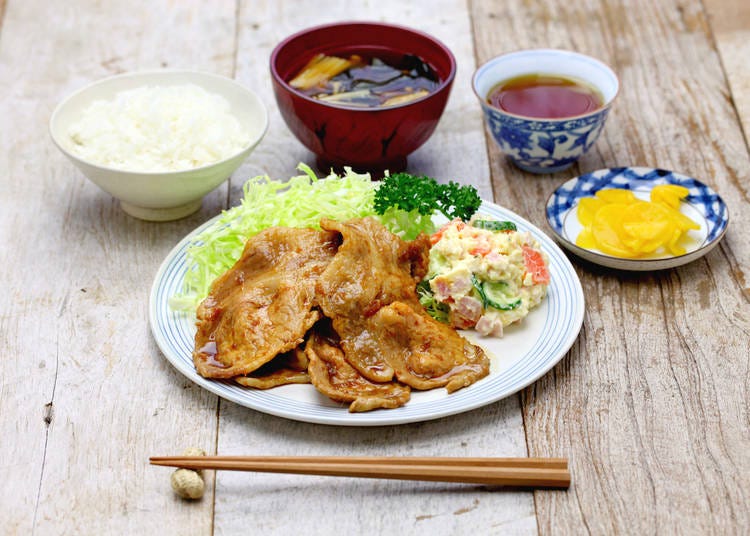
Buta-No-Shogayaki is one of the most popular and delicious Japanese dishes that you can find in many restaurants, izakayas (traditional Japanese restaurant/ bars ), fast food chains, and even as a bento box (a pre-prepared Japanese-style lunch) available in many grocery stores and convenience stores . The word "yaki" literally means "grilled." This dish is prepared by grilling thin slices of pork that are dressed with a delicate sauce made of mirin, soy sauce, sake (Japanese rice wine), granola oil, sliced onions, and ginger. This dish is perfect for a quick and tasty meal that you can enjoy any time of the year.
2. Champon (ちゃんぽん): The Essence of Japanese Noodles
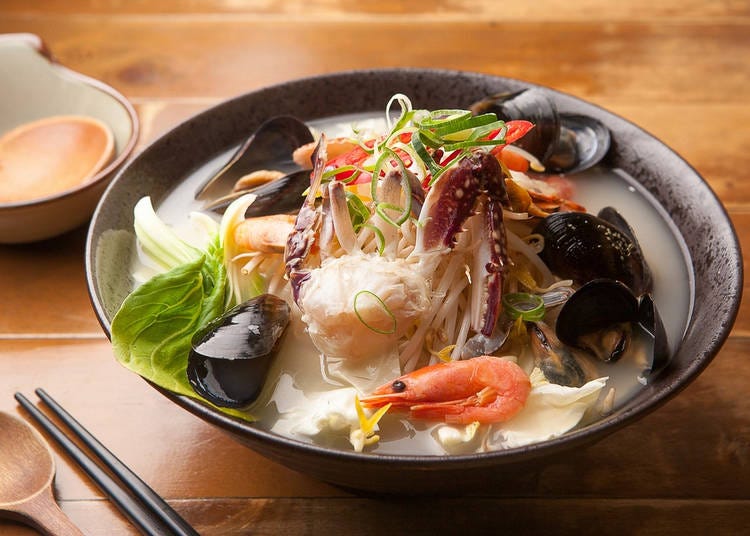
At first glance, Champon might be mistaken for ramen , but it is actually a unique dish in its own right. Originating from Nagasaki , it was first served in a Chinese restaurant during the Meiji era (1868-1912). Unlike ramen , the noodles used in Champon are boiled in the soup itself, giving it a distinctive taste and texture. Champon is a seasonal dish that uses a combination of ingredients such as pork, seafood , and vegetables. These are fried in lard before a soup made from chicken and pig bones is added to create a flavorful broth. As a result, each serving of Champon is different and offers a unique experience that varies depending on where you eat it. In fact, Champon is not just limited to Nagasaki ; it can be found in many countries throughout Asia and in different regions of Japan. Each place puts its own spin on the dish, creating a diverse range of styles and flavors that are sure to satisfy your appetite.
3. Edamame (枝豆): The Irresistible Boiled Soybean Snack
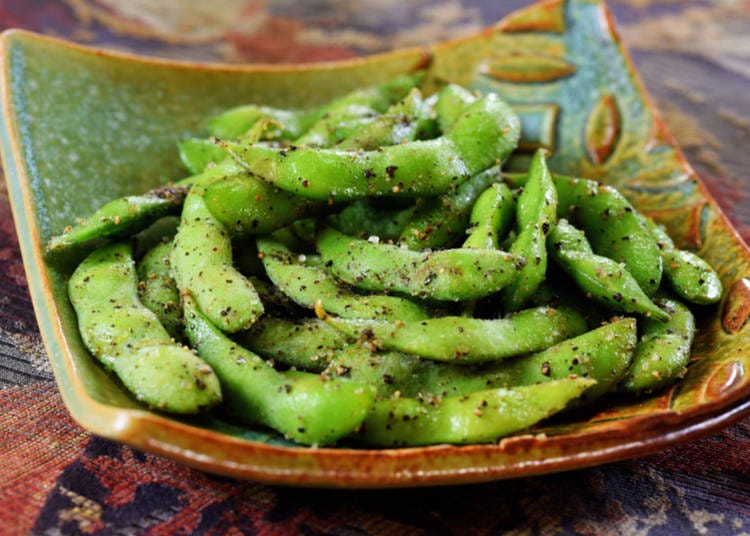
Edamame are not technically a dish, but they are a very popular food in Japan. These are immature soybeans that are still in their pods. They can be served hot or cold, and sometimes grilled instead of boiled. Typically, they are only dressed with salt, and they make for an amazing appetizer. Once you try a few, you'll find yourself reaching for more and more. Edamame usually accompany a meal in all izakaya , and they are almost always part of the menu in the vast majority of Japanese restaurants in Japan.
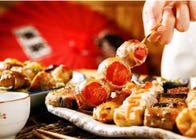
4. Fugu (ふぐ): The Delicate Dance with Pufferfish
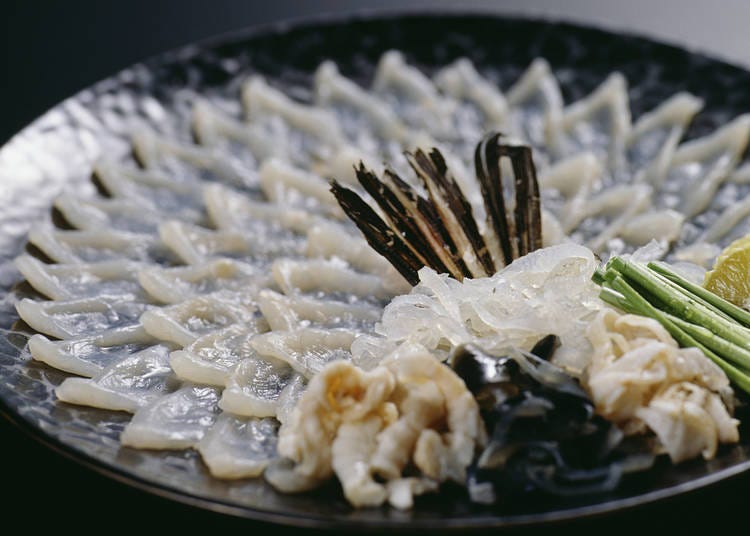
For those looking not only for amazing food in Japan, but also for a thrilling experience, fugu is the dish to try! The fugu is a pufferfish that is, yes, delicious, but it can also be lethal due to a toxin in some parts of its body. Fugu is usually served as sashimi or in certain kinds of Japanese nabe hot pots . The preparation of this fish, due to its characteristics, is rigidly controlled by the Japanese government. Chefs who aspire to prepare this fish must undergo at least three years of very rigorous training to get their license. Before being served, the toxic parts of the fish are removed, making it safe to serve. Interestingly, fugu liver is considered the tastiest part of the fish, but it’s also the one that can be the most poisonous. As a result, serving fugu liver was outlawed in Japan in 1984. Should you try this dish, you’ll certainly remain amazed by its taste, but do careful research before ordering it in a restaurant (and never try to prepare it by yourself).

5. Gyoza (餃子): The Delightful Journey of Japanese Dumplings
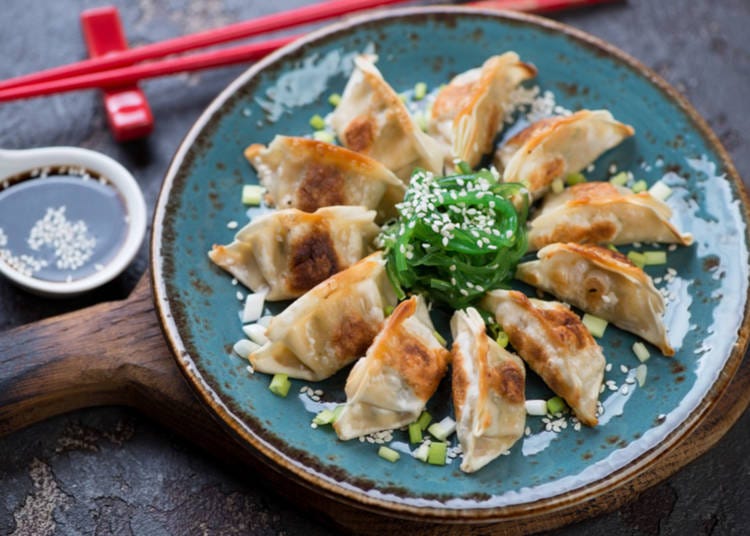
Gyoza are dumplings that are shaped like a crescent moon. They are a popular dish in Japanese restaurants and can be found almost everywhere, regardless of their style. Although originally from China, the types of gyoza you will find in Japan are usually quite different from the original. There are various types of gyoza available in Japan, but one of the most popular is "yaki- gyoza ". These dumplings are made with minced pork, cabbage, garlic, onion, and ginger. They are then lightly fried until they become crispy and turn a nice dark golden color. You can enjoy gyoza with a dip made of soy sauce, rice vinegar, and spicy oil.
6. Gyudon (牛丼): The Bowl of Beefy Goodness
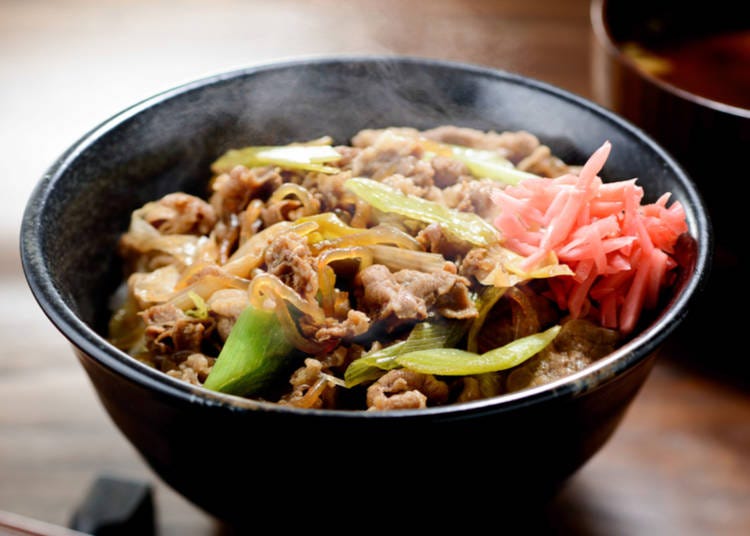
Gyudon is a mouth-watering dish consisting of beef served over rice (gyu = beef). It is a quick meal that is often served in specific restaurants or Japanese fast-food chains such as Yoshinoya. To make this dish, thinly sliced beef and tender onion are simmered in dashi broth (a popular Japanese ingredient) and then seasoned with mirin and soy sauce. The dish is then served over a bowl of steamed rice. Sometimes, it is topped with a lightly cooked egg. If you want to experience a typical Tokyo office worker’s lunch break, this quick and tasty dish is a must-try. You will feel full and satisfied, and ready to continue your sightseeing and exploration with renewed energy.
7. Gyukatsu (牛カツ): The Lure of the Beef Cutlet
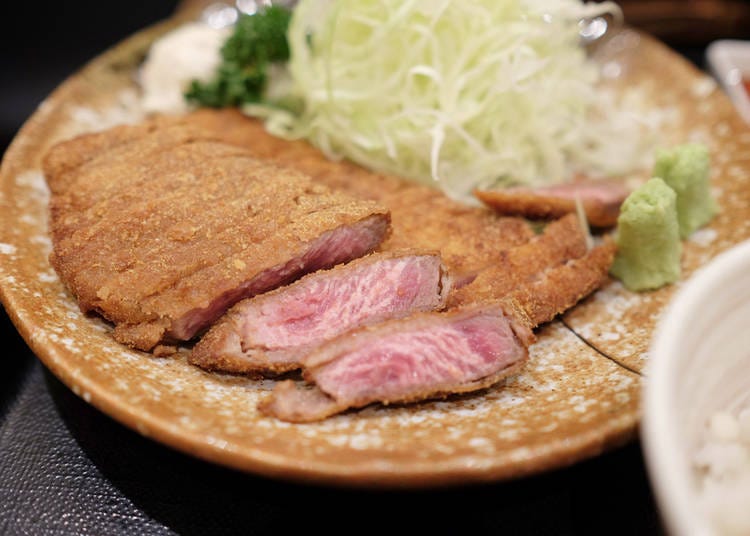
If you're fond of tonkatsu , a popular pork-based dish, you should definitely give its beef variation a try. This dish involves deep-fried breaded beef, which is served with a side of cabbage, barley rice, miso soup, potato salad, and pickles. The preparation method results in a tender and crunchy texture, and the dish has a flavorful taste that's not too overwhelming. Although it's not as commonly available as the pork version, if you do happen to come across it, it's definitely worth trying.
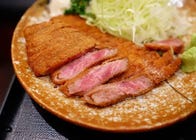
8. Gyutan (牛タン): An Ode to Beef Tongue Delicacies
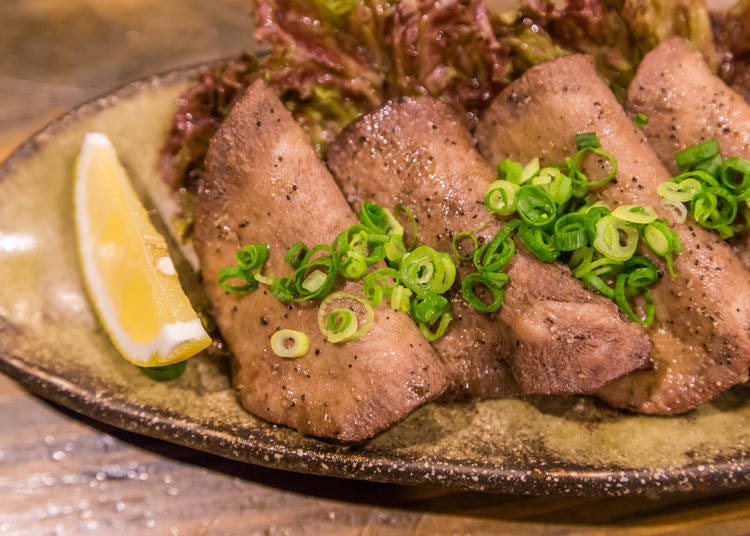
At first glance, this dish may seem unusual depending on where you're from, but we encourage you to keep reading. Gyutan is a dish made of grilled beef tongue, as the name suggests - "gyu" meaning cow and "tan" meaning tongue. This dish is typically found in yakiniku restaurants, prepared with salt or various sauces (often including lemon) and scallions. The meat is thin, delicious, and tender. Gyutan originated in Sendai, where the owner of a yakitori restaurant opened a new establishment in 1948 which offered gyutan. Since then, the dish has become increasingly popular throughout Japan. Give it a try and you'll quickly see why!
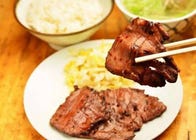
9. Karaage (から揚げ): Japan's Tasty Fried Chicken
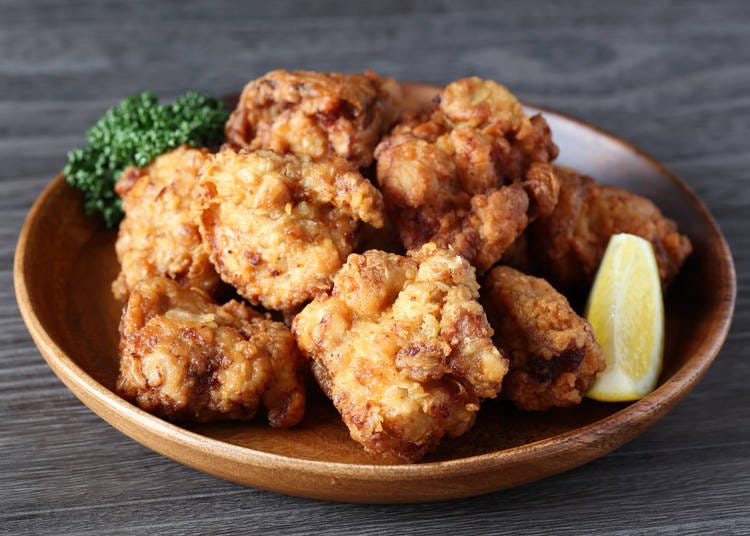
When you arrive in Japan, you will instantly notice the popular Japanese fried chicken dish called karaage. Although karaage usually consists of chicken, some regions may use other meats such as pork. The meat is lightly coated with wheat flour or potato starch and is then deep-fried in oil. In some cases, the meat is marinated before cooking. Karaage is typically served with a slice of lemon, but it can be enjoyed with or without it. Restaurants, street-food carts, izakaya , and convenience stores frequently serve the chicken variety of karaage. It's a delicious, fast, and affordable dish. However, the only downside is that it's so tasty, it can be addictive!
10. Katsudon (カツ丼): The Breaded Pork Bowl
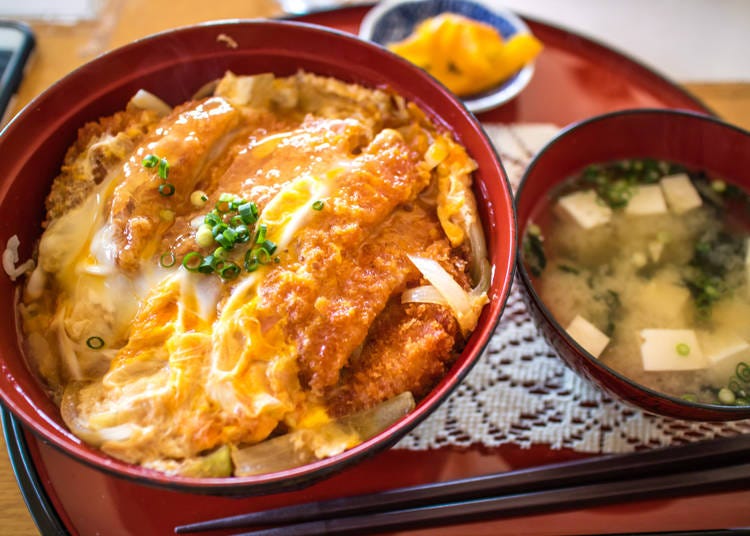
If you're a fan of beef bowl dishes like gyudon, you'll love Katsudon, a similarly popular Japanese dish made with pork. This tasty and affordable meal is often overlooked by foreign visitors, but can be found in many restaurants and Japanese-style fast food chains. The dish consists of a bowl of rice topped with deep-fried pork cutlet, egg, vegetables, and condiments, making it the perfect option for those on the go. Although it's a common dish in Japan, there are several varieties to choose from, including those served with tonkatsu sauce, demi katsudon (a specialty of Okayama ), shio-katsudon (flavored with salt), or miso-katsu (originally from Nagoya). Regardless of which type you choose, you're sure to enjoy this delicious and satisfying meal!
11. Kushikatsu (串カツ): Thrilling Skewered Deep-Fried Treats
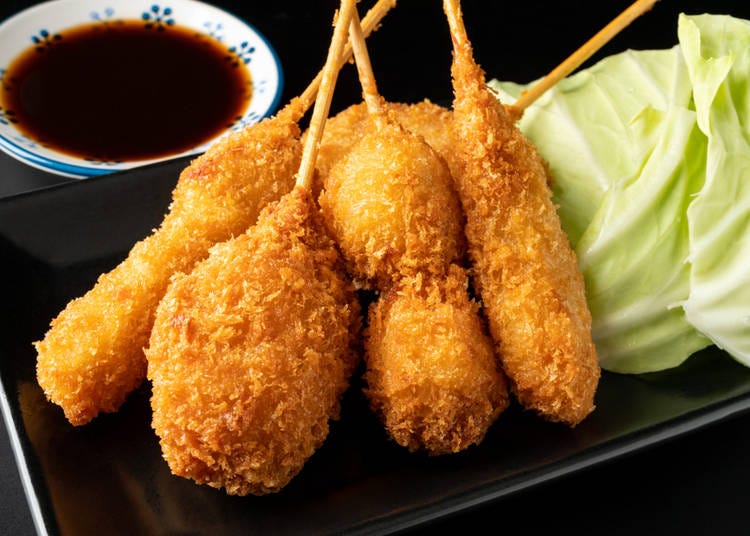
Kushikatsu , also known as kushiage, is a delicious dish consisting of crunchy deep-fried skewered meat, fish, or vegetables. The name of the dish refers to the way it is prepared, with "Kushi" meaning skewers and "katsu" referring to the deep frying of a meat cutlet. Kushikatsu can be made using a variety of ingredients, including bamboo shoots, lotus root, cartilage (nankotsu), and gizzard (sunagimo). Each ingredient has its unique flavor and texture, making the dish even more exciting to taste. Apart from the different ingredients, there are also several geographical varieties of Kushikatsu . For example, Osaka and Tokyo (which also serves pork rib kushikatsu ) prepare the meat slightly differently and dress it with brown sauce. In Nagoya, Kushikatsu is served with doteni, a rich miso-based dish with beef tendon, offal , and daikon radish. The region also uses different sauces and batter to prepare the dish.
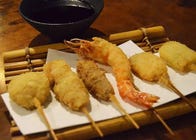
12. Miso Soup (味噌汁): The Soul-Warming Broth
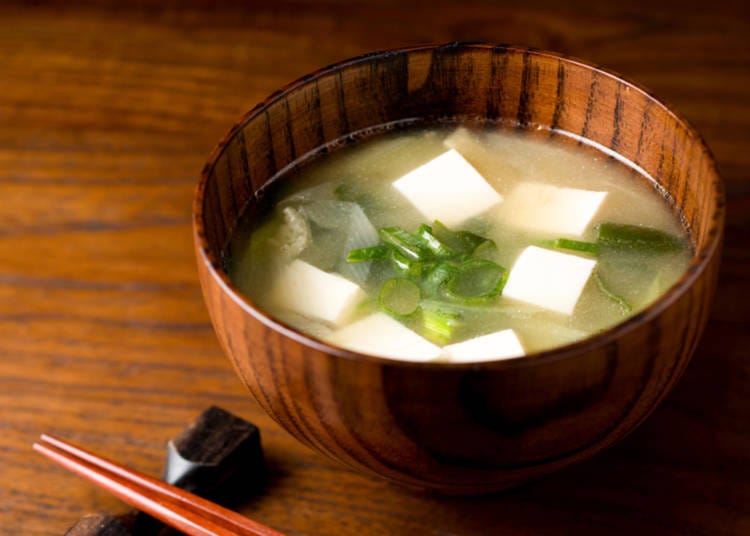
Miso soup is an unavoidable dish when it comes to talking about food in Japan. It is a staple in Japanese cuisine and can be served with almost any meal, be it breakfast, lunch, or dinner. This simple yet flavorful soup makes a fantastic side dish to complement the rest of your food. Dashi, one of the primary ingredients in miso soup, is mixed with miso paste, which is made by fermenting soybeans, to create this famous soup. Other ingredients are added according to individual preferences. Typically, miso soup is served with tofu , scallions, and wakame seaweed. However, other ingredients such as daikon, shrimp, fish, mushrooms, potatoes, onions, or meat can also be added. Miso soup is highly recommended during the cold winter months, and it is a must-try dish before leaving Japan.
13. Nabe (鍋): Enjoy Japan's Hot Pot Culture
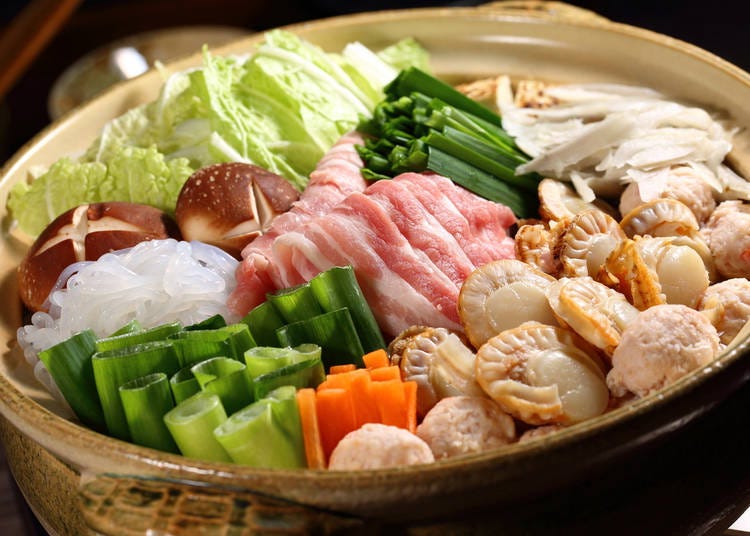
Nabe refers to a cooking pot, and in Japanese, it can also be referred to as "nabemono," which translates to "things in a cooking pot." While the name suggests that it's a simple dish, in reality, there are many variations of nabe in Japan. It's a popular dish throughout the year but is particularly enjoyed during colder months. Nabe is a dish that can be enjoyed both in Japanese restaurants and at home. The preparation involves boiling a variety of ingredients such as meat, fish, shellfish, vegetables, and tofu in seasoned or unseasoned water. Sumo wrestlers are known to be big fans of nabe , especially "chanko nabe ," which usually includes meatballs, chicken, vegetables, and noodles. It's designed to be served with extra ingredients so that wrestlers can gain weight. Another popular variation of nabe is shabu-shabu , named after the sound made when thinly-sliced meat is dipped into boiling water. This dish is served with beef or pork, vegetables, and tofu and is enjoyed with a sesame dipping sauce or ponzu, which is a lemon-based dressing, or a combination of both. Sukiyaki is a sweeter version of shabu-shabu where the ingredients are stewed in sweetened water and soy sauce and then enjoyed with a raw egg dip. Yose nabe , which means "putting together," is a nabe variety where all the ingredients, such as meat, fish, vegetables, and tofu , are cooked together in the pot at the same time. This dish is usually based on a soup of miso or soy sauce. There are many types of nabe available in Japan, and it's definitely worth trying them all to find your favorite!

14. Natto (納豆): The Fermented Soybean Sensation
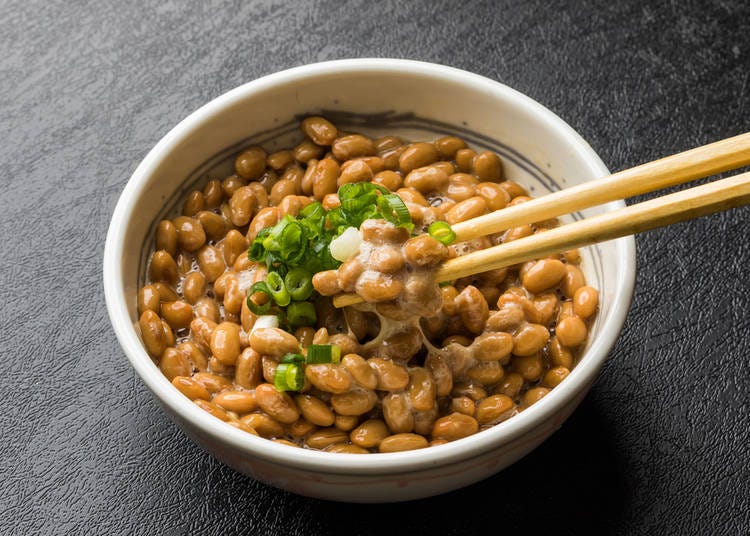
Natto, a fermented soybean dish, is a staple in the daily diet of most Japanese people. However, it's a type of food that many foreigners find unappetizing due to its strong smell and sticky consistency. Despite this, natto is a genuine Japanese delicacy that is worth trying at least once. Typically served with rice and dipped in soy sauce or spicy mustard, natto can be an acquired taste. It may take some getting used to, but don't let that intimidate you from giving it a try. You might be surprised to find that you enjoy it and have a more Japanese palate than you thought!
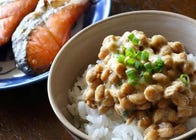
15. Oden (おでん): The Wintry Delight of Japan
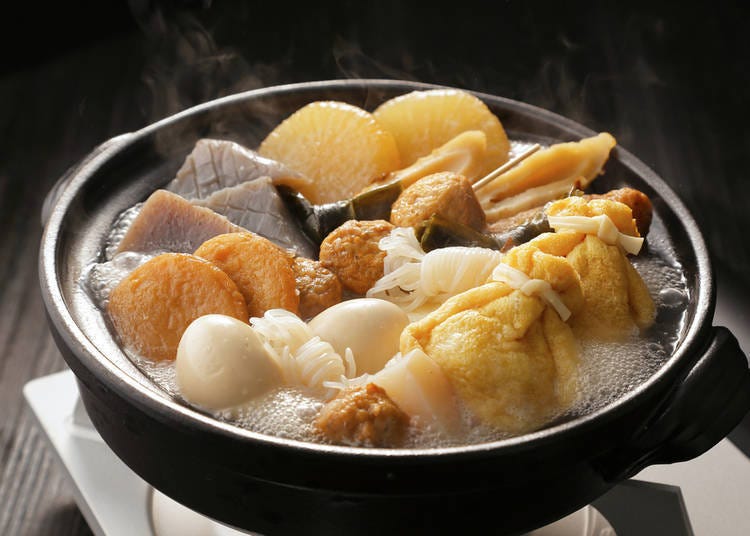
Oden is a delicious and warming dish that is perfect for cold winter days. It is a type of one-pot meal made with various ingredients, such as eggs, konjac, fish cakes , and daikon, all served in a dashi and soy soup. Although some restaurants specialize in preparing this dish, you can easily find oden in many Japanese fast-food chains and convenience stores . Oden can be prepared in different ways, and its name may even vary depending on the region. For instance, in Nagoya, it may be known as Kanto-ni. Additionally, the soups used to boil the ingredients can also differ depending on the area. Oden is an inexpensive and unique dish that you will never tire of, particularly if you are traveling through different cities in Japan.
16. Okonomiyaki (お好み焼き): Japan's Savory Pancake Paragon
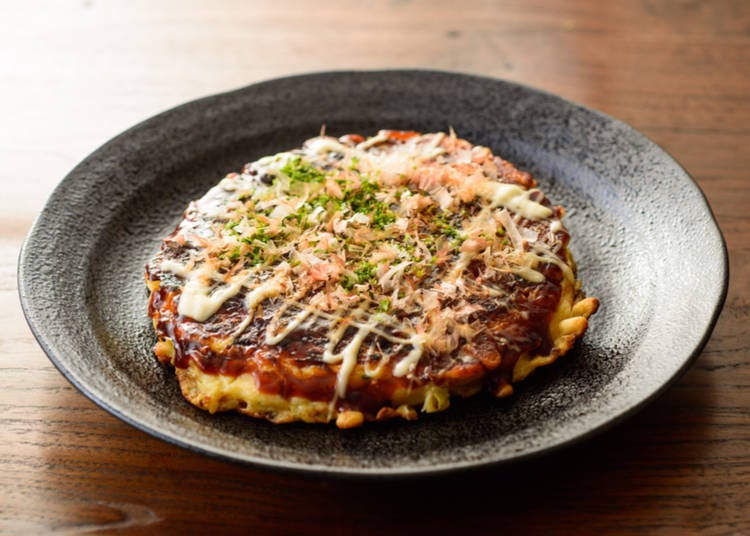
If you're traveling to Japan, trying out the various types of okonomiyaki , a staple dish, is a must. This savory dish, which can be compared to a Japanese frittata or pancake, is made using a wide range of ingredients, as suggested by its name's etymology (meaning "what you like" or "how you like" + "grilled"). Two of the most popular varieties of okonomiyaki are the Kansai-style and the Hiroshima -style. The Kansai version is the most common, with a batter prepared using flour, nagaimo (a kind of yam), dashi (or water), eggs, cabbage, pork belly, octopus, squid, shrimp, mochi, or cheese, and konjac. Osaka is particularly well-known for its okonomiyaki , as it is believed to be the dish's birthplace. In the Hiroshima -style, the ingredients are arranged in layers rather than mixed together. Toppings usually include noodles such as yakisoba or udon , eggs, and a lot of sauce. There are many other types of okonomiyaki available in various regions of Japan, such as Tokushima , Hamamatsu, and Okinawa . If you're in Tokyo, you should visit the Tsukishima district , which is famous for both okonomiyaki and monjayaki. On Monja Street , you can try monjayaki, a dish similar to okonomiyaki but with a less dense texture and different ingredients.
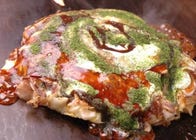
17. Omuraisu (オムライス): The Enchanting Omelette Rice Creation
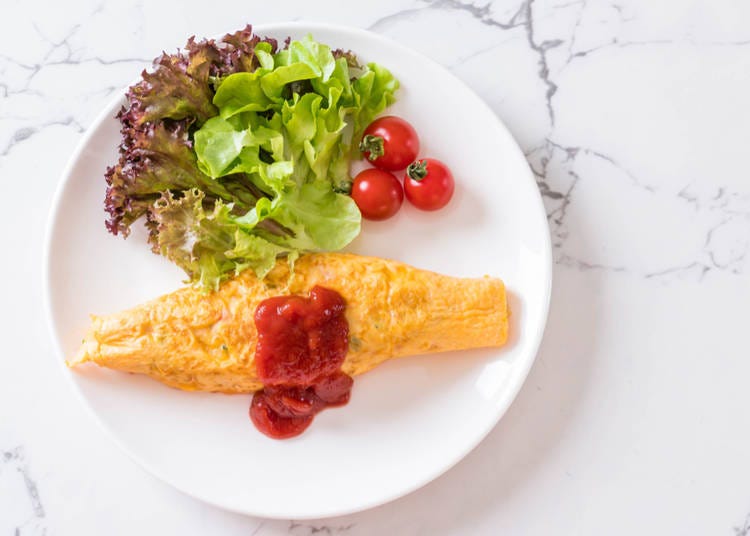
The name of this flavorful dish derives from the contraction of the words omelet and rice. Omuraisu, as the name suggests, is an omelet filled with fried rice and usually topped with ketchup. The dish seems to have originated in Tokyo, in a western-style restaurant, roughly 100 years ago. You’ll find this dish in most Japanese cafes that also serve food, as well as in several restaurants. If you’re staying with friends from Japan, chances are they’ll know how to prepare it, as it’s a common dish among Japanese people. Once again, a filling, cheap, and tasty one-dish meal that will certainly be popular among adult visitors, as well as children!

18. Onigiri (おにぎり): The Staple Rice Ball Delight
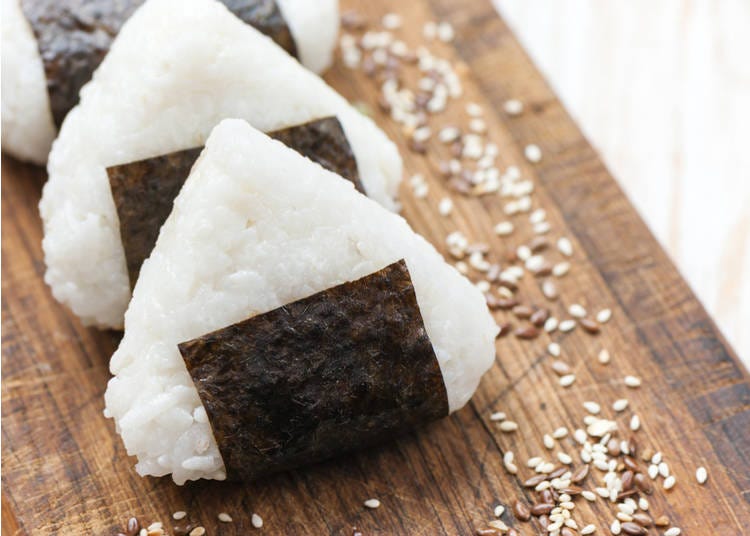
Have you ever come across the famous Japanese rice ball, the onigiri, in an anime , movie, video or documentary? Although it is not a very common menu item in restaurants, it is considered the king of on-the-go dishes and can be found in almost every grocery and convenience store . The onigiri is a simple rice ball that can be flavored with spices or filled with various ingredients such as vegetables, meat, fish, seafood , and more. Depending on the region and one's preference, it can be wrapped in a sheet of flavored or unflavored nori (seaweed). While sightseeing in Japan, many people tend to eat mainly onigiri due to its cheap price (usually under 200 yen), availability, and simplicity.
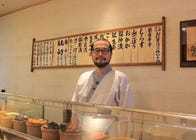
19. Ramen(ラーメン): The Delectable World of Noodles and Broth
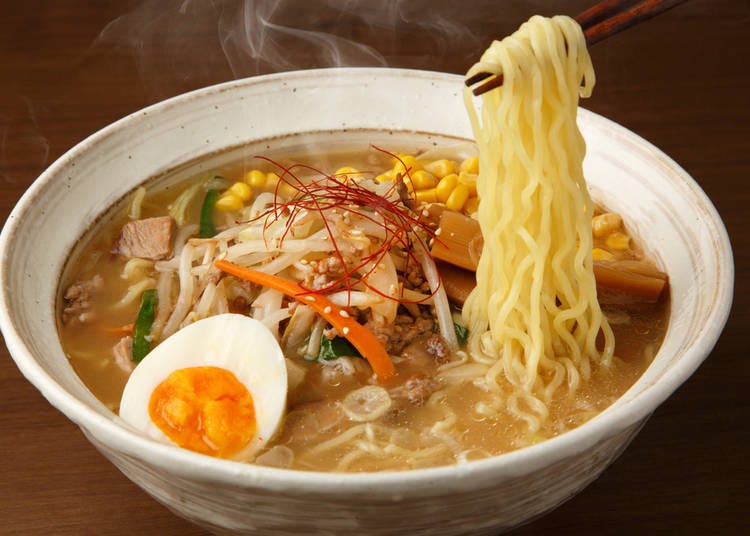
Ramen is a well-known dish globally, especially the instant variety. However, in Japan, the authentic version is far superior to its instant counterpart in terms of taste and variety. The broth for ramen can be made from chicken, pork, beef, fish, or vegetables, flavored with soy sauce, miso, dashi, and many other seasonings. It is usually served with scallion, seaweed, tofu , and bamboo shoots, but there are countless other combinations to choose from. Each region and restaurant has its unique recipe, leading to original and delicious meals. The noodles used in ramen are also specially made and have a soft yet chewy texture. The most common soup stocks used for ramen are miso, salt, soy sauce, and curry . Ramen is the go-to meal for the Japanese after a long day or night out, and it's commonly regarded as fast food . It's typically served hot, although some variations can be served cold, and it's a favorite on cold days.
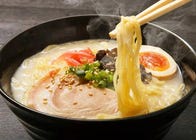
20. Robatayaki (炉端焼き): The Art of Fireside Cooking
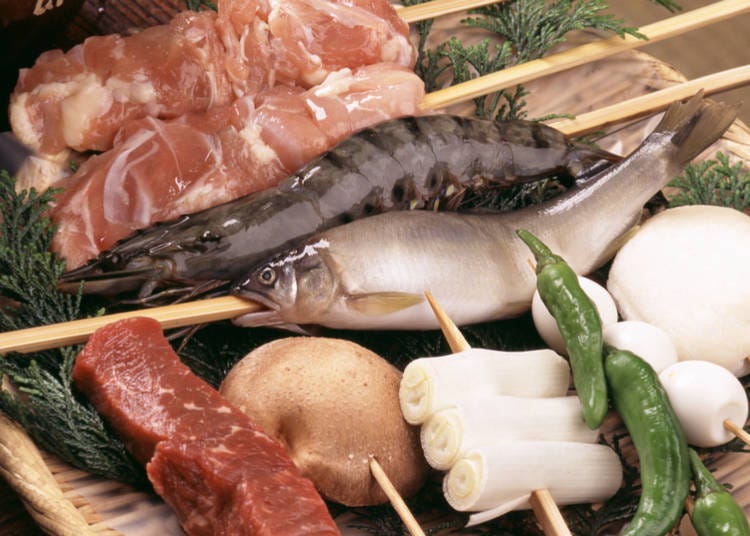
Robatayaki (or robata) is a unique Japanese cuisine in which food is grilled on an irori style fireplace (wide, flat, open fireplace) over charcoal. This particular dish is usually found only in specialized restaurants, so you may have to look/ask specifically for it. The list of food at robata restaurants is everything you can think of, although traditionally it is a combination of seafood and vegetables. Most visitors miss this amazing food in Japan. Make sure you taste a real slice of Japan by looking for a good robata (there are many in Tokyo and all over Japan).
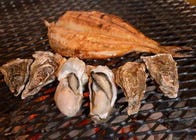
21. Soba (蕎麦): The Buckwheat Noodle Escapade
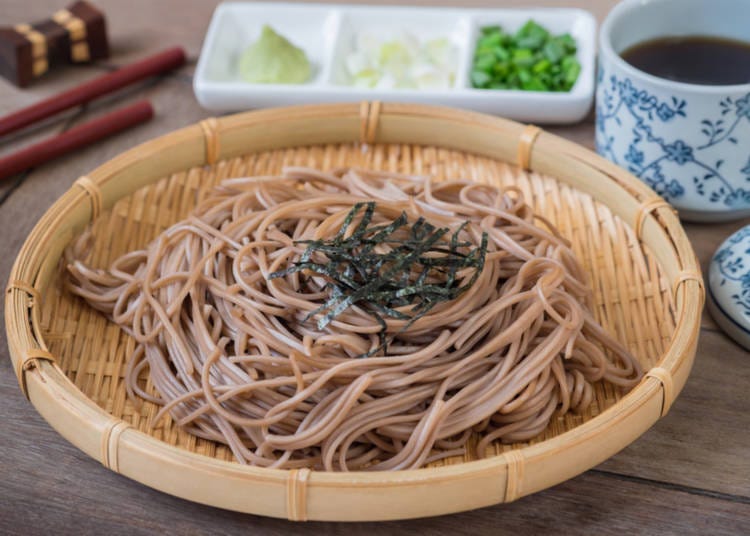
Soba is a type of noodle made from buckwheat flour, which is a specialty dish from Japan. It is a very popular dish and can be found in both general noodle restaurants and specialized, often expensive ones. Preparing soba at home is relatively simple, as you can buy the noodles and soup in which they are dipped from a grocery store . Soba can be enjoyed in different ways, either in a cold dip or a broth as a noodle soup. This dish comes in various varieties depending on the region and the season you are visiting. Don't forget to try a soba dish next time you visit a restaurant in Japan!
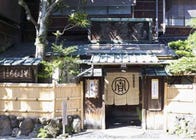
22. Somen (そうめん): Delightful Thin Noodles
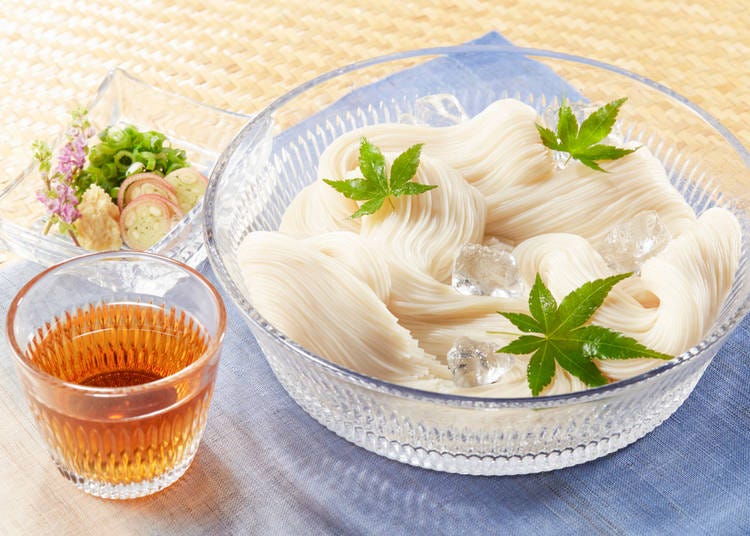
Somen is the Japanese version of a prevalent kind of noodle across Asia. Made out of wheat flour, it’s usually served cold. These skinny noodles are served with a simple cold dipping sauce or a sauce flavored with onion, ginger, and myoga (a different kind of ginger). This dish is particularly popular in summer when a dish of somen chilled with ice cubes is all you need to recharge, fill up, cool off, and take a break from the brutal Japanese summer heat.
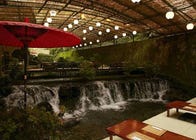
23. Sushi and Sashimi (寿司 & 刺身): The Raw Elegance of Japanese Cuisine
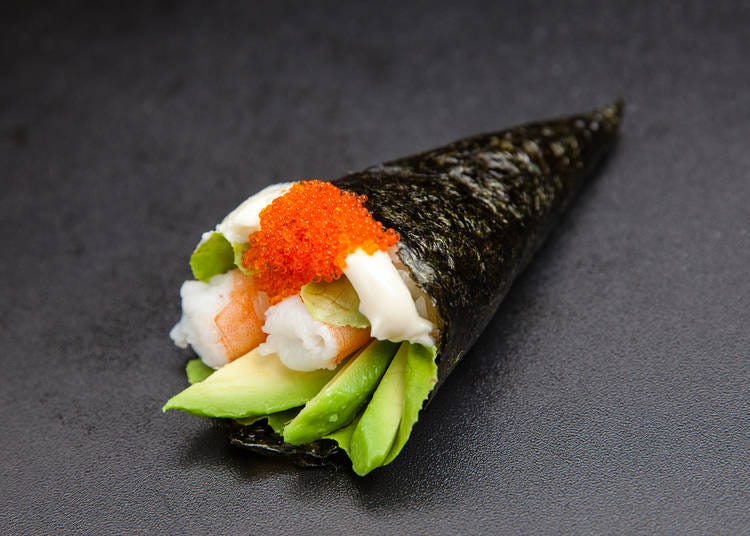
Sushi and sashimi are among the most famous foods in Japanese cuisine . They are regarded as an art form, with sushi chefs often practicing as apprentices for years before being considered masters. Despite their popularity, many people fail to understand the variety of cuts and preparation that go into creating these dishes. However, good quality sushi and sashimi can be found in Japan at a fair price. There are options available for all palates and budgets. One unique dining experience in Japan is offered by rolling sushi restaurants, where you order from a tablet at your table and the sushi is served to you via a rolling mat. At these restaurants, known as 100 yen- sushi or sushiro, each dish costs only 100 yen and the food is excellent. A dish that is often missing outside of Japan is temaki zushi, or hand-rolled sushi . While you can find restaurants offering this dish, it's a fun and easy dish to make at home. You'll need sushi rice, thin slices of your favorite fish, seaweed sheets, and any other ingredients you'd like to add. Common ingredients include cucumber, crab, avocado, and wasabi. To make temaki zushi, spread the rice on a sheet of seaweed, add your fillings, roll the seaweed into a cylinder or cone, and enjoy with soy sauce. If you're in Japan, consider proposing a temaki zushi party - it's sure to be a hit!
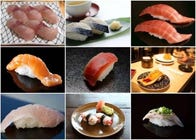
24. Takowasa (たこわさ): The Wasabi Octopus Experience
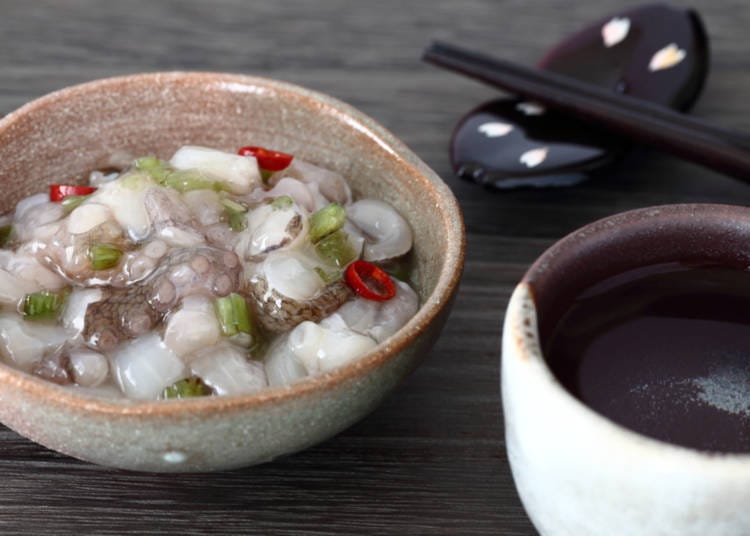
Takowasa is raw octopus (tako) served in a wasabi sauce (wasa). This is one of those Japanese dishes that, depending on your cultural background, may appear weird. Do try it out! Takowasa is a common appetizer in many restaurants, especially in an izakaya . It’s very popular and for a good reason. It’s tasty, unique, and a true symbol of Japanese popular food tradition.
25. Tempura (天ぷら): Japan's Light and Crispy Masterpiece
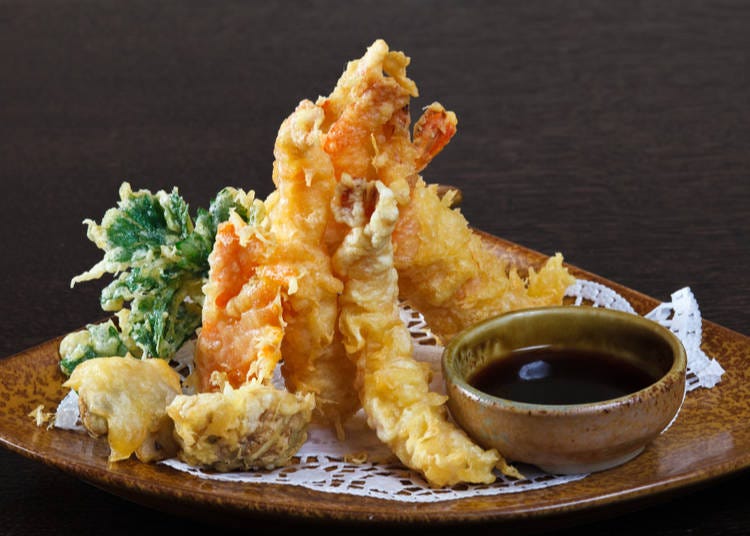
Tempura is a delicious dish that can be enjoyed throughout the year, especially for those who love to socialize with friends over drinks. Tempura typically includes shellfish, fish, chicken, or vegetables coated in a flavorful batter and then deep-fried to a perfect level of crunchiness. You can savor tempura as is, or with a dipping sauce. While many restaurants offer this dish, some specialize in it, providing a wider range of options for an even more fantastic immersion into traditional Japanese cuisine .
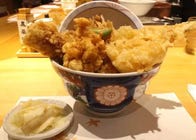
26. Teppanyaki (鉄板焼き): The Theatrical Grilling Artform
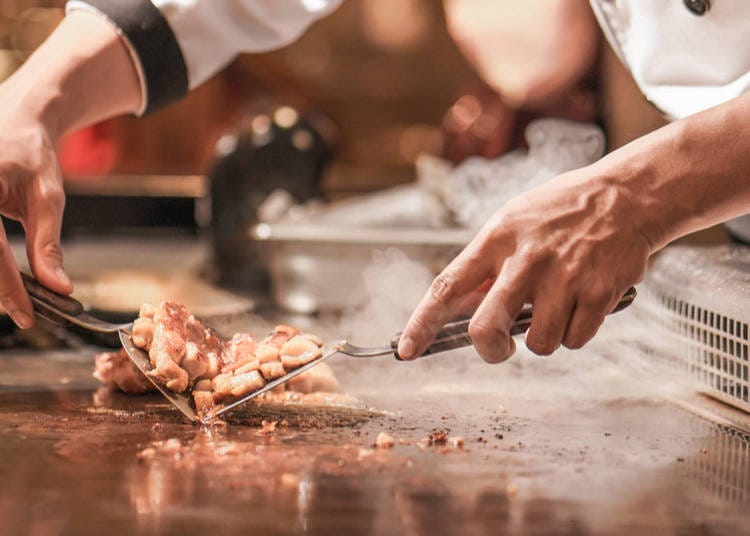
Teppanyaki is a Japanese style of cooking that is not very well known but still absolutely delicious. The word Teppan means iron plate, while yaki means grilled. The term Teppanyaki is used to refer to a wide variety of dishes, including okonomiyaki , yakisoba, and monjayaki. However, it's typically used to describe a particular type of western-influenced food preparation. Typical ingredients for Teppanyaki dishes are beef, shrimp, vegetables, chicken, and scallops. These ingredients are cooked on a hotplate, usually with soybean oil. Some of you may be familiar with this type of cooking because in the United States, Teppanyaki restaurants are quite popular, although they're known as hibachi. If you visit Japan and want to try some amazing food that blends the best of Japan and the West, you should definitely give Teppanyaki a try.
27. Tonkatsu (とんかつ): The Crispy Pork Cutlet
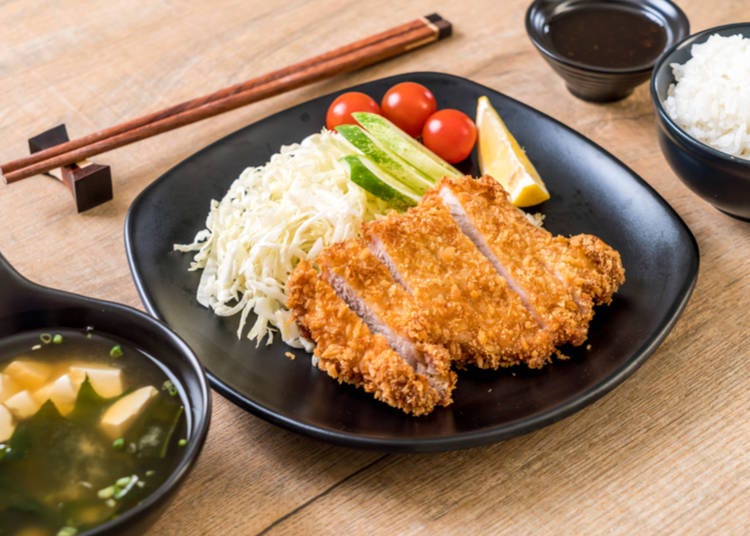
Tonkatsu is a popular and easy-to-find Japanese dish consisting of a breaded pork cutlet that is deep-fried in vegetable oil until golden brown. You can easily find this delicious and affordable dish in many chain restaurants, grocery stores , and convenience stores , or you can even make it at home! To prepare the dish, season the meat with salt and pepper, coat it in flour, dip it in beaten egg, and cover it with panko (Japanese bread crumbs). Then, deep fry the cutlet until crispy and serve it with cabbage, potato salad, and a brown sauce or karashi. Tonkatsu is also great for making sandwiches, making it the perfect meal on-the-go.
28. Udon (うどん): Glorious Thick Noodles
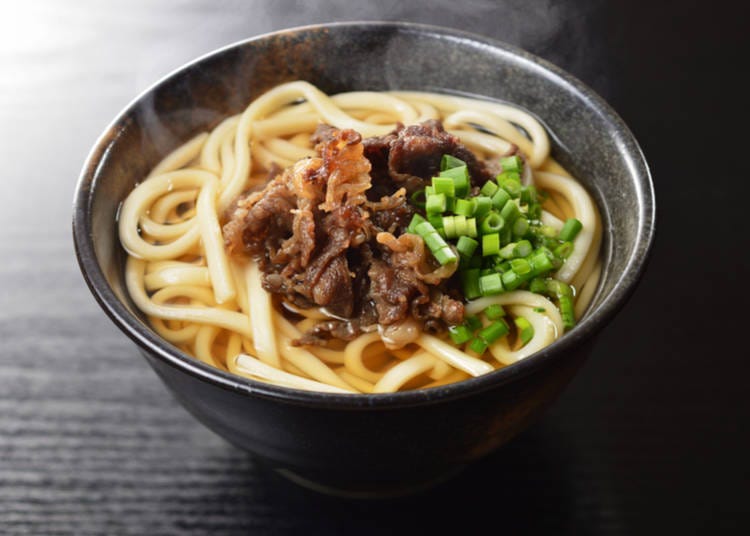
Japan has a wide variety of noodles, and udon is one of the most popular, just like ramen . Udon is a thick noodle made from wheat flour, which you can enjoy either in its simplest form - with broth made of dashi, mirin, and soy sauce - or in many different combinations. For a hearty meal, try it with tempura , or for a more delicate taste, with tofu . Udon can be served hot or cold, depending on the season or your personal preference, and the style of preparation varies depending on the region you're visiting. Although the word " udon " refers to the noodles themselves, there are no limits to the flavors, soups, and ingredients that can be added. As a matter of fact, challenge yourself to try out as many styles of udon as possible during your trip to Japan. Not only will you be satisfied, but you'll also be nowhere near the end of the list of possible dishes!
29. Yakiniku (焼き肉): Grilled Meat, the Japanese Way
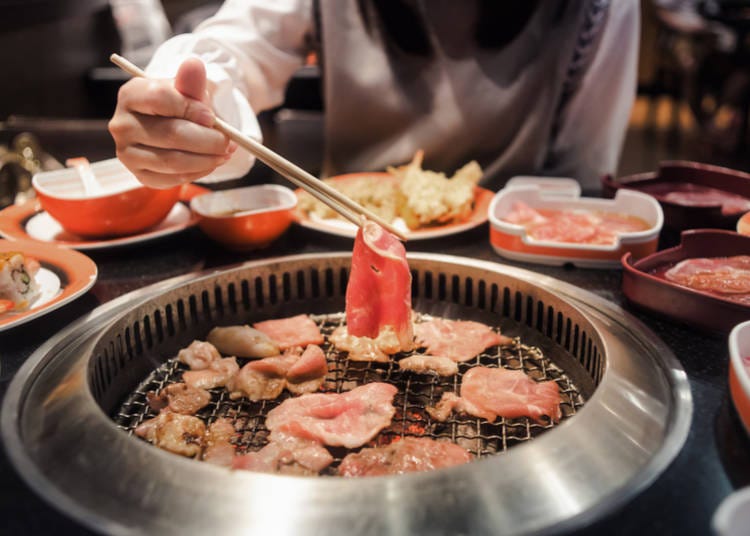
Yakiniku is a style of cooking that involves grilling meat, also known as Korean or Japanese barbecue. While Korean-style barbecue typically involves marinated meats, Japanese-style barbecue does not. Yakiniku restaurants are very popular and offer a wide range of options, from high-end to budget-friendly, with some even offering all-you-can-eat menus. When dining at a yakiniku restaurant, you can choose from a vast selection of meat or vegetables, seasoned or unseasoned, which you then grill yourself on a hot plate or grill embedded within your table. You can then add various sauces, such as lemon, BBQ, and many others, or simply salt and pepper to taste.
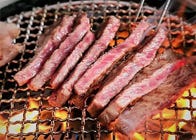
30. Yakisoba (焼きそば): Tasty Fried Noodles
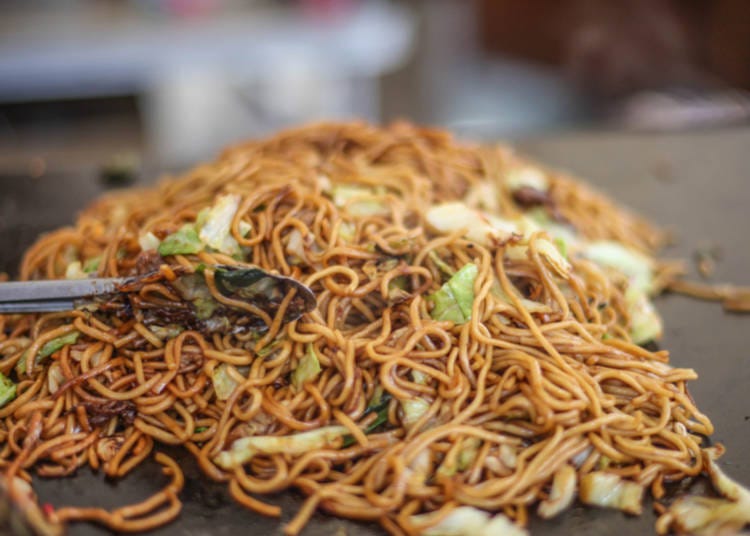
Yakisoba is a Japanese dish that consists of grilled soba noodles and is usually served at festivals. However, you can also make yakisoba by stir-frying the noodles. You can add various ingredients such as pork, fish, or vegetables and enhance the flavor with toppings like seaweed powder, ginger, and fish flakes. Finally, add sauces such as oyster sauce to give it a delicious taste.
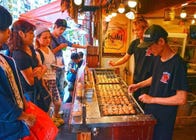
31. Yakitori (焼き鳥): Savory Grilled Skewers
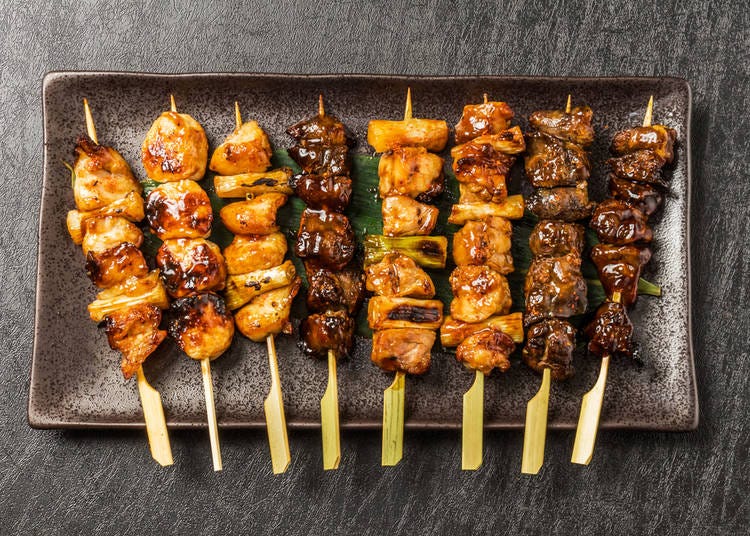
Yakitori , which literally means grilled chicken, actually refers to all kinds of skewered meat (as well as vegetables) cooked on a grill. This dish is simple yet flavorful, and there are countless combinations of ingredients to try. You can find Yakitori in many restaurants and specialty shops. When you visit a good izakaya , it is highly recommended to try this popular Japanese food .
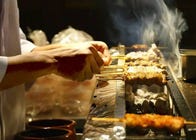
32. Yakizakana (焼き魚): Grilled Fish Delicacies
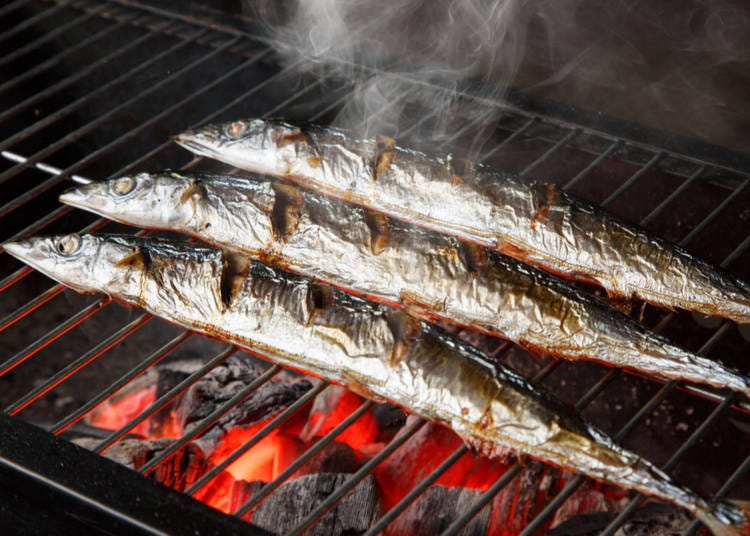
While in Japan, it's essential to try grilled fish, Yakizakana. Although sushi is more famous outside Japan, raw fish is not as common as grilled fish in the country. Typically, a whole fish is grilled and served with side dishes consisting of various vegetables and rice. You can try it at specialized restaurants for an immersive experience or at chain restaurants for a delicious, inexpensive, and quick meal that will keep you energized for several hours of sightseeing ahead.
You’re now on the way to become a true expert on food in Japan! Yet there’s much more to Japanese cuisine that can be discovered! While visiting this amazing country and taking in all the sights, the fun, and the culture, don’t forget to eat!
Written by:

Lucio Maurizi
Lucio Maurizi is an automotive expert specializing in Japan's car scene and auto-tourism. With an MA in East Asian History from La Sapienza Università di Roma, he's a multi-talented contributor to travel platforms like LIVE JAPAN, Japan Travel, and GPlus Media. His Instagram account (50k+ followers) offers insider views on Japan's automotive culture. Lucio also actively collaborates with professional drivers and influencers and organizes can't-miss car events in Tokyo. Instagram: @italian_in_japan Other links: https://linktr.ee/italianinjapan
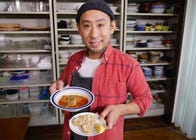
- Category Japanese cuisine
Share this article.
Limited time offer: 10% discount coupons available now!
Recommended places for you.

Japanese cuisine

Dynamic Kitchen & Bar Hibiki

Ganso Kamameshi Haru

Nichigekka Ginza

NIIGATASADONOSYUNTOJIZAKENODOGURONOAKUBIOKACHIMACHI

KITCHO Main store
Umeda, Osaka Station, Kitashinchi

The Complete Guide to the Kintetsu Rail Pass

A Complete Guide to the JR West Kansai Area Pass

Recommended Hotel Near Takayama Station: Stay at the 'hotel around TAKAYAMA, Ascend Hotel Collection™' for the Ultimate 'Good Local’ Experience

What to Do in Tokyo in June 2024: Roundup of Tokyo Area Events and Festivals

Everything You Need To Know About the Kyoto-Osaka Sightseeing Pass

Tokyo Summer 2024: Snooze with Snorlax in a Pokémon Sleep Suite!
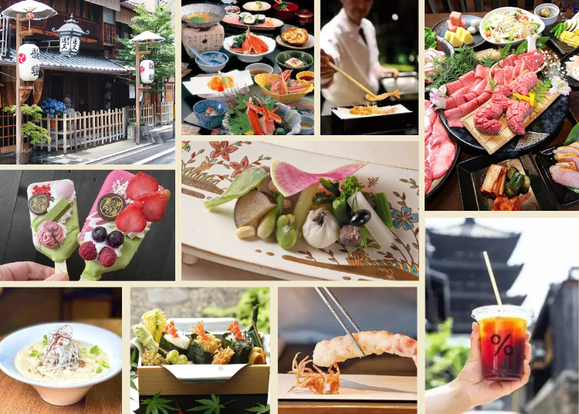
40 Must-Try Foods in Kyoto's Gion District: Indulge in Kaiseki Cuisine, Wagyu Beef BBQ, and Non-Stop Matcha Desserts

Kesennuma City Memorial Museum (Ruins of Koyo High School): Telling the Story of the 3/11 Great East Japan Earthquake

Universal Studios Japan: Guide to Osaka's Giant Theme Park Attractions!
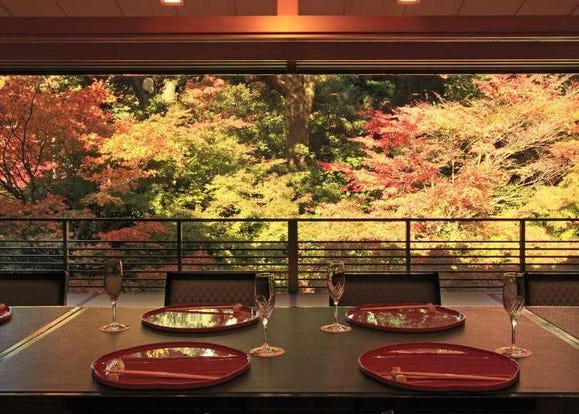
Terrace Dining & More: 3 Restaurants Where You Can See Tokyo's Dazzling Fall Foliage
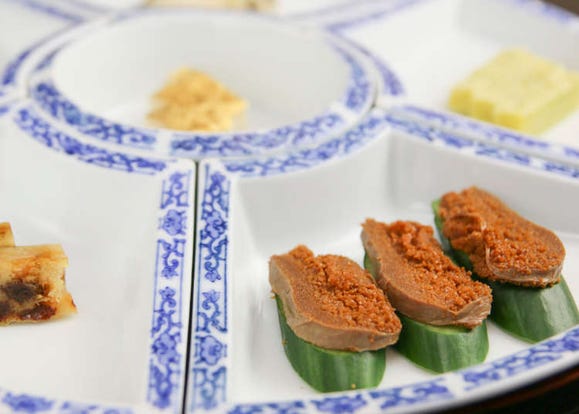
Indulging in Authentic Japanese Cuisine
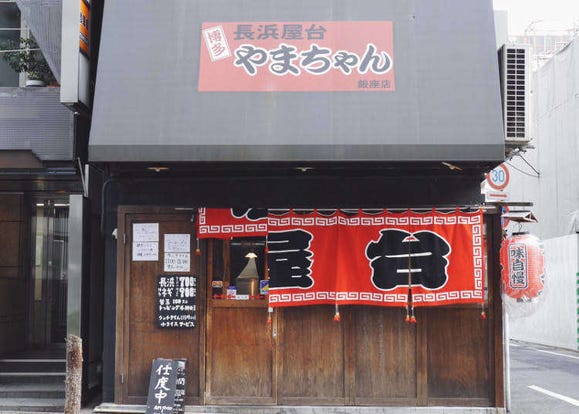
Top 4 Go-To Spots for Tokyo Ramen
- #best sushi japan
- #what to do in odaiba
- #what to bring to japan
- #new years in tokyo
- #best ramen japan
- #what to buy in ameyoko
- #japanese nail trends
- #things to do japan
- #onsen tattoo friendly tokyo
- #best coffee japan
- #best japanese soft drinks
- #best yakiniku japan
- #japanese fashion culture
- #japanese convenience store snacks
- Work With Us
CURRENTLY IN: Europe

Guide to Japanese Food: 15 Japanese Dishes to Try
The popularity of traditional Japanese food is one of the many aspects that draw millions of visitors to Japan every year. Discovering new flavours, trying authentic dishes, and exploring regional food differences is one of the highlights of any Japan trip.
*This post may contain affiliate links, as a result, we may receive a small commission (at no extra cost to you) on any bookings/purchases you make through the links in this post. As an Amazon Associate, we earn from qualifying purchases. Read our full disclosure
And it’s no surprise – Japanese food is arguably one of the most sought-after international cuisines. Sushi, ramen, tempura, gyoza and many other dishes from Japanese cuisine have become well-known around the world over the last few decades.
But as we discovered on our recent trip to Japan , Japanese food is so much more diverse than the sushi and ramen shops you might have come across in North America. The list of traditional Japanese dishes is very long, and there’s much more variety across the islands than you might realize.
Japanese cuisine has changed and evolved over the centuries. You’ll notice many influences from China and Korea in the cooking methods and ingredients, with varying versions of similar dishes like dumplings and noodles all over Asia.
From yatai (street food stalls) cooking snacks to traditional ryokans serving kaiseki meals, enjoying the food in Japan is an important part of the culture. And for us, it was definitely the highlight of our trip!
In this article, we wanted to share some of our favourite Japanese dishes and types of Japanese food that you should remember to try during your time in Japan.

Traveling Soon? Here is a list of our favourite travel providers and accessories to help get you ready for your upcoming trip! Book Your Accommodation HERE Search for Great Tours HERE Get a Car Rental HERE Buy Travel Insurance HERE See our Favourite Camera Bag HERE Grab a Reusable Water Bottle HERE or a Filtration Straw HERE Order an eSim HERE
Health Benefits of Japanese Diet
The health benefits of the Japanese diet have been well documented now, particularly with a high life expectancy and the recognition of Okinawa as being one of the world’s Blue Zones (where a large number of people live to 100).
Heavily focused on fish, fermented soybeans, seasonal vegetables, and small portions of meat, Japanese cuisine is one of the healthiest diets in the world.
Japanese Food Experiences You Can’t Miss
Before we get into the actual dishes, we wanted to share a few very special Japanese food experiences to add to your list.
Sushi Omakase
Sushi is undoubtedly the most famous Japanese dish for foreigners, but there are several different ways you can enjoy it in Japan. One of the best ways to sample a wide variety of sushi is by ordering it “omakase” style.
Omakase literally translates to “I leave it up to you,” which means you leave the selection of the sushi up to the chef. This experience often allows you to taste more regional delicacies as the chef gets to prepare a personalized tasting plate of their favourite sushi based on the best seasonal ingredients.
Kaiseki Meal
Kaiseki is Japan’s answer to a traditional celebratory feast. A multi-course meal designed to highlight the flavour of seasonal ingredients and meticulous presentation to make a unique and often sophisticated dining experience.
The key to the best kaiseki is subtle seasonings, fresh ingredients from the region, and complementary table settings and garnishes, all working together harmoniously. If you want the full kaiseki experience, order it for dinner at a ryokan (traditional Japanese inn) in regional Japan. Usually served in a communal dining room with tatami (woven mats) floors, it’s a true Japanese cultural immersion.
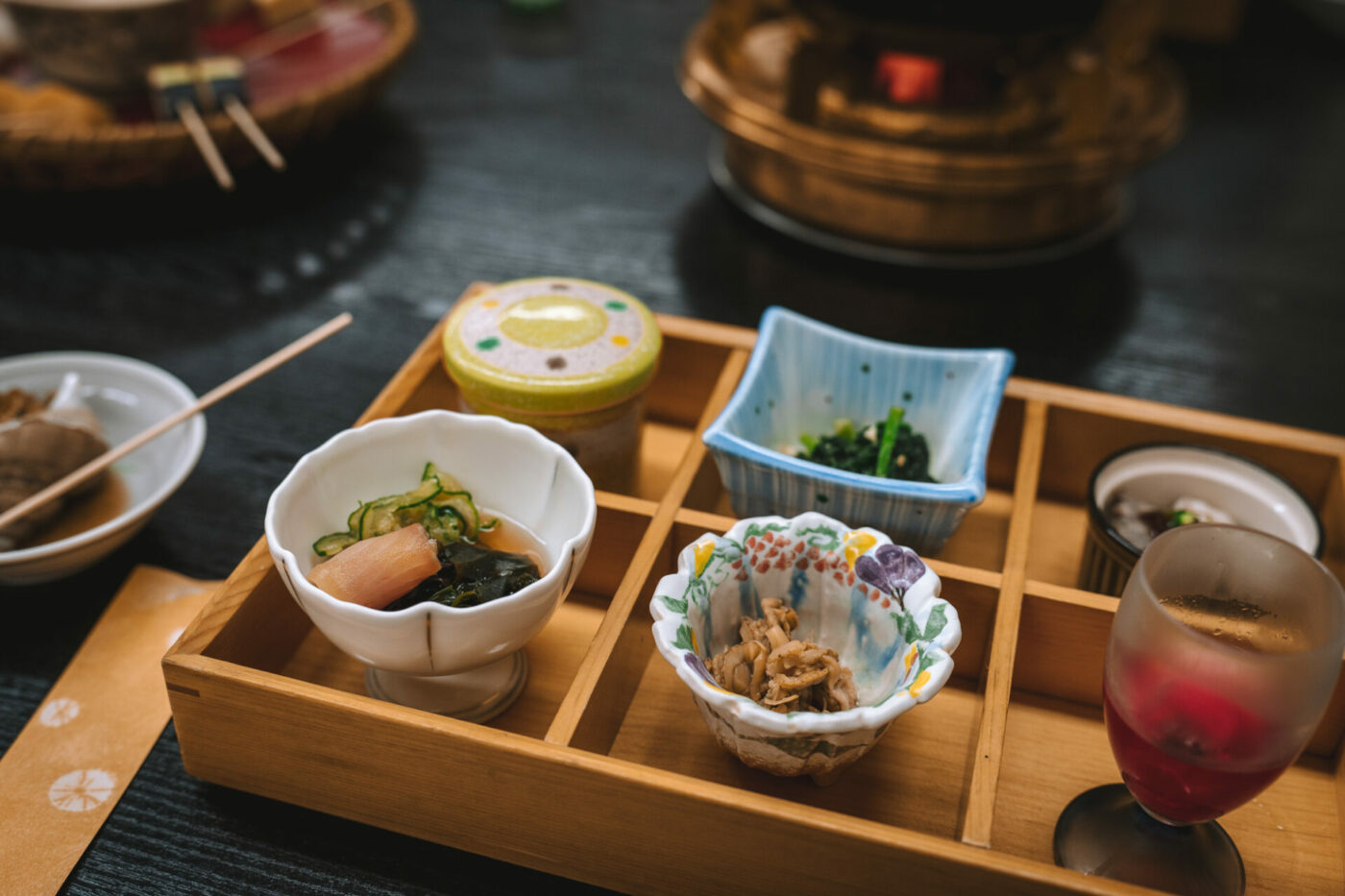
Visit Tsukiji Fish Market
Considered one of the best foodie experiences in Japan, the Tsukiji Fish Market in Tokyo is one of the largest fish markets in the world. Specializing in freshly caught seafood, the market is a maze of alleyways filled with vendors selling a range of Japanese dishes.
Try oysters, scallops, unagi (grilled eel), squid tempura, tuna, grilled fish like salmon, and whitefish sashimi served over fried rice and fried fish cakes. Fresh sushi is also abundant and worth a try here.
READ NEXT: 3 Days in Tokyo Itinerary
Visit Nishiki Market
Another iconic market experience for traditional Japanese food is the Nishiki Market in Kyoto. A long, narrow street filled with shops and restaurants, it has a history spanning hundreds of years and is often referred to as ‘Kyoto’s Kitchen.’ Most stalls specialize in a particular type of food, and almost everything sold at the market is locally sourced.
Discover a wide variety of weird and wonderful foods, from tsukemono (pickled vegetables) and traditional Japanese sweets to wasabi salt and fresh sashimi skewers. The crab is a must-try in the right season. It’s certainly a lesson in all aspects of Japanese food.
Tea Ceremony Experience
Tea is a staple in the Japanese diet, and while other Asian countries focus on black tea, Japan’s specialty is green tea. A Japanese tea ceremony or “the way of tea” is steeped in a long history of traditional Japanese culture. There are generally two kinds of green tea served in Japan, ryokucha (steeped with leaves) and matcha (mixing dried and milled leaves with water). Matcha is traditionally the kind of tea served in tea ceremonies.
Traditionally, a tea ceremony was reserved only for the highest-ranking officials and guests of honour. Hosted by a geisha, this experience dates back to the Edo Period but is one that is still widely practiced today among Japanese.
For a glimpse into the experience, consider joining a tea ceremony experience in Kyoto or Osaka. Kyoto is the most famous city to host tea ceremonies, usually held in a tatami room. A traditional Japanese sweet is often served with matcha tea to balance out the bitterness of the drink.
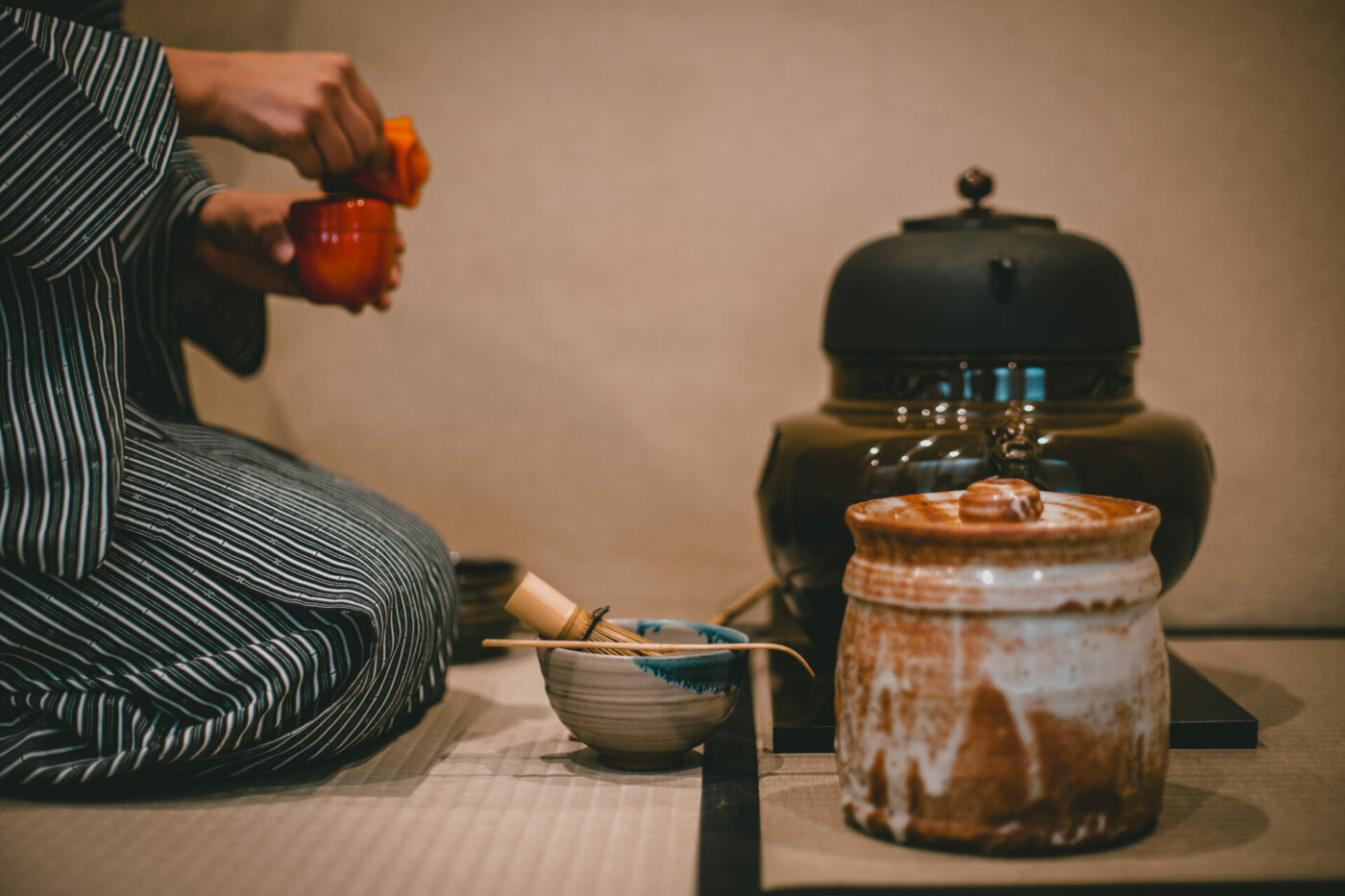
READ NEXT: Things to do in Kyoto
Japanese Cuisine Cooking class
If you really want to dive deep into traditional Japanese cuisine and be able to cook your own meals at home, then joining a Japanese cooking class is a fun experience. There are many different cooking classes available everywhere, from Tokyo to Osaka, depending on what dishes you want to learn how to make.
If you want to make some of the most famous traditional Japanese foods, try this sushi-making class in Tokyo or this ramen and gyoza cooking class in Osaka .
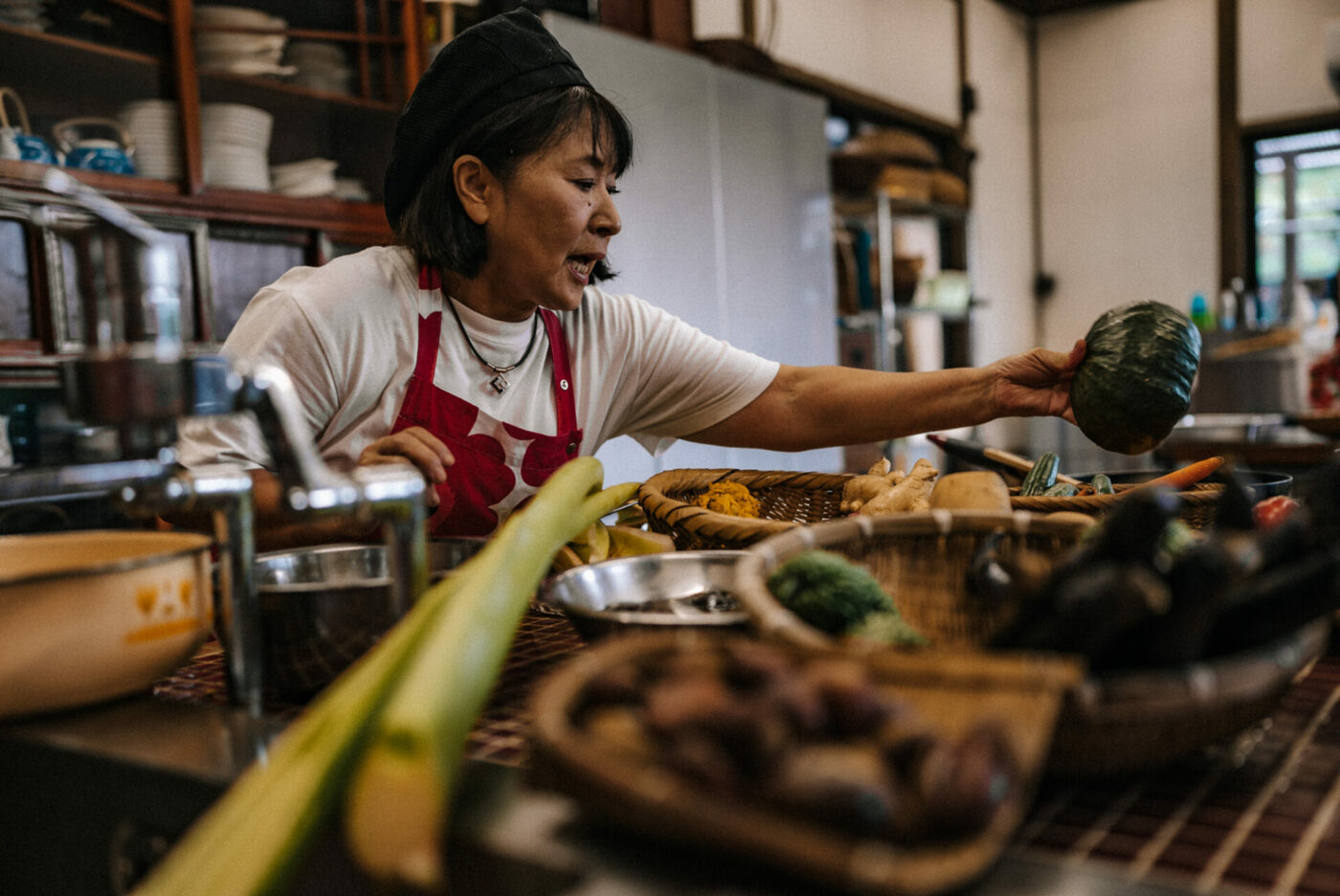
Yakitori Alley Exploration
Yakitori is a Japanese style of grilled meat on bamboo skewers, and the best place to try it is Yakitori Alley. Located just north of Shinjuku Station in Tokyo, the street is actually named Omoide Yokocho (memory lane) but is better known as Yakitori Alley for its tiny restaurants serving skewered chicken sticks.
You’ll find various types of skewers with either soy-based sauce or simple salt grilled over charcoal. The restaurants in Yakitori Alley are usually very small and can accommodate just a few patrons per store. Besides yakitori, there are also restaurants that serve gyoza, izakaya food, and udon noodle soup dishes, so everyone can find something to eat.

Okonomiyaki at a Teppanyaki Grill
Okonomiyaki is often referred to in English as a Japanese pizza but is more of a combination of pizza and savoury pancake. Okonomiyaki starts as a flat pancake made of wheat flour, egg, and chopped cabbage and is then topped with cooked meat, seafood, and other vegetables.
The Japanese word Okonomi literally means “to one’s liking,” which reflects the variety of okonomiyaki available across Japan depending on the region and customers’ preferences.
Osaka and Hiroshima are most famous for this Japanese meal, which you can find served in teppanyaki grill restaurants. Teppanyaki refers to ingredients grilled on an iron griddle and is often equipped at each table so you can cook the meal yourself. The best way to experience this traditional Japanese food is to head to one of these restaurants to cook it up yourself.
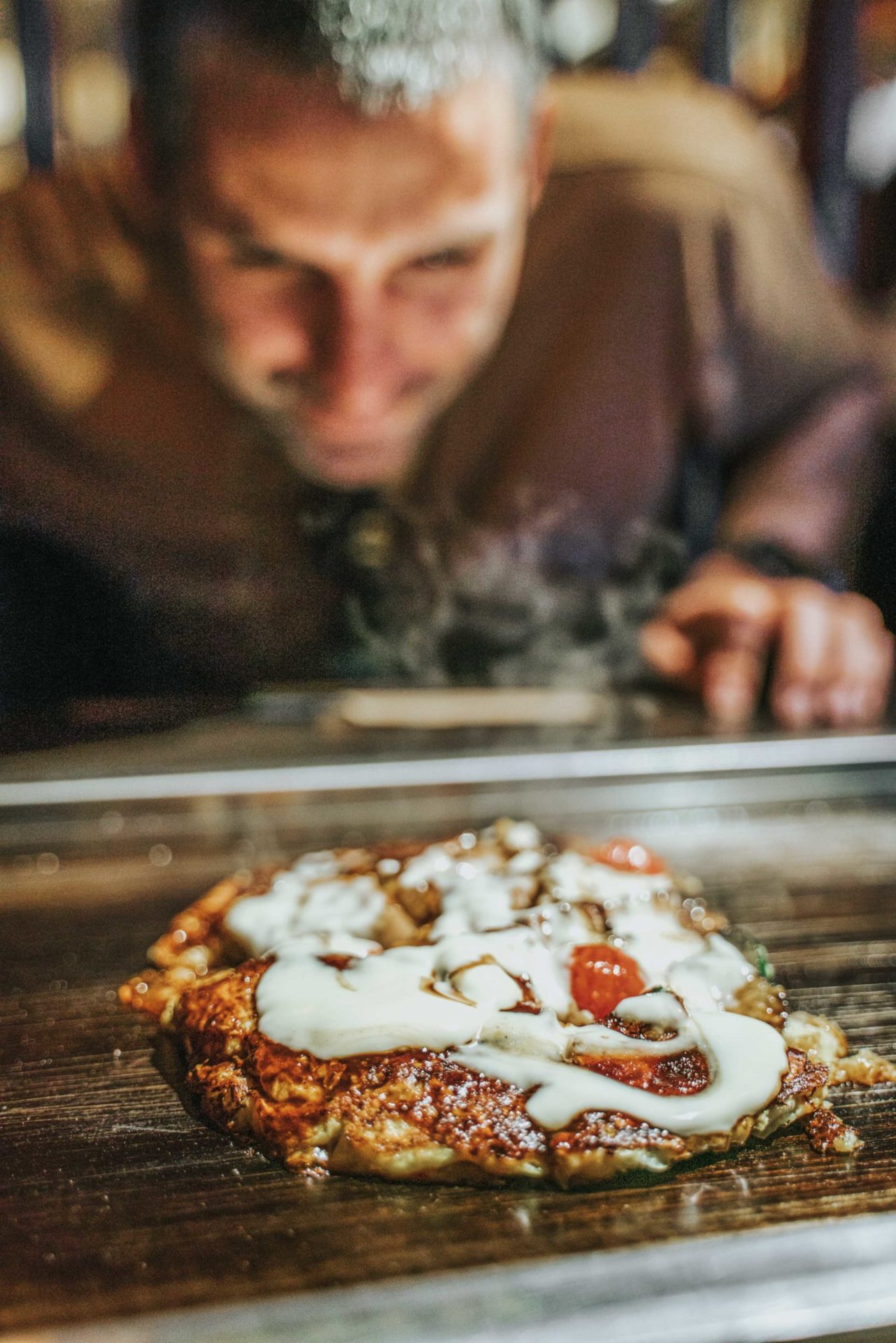
Street Food Tour
Sometimes, the best way to experience Japanese cuisine is not necessarily by visiting Japanese restaurants but more about discovering all the unique local delicacies in the markets and streets of the big cities. Join a guided street food tour to try all the best local foods while getting a cultural lesson with a local guide.
Spend a few hours with a local guide exploring Tsukiji Market in Tokyo , try up to 13 dishes at five local eateries on a food tour in Shinsekai in the back streets of Osaka, or stroll around Gion and Nishiki Market in Kyoto in the bustling morning hours with a guide.
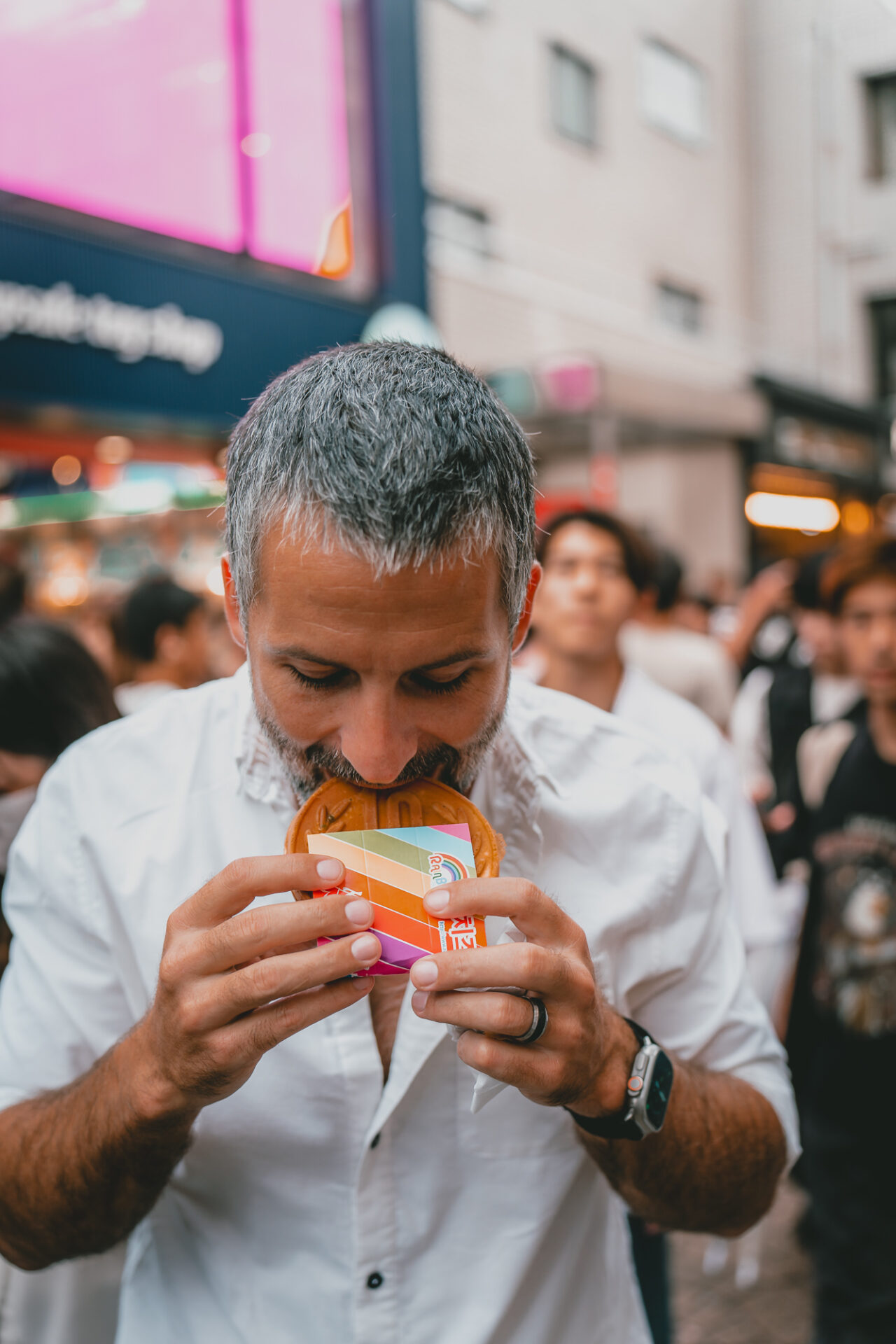
Best Japanese Dishes to Try
Ok. Now let’s get into the actual list of dishes to add to your Japan food bucket list. If you’re looking for the top Japanese dishes to try on your first trip to Japan, these are the must-try meals to add to your list.
1. Sushi (すし)
Sushi is definitely the most famous Japanese meal outside of Japan. It was once referred to as pickled fish preserved in vinegar, but nowadays, it can be defined as any dish containing vinegared rice and raw fish. Sushi is often served with soy sauce, wasabi and pickled ginger.
There are various types of sushi, including sashimi (raw fish), norimaki (sushi rice and seafood wrapped in dried seaweed sheets), nigiri (small rice balls with raw fish draped on top), or gunkan (little round cups of sushi rice wrapped in dried seaweed and filled with seafood like fish eggs, sashimi, crab or sea urchin).
Sashimi is, of course, one of the most common things served in Japanese restaurants, especially sushi restaurants and izakaya and are a standard element of traditional kaiseki course meals. Sashimi consists of thin slices of raw fish or seafood served with soy sauce and wasabi.
The slices of raw fish are usually presented on top of shredded daikon or garnished with shiso leaves. The most common fish used are fresh tuna, salmon, saba or mackerel, and squid.
While it’s common outside of Japan to drench sushi in sauces, in Japan – all you need is a light dip of soy sauce for the perfect taste.
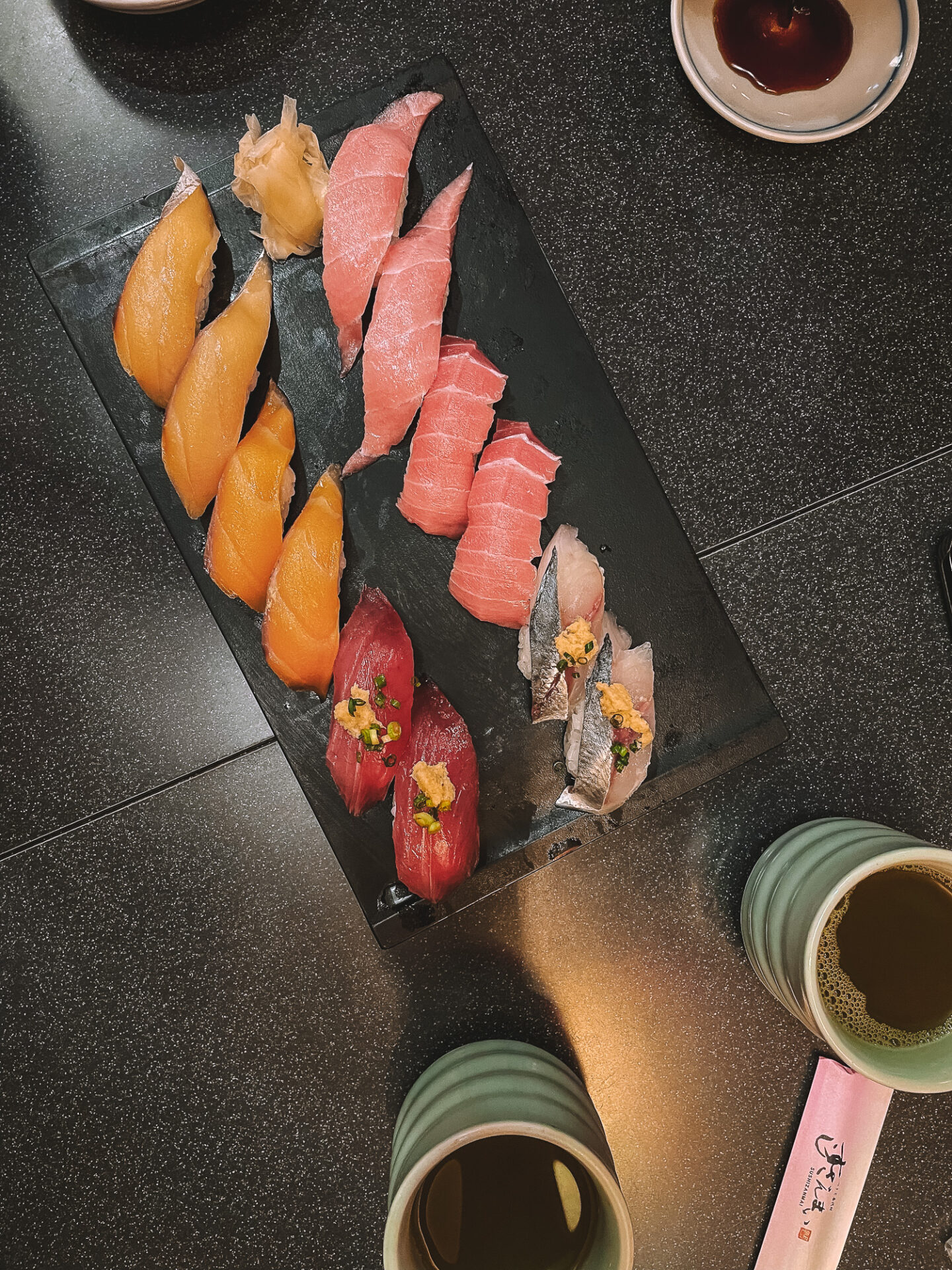
2. Ramen (ラーメン)
Technically originating in Southern China, ramen is a Japanese word which is derived from the Chinese word lamian (拉麵), meaning “pulled noodles”. The noodle soup is an inexpensive and popular Japanese comfort food. You’ll find ramen restaurants on every corner in cities across Japan.
The Chinese-style hearty noodle dish consists of noodles usually made from wheat flour, along with a meat or fish-based hot broth, along with a variety of toppings such as slices of pork belly, raw or cooked bean sprouts, soft-boiled, marinated or raw egg, bamboo shoots, and seaweed.
Ramen noodle dishes are typically categorized according to their soup base, with popular options including:
- Miso ramen which is flavoured with soybean paste (miso) originating in Hokkaido
- Shoyu ramen flavoured with soy sauce, and
- Tonkotsu ramen made from boiled-down pork bones originating from Kyushu.
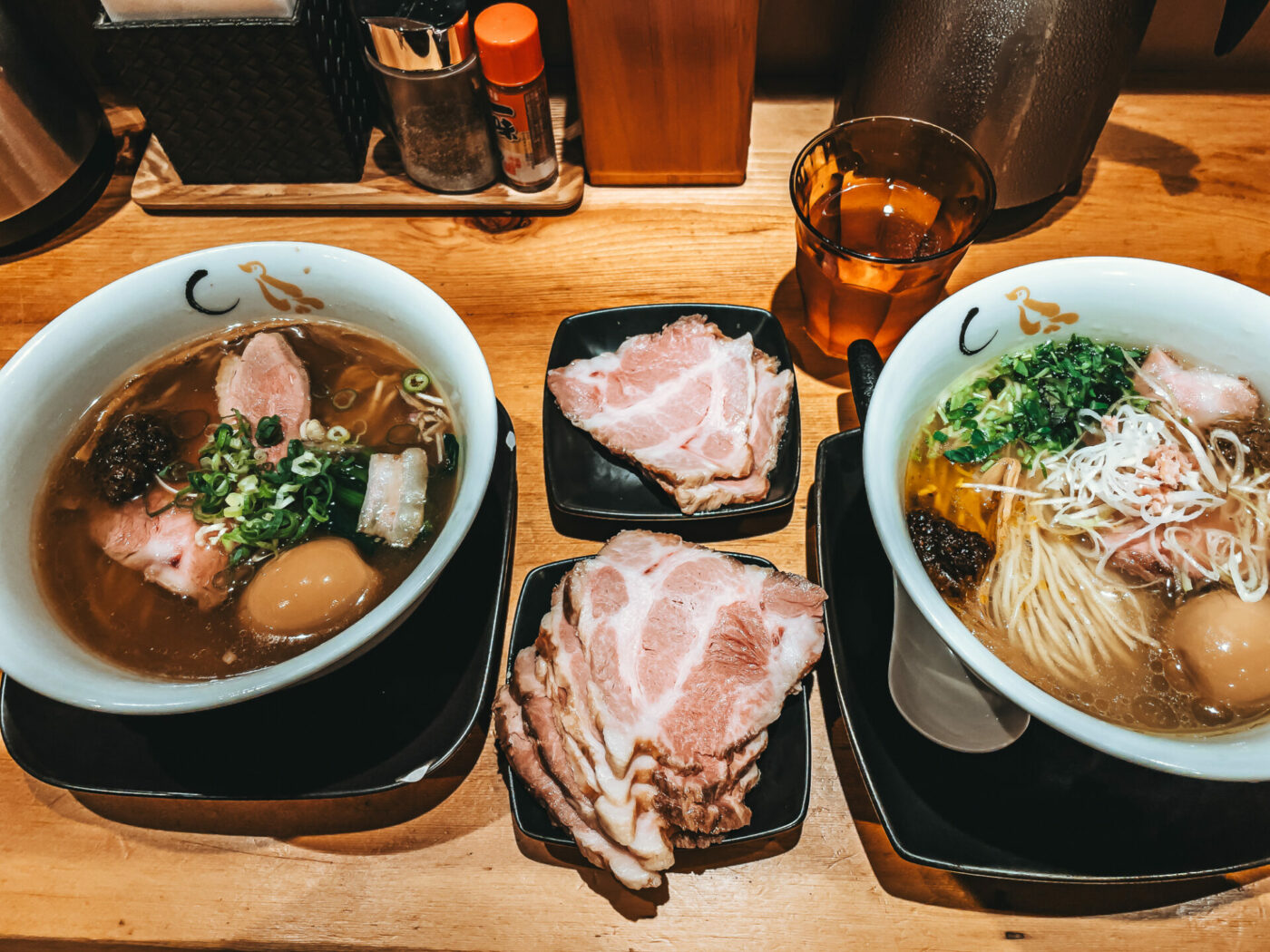
3. Tempura (天ぷら)
It is said that tempura was brought to Japan by the Portuguese in the 16th century, but it has since become one of the most recognized Japanese dishes around the world. Tempura consists of lightly battered and deep-fried food , ranging from seafood to vegetables.
Tempura is commonly served either as a main dish, a side dish with dipping sauces, or as a topping for steamed rice bowls or Japanese noodles. There are specialized tempura restaurants known as tempura-ya, but these are often expensive, high-end places. It’s worth visiting one for a unique “make your own tempura” experience.
You can also find tempura at street markets as snacks and side dishes across the country.
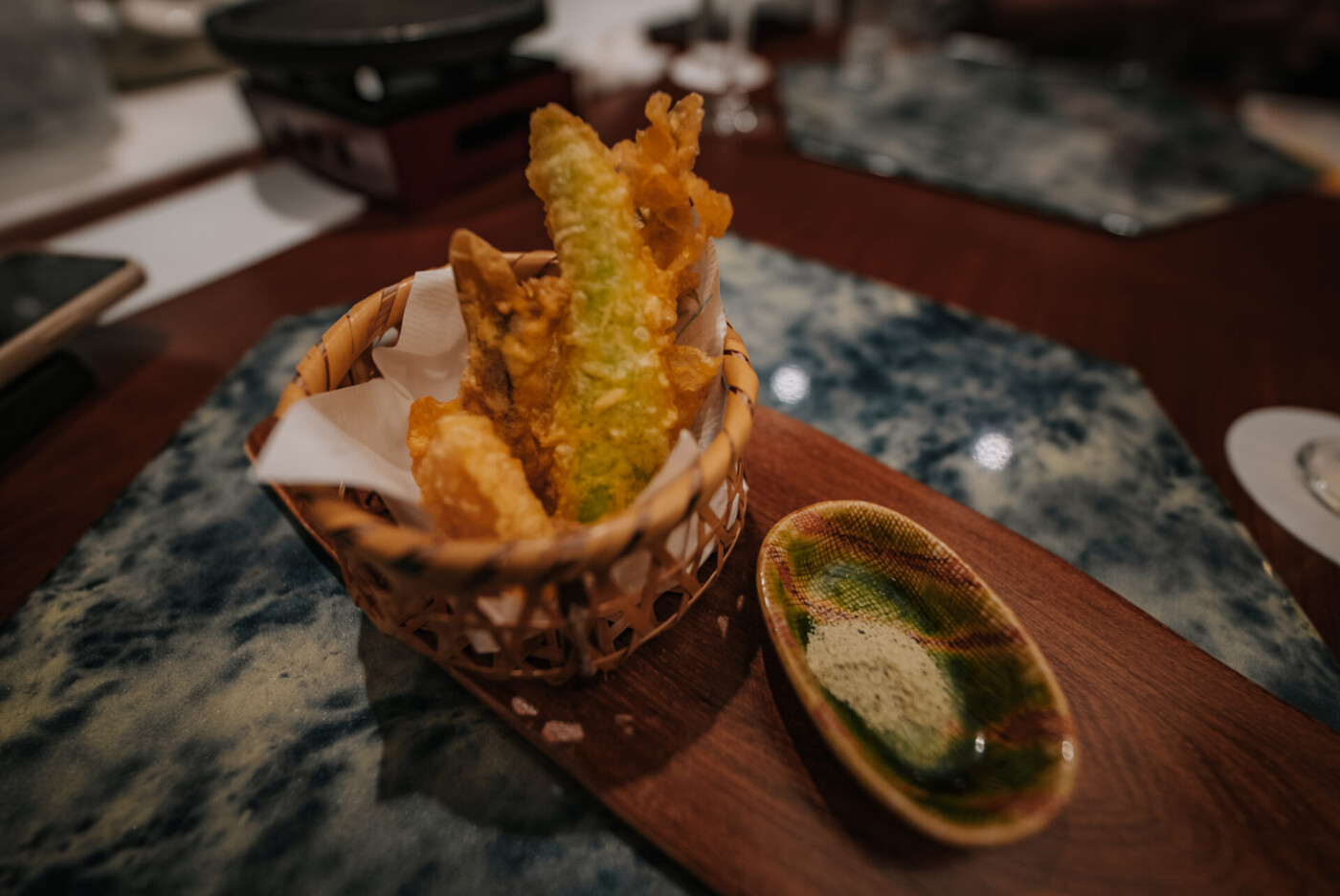
4. Okonomiyaki (お好み焼き)
A savoury pancake that is extremely popular amongst foreigners and tourists in Japan. Often referred to as Japanese pizza, okonomiyaki is made from wheat flour and shredded cabbage and is topped with various ingredients like meat or seafood. There are also vegetarian options.
Okonomi means “to one’s liking,” as there is a huge variety of okonomiyaki available, and it can easily be tailored to customer preferences. If you want to try the most traditional version, head to Osaka or Hiroshima, where you can find them served in Teppanyaki Grill restaurants.
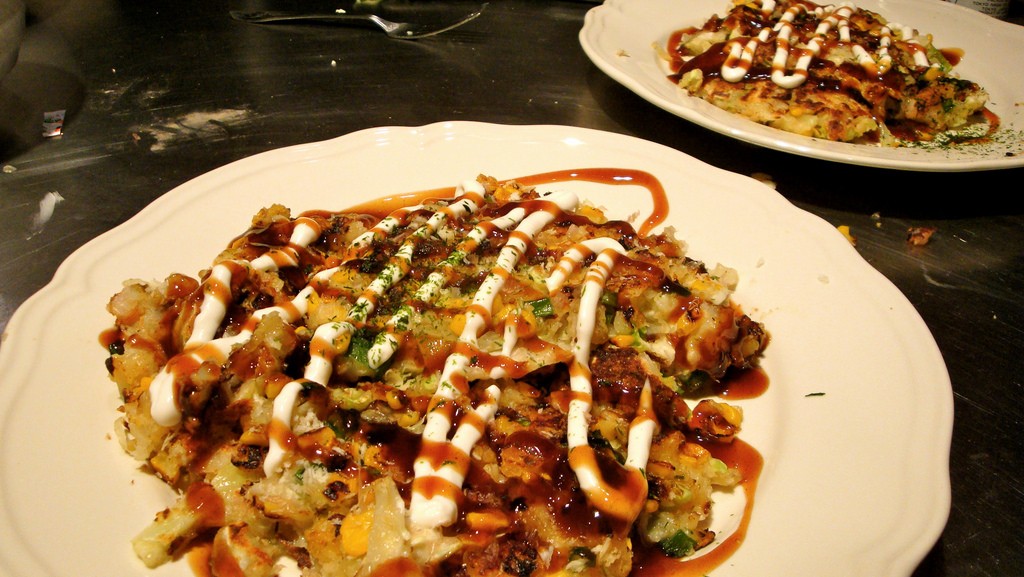
5. Udon (うどん)
Udon noodles (not to be confused with Soba Noodles) are thick wheat flour noodles served in a variety of ways. The most popular udon dish is udon noodle soup, made with a mild broth called kakejiru with flavours of dashi, soy sauce and mirin. The soup is topped with scallions or green onions, tempura and grated radish.
The difference between Udon and Soba is that udon is thicker than soba noodles, which are made from buckwheat flour, and are much chewier. Udon is widely available at restaurants across Japan and can be served hot or cold. You can find it at specialty udon or soba restaurants, as well as more fast food-type restaurants at train stations.
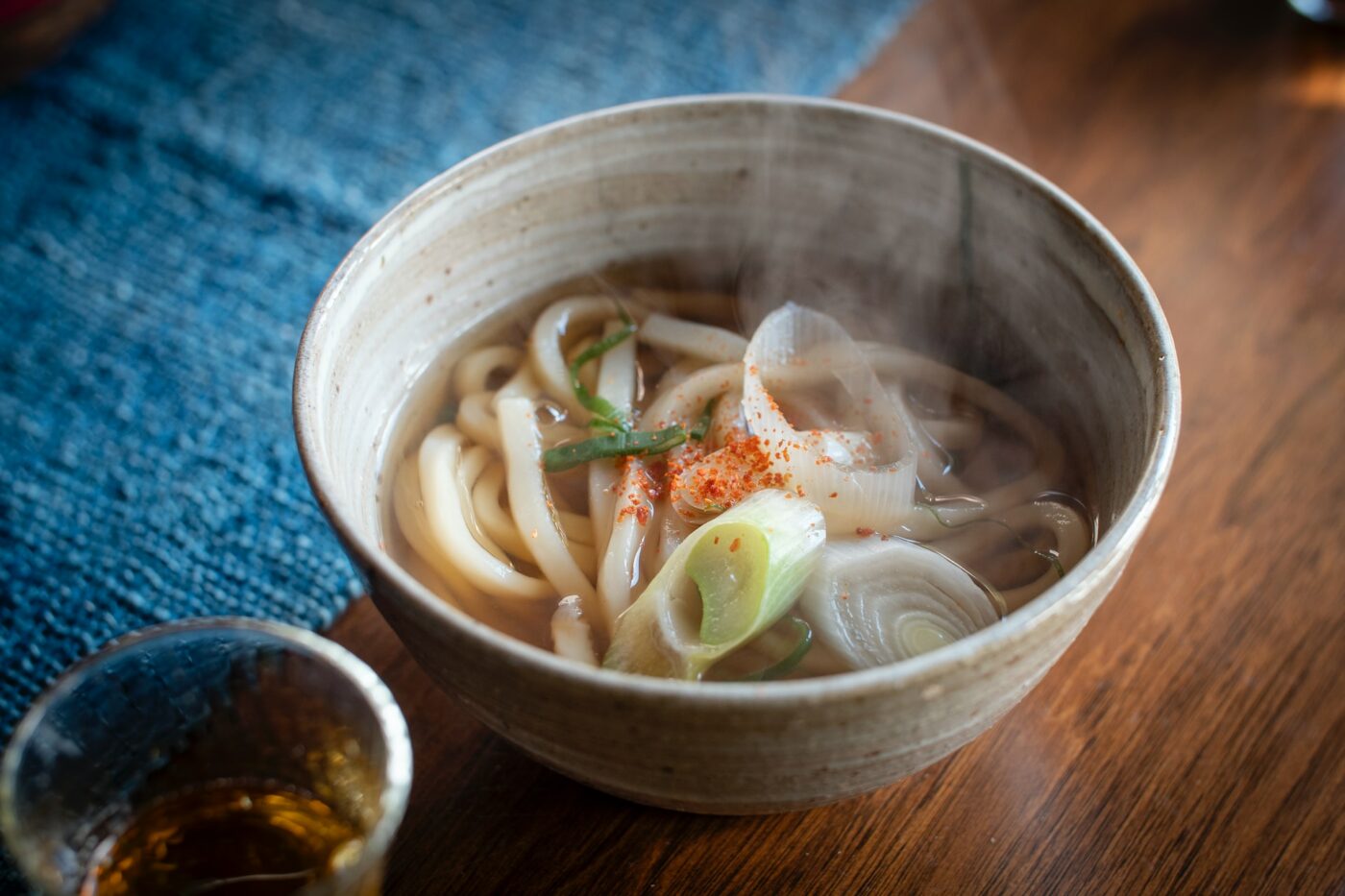
6. Tonkatsu (とんかつ)
Tonkatsu is a deep-fried, breaded pork cutlet. It is made by coating slices of pork with panko (bread crumbs) and deep frying them in oil. It is considered the Japanese equivalent to schnitzel in Europe.
While pork is by far the most popular katsu dish, there are other variations made of chicken ( chikinkatsu ), beef ( gyukatsu ), and minced meat ( menchikatsu ). Tonkatsu is usually served with shredded cabbage and tangy dipping sauce. It’s served both in restaurants and at cheap, convenience stores and station eateries.
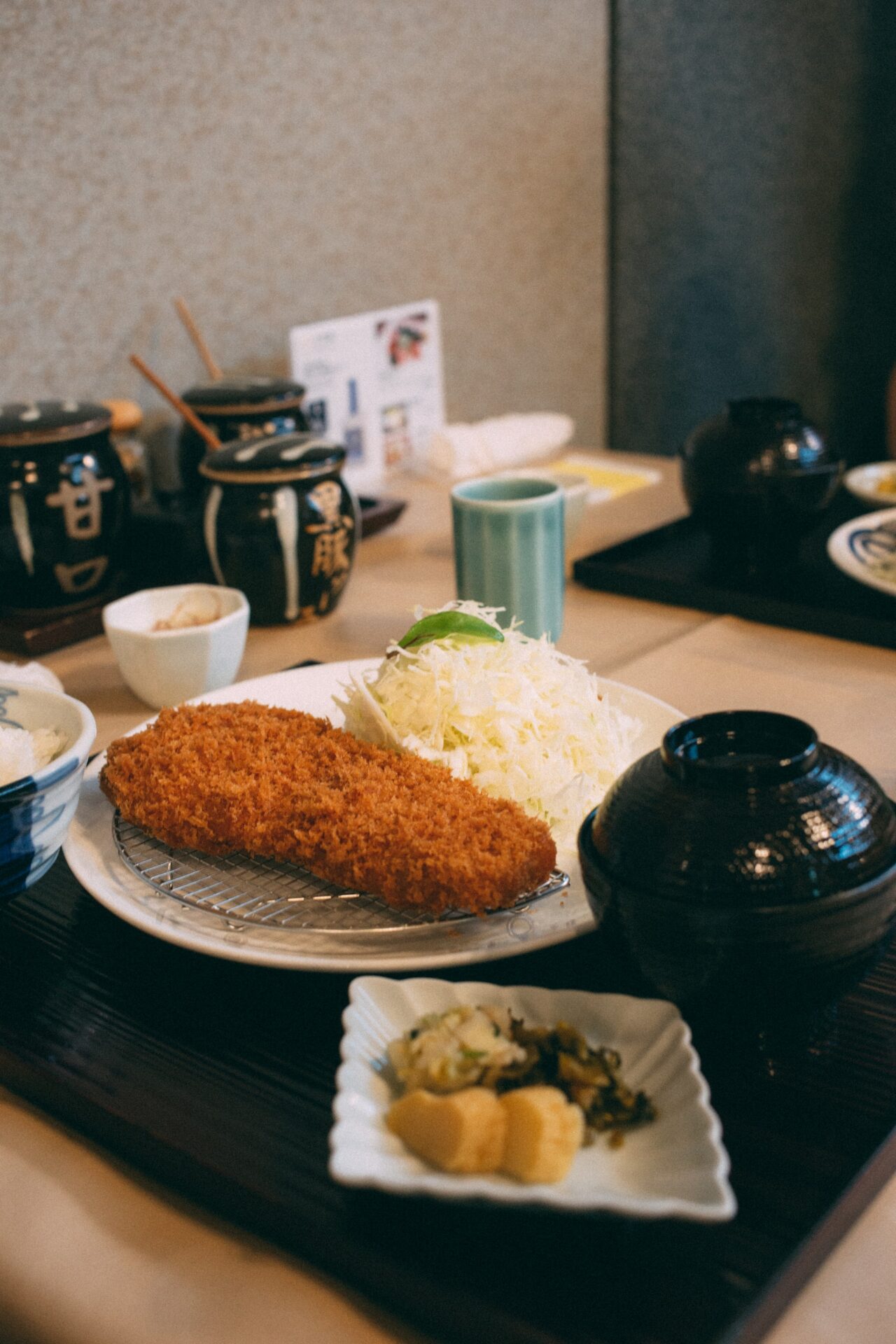
7. Yakitori (焼き鳥)
Yakitori (literally, grilled chicken) is a general term used to refer to grilled skewers. It’s one of the most popular Japanese meat dishes prevalent in small hole-in-the-wall restaurants nationwide.
While the dish name refers to chicken skewers, yakitori restaurants generally have a wide selection of meat skewers, consisting of different cuts and parts of chicken, pork, beef, etc. The skewers are usually marinated with either soy sauce-based or simple salt grilled over charcoal.
Yakitori is a common street food or quick-eat meal, particularly in markets. One of the best places to try it is at the aptly named Yakitori Alley in Tokyo , where you’ll find lots of small, tightly packed restaurants serving these skewered chicken sticks.

8. Miso Soup (味噌汁)
Miso soup is a staple in the Japanese diet and one of the most commonly eaten dishes in Japan. It’s not a meal in and of itself, but a much welcome accompaniment in meals both simple and extravagant, served at any time of the day.
This popular healthy meal is made from miso paste as well as a traditional Japanese fish stock called Dashi. Dashi is an umami-rich base made from dried seaweed and dried fish, which is then flavoured with miso paste made from fermented soybeans, salt and koji rice. It’s garnished with green onions, mushrooms or tofu, so it’s a great vegetarian option.

9. Gyoza (餃子)
Gyoza is Japan’s dumplings , which consist of a range of fillings wrapped in thin dough. The typical gyoza is filled with ground pork, nira chives, green onion, cabbage, ginger, garlic, soy sauce and sesame oil. It’s not uncommon, however, to find gyoza with other fillings, like shrimp, veggies and others.
You can find specialty gyoza in places that incorporate local ingredients and unique flavours into this staple Japanese dish. One example is matcha gyoza wrappers made in Kyoto.
They are typically pan-fried and served with a dipping sauce from a street stall or at a market. Gyoza are some of the most consumed foods in Japan along with sushi, ramen and curry rice, and are especially popular with budget travelers.
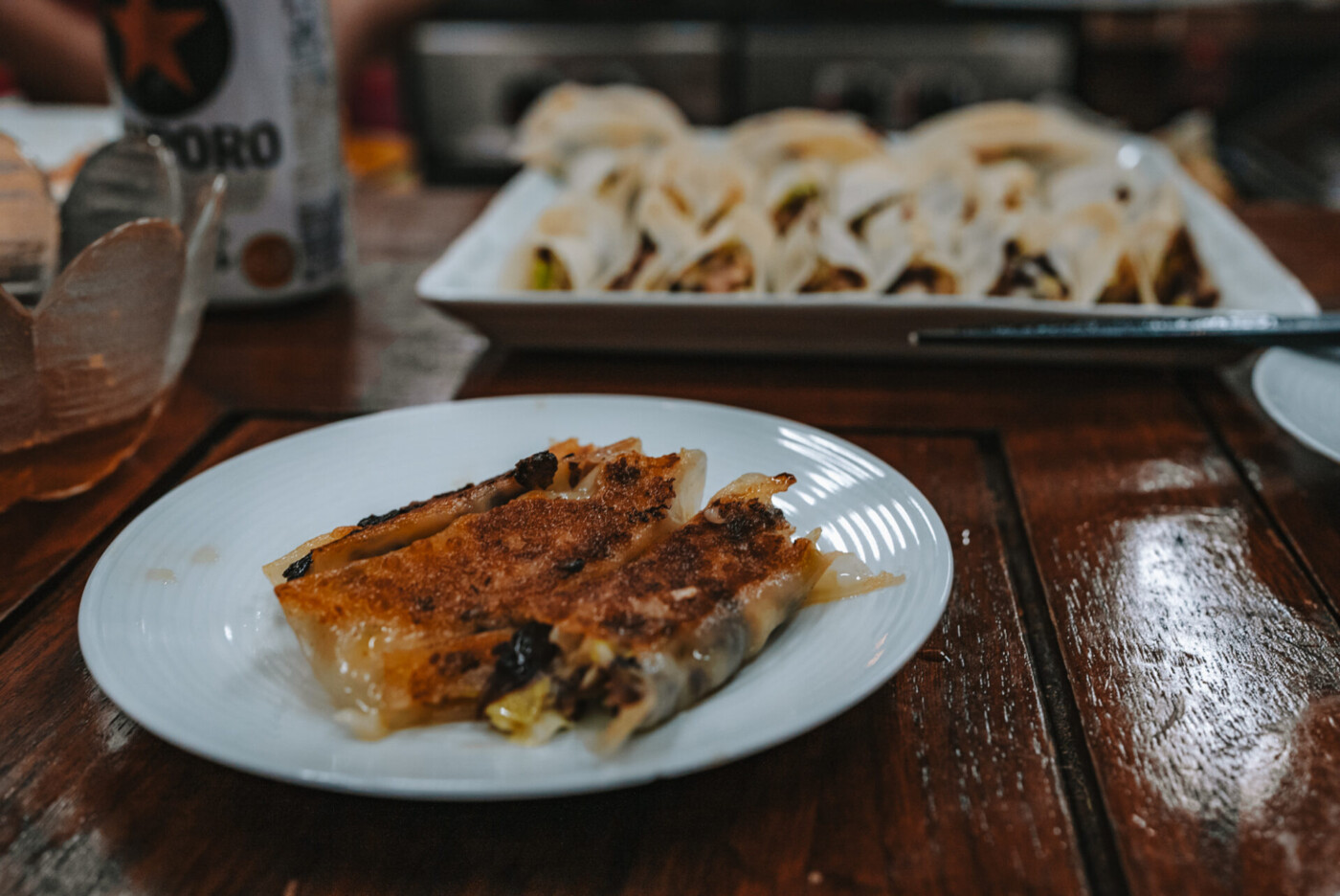
10. Takoyaki (たこ焼き)
Takoyaki is the Japanese term for “octopus grilled/fried,” and they are a very popular yatai (or street food) snack that originated as a street food snack in Osaka. Takoyaki are made from a wheat and dashi stock batter, similar to okonomiyaki. The batter is filled with octopus, tempura scraps, pickled ginger and green onions and cooked in a special cast-iron pan that gives them their perfectly round shape. These octopus balls are typically served topped with takoyaki sauce and bonito flakes.
You can find Takoyaki balls in many street markets across Japan, particularly during festivals.
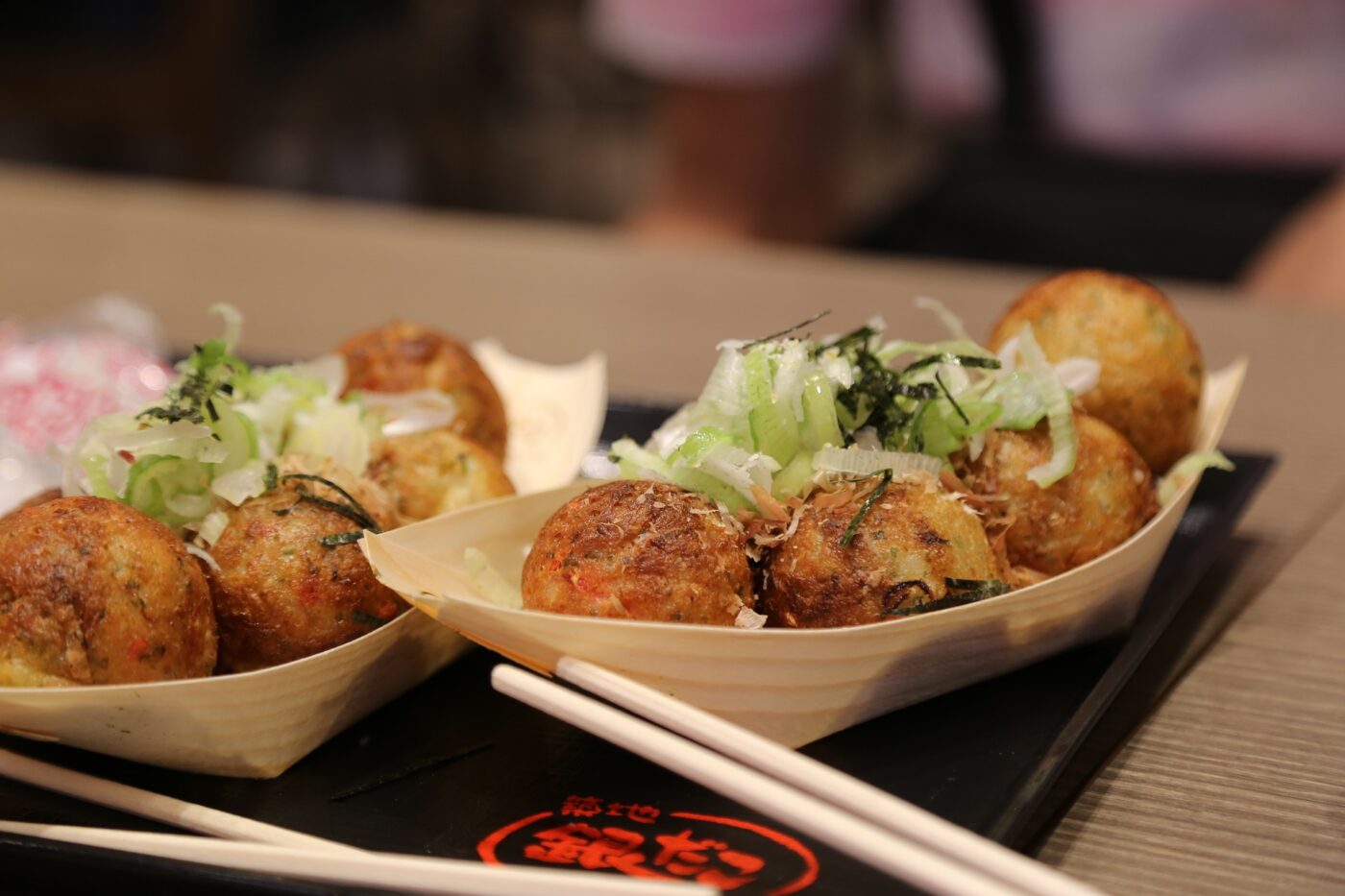
11. Chawanmushi (茶碗蒸し)
Chawanmushi literally means “tea cup steam” or “steamed in a tea bowl,” making it an incredibly unique Japanese food. It’s an egg custard dish that is savoury rather than sweet and is made with a few simple ingredients: dashi, eggs, soy sauce, and mirin. It’s sometimes garnished with shrimp, mushrooms or ginkgo nuts.
Chawanmushi can be served hot, warm, or cold and is one of the few meals in Japanese cuisine that is traditionally consumed with a spoon.

12. Katsudon (カツ丼)
Katsudon is a popular, simple rice dish that is a safe bet when ordering at a restaurant. It consists of a bowl of steamed rice, topped with a breaded and deep-fried pork cutlet ( tonkatsu ), along with an egg, vegetables like sauteed onion, and a sweet and savoury sauce. It’s an easy meal that you could replicate at home to remind you of the food in Japan.

13. Oden (おでん)
Oden is a type of nabemono or hot pot dish. It consists of several ingredients, such as boiled eggs, daikon radish, and fish cakes stewed in a soy-flavored dashi broth. It’s a classic winter hot pot dish and a family favourite for the colder months. It’s usually served in a donabe clay pot and shared with family and friends.
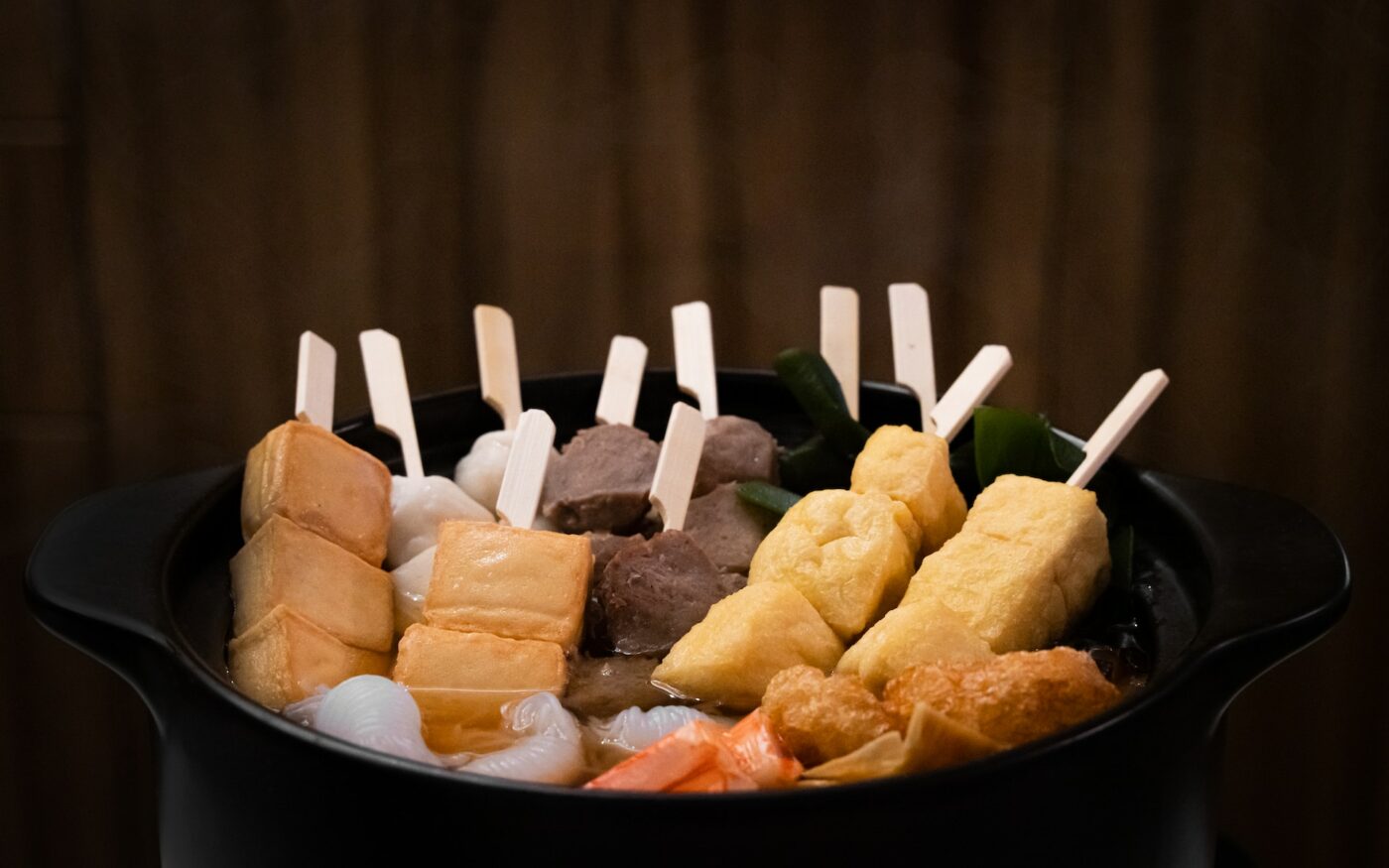
14. Sukiyaki (すき焼き)
Another of the comforting hot pot dishes in Japan is sukiyaki. It consists of thinly sliced beef that is cooked or simmered in a shallow cast-iron pan alongside vegetables such as onions, mushrooms, Chinese cabbage, and tofu.
A sweet soy sauce is used to marinate the meat and vegetables, and noodles are often added at the end to mop up the remaining liquid. A range of noodles are added depending on regional varieties, including vermicelli noodles, udon noodles, and shirataki (konnyaku noodles). The dish is cooked at your table over a small gas burner, with diners taking the food directly from the pot.

15. Mochi
We’ve kept this list focused on savoury dishes only, but it would be a crime not to add the sweet, squishy dessert called mochi to this list of best Japanese foods.
Mochi is made from glutinous rice pounded into a sticky, chewy consistency. Sweet mochi can be filled with red bean paste, ice cream, or fruit, adding a diverse flavour to this simple treat.
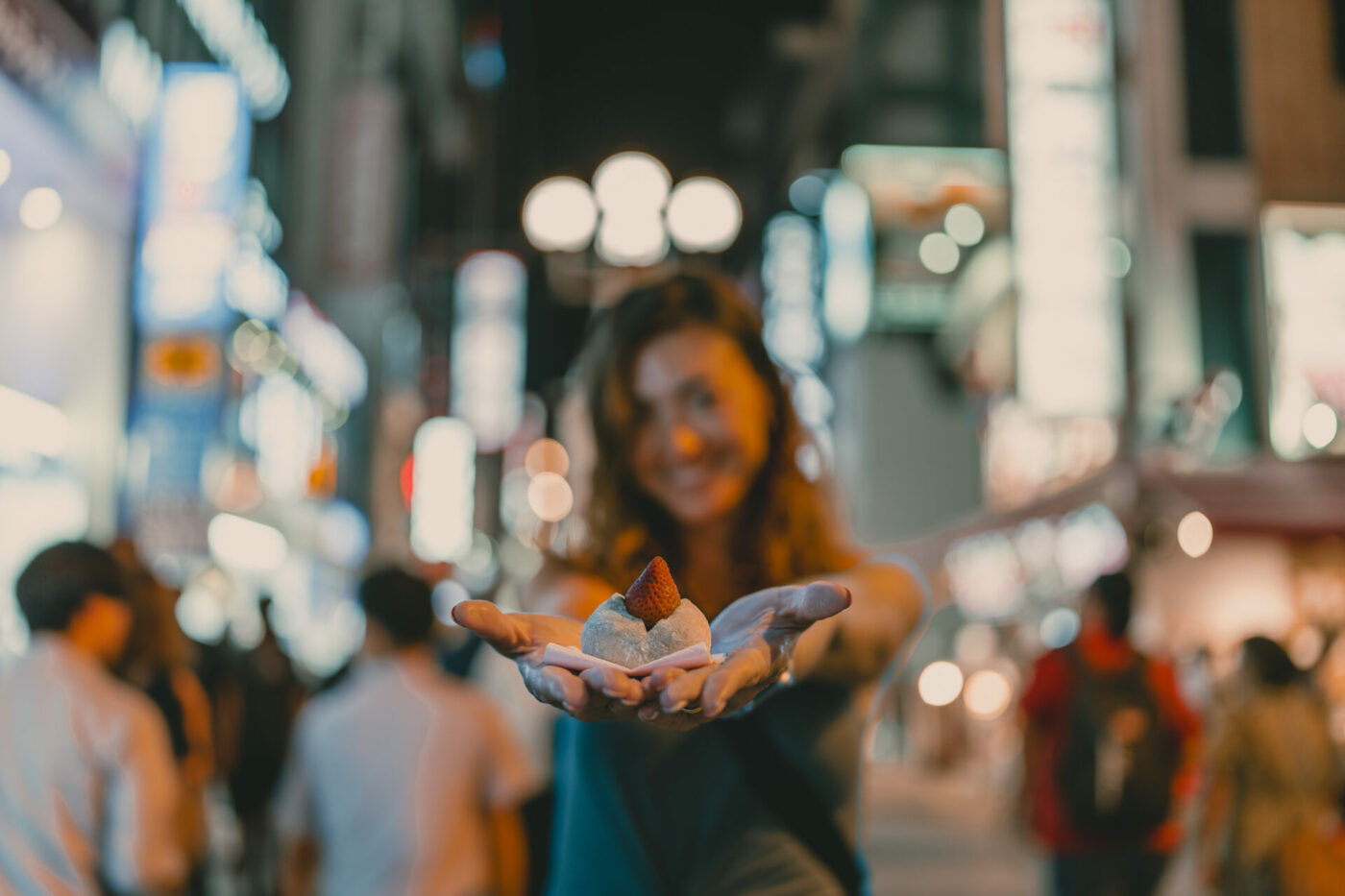
So there you have it – a mouthwatering list of our favourite Japanese dishes. It may seem overwhelming at first, but we guarantee – you’ll be able to try and most likely enjoy them all during your time in Japan.
In our family, we have a rule – you don’t have to eat it, but you have to try it!
We hope you give all of these a try!
About The Author
Oksana & Max St John
Leave a comment cancel reply.
Your email address will not be published. Required fields are marked *
This site uses Akismet to reduce spam. Learn how your comment data is processed .
Tanzania Trip Details
Enter your name and email to get our Tanzania Safari Trip brochure with more details about this trip in your inbox.
Join our 2025 Group Trips Pre-sale List
Be the first to know about NEW Trips and SPECIAL Offers!
Have 5 minutes to share more info? Fill out the Pre-Sale trip survey HERE
Reignite the Feminine Retreat
Love the idea of a women-only retreat in September 2024?
Help me decide where we should go!
Our women-only gatherings will be limited to 8-10 people, so leave your details below to add yourself to the waitlist.
We'll email you first to share all the details of the trip.
- Tours & Experiences
- Tailor-made Trips
- Bahasa Indonesia
We are happy to see you again!
Continue with
Or use email.
No Account? Create one
Create account
Already have an account? Sign in
Quickly Sign up with
I agree to Japan Travel's Terms of Service and Privacy Policy . Terms of--> and acknowledge that Japan Travel's Privacy--> applies to me.-->
Email reset password link
Please check your inbox and click the link we will send to you.
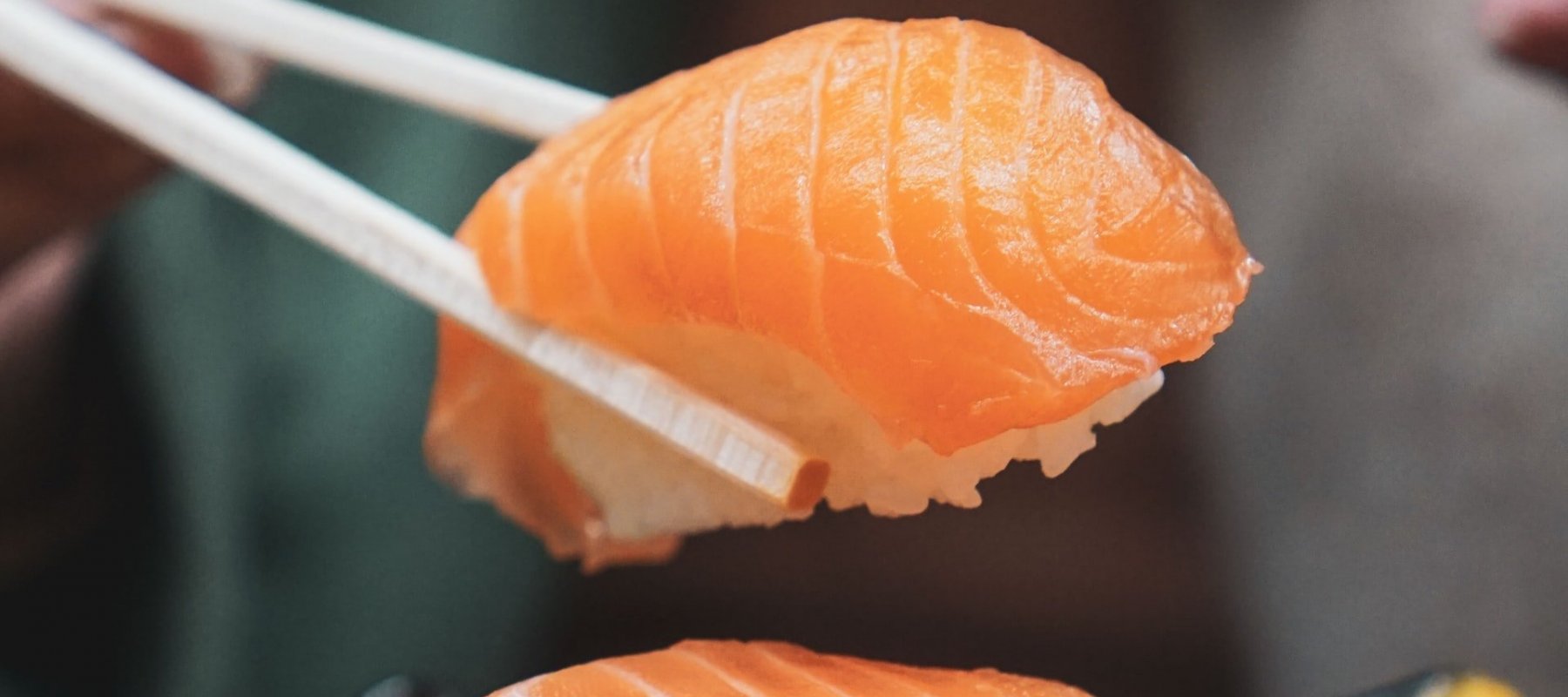
Kirby Cafe Tokyo
This new permanent cafe is located on the 4th floor of Solamachi, Tokyo Skytree, and is sure to bring a smile to any Kirby fan.

Mochi Pounding at Nakatanidou
Have your mochi pounded at breakneck speed by champion mochi-making experts before eating it fresh and warm on the spot.

SpongeBob Cafe “CAFE Secret Recipe” is Opening for ...
To celebrate SpongeBob’s 25th anniversary, Miyashita Park in Shibuya, Tokyo will be opening a pop-up cafe from June 13 to Nove..

Shirohige's Cream Puff Factory
Looking for the cutest cream puffs in town? Look no further! Shiro-Hige's Cream Puff Factory is the place for all you Studio..

Kill Bill Inspiration at Gonpachi
Gonpachi, the restaurant made famous by Quentin Tarantino in his 2004 film Kill Bill, serves delicious Japanese food to locals and..
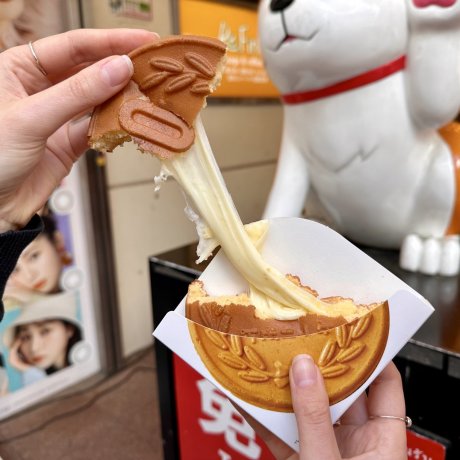
Viral ¥10-Shaped Bread
Are you a passionate foodie searching for the ultimate cheese pull? If so, look no further than the Mega Don Quijote store in ..
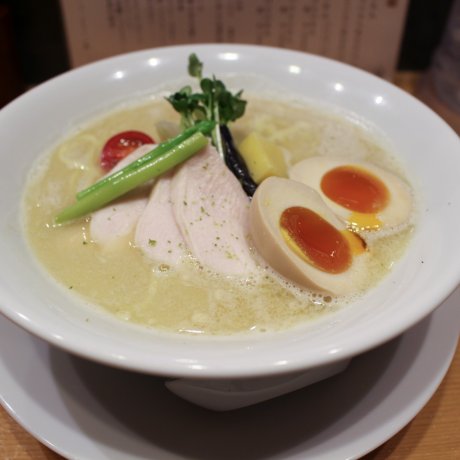
Kagari Ramen in Ginza
Experience tori paitan soba, or chicken ramen, at this much-loved hidden gem in Tokyo's Ginza district.

Hiroshima: Food Guide
As you explore the prefecture’s natural beauty, historic temples, and urban museums and sculptures, why not also take your tas..
Search filters
Food top 10.
- Recommended

Tokyo Takes 2nd Place on Top Coffee Cities List

Sake at the Foot of Mount Fuji

Four Seasons Steak House

Foodies Guide to Authentic Japanese Cuisine

Only in Japan: Character Cafes in Tokyo

Cicada Sake and Teahouse

Cafe Gallery Doka Doka in Onna

SpongeBob Cafe “CAFE Secret Recipe” is Opening for a Limited Time in Shibuya

Shu'n Wine and Dine Swissotel Namba

Okinawa Goat Misaki
Let us know how we can help.
The quintessential Japanese food; in its homeland the craft of sushi is taken to almost religious extremes, with renowned chefs training for decades and going to insane lengths to create the perfect (usually very expensive) bite. It wasn’t always such an elite craft. Japanese sushi has its roots in the street food culture of medieval Tokyo, with pieces of nigiri (a rectangular bed of vinegar-seasoned rice topped with a slice of raw fish) served up from stalls and eaten by hand.
Of all the types of fish on the menu, fatty tuna is the gold standard. These melt-in-your-mouth fish are so coveted that the first giant maguro (bluefin tuna) of the year from Toyosu Market sold for almost $1.8 million in 2020! You read correctly — one point eight million USD.
Learn the secret to amazing sushi by taking part in a sushi-making class in Tokyo .
2. Okonomiyaki
The Japanese will often tell you that this griddle-fried dish is a “Japanese savory pancake,” or something along those lines, but that doesn’t quite fully describe it. Okonomiyaki is made from an egg-and-flour batter mixed with cabbage and fried. Other ingredients can also be added according to regional recipes and your personal taste (in fact, okonomi literally translates to "preference"). These can include pork belly, kimchi, various vegetables, and usually a topping of dried bonito fish flakes, mayonnaise, and special okonomiyaki sauce.
Learn how to make okonomiyaki from scratch in one of our authentic okonomiyaki cooking classes .
3. Miso Soup
A firm staple in the Japanese diet, you can find this thin soup on the menu for breakfast, lunch, and dinner. Miso soup is made from dashi stock and miso: a salty-tasting paste made from fermented soybeans and rice koji. There are four main categories of miso — white miso, red miso , blended, and barley—and dozens of regional varieties, each of which produces a distinctive soup.
4. Yakitori
These reasonably priced grilled chicken skewers are a favorite among after-work diners looking for a cheap and relaxed meal with a few beers. Step inside a yakitori restaurant , and you’ll be met with the heat of burning charcoals, with chefs busy fanning away at them and arranging skewers with pretty much every piece of the chicken imaginable, from the breast and thigh to the heart, gizzard, and cartilage!
Enjoy some of the best yakitori in Tokyo on a private yakitori tour in Shinjuku .
5. Udon
These thick wheat-flour noodles are thought to have been introduced to Japan from China around 800 years ago. Nowadays, udon is a hearty and inexpensive lunch option, usually boiled and then served with a simple broth. Kake udon features those two ingredients alone, and although it might look basic, it actually makes for a very hearty meal by itself. If you want a bit more bite, udon shops usually offer a wide range of toppings such as raw egg, tempura bits, and spring onion.
Make your own udon from scratch in Tokyo in a homemade udon cooking class !
6. Takoyaki
These octopus-filled wheat batter balls hail from Osaka , where they were invented by a street vendor in the 1930s. The distinctive takoyaki ball shape is achieved by using a specialized pan with half-sphere indents across its surface. Flipping the batter at the right time to get the perfect ball shape takes some skill. If you think flipping pancakes is tough, try doing it two dozen times in a row — with chopsticks! The traditional style of takoyaki is topped with dried bonito flakes, dried seaweed flakes, and a special takoyaki sauce.
Takoyaki is one of the must-try foods in Osaka , but be careful; they're served piping hot!
This is without a doubt one of the oldest dishes on the list, thought to have been first made in China over 6000 years ago. However, these buckwheat noodles were only popularized in Japan during the Edo period. Much more healthy and nutritious than many of the other noodle varieties, it was found that eating soba could prevent nutritional deficiencies.
Like udon, soba is a noodle that you can learn to make in our handmade soba noodles cooking class .
8. Sukiyaki
This Japanese hot pot dish is perfect for social dining, with raw beef, noodles, and vegetables cooked at your table in a shallow iron pot of boiling broth made from soy sauce, sugar, and a type of rice wine for cooking called mirin. The thin strips of beef are usually dipped in raw, beaten egg after cooking.
It was invented during the Edo period but failed to fully catch on due to strict Buddhist restrictions on meat consumption. Beef could only be eaten on special occasions or if one was recovering from illness. These restrictions were eventually lifted, but sukiyaki maintained its status as a treat dish for celebrations, popular for end-of-year parties among coworkers and families.
9. Sashimi
Some Japanophiles will delight in pointing out the technical difference between sushi and sashimi if you fall into the trap of assuming they’re the same thing. Don’t let that intimidate you! Basically, sashimi is sushi without the rice. You’ll usually find it as a dish in fancy set-course meals, or as an appetizer at izakaya gastropubs.
From the early 17th century onwards, unagi was an inexpensive and common meal among the people of Japan due to the abundance of eel in the rivers and streams. Its status as a delicacy nowadays can be blamed on Japan’s insatiable appetite for this delicious fish, traditionally eaten grilled and coated with sweet and salty tare sauce. Unagi is said to give energy and vitality, so it has long been eaten on the Day of the Ox as a remedy for midsummer fatigue and as an aphrodisiac for men.
The history of this soybean curd ingredient, now a popular vegan staple, stretches back to ancient China. It’s said to have been discovered by a Chinese chef who accidentally curdled his soy milk with seaweed. There are many different types of tofu eaten across Asia, from thin noodle-like strips to huge yellow sheets, but the most common types in Japan are the white block varieties; mainly the firmly-pressed momen (literally meaning "cotton"), the unpressed and incredibly smooth kinu (meaning "silk"), and yuba ("hot water leaf"): thin sheets of skin formed on top of boiled soy milk.
12. Onigiri
The savior of many a famished salaryman, rice balls (the Japanese equivalent of a sandwich) can be found on the shelves of every convenience store—far and away the most convenient choice for a meal on the go. Onigiri are perhaps the oldest name in the Japanese snack game; as long as 2,000 years ago, laborers and fishermen were known to carry pressed rice balls around in their day packs. The current form of onigiri can be traced back to the Edo period when the edible seaweed wrapping was introduced. Inside, you’ll usually find salty fish fillings, pickled plum, or more modern additions like teriyaki chicken. See our beginner's guide to common onigiri fillings for more classic and adventurous flavors.
13. Wagashi
These traditional sweets are the jewels of Japanese food culture. The wagashi (Japanese sweets) category is incredibly broad, basically referring to all regional, seasonal, and commonplace traditional Japanese sweets. Starting off in ancient times as very basic creations of mochi rice cakes (a sticky dough made from steamed and crushed rice) that were filled with nuts, these sweets evolved into ornate delicacies made to accompany the traditional matcha green tea ceremonies of the Edo period.
Common types of wagashi include taiyaki (a fish-shaped pancake filled with anko or custard), dorayaki (an anko pancake sandwich), daifuku ( mochi bites with various fillings), and namagashi (beautifully hand-molded rice flour and anko sweets). Browse wagashi-making classes and learn to make your own!
Legend has it that this divisive dish was invented by accident in the 11th century when the samurai Minamoto no Yoshiie left cooked soybeans in a straw bag on his horse’s back which had fermented by the time he got around to eating them. Many people would say he just should’ve thrown them away.
Natto is the Japanese equivalent of marmite—you’ll either love it or hate it. Despite its pungent smell, natto is a popular breakfast food. It’s also incredibly healthy due to the effect the bacteria has on the boiled soybeans, said to benefit heart health, digestive health, and bone strength.
15. Oden
One of Japan's popular winter comfort foods started out in the Muromachi period as a stewed tofu dish. Nowadays, other ingredients are added to the bone-warming oden broth, such as fish cakes, potatoes, boiled eggs, daikon radish, and other assorted vegetables. They’re usually simmered for several hours to infuse the ingredients with the flavor fully. The rich-yet-mild broth itself typically consists of dried bonito (skipjack tuna) flakes and dried kombu (kelp).
16. Shabu Shabu
This is far and away the most modern dish on the list, invented in 1952 at a restaurant in Osaka. You’d be forgiven for mistaking it for sukiyaki. After all, both of these types of Japanese food are hot pot dishes in which you cook thinly-cut beef strips alongside vegetables.
There are a few key differences though. Shabu shabu is cooked in a deeper pot with a milder and more savory broth. It’s also common practice to only partially cook the meat in a shabu shabu hot pot, and raw egg isn’t used as a dipping sauce.
17. Tempura
One of the pillars of Japanese cuisine, tempura consists of pieces of fish and vegetables coated in a light egg and flour batter, and then deep-fried. The technique actually found its way to Japan via Portuguese traders who were permitted to do business with the country in the 1500s. In fact, the name even comes from the Latin tempora — a word related to the Christian fasting weeks of Lent. It quickly caught on in Japan, becoming the favorite food of the first Edo shogun, Tokugawa Ieyasu.
The premise for ramen is deceptively simple: soup stock, flavorings, seasonings, wheat noodles, and toppings (usually fatty pork and vegetables such as bamboo shoots). However, within this simple formula, there’s massive room for interpretation. The huge variety can be pretty overwhelming, but we've got a comprehensive ramen guide to reference for your journey into the world of Japanese cuisine.
You’ll find instant ramen packets in supermarkets worldwide, but if you’re really serious about trying this dish, head along to any of the ten-thousand-plus local eateries across Japan that prepare it with fresh noodles, rich broths (miso, salt, soy, and tonkotsu being the main types), and generous helpings of toppings.
Keen to learn more about ramen? Join a ramen-making class . There's also a special option for vegetarian and vegan ramen .
19. Tonkatsu
As with many of the things we consider to be quintessentially Japanese, that’s only half the story of this breaded pork cutlet dish. Tonkatsu was invented at a Tokyo restaurant called Rengatei in 1899, served with rice and shredded cabbage. It was originally considered a Western-style dish due to the use of pork, which the Japanese rarely ate. On top of that, the Japanese curry sauce added to make the popular katsu curry was introduced to Japan by the British via India.
20. Kaiseki
A type of cuisine, rather than a food, this style of fine dining has its roots in the courtly culture of imperial Kyoto in the 16th century, when visiting samurai and dignitaries were treated to a series of small dishes to accompany traditional tea ceremonies. Today, anywhere from around 12 to 20 dishes feature in a typical kaiseki meal, with the exact offerings varying according to the season, the chef’s expertise, and how strictly they adhere to orthodoxy.
21. Kappo Ryori
Following the theme of Japanese cuisines, kappo ryori is a style of dining that originated in Osaka, offering a more casual counterpart to Kyoto’s kaiseki cuisine. Like kaiseki cuisine, kappo ryori utilizes seasonal and fresh ingredients; but whereas kaiseki dishes are generally prepared in a kitchen and then brought to your private room, kappo ryori is cooked by the chef right in front of their guests.
22. Shojin Ryori
Ever wondered how Buddhist monks eat? Their diet consists of mainly vegetarian cuisine (think lots of beans and bean-based products), and in Japan, even laypeople can enjoy a sophisticated Buddhist cuisine feast called shojin ryori . With subtle flavors, the meal features fresh mountain vegetables and nutty-tasting goma (sesame) tofu, among other dishes. Rice, soup, pickled vegetables, tofu, and a variety of sides form a well-balanced shojin ryori feast.
For a more traditional meal in Japan, join a shojin ryori food experience to step into the shoes of a Buddhist monk.
23. Osechi Ryori
Osechi ryori , symbolic Japanese New Year dishes , rolls around like clockwork every year, a feast for the first of January. It comes in a multi-tiered jubako (lacquerware box) and is filled with a variety of foods, each with its own special meaning. For example, the gold-colored kuri-kinton (mashed sweet potatoes with chestnuts) promises wealth, while the hunchbacked boiled shrimp represent old age and longevity. This array of dishes is often enjoyed through the first, second, and third of January, until every last bite is gone–allowing the usual cook of the household to relax for the first few days of the new year.
24. Zenzai / Oshiruko
Another typical menu item during the Japanese New Year, zenzai (also known as oshiruko ) is a sweet Japanese red bean soup with mochi. Usually served warm with toasted squares of mochi submerged in the broth, it’s a tasty wintertime sweet that’s also easy to make at home, this oshiruko recipe is testament to that!
25. Wagyu
Wagyu (literally “Japanese beef) is famed worldwide for its meticulous high standards, beautiful marbling of fat, and rich flavor. It can be cooked as a slab of steak, thinly sliced and swish-swished through hot shabu-shabu broth, or boiled in a sukiyaki hotpot and coated in a sauce of raw egg. The Japanese Beef Association strictly regulates all wagyu beef, and grades every cut of beef according to its marbling and yield. There are particular regional brands of wagyu in Japan that are highly coveted, like Matsusaka beef and Kobe beef .
26. Bento
Creativity, convenience, and color merge in the homemade Japanese bento . In recent years, this classic Japanese packed lunch has gained recognition for its adorable aesthetics, oftentimes featuring rice molded into cute characters and ingredients cut out into cute shapes.
Learn how to make your own colorful bento during this kyaraben (character bento) cooking class in Tokyo !
27. Omurice
A Japanese home-cooking staple, omurice is a comfort food that evokes childhood. Made with ketchup fried rice blanketed in an eggy omelet and decorated with a cute ketchup message or design, omurice is a favorite among children and nostalgic adults alike. Check out our omurice recipe to learn how to make this fun Japanese dish for yourself!
28. Kiritanpo
A traditional Japanese food that hails from Akita prefecture, kiritanpo is made of pounded rice that is shaped around wooden cylinders and toasted over a hearth. It can be slathered in a sweet miso sauce and eaten right off the skewer; or removed from the cylinder, chopped, and placed into soups.
If you know anything about traditional Japanese foods, you’re definitely familiar with the chewy, bouncy, stretchy mochi. It’s a type of rice cake that takes seemingly infinite forms: from red bean-filled daifuku mochi to toasty soybean powder-dusted kinako mochi, to savory applications like pillowy mochi dumplings in ozoni (Japanese New Year soup).
Check out our beginner’s guide to mochi for a run-down of some of the tastiest and most popular types of mochi or try out our mochi cake recipe or mochi donut recipe for some fun modern twists on the ingredient.
For a hands-on experience, join one of our mochi-making classes .
The perfect side dish at a ramen restaurant, gyoza is the crispy-on-the-outside, juicy-on-the-inside pan-fried dumplings with Chinese origins. In Japanese cooking, gyoza usually contains pork, finely-chopped cabbage, and mushrooms, though anything can be gyoza-ified by simply wrapping it in the thin potsticker skin.
31. Shogayaki
Ginger pork, or shogayaki , is an easy homestyle Japanese dish that’s made with thin slices of pork, ginger, and a variety of aromatics such as garlic and onion. It is served alongside rice, great for soaking up the extra gingery sauce.
32. Fugu
The infamous fugu pufferfish is regarded with a balance of fear and respect, but in Japan licensed chefs have mastered the art and science of preparing it, rendering the ingredient harmless. The preparation of pufferfish in Japan is extremely well-regulated, so only qualified chefs may serve this delicacy. It is often prepared as paper-thin sashimi, fried as fugu karaage , or cooked in a stew.
The Japanese beef-and-rice bowl, gyudon , is a classic Japanese fast food that’s both comforting and hearty, with several gyudon chains vying for first place in Japan (Yoshinoya, Matsuya, and Sukiya are the main players). Consisting of thin slices of beef, tender and sweet onions, and a garnish of bright-tasting benishoga (pickled red ginger) all atop a bowl of steamed white rice, gyudon is a crowd-pleaser.
Gyudon is just one of many types of Japanese rice bowl dishes, aka donburi . Check out our guide to donburi for a list of all the tasty rice bowl combinations available in Japan.
34. Karaage
A staple of izakaya (Japanese gastropubs) menus, karaage are morsels of twice-fried Japanese fried chicken. Marinated in a mixture of soy sauce, sake, and ginger, every bite of karaage is juicy and packed with flavor, while the use of potato starch in the dredge makes Japanese fried chicken extra crispy.
Try karaage and other classic izakaya foods on a local bar-hopping tour !
35. Oyakodon
Another donburi (rice bowl) dish like gyudon, oyakodon is a Japanese comfort food that’s the perfect dish to whip up on weekdays. Literally translating to “parent and child rice bowl,” oyakodon features both chicken and egg. In one pan, onions, chicken, and beaten egg are simmered in dashi (Japanese soup stock) to make a saucy topping for a bowl of steaming rice.
36. Robatayaki
Craving a theatrical meal? Robatayaki or “fireside cooking” is the perfect Japanese dining experience for you. This style of cooking originated post-WWII among the fishing communities in Hokkaido and Miyagi in northern Japan, before gas became a common cooking medium. The food (often seafood) is cooked over binchotan (white charcoal), which imparts a lovely smoky flavor; and the finished dishes are passed to diners on a long wooden paddle, making it a fun way to get a taste of authentic Japanese culture.
37. Shirasu / Shirasudon
A type of seafood that’s popular in Tokyo’s neighboring Kanagawa prefecture, shirasu are immature whitebait fish that are served either raw or flash-boiled. These tiny little whitebait fish may look intimidating, but we demystify this staple Japanese ingredient (and provide some tasty ways to eat shirasu) in our post, What is shirasu? Recipes for the entire school of fish in your rice bowl .
A traditional Japanese food that’s a favorite during the sweltering and humid summertime, somen are extremely thin (think vermicelli) wheat flour noodles. Somen is enjoyed chilled, with a side of dipping sauce, often mentsuyu (a soup base made with soy sauce, mirin, sake, and dashi).
For a fun summertime tradition, nagashi somen is served by channeling the noodles down a bamboo chute flowing with water, where eager diners await with their chopsticks to snatch up a mouthful of the noodles.
39. Imagawayaki
Imagawayaki is a traditional Japanese food, often found at festivals or food stalls outside of temples and shrines. It’s a round, cake-like dessert that’s filled with red bean paste or custard. A perfect portable snack, they’re great for a quick bite.
40. Melonpan
The name melonpan (melon bread) can be a little deceiving, as these buns are designed to resemble the fruit, not necessarily taste like it. A fluffy bread with a sugar-cookie-like topping that’s cross-hatched to resemble a melon, these buns come in different flavors like hojicha (roasted tea) and sweet potato. You can even find variations with ice cream!
41. Warabimochi
While it has “mochi” in the name, warabimochi is not, in fact, made with rice, but instead with bracken starch (warabiko). It has a jiggly texture that’s more akin to jelly than a chewy mochi, and is dusted in kinako (roasted soybean powder) and drizzled with kuromitsu (black sugar syrup). A perfect Japanese dish for summertime, warabimochi is a refreshing sweet treat.
42. Tamagoyaki
The sweet-and-savory Japanese rolled omelet is another type of traditional Japanese food you can’t miss! It’s a staple in bento lunch boxes and at breakfast in Japan, a fluffy golden pillow that’s made of many layers of egg wrapped around itself, and sliced into bite-sized pieces. Every family makes tamagoyaki slightly differently, and you might find it on the sweeter or savory side depending on the chef’s preferences.
43. Tsukemono
The classic ichijiu-sansai Japanese meal layout that consists of one soup and three side dishes, would not be complete without tsukemono , or “pickled things.” Japanese pickles are an indispensable part of Japanese culture and are served during just about every meal in Japan, in some form or other. From umeboshi (pickled plums) to takuan (pickled daikon) to benishoga (pickled red ginger), tsukemono provide an extra zing to any meal, acting as a refreshing pick-me-up in between bites.
A traditional Japanese food that falls under the category of sweets, yokan is as classic as it gets. The history of yokan goes back centuries, coming to Japan sometime during the Kamakura or Muromachi periods. It is made of sweet red bean paste, the gelatinous agar-agar, and sugar, and is packaged in blocks that can be cut and served in bite-sized pieces alongside a cup of tea. Yokan is very sweet and very dense, so just a couple of bites will leave you satisfied.
Sendai in Miyagi prefecture is the proud home of gyutan , thin slices of beef tongue cooked over hot charcoals. This Japanese menu item was originally was flavored with just a pinch of salt, but these days you can get it with tare sauce.
46. Chanko Nabe
The fuel of sumo wrestlers, chanko nabe is an immense stew of protein and veggies that’s designed to help pack on the pounds. The hot pot is often made with a dashi or chicken soup base, and whatever proteins and vegetables are available. The main criteria for chanko nabe (or “sumo stew”) is that it must be hearty , served with a side of rice and beer to increase the calories. Finally, when just the broth is left, udon noodles can be added to sop up all the flavorful goodness.
47. Anmitsu
A classic Japanese summertime dessert, anmitsu is made with sweet red bean paste, cubes of kanten jelly, fruits, and dango. Just before eating, drizzle it with the mitsu dark sugar syrup and dig in! There are several variations of this dish, including versions with ice cream.
48. Hiyashi Chuka
In the mood for noodles, but too hot for ramen? Hiyashi chuka , chilled Chinese-style noodles, is the Japanese dish you're looking for. The bouncy ramen noodles are topped with matchstick-size slices of cucumber, ham, and omelet, as well as other ingredients like bean sprouts and tomato, then drizzled with a dressing. The veggies provide a refreshing crunch, and the chilled noodles are satisfyingly slurpable, coated in a tangy sauce.
49. Kushiage
Kushiage (a.k.a. kushikatsu ), are battered, deep-fried skewers of meat and vegetables. While their hometown is considered to be Osaka (play the video to watch Shizuka try these skewers for herself!), this Japanese soul food is available at eateries and izakayas across the country; and it’s no wonder–fried foods are universally-loved.
50. Yatsuhashi
If you’ve ever been to Kyoto, you’ve likely come across some form of yatsuhashi . A popular souvenir and local delicacy from Japan’s ancient capital, yatsuhashi comes in two main varieties: the half-cylindrical hard-baked cinnamon-cookie type, and the “raw” yatsuhashi that’s made with steamed mochi that’s flattened and wrapped around an anko filling. The classic flavor is cinnamon, but there are other variations–we go more in-depth in our post on Kyoto’s most popular souvenir sweet .
Traditional Japanese food FAQs
We get a lot of questions about Japanese food! Here are answers to some of the most frequently asked.
What are three famous Japanese dishes to eat in Japan?
Sushi , ramen and tempura. If you can only eat three Japanese dishes, you can't go wrong with this selection! That said, we recommend you try all of the foods on the list (or as many as possible, anyway).
What are five common foods in Japan?
Five Japanese food staples include rice, miso soup, noodles, pickles and fish (served grilled, as sushi or in other forms). You'll often encounter all of them together as part of a set meal at a restaurant.
What is the number one most popular food in Japan?
Sushi! Without doubt, sushi is the most popular food in Japan. Sushi is probably also the most famous Japanese food.
What are the top 10 Japanese dishes?
There is some debate, but a list of the top 10 Japanese dishes (traditional and modern) is likely to include:
- Shabu-shabu
- Mochi (as dessert)
What is Japan's national food?
A lot of people will tell you that Japanese curry rice is the national dish. While this might not be officially sanctioned, curry rice is HUGE in Japan. First introduced to Japan in the late 1800s, the nation quickly put its own twist on curry, and it has evolved to have a uniquely Japanese flavor profile. You can find a Japanese curry restaurant on every corner, just about, and enjoy it served over rice, with cutlets, and in other combinations.
You could spend a decade touring Japan and never fully discover the nation’s cuisine, but the Japanese traditional foods mentioned above are a good starting point. Try them all and you’re sure to discover a new favorite.
Feeling hungry? Browse original food experiences across Japan , explore Kyoto's best food tours , sip on Tokyo's best tea ceremony experiences , and book your next food adventure in Japan!
Traditional Japanese Food: 20 Dishes You Can Try in Japan or At Home
Written By: ThePlanetD Team
Updated On: February 19, 2024
Whether you’re visiting Japan or trying to mix things up in your own kitchen, you should get familiar with Japanese cooking. Traditional Japanese food uses many staple ingredients that are unusual in Western cuisine. If you’re looking to try some rich new flavors, Japan is the perfect place to start!
Table of Contents
20 Traditional Japanese Foods
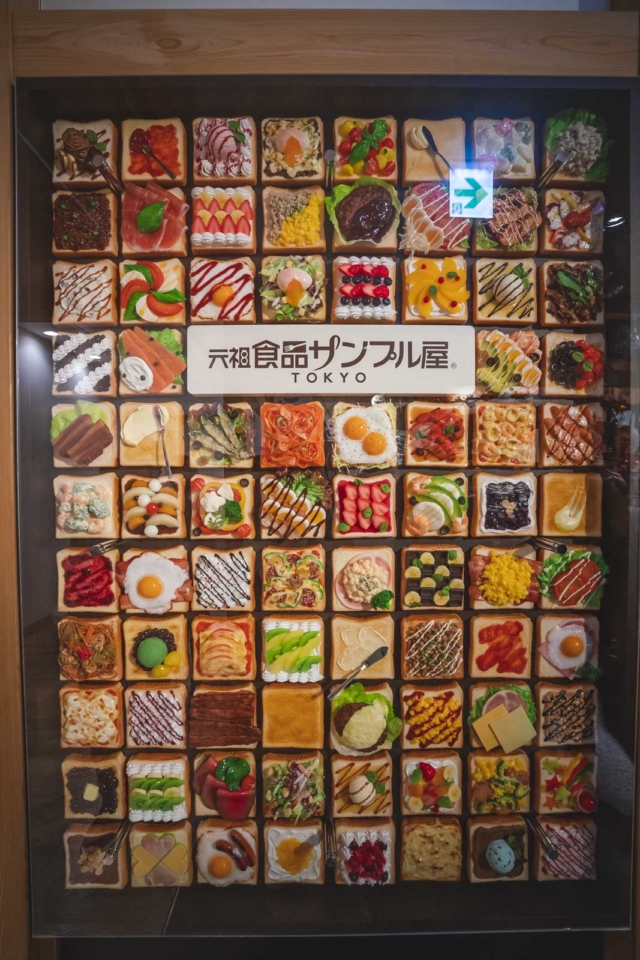
When visiting Japan, we found that dining out was not just about filling our bellies, it was an experience. Our meals could last for hours spanning 16 courses of delicious cuisine. The Japanese take eating seriously. Dining out almost feels like a ceremony where you are brought incredible displays of food that are meticulously arranged. When traveling to Japan, ordering food can be a bit intimidating so we are here to help you know what foods to keep an eye out for so you can try them in their most authentic forms.
Keep reading, and we’ll tell you all about 20 Japanese dishes that you should try at home or abroad.
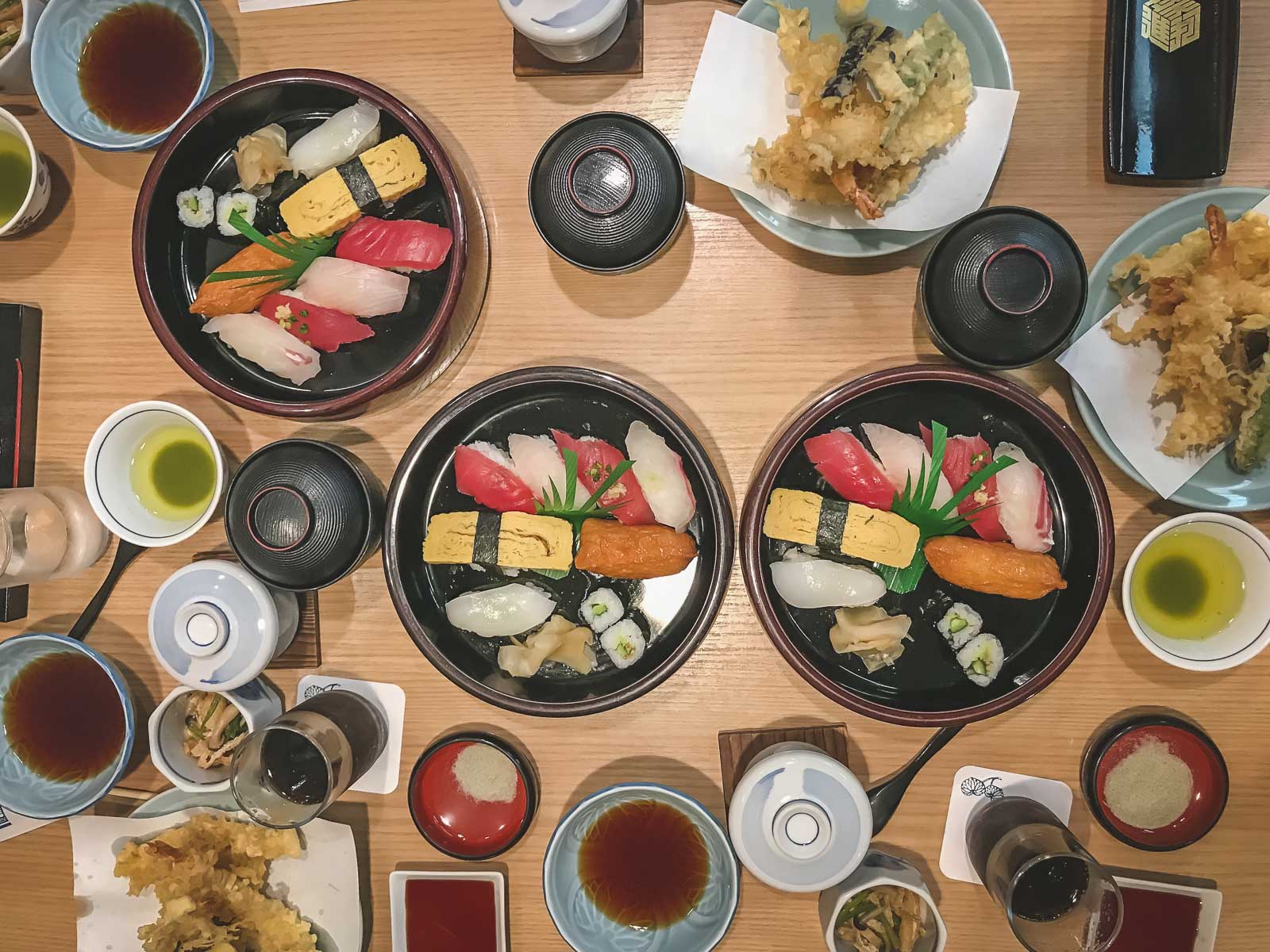
Sushi is now one of the most iconic Japanese dishes, but it actually originated in China in the 1st or second century BC and was known as narezushi. Contrary to popular belief, Sushi does not mean raw fish, it actually means sour rice. Sushi refers to any dish made with sushi rice (sour rice) accompanied with egg, vegetables, or fish.
There are a few common types of sushi that you’ve probably had if you’ve ever gone to a Japanese restaurant. These types include fillings inside rice wrapped in nori, bite-size lumps of rice with a single piece of raw fish on top, and sushi rice inside a pocket of fried tofu. When eating sushi, you’ll be surprised to find out that it is not the fish that is the most important ingredient, it is actually the sushi rice that makes the meal.
We find making Sushi at home really easy. Get yourself a bamboo mat, seaweed sheets, and sushi rice – all readily available at the grocery store and then fill it with anything from cucumber to avocado and salmon to tuna. Here are some great recipes to follow when making sushi at home.
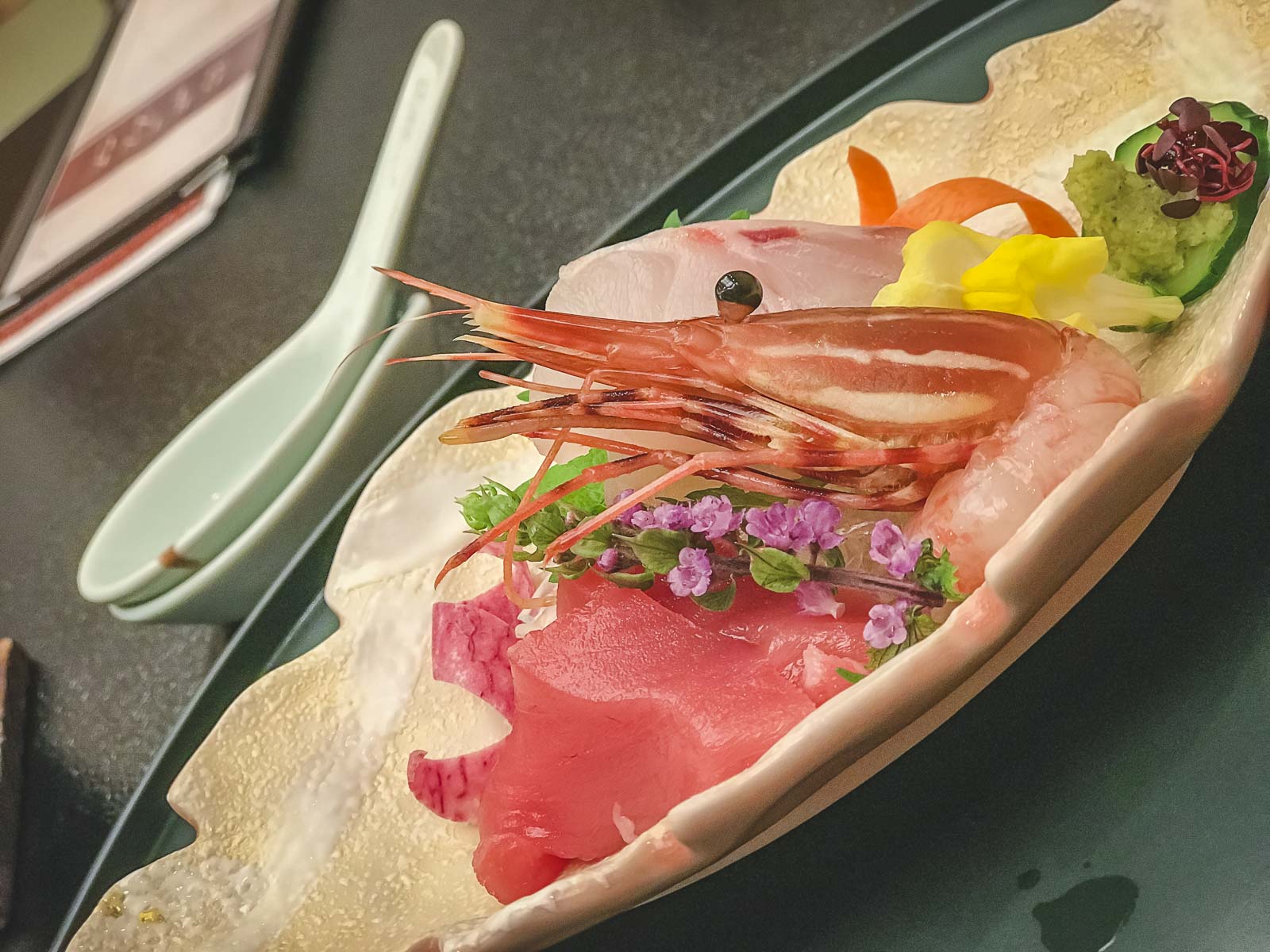
Sashimi is also a common menu item at American sushi restaurants. Sashimi is delicately sliced, fresh, raw fish served with pickled ginger, radish, wasabi, and soy sauce. Although some sushi contains raw fish, sashimi is different from sushi because it is not served with rice. Sashimi is actually the raw fish dish many think of as sushi.
3. Gyoza (Fried Dumplings)
If you’re looking for a taste of Japanese cuisine at home, look no further than Gyoza! These fried dumplings are easy to prepare at home and make a great appetizer. They can also serve as a main course alongside fried rice or noodles. Gyoza are dumplings (usually filled with pork and vegetables), fried in a pan until crisp and then steamed to finish cooking. Serve them with soy sauce for dipping! You can make your own Gyoza at home with this recipe.
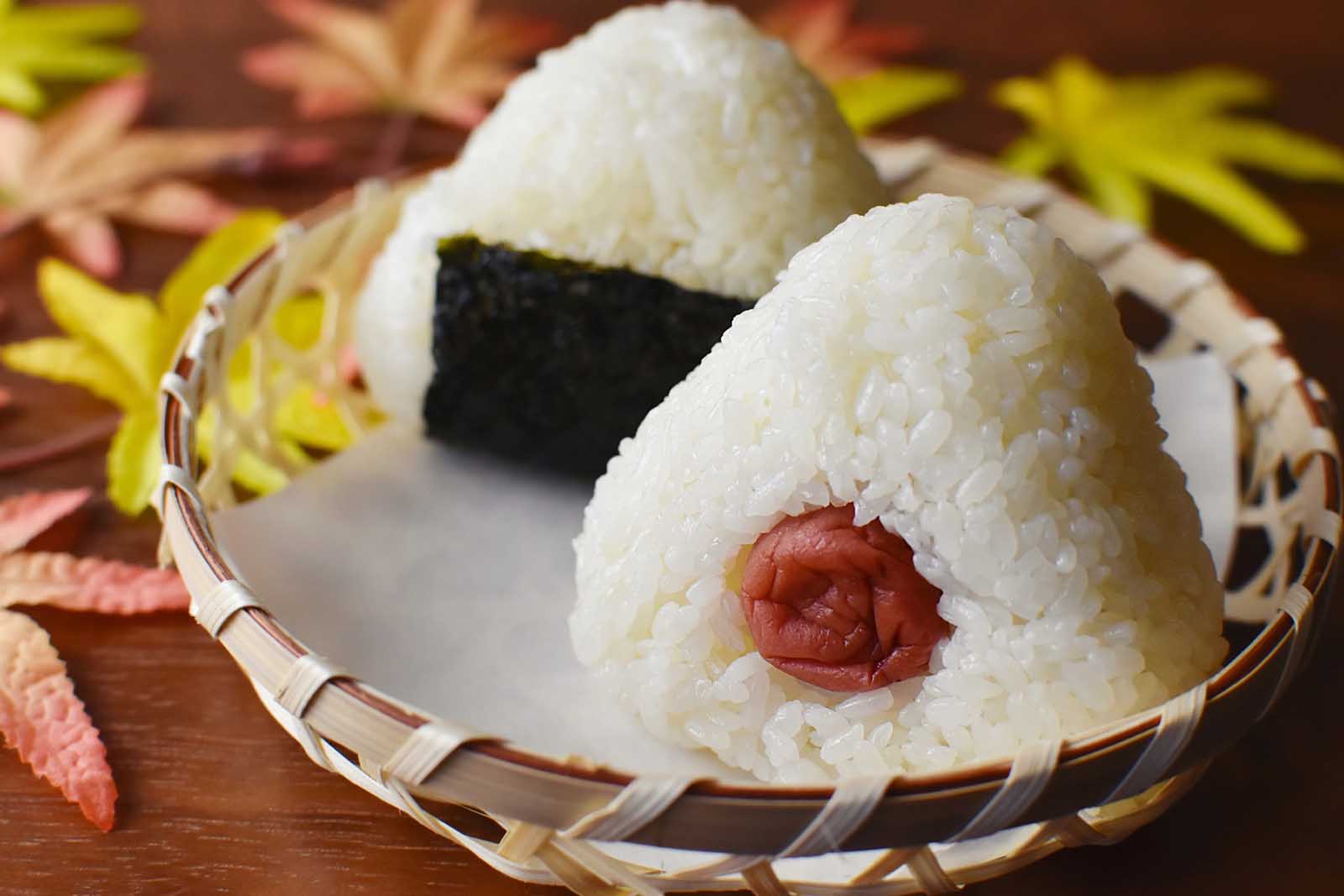
Onigiri is portable Japanese snack food. Onigiri is made of rice with a filling inside, shaped into a triangular shape, and placed in a piece of nori for convenient carrying. Common onigiri fillings include teriyaki chicken, seaweed, and tuna mayonnaise. In Japan, onigiri is usually sold in convenience stores as a cheap and tasty snack; but, it is one of the easiest Japanese foods to make at home! We seriously picked up Onigiri in a 7-Eleven!
5. Natto Rice Bowl
In Japan, the same kinds of foods are often eaten for breakfast, lunch, and dinner. The main difference between breakfast and other meals is light preparation and smaller portions. One of the most common breakfasts in Japan is the natto rice bowl. Natto is made of fermented soybeans, and it has a savory and salty flavor that tastes great over rice.
6. Fluffy Japanese Pancakes
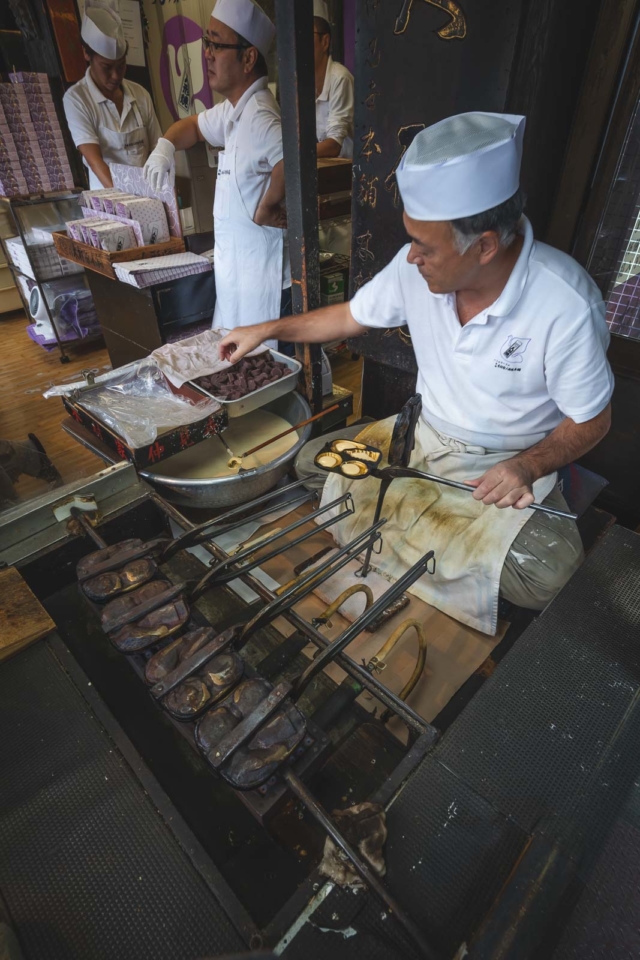
If soybeans aren’t your style and you’re looking for a traditional breakfast fix, you can whip up these ultra-fluffy Japanese pancakes at home. You can make fluffy Japanese pancakes at home by using a hand mixer to beat your egg whites until they’re stiff. The result will be a stack of the tallest, most jiggly pancakes you’ve ever had! Serve them with butter and syrup or honey.
7. Yakitori (Chicken Skewers)
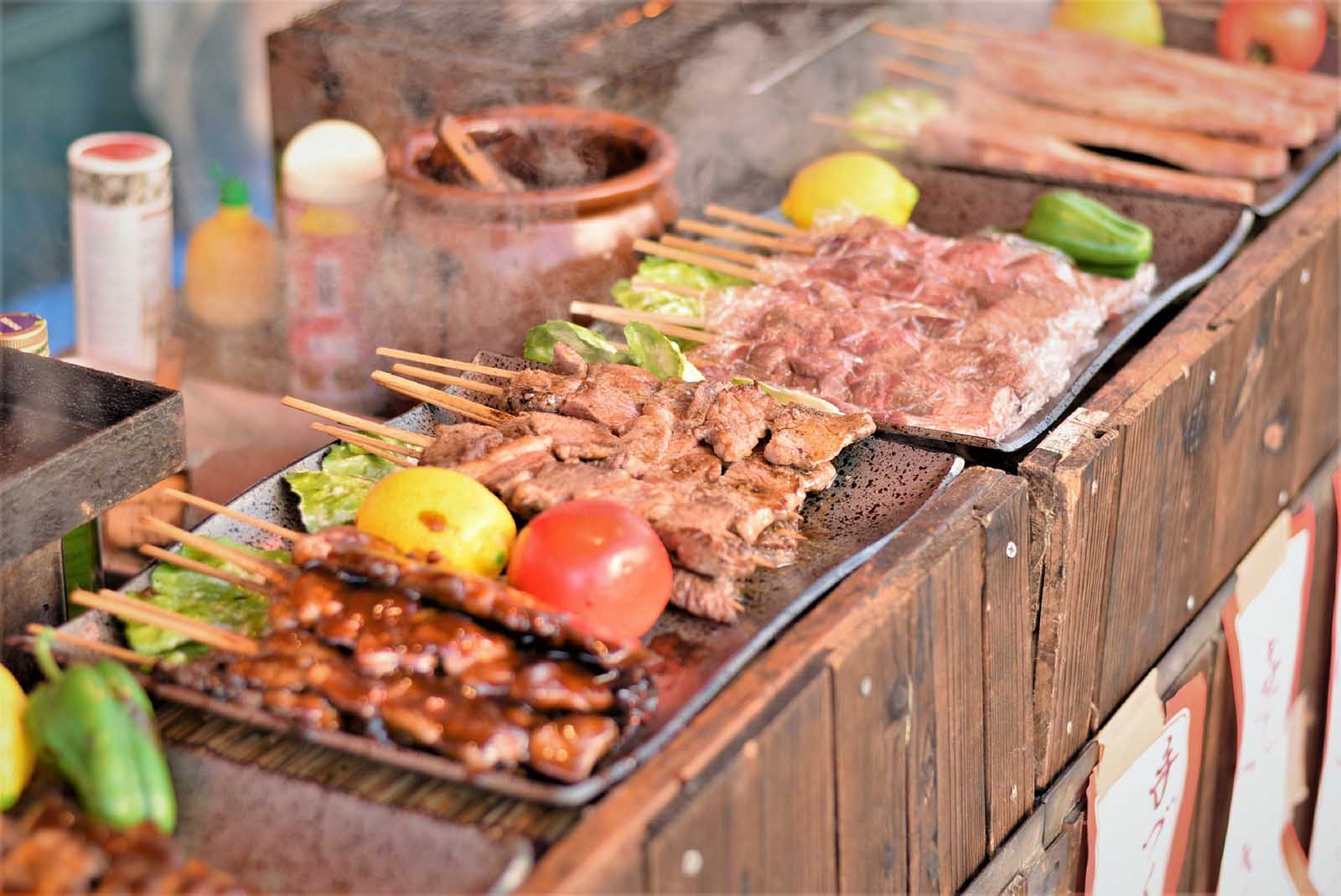
Yakitori means “barbecue chicken” in Japanese. Yakitori is a popular street food that you can find on any corner in Japanese cities. Before they’re grilled, these chicken skewers are brushed with a sauce made of mirin, sake, soy sauce, and sugar. You can pick one up as a quick snack or serve them with rice and vegetables as your main course.
8. Miso Soup
The Japanese eat miso soup alongside almost every meal. Miso broth is made from fermented soybeans and dashi broth. Miso soup often contains tofu, seaweed, and green onions. It’s common for Japanese people to heat up miso soup from the night before and eat it alongside their breakfast. Give that a try next time you’re craving a warm start to your day! We use this Miso soup Recipe all the time.
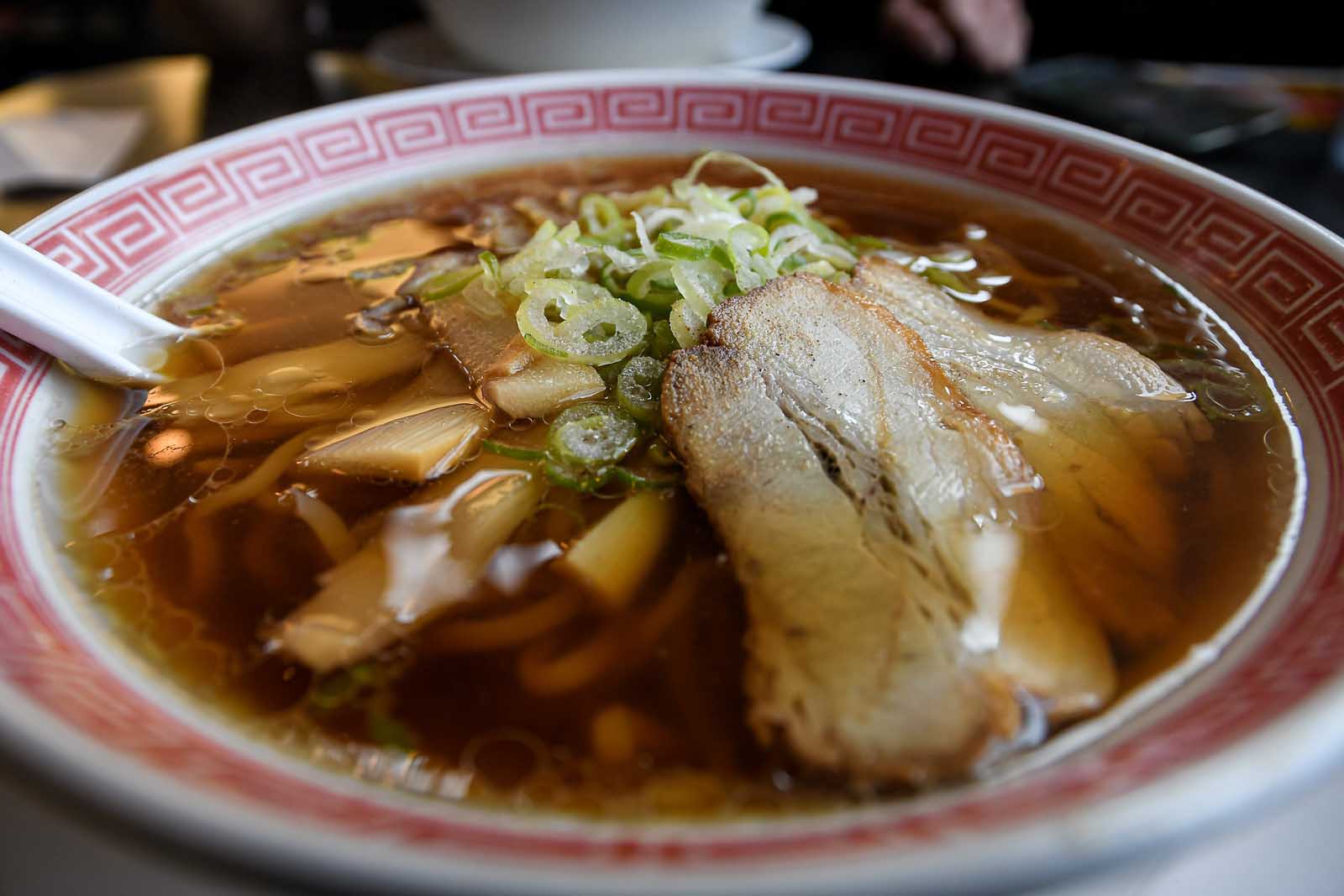
Ramen is one of the most well-known Japanese recipes. On a cold winter day, nothing is more comforting than a bowl of warm broth, thick noodles, and vegetables. If you’re a fan of instant ramen, you can always update your next bowl with soy sauce, chili paste, green onions, a soft-boiled egg, and any other toppings you want. If you are looking for a good Ramen recipe this one is delicious!
10. Kashipan (Sweet Bread)
Bakeries are everywhere in Japan, and Kashipan is one of their most popular snacks. Kashipan is a sweet bun, sometimes baked with cookie dough on top or sweet bean paste inside.
Enjoy Japanese Food Safely with Celiac Cards
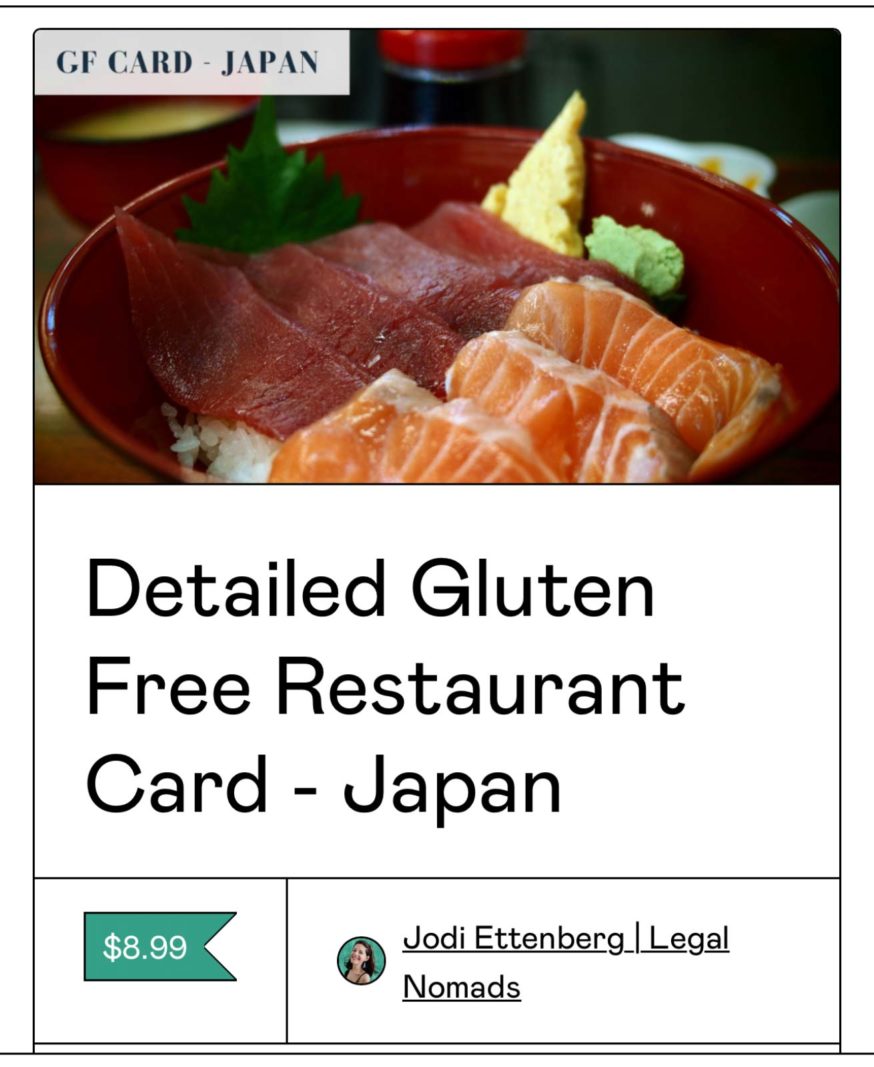
Are you Celiac or have a gluten intolerance? Our friend Jodi at Legal Nomads has created detailed gluten-free cards that have been translated into Japanese by native speakers. These cards were created to help people with celiac disease travel in Japan safely. Carry them with you and show them to restaurants and staff to ensure they understand your food requirements. Get more details and Purchase your gluten free Japan card here for just $8.99
11. Yakisoba (Stir-Fried Noodles)
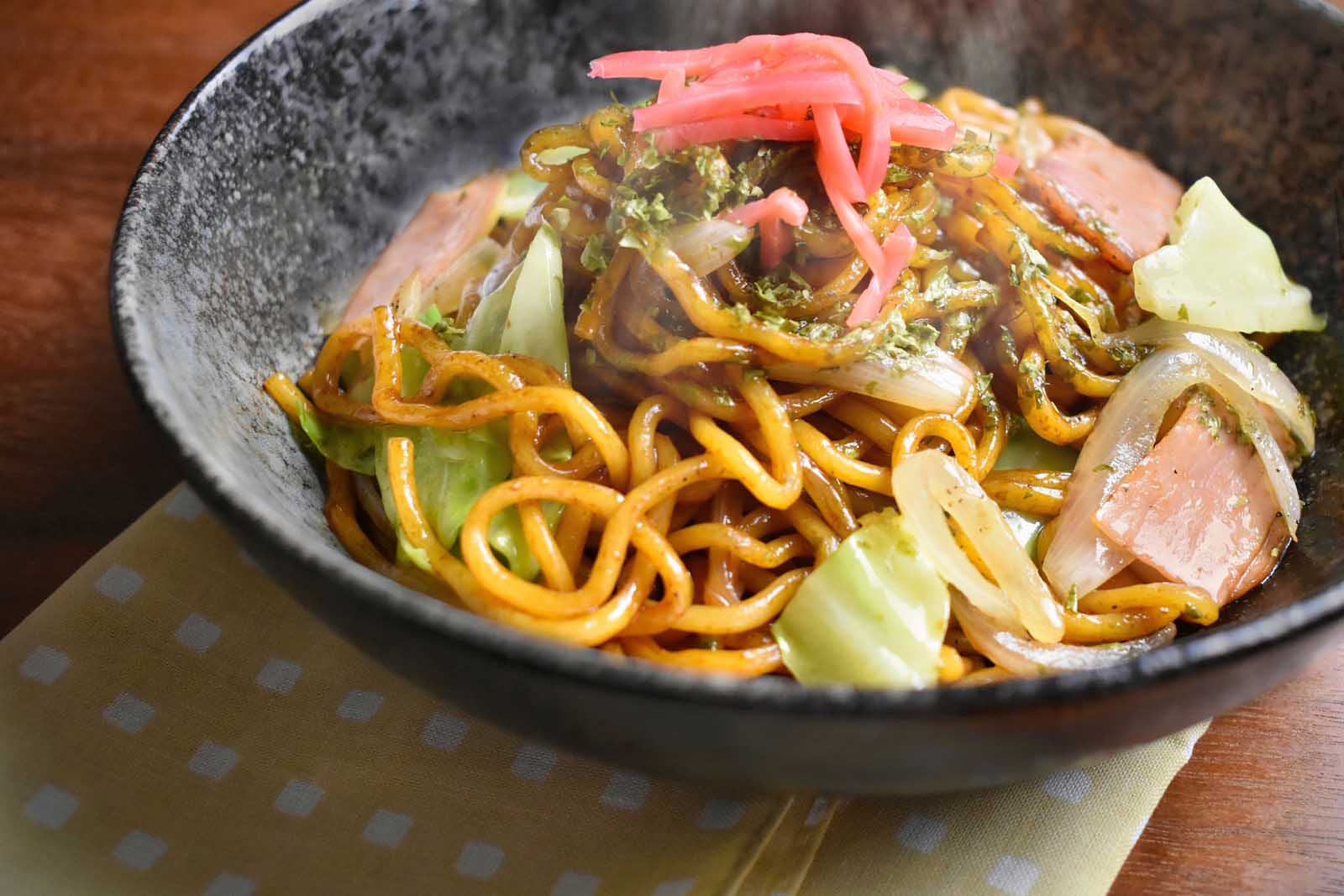
You can find yakisoba at any street festival in Japan. This fried noodle dish is made with barbecued noodles, pork, cabbage, and other vegetables. You can make your own version of yakisoba at home in a large frying pan or wok. This dish is full of rich flavor and is easy to make; just throw everything in one pan and let it sizzle!
12. Japanese Curry
Japanese curry is quite different from the Indian curries that you might be familiar with. Japanese curry has a sweet flavor and is prepared like a stew; meat and vegetables are cooked together with a curry paste that acts as a thickening agent.
Japanese curry is quite easy to make at home, especially if you can get your hands on some premade curry paste.
13. Nikujaga (Meat and Potatoes)
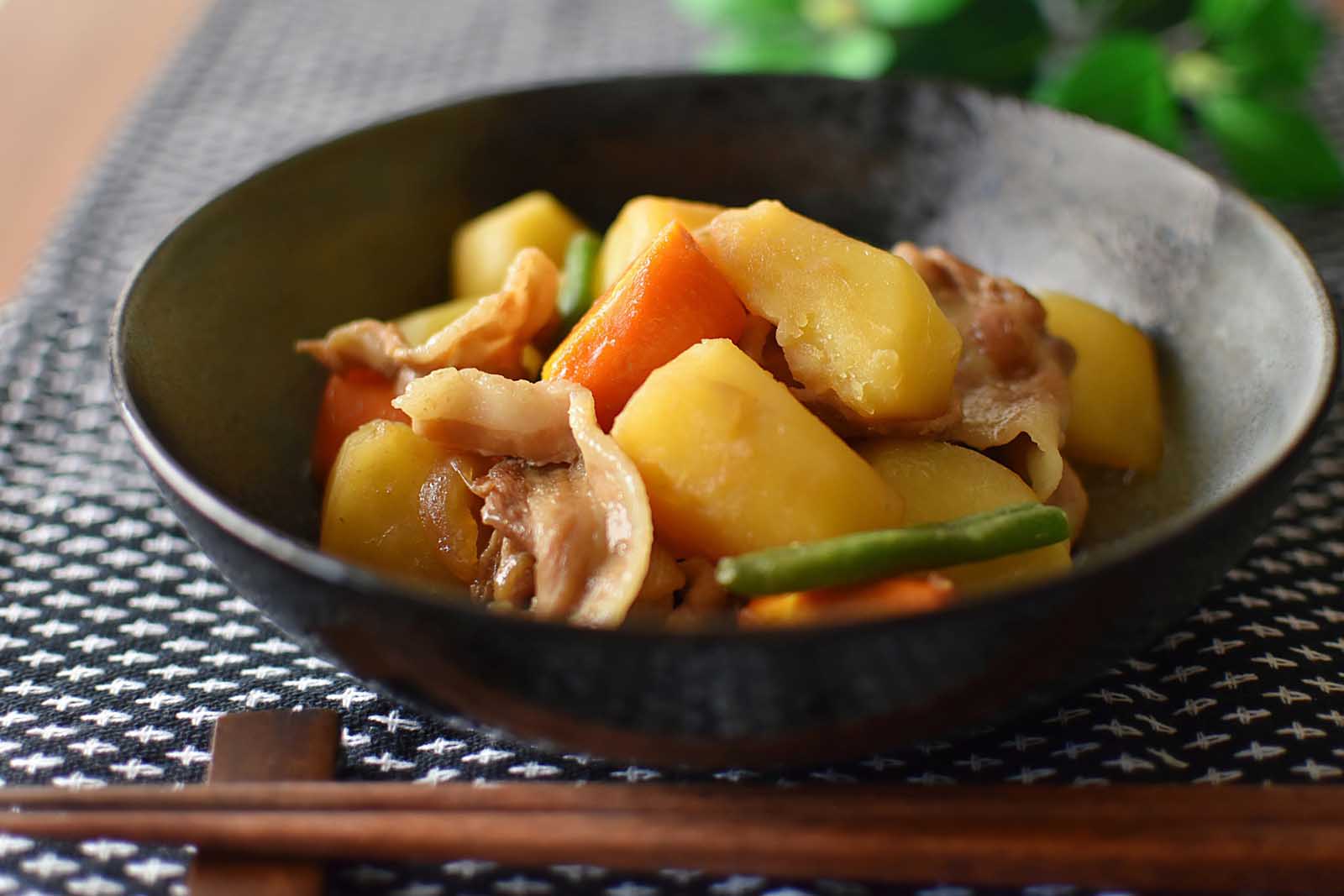
Roasted meat and potatoes are the backbones of many types of western cuisine. However, did you know that the Japanese have their own version of this dish?
Nikujaga is a meat and potato stew made with soy sauce, mirin, sake, and sugar. Nikujaga is a common household meal, and the best way to try it in Japan is to score an invite to a local’s home for dinner.
14. Takoyaki (Fried Octopus)
You don’t have to speak Japanese fluently to order Japanese food; but, when you ask for takoyaki, make sure you know you’re getting octopus.
Even though octopus isn’t a common snack in the U.S., don’t be afraid to try this delicious street food. The perfect way to try new food is smothered in batter, fried, and topped with seaweed and mayo.
15. Sukiyaki Hot Pot
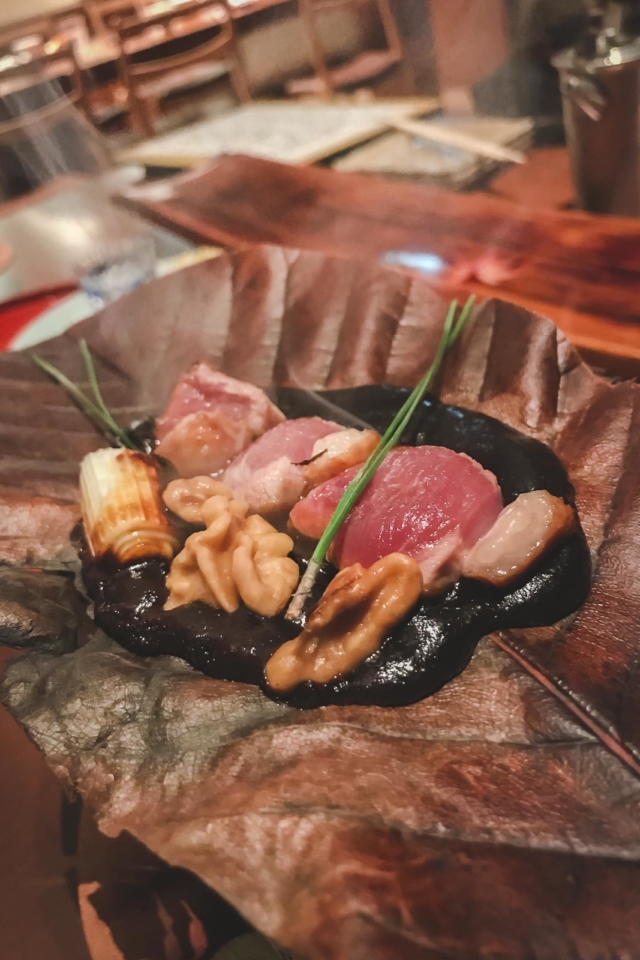
Hot pot is the ultimate comfort food for a cold day. Sukiyaki uses a broth made of mirin, sake, soy sauce, and sugar. Pour this rich broth over seared beef and vegetables.
Sukiyaki means, “cook what you like.” You can make your own version of a Japanese hot pot at home with whatever vegetables and proteins you want!
16. Tonkatsu (Pork Cutlets)
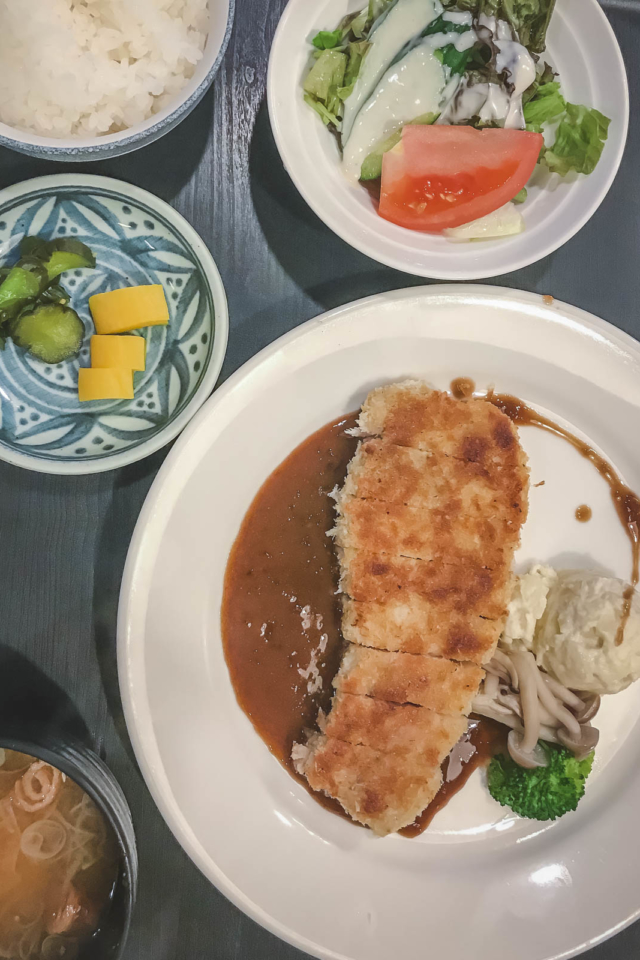
Europeans have introduced the Japanese to a number of western foods. Over time, Japanese cooks have made these dishes entirely their own, giving birth to new staple foods.
Tonkatsu pork cutlets are an example of this. These crispy-fried tenders look a lot like chicken strips; only they’re made with juicy, flavorful pork and served with crisp cabbage.
Fun fact: the Japanese word for European-introduced foods, such as tonkatsu, is “yoshoku.”
17. Tempura
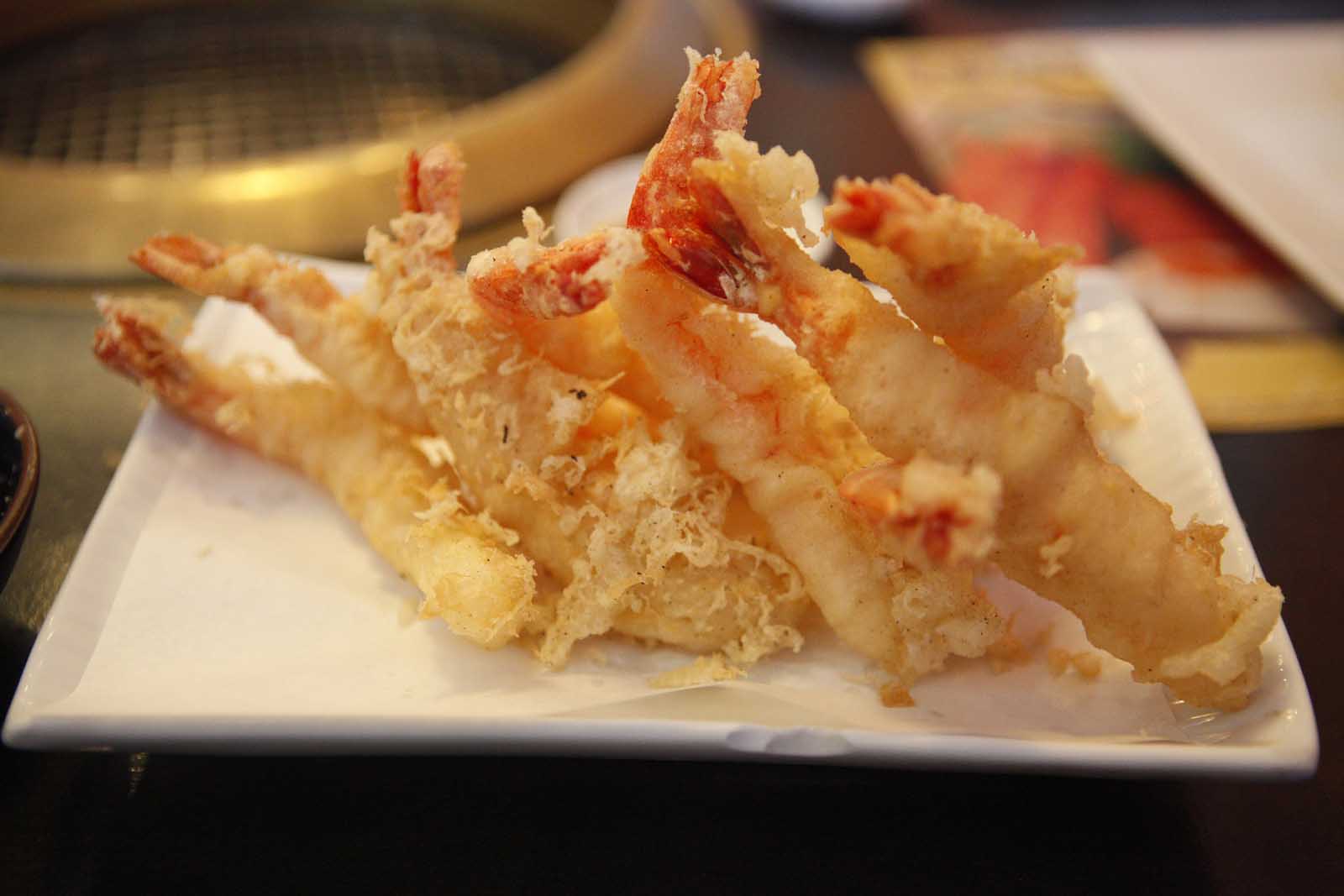
Speaking of fried snacks, everyone should try tempura at least once in their lives. You can find all kinds of tempura on the menu at most Japanese restaurants; shrimp, chicken, vegetables, tofu, and more.
You can also make tempura batter relatively easily at home! Always serve tempura-fried foods with soy sauce for a crisp, balanced flavor.
18. Udon Noodle Soup
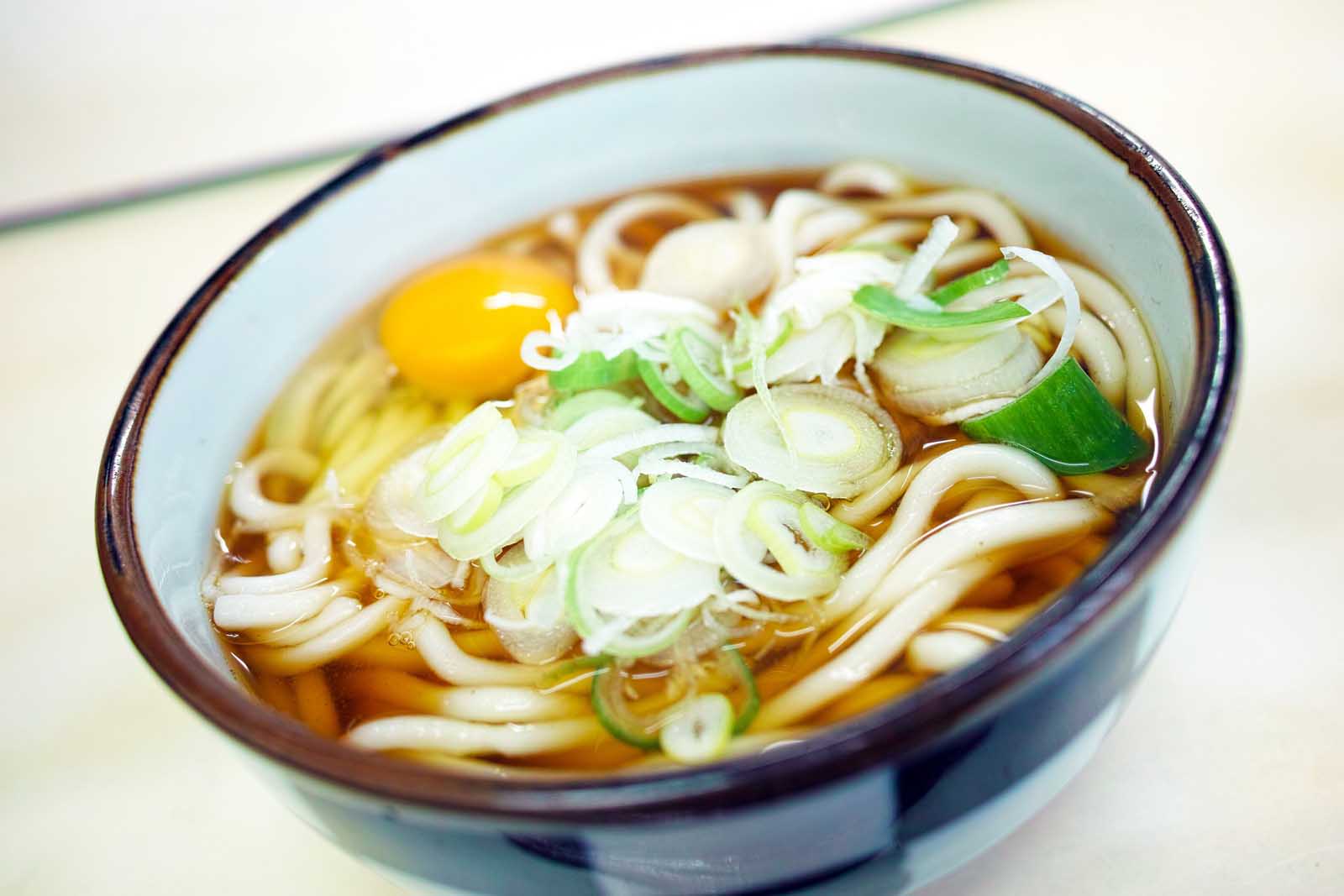
Udon noodles are a Japanese staple. These noodles are made from wheat flour and have a slightly chewy texture (perfect for slurping up from chopsticks).
The most common way to eat udon noodles is in udon noodle soup. You can top your soup with fried tofu, tempura-fried veggies, or anything else your heart desires.
19. Soba (Buckwheat Noodles)
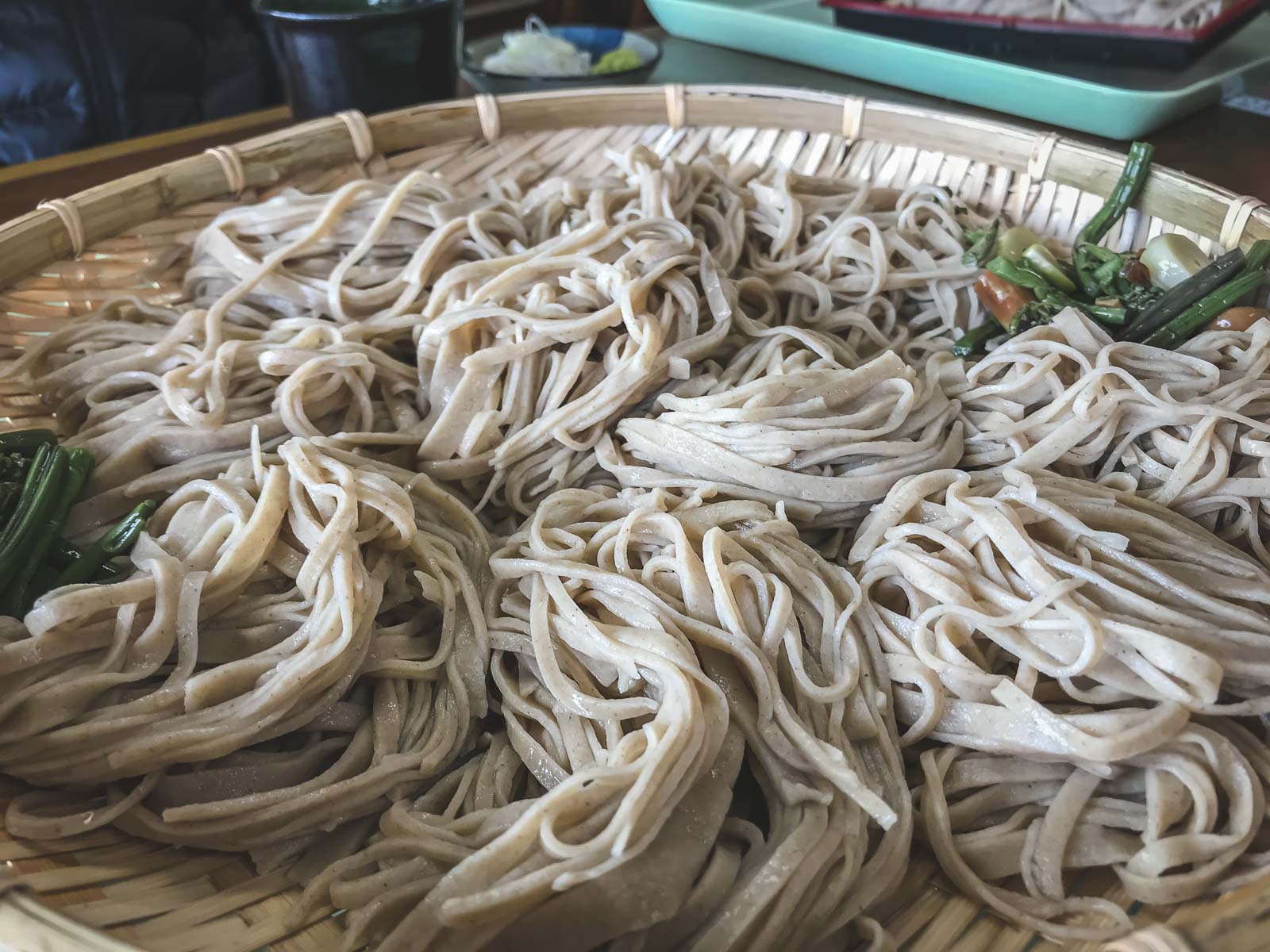
Another staple noodle in Japan is the soba noodle. Soba noodles are always made with buckwheat flour, which gives them a unique, subtly nutty flavor.
Soba noodles pair well with strong flavors like garlic, sesame oil, or chili.
20. Okonomiyaki (Savory Pancake)
Have you ever been to a dim sum restaurant and had a scallion pancake? Okonomiyaki is the Japanese version of the savory pancake. Okonomiyaki is made with cabbage, batter, and any other ingredients you wish.
In Japan, it is easy to find restaurants that specialize in okonomiyaki. You can also make this pan-fried dish easily in your own kitchen!
Try Traditional Japanese Food at Home or Abroad
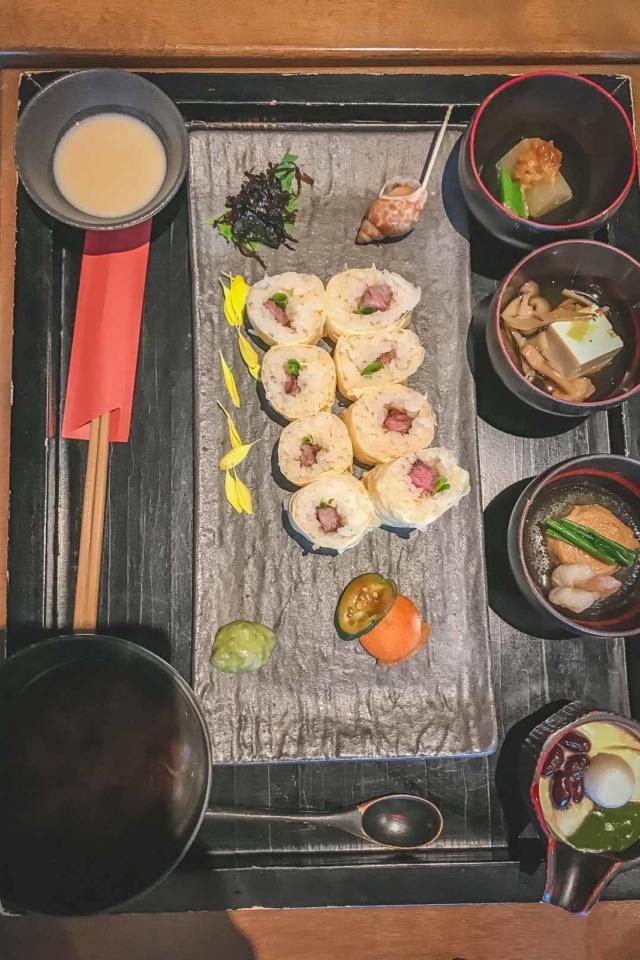
Learning how to cook traditional Japanese food at home is easier than you might think! Give one of these dishes a try next time you’re out of dinner ideas.
Check out our Japan Travel Guide if you’re interested in trying these dishes (and much more) in Japan! Traveling across the world is a breeze with our expert tips and travel guides.
Plan your Trip to Japan with these Resources
- 50 Awesome Things to do in Tokyo, Japan
- 9 Amazing Day Trips from Tokyo, Japan
- Mind-Blowing Facts about Japan
- Japanese Ryokan – Our Stay in a Traditional Inn
- 7 Unique Japanese New Year Traditions
- Places to Visit in Kyoto – My Favorite City in Japan
- Complete Nikko Japan Travel Guide – 18 Things to do and Places to See
- 22 Best Things To Do In Osaka, Japan
The 20 Best Things to Do in Kyoto, Japan
Travel Planning Resources
Looking to book your next trip? Why not use these resources that are tried and tested by yours truly.
Flights: Start planning your trip by finding the best flight deals on Skyscanner
Book your Hotel: Find the best prices on hotels with these two providers. If you are located in Europe use Booking.com and if you are anywhere else use TripAdvisor
Find Apartment Rentals: You will find the cheapest prices on apartment rentals with VRBO .
Travel Insurance: Don't leave home without it. Here is what we recommend:
- Allianz - Occasional Travelers.
- Medjet - Global air medical transport and travel security.
Need more help planning your trip? Make sure to check out our Resources Page where we highlight all the great companies that we trust when we are traveling.
You May Also Like
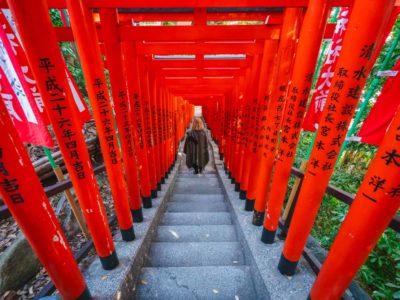
Is Japan Expensive To Visit? Money Saving Tips For Your Next Trip
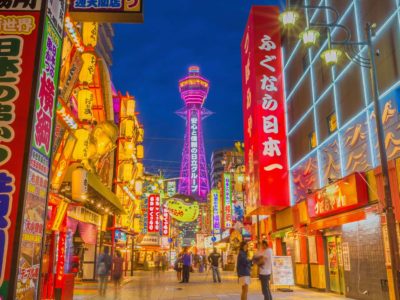
22 Best Things To Do In Osaka, Japan in 2024
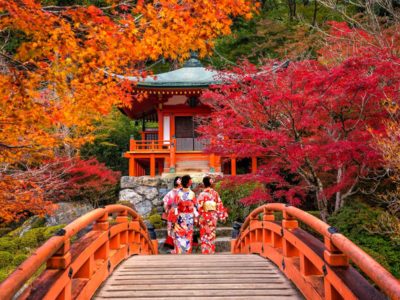
About ThePlanetD Team
Guest writers for The Planet D offer insider tips and information on destinations that they are experts in. We can't be everywhere at once, and it is important to have the highest level of travel information from local writers and experienced travelers.
Join thousands of others who get our monthly updates!
Leave a comment cancel reply.
Save my name, email, and website in this browser for the next time I comment.
2 thoughts on “Traditional Japanese Food: 20 Dishes You Can Try in Japan or At Home”
Thanks for sharing this worth reading blog. No doubt Sushi is one of the most popular Japanese cuisines. Although, there many wonderful recipes that you can find in various Japanese restaurants and also can make in your home.
I had taste of sushi in one of the Japanese restaurants in cantonment and it was really great. I really personally recommend it to others as well to try it.
Boutique Japan
Japanese Food: Culinary Travel in Japan
If you’re planning a trip to Japan, chances are that Japanese food is one of the things you’re most excited about (whether or not you refer to yourself as a “foodie”).
Japan is a wonderful destination for so many reasons , including its history, tradition, culture, and arts. But for most of our travelers, Japanese cuisine alone is reason enough to visit.
In the years since our team started Boutique Japan, we’ve watched Japan go from being slightly under the radar — hard to believe now! — to becoming one of the world’s top culinary meccas, as food-loving travelers worldwide have discovered that Japanese cuisine is much more than sushi and ramen (so much so that even foodie honeymoons to Japan have become popular).
If you’ve never visited, chances are you’ve only begun to scratch the surface when it comes to the astounding diversity of foods available in Japan. So to help you enjoy a delightful range of Japanese culinary experiences, both “high” and “low,” we’ve compiled the following:
- Japanese Culinary Experiences : A sampling of some of our favorite types of culinary experiences in Japan.
- What to Eat in Japan : A handy list of Japanese foods to eat during your trip to Japan (and a few “infamous” dishes many visitors find challenging).
- The Best Websites on Japanese Food and Drink : A short list of the best websites dedicated to Japanese cuisine, including sites devoted to everything from street food and Michelin-starred restaurants, to Japanese whisky and coffee.
Originally written in 2014, this page was updated and republished in August 2021.
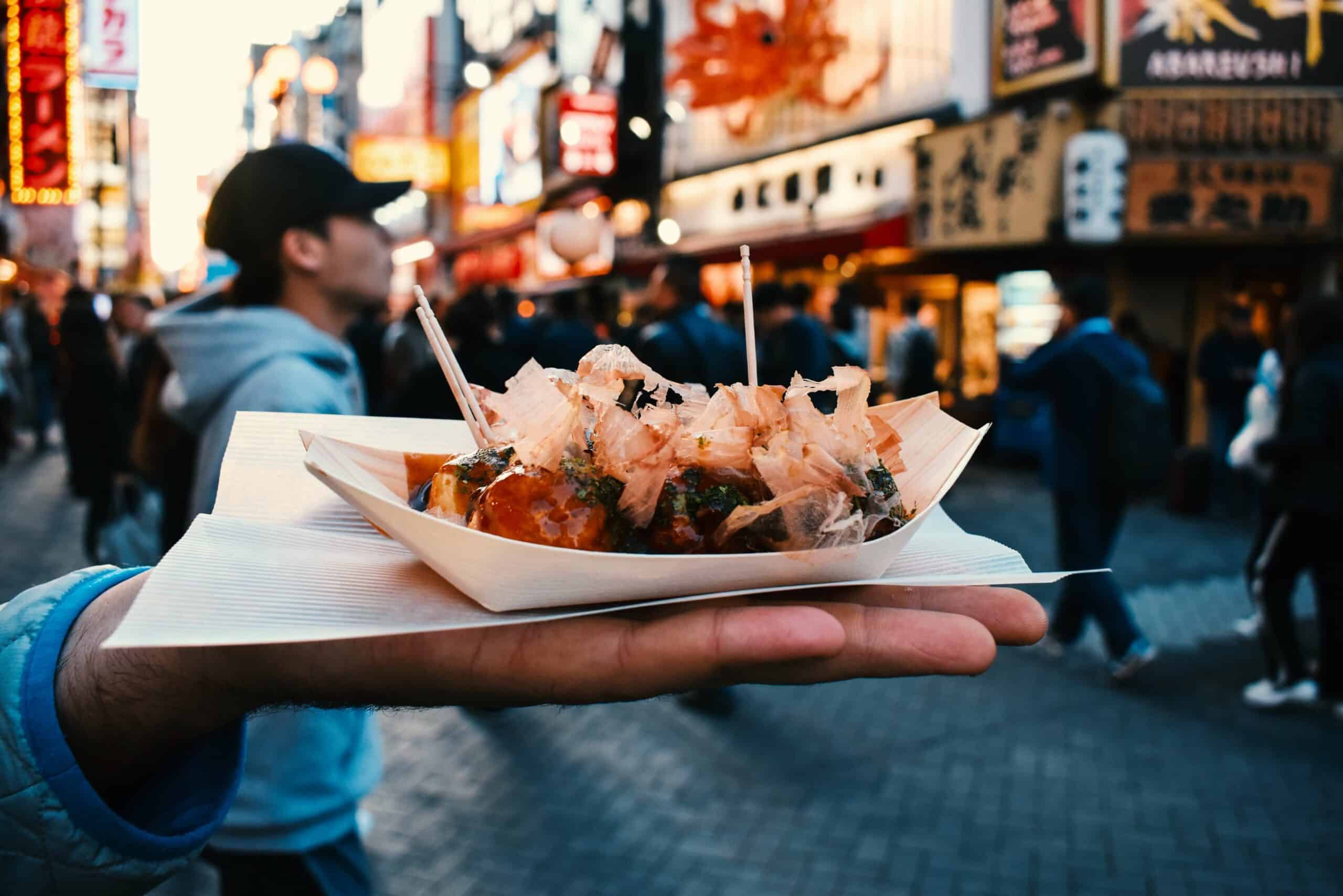
Japanese Culinary Experiences
Below are some of our favorite types of culinary experiences in Japan, though they represent just a sampling of what you’ll discover as you travel around the country!
Private Market Tours in Japan
Visiting a Japanese market with a local expert is one of the best way to immerse yourself in Japan’s culinary culture. Whether you want to visit a famous market, or even a neighborhood grocery store, a private food tour is a great way to get beneath the surface – and of course your guide will have expert insights on where to eat afterwards!
Perhaps Japan’s best-known market is Tokyo’s Tsukiji Market , a must-visit if you are eager to learn about Japanese food. In Kyoto, the best place to immerse yourself in Kyo-ryori (Kyoto cuisine), is at Nishiki Market, a long and narrow shopping arcade packed full of vendors selling a beautiful array of Kyoto’s culinary specialties .
Another unique culinary experience we highly recommend is a visit to a department store food hall, known as depachika . Japan’s department stores are a foodie paradise, offering a mouthwatering selection of sweet and savory, Japanese and foreign, and more food than you could possibly hope to ever sample.
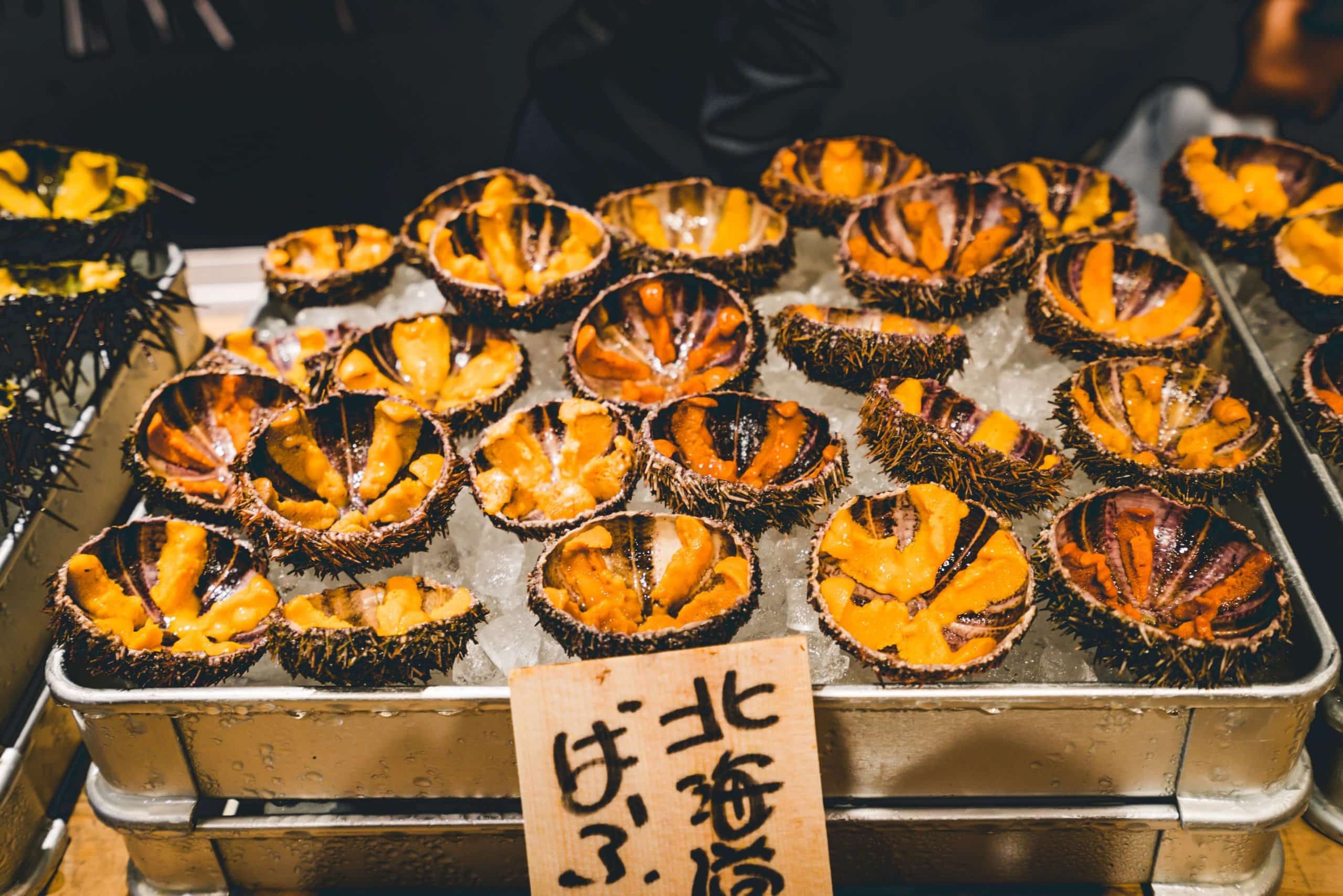
Sushi in Japan
For many travelers, eating sushi in Japan is at the top of the list. Modern-day sushi’s roots are in Tokyo, and for a quintessential sushi experience get counter seats for a special dinner at one of Tokyo’s best sushi-ya . You’ll also find top-quality sushi and sashimi in many other parts of Japan, including Kanazawa , Hokkaido, Fukuoka, and Toyama.
Even if your budget doesn’t allow for extravagance, you can find good sushi at neighborhood sushi shops, depachika food halls, and even kaiten-zushi (“conveyor belt”) restaurants.
Kaiseki Cuisine
Kaiseki is Japanese cuisine in what is often considered its most refined form. A kaiseki meal consists of course upon course of masterfully-prepared dishes featuring seasonal and local specialties.
A stay at a luxury ryokan usually includes a kaiseki dinner – often served in your room, or in a private dining room overlooking a small Japanese garden. Even if you’re not staying in a ryokan during your Japan trip , restaurants specializing in kaiseki cuisine abound, particularly in cities such as Kyoto and Tokyo.
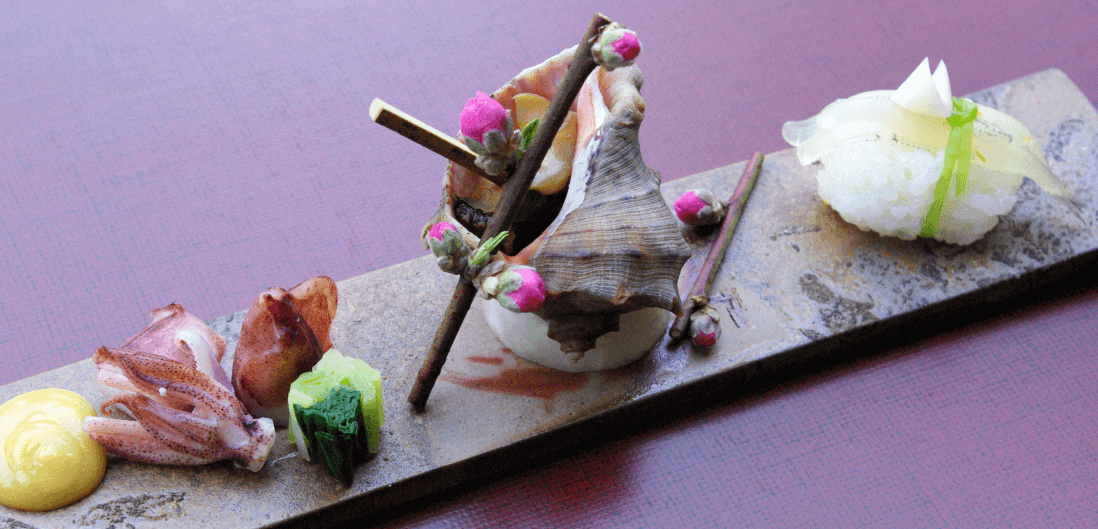
Izakaya , Tachinomiya , and Street Food in Japan
Japan is far from all haute cuisine, and some of your best meals will likely be some of the most casual. While you can experience these without a guide, a local expert can heighten the experience. Not only can your private guide take you to hard-to-find “hidden” establishments, they will also be able to interpret, as most lack English menus or English speakers.
Izakayas in Japan
One of the quintessential Japanese dining experiences, see our full article on the izakaya experience in Japan .

Tachinomi: Stand Bars
At izakaya, the focus is equally on eating and drinking. For an even more casual and drinks-focused experience, head to a tachinomiya . Tachinomiya ( tachi means stand, nomi means drink) are “stand bars,” where you can really rub shoulders with locals. These casual bars can be found throughout Japan, and are a great place to strike up a conversation with locals over reasonably-priced drinks and unpretentious Japanese bar food.
Street Food in Japan
In Japan, street food is generally not as prevalent as in other countries in the region. However, there are some cities — such as Osaka and Fukuoka — with thriving street food cultures. You’ll also always find great street food at Japanese matsuri (festivals) , when colorful food stalls line the streets.
Fine Dining and Michelin in Japan
The Michelin Guide is controversial in Japan. While many in Japan embrace it, some chefs and critics denounce it as a foreign standard being imposed on Japanese cuisine.
No matter your stance, one thing is certain: Japan is home to more Michelin-starred restaurants than any other country in the world — and when Japanese critics and Michelin inspectors agree on a restaurant, you can usually be assured of a remarkable culinary experience.

Dinner with a Geisha or Maiko
When done in an authentic, non-touristy manner, the chance to enjoy tea or dinner with a geisha or maiko (apprentice geisha) is a fascinating cultural experience. Kyoto , with its thriving geisha culture, can be a good place to do this, but it’s also possible in other cities such as Kanazawa, and even Tokyo.
Cooking Lessons in Japan
Taking a private Japanese cooking class is a great way to learn more about Japanese ingredients, while adding some recipes to your repertoire. You can learn highly authentic dishes, or a mix of authentic and slightly-adapted dishes to ensure you can re-create the recipes using ingredients available to you in your home country.
Sake Tasting and Breweries
Most people don’t realize how complex and delicious nihonshu (sake) really is. Going on a private tour with a local sake expert is the best way to learn about different varieties of sake, through tastings and explanations.
In many parts of Japan you can also visit a shuzo (sake brewery). During a brewery tour you’ll have the opportunity to see where and how sake is made, and the chance to ask all the questions you might have.
Other Countries’ Cuisines
Japan is home to some of the world’s best French, Italian, and Chinese restaurants (not to mention excellent Thai, Korean, and Indian restaurants). While most travelers understandably prefer to focus on Japanese food while in Japan, in larger Japanese cities it’s worth seeking out a top-notch non-Japanese meal.

What to Eat in Japan: Foods to Try
As you embark on the culinary experiences described above, you’ll have the chance to sample a huge variety of Japanese foods. Here is a list of foods we recommend trying during your trip Japan, along with a few some travelers choose to avoid!
(If you have special dietary needs, see our article on traveling to Japan with dietary requirements ).
- Bento : Few things are as pleasant as enjoying a gorgeous seasonal ekiben (bento box designed for train travel) while riding the shinkansen (bullet train ).
- Croissant : As those who already know are well aware, the quality of bread and pastries in Japan is simply amazing.
- Curry : While not spicy like the curries of many other countries, there’s nothing more comforting than a made-from-scratch Japanese curry.
- Fruit : Square watermelons aside, it’s seriously worth splurging on some high-end Japanese fruit, and one of the best places to do so is at a depachika .
- Gyoza : Dumpling heaven.
- Karaage : Japan’s mouthwatering take on fried chicken.
- Katsuobushi : Some travelers resist the ubiquitous bonito fish flakes, but those who love them do so with a passion. They’re served on top of a variety of foods, including tofu and takoyaki .
- Kushi-katsu : Deep-fried skewered meats and vegetables.
- Mabo-dofu : The Japanese take on Sichuan’s mapo tofu , this spicy tofu-focused dish is rich and addictive.
- Miso : Whether in miso shiru (miso soup) or on its own, authentic Japanese miso is leaps and bounds better than what most people find in their home countries.
- Nabe : Nabe literally means “pot,” and the food — a family-style hotpot featuring ingredients that can include vegetables, meat, and seafood — is one of our favorite things to eat in winter .
- Niku-man : Chinese-style meat buns often found at convenience stores , but better at depachika and shops specializing in buns and dumplings.
- Niku-jaga : A stew featuring beef and potatoes that is a national home-cooked favorite.
- Oden : Oden features a variety of ingredients (daikon, egg, fish cakes, and more) slow-cooked in a dashi-based broth. Specialty shops are usually best, but in winter oden also appears on izakaya menus and — like niku-man above — is even available at conbini .
- Okonomiyaki : An essential casual specialty of western Japan, okonomiyaki is one of the richer and heavier foods you’ll try in Japan. Read more about this famous dish in our full post on foods to eat in Osaka (it’s also particularly famous in Hiroshima ).
- Onigiri : One of the world’s most perfect snack foods, onigiri are triangle-shaped rice balls that can be prepared simply or filled with goodies (such as fish or umeboshi ).
- Ramen : One of the country’s most famous foods, see our full article on ramen in Japan .
- Rice : Rice is an obsession in Japan, and diners seek out famous varieties from Japan’s best rice regions (but even “average” rice in Japan is fantastic).
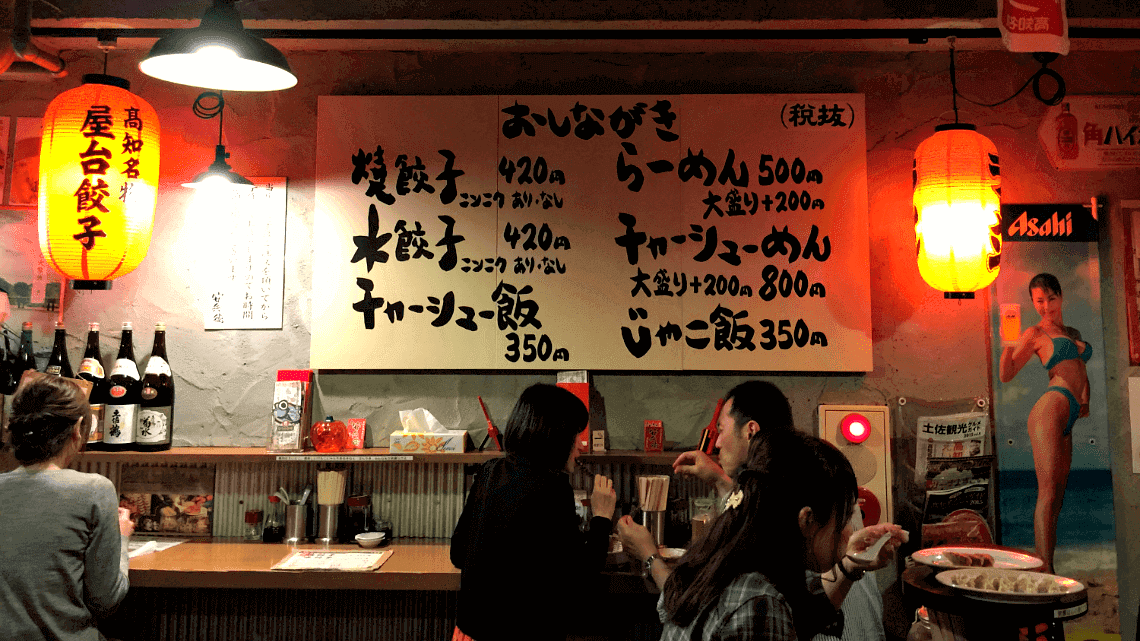
- Saba : Grilled mackerel, a simple classic you’ll find on the menus at most izakayas and neighborhood shokudo (cafeterias).
- Shabu Shabu : A famous variety of nabe (see above), meat is the star of shabu shabu (the name of the food refers to the sound of stirring the meat and vegetables in the hotpot).
- Shishamo : A drinking person’s favorite, these almost bite-sized grilled smelt fish are served whole and filled with roe. “Real” shishamo come from Hokkaido, but these days in most places they’re imported.
- Shojin Ryori : Traditional Buddhist cuisine, some of the best vegetarian food you’ll ever have, is one of the highlights of staying at a temple (in places such as Koyasan ), and can also be found in cities such as Kyoto.
- Soba : Made from buckwheat, and generally considered to be the healthiest of Japan’s three major noodles (along with ramen and udon), seek out te-uchi (handmade) soba.
- Sushi : For more on Japan’s most famous food, see the sushi section above under Japanese Culinary Experiences .
- Tamago Sando : One of Japan’s most iconic convenience store foods, the egg ( tamago ) sandwich is considered an essential for many food-loving travelers.
- Takoyaki : Sometimes called “octopus balls,” these bite-sized balls filled with octopus ( tako ) are a street food staple in Osaka, but also found throughout much of Japan.
- Tempura : The quality of this famous dish in Japan, particularly at high-end tempura restaurants, may blow your mind.
- Tofu : Fresh tofu in Japan is shockingly good, particularly compared to what most visitors are used to outside of Japan.
- Tonkatsu : Breaded and deep-fried pork cutlet, typically served with shredded cabbage, tsukemono , rice, and miso soup.
- Tsukemono : Japanese pickles, which pair perfectly with white rice, and are also delicious on their own. An integral part of Japanese cuisine, you’ll find tsukemono throughout the country, but Kyoto’s are perhaps the most revered.
- Umeboshi : Ume is often translated as “plum,” but most people consider apricot to be more accurate. Umeboshi — pickled ume — are incredibly sour, healthy, and to those of us who love them, irresistible.
- Wasabi : Freshly grated wasabi bears almost no resemblance to what you’ve likely tasted at sushi restaurants outside of Japan.
- Yakiniku : The Japanese take on Korean barbecue, featuring a variety of grilled beef.
- Yakitori : Legendary grilled skewers of chicken.
Hopefully this will get you started! There are far more to try as well, and the great news is that you can find almost all of these foods (and many others) in almost any Japanese city.

Japanese Foods To Avoid?
You’ll probably have more fun — not to mention memorable experiences! — if you keep an “open palate,” but just for reference here are some foods that many non-Japanese are often wary of, at least at first:
- Natto : Perhaps Japan’s most “infamous” food, natto is made from fermented soybeans and is notorious for its pungent smell and sticky texture.
- Chicken and horse sashimi : In a country as hygienic as Japan, both of these are considered safe (and, to many, delicious). However, despite their domestic popularity, many non-Japanese people seem to steer clear of them.
- Horumon : This offal-based cuisine is very popular in Japan, and is considered great “drinking” food. While it may be perfect for Anthony Bourdain- esque eaters, it’s not always a hit with less adventurous diners.
- Fugu : Fugu is poisonous pufferfish (sometimes called blowfish), and can be deadly. Even though it’s strictly controlled and generally considered safe “enough” at established fugu restaurants, a handful of people still die every year from consuming it.
- Shirako : Shirako (cod milt, i.e., sperm sacs) is a delicacy in Japan, and a favorite of sake enthusiasts and adventurous diners.
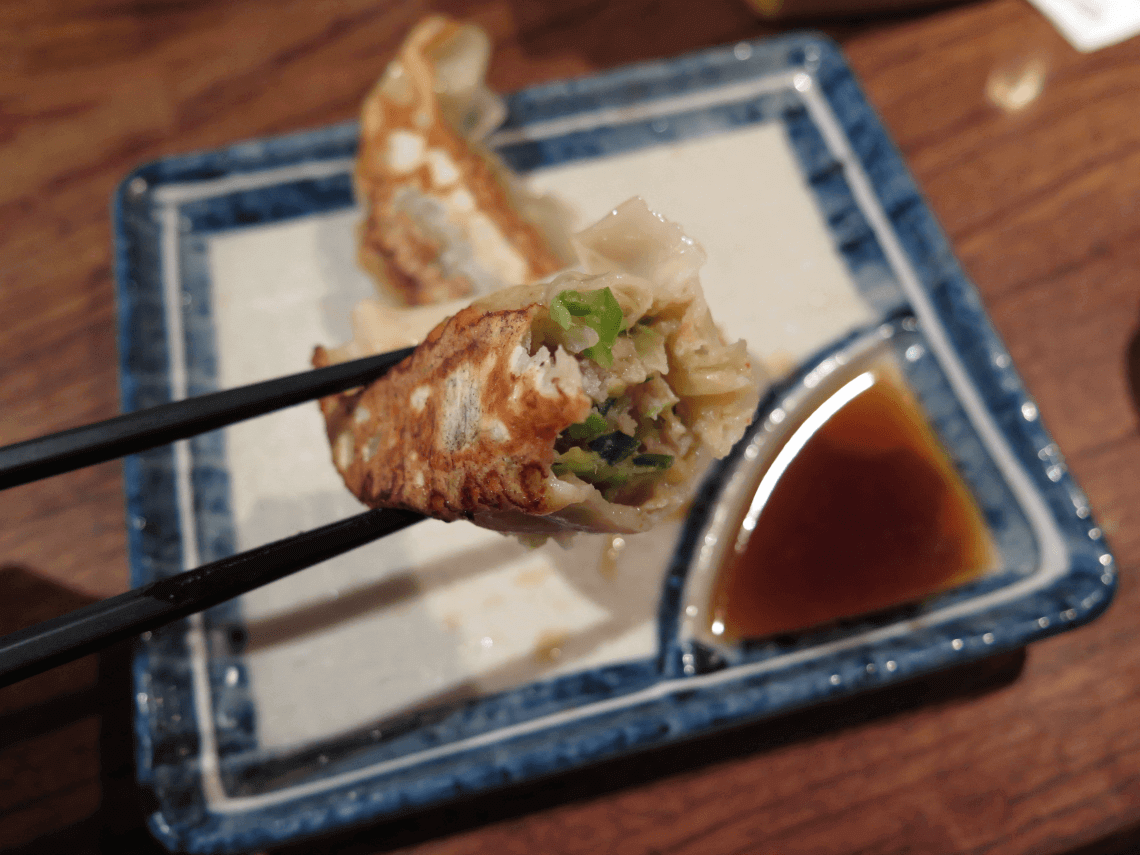
The Best Websites on Japanese Food and Drink
Finally, in case you want to go down the rabbit hole, we’ve compiled what we believe are the best Japanese food and drink websites and pages from around the internet.
Unless you’re a professional eater (we know some of you are), we strongly recommend against trying to plan all your meals in advance. We’re all for obsessive preparation in general (our trip-planning depends on it), but we’ve also seen countless ambitious diners craving a simple meal after one too many “special” reservations — and keep in mind that canceling is a major breach of dining etiquette .
As for casual meals, while you can certainly pre-plan some, many informal restaurants don’t take reservations. The good news is that (outside of hyper-touristy areas) it’s hard to find a bad meal in Japan, and the quality of food is extremely high across the board.
So if you’re set on making some reservations, our suggestion would be to use the resources below to plan them, while also letting yourself experience how wonderful Japan can be with a little flexibility.
Best Websites on Japanese Cuisine
- Tabelog Award : Want to know where Japanese people eat? Tabelog is Japan’s preeminent ranking and review site for restaurants, and an incredible resource. It’s safe to say any restaurant on their Gold, Silver, or Bronze list will be worthwhile. You can also use the site to deep dive for other restaurants. When searching, make sure to toggle the sort function to “ranking.” Also, keep in mind that Japanese people are “stricter” in reviews, so a 3.0 out of 5 is actually pretty good, a 3.5 is generally very good, and 4.0 usually means a place is stellar.
- The Hungry Tourist : Our friend The Hungry Tourist is serious about food. While his list of Japan’s best restaurants doesn’t contain much fluff, you can essentially bet that any place included on his list will be worth dining at.
- Michelin Guide Japan : As alluded to above (under Fine Dining and Michelin in Japan ), the Michelin Guide is not necessarily the be-all and end-all it’s sometimes made out to be, but it can still be a fantastic resource, and at the very least a good starting point for diners seeking top-quality dining experiences in Tokyo, Kyoto, Osaka, and beyond.
- TableAll : There are many reservation services that have popped up in recent years to help travelers make dining reservations in Japan, perhaps none better than TableAll. To complement its relatively reasonable and easy-to-use reservation service, the website also features excellent features on the chefs and restaurants it works with throughout Japan. TableAll is a fun place to go down the rabbit hole – and you may find yourself making an impulse reservation at one of Japan’s best restaurants! (Especially for travelers who don’t have access to the concierge at a luxury hotel or ryokan , services like TableAll and its competitor Pocket Concierge can really help.)
- Eater Japan : At times, Eater can feel like a content farm, but they do tend to work with good writers, and their listicles featuring 38 Essential Tokyo Restaurants and 38 Essential Osaka Restaurants are both full of great dining inspiration.
- Ramen Adventures : For ramen lovers, there is perhaps no better resource on ramen throughout Japan. Brian of Ramen Adventures is truly a hardcore ramen enthusiast, riding his motorcycle throughout Japan in search of obscure and amazing bowls. Another great ramen resource is Ramen Beast , which offers a free app (as well as an outstanding and fascinating ramen-obsessed newsletter via Substack ).
- Tokyo Food File : Robbie Swinnerton offers some of the most interesting, informative, and enjoyable English-language writing on Tokyo’s ever-evolving food scene. His articles in The Japan Times feature a wide range of restaurants, from casual izakayas to top-end fine-dining establishments.
- LuxEat : A beautiful website devoted to mostly high-end gastronomic explorations in Japan (and beyond).
- Food Sake Tokyo : Perennially one of our favorite writers on Japanese culinary culture, the insightful Yukari Sakamoto tends to update her Instagram more than her blog these days, but regardless both are a joy to peruse.
- Andrea Fazzari : The blog of James Beard Award-winning photographer Andrea Fazzari gives you a taste of what you can expect from her magnificent books on Japanese chefs and cuisine.
- Takefumi Hamada : The Instagram feed of this extraordinarily well-traveled diner is worth a trip down the rabbit hole for bountiful culinary inspiration in Japan and beyond.
- Roads & Kingdoms Guide to Tokyo : We’re always fans of Roads & Kingdoms work, and this mini-guide to Tokyo is a fun read. For more from the R&K team, make sure to check out Rice, Noodle, Fish (one of our absolute favorite books on Japanese cuisine ).
Along with the great resources above, also make sure to see our articles on Tokyo’s best sushi restaurants , foods to eat in Kyoto , foods to eat in Osaka , and foods to eat in Fukuoka .

Resources for Travelers to Japan with Special Dietary Needs
- Happy Cow : Vegan and vegetarian restaurants in Japan.
- Gluten Free Japan : Guide to eating gluten free in Japan.
- Traveling around Japan with Dietary Restrictions : A post from our site for travelers with dietary restrictions.
Best Websites for Bars and Drinking in Japan
- PUNCH : The PUNCH guide to drinking in Tokyo.
- Kanpai Culture : Melinda Joe’s excellent column in The Japan Times on drinking in Tokyo.
- Dekanta : Highly informative blog on Japanese whisky.
- Urban Sake : Comprehensive sake-focused website.
- Sake / Shochu / Whisky : Our introductions to these essential Japanese beverages.
Online Resources for Tea and Coffee in Japan
- Japanese Tea : An overview of tea in Japan.
- Tea in Kyoto : A selection of teahouses in Kyoto.
- Good Coffee : Lists of great coffee shops in Tokyo, Kyoto, Osaka, and beyond.
- Tokyo Coffee : Guide to specialty coffee in Tokyo.
- Coffee / Tea : Our introductions to coffee and tea in Japan.
We hope our comprehensive introduction to Japanese food helps you get the most out of your culinary travels through Japan!
Plan Your Japan Trip
Learn more and contact us to discuss your unique trip.
Get Started
- The Process
- Testimonials
Traveling Canucks
Canada Family Travel Blog
Beginner’s Guide to Food in Japan for tourists
01/23/2024 By Traveling Canucks 4 Comments Categories: Food Home Japan Kobe Kyoto Tokyo Travel Tips
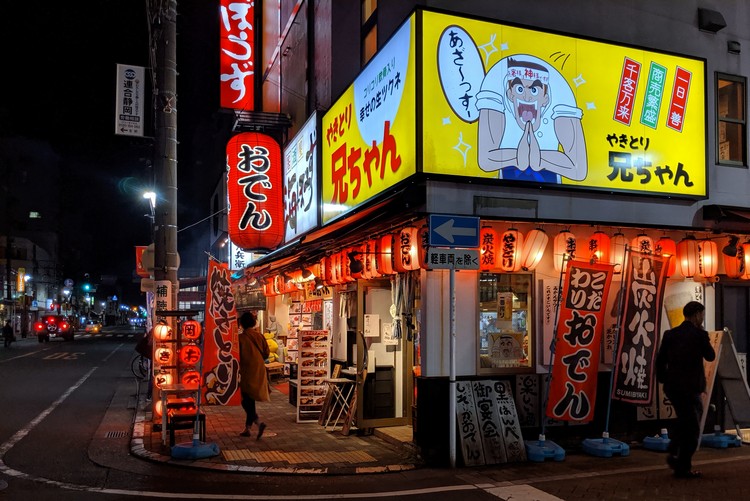
Beginners Guide to Food in Japan for first time visitors
Japan’s unique and diverse cuisine can be intimidating for first time visitors. Unadventurous eaters might experience a little anxiety when thinking about ordering Japanese food in Tokyo for the very first time. If you find yourself in this category, we’ve got you covered with this beginners guide to food in Japan.
We would argue that food is the reason to visit Japan.
However, for those unfamiliar with Japanese food culture, the idea of eating at restaurants in Japan might feel daunting. What do you order? How do you order? Do you tip in Japan? I remember feeling quite confused on our first trip to Japan; not being able to read Japanese characters didn’t help.
Thankfully, it didn’t take long before we started to feel comfortable.
We quickly turned our anxiety into curiousity. Sure, we sampled a few items that we will likely not order again (I’m talking to you, horumonyaki ), but we also discovered new foods and flavours that have forever changed our palate.
Most restaurants in high traffic areas will have food photos on the menu, plastic replicas in the windows, and/or English menus; so you’ll be fine even if you can’t read, speak or understand Japanese.
Skip ahead using the Table of Contents
Table of Contents
Readers note – we visited Japan prior to the Covid-19 pandemic. We recommend you do further research before your trip to Japan. Some of the Japan restaurants referenced in this blog post may have paused service, which might impact some recommendations.
Visit the Japan travel advisory for coronavirus updates here .
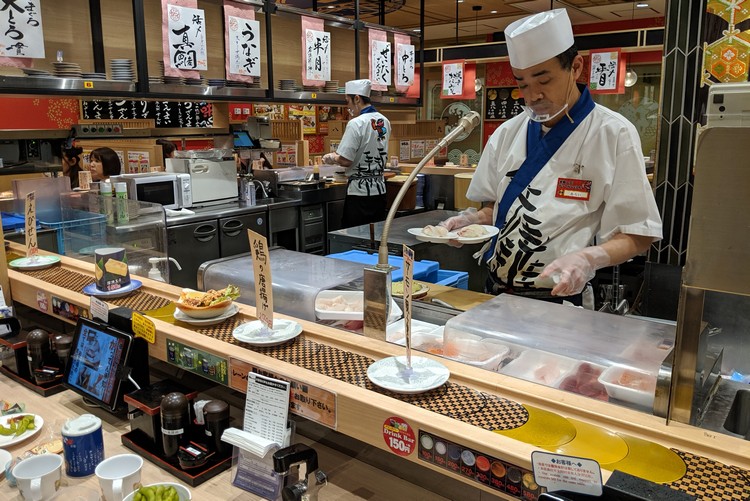
Read more posts from Japan
- 25 Japan travel tips for first timers
- 50 Photos of Kyoto that will inspire you to visit
- The perfect 3 day Tokyo itinerary for first time visitors
- 100 Photos of Tokyo Disneyland, Japan
- 15 things to do in Kobe, Japan
Let’s start with the most popular food in Japan for tourists
Given that this post is written with the first time visitor in mind, let’s start with the most popular Japanese cuisine for tourists. Below is a detailed list of Japanese food you should try in Japan.
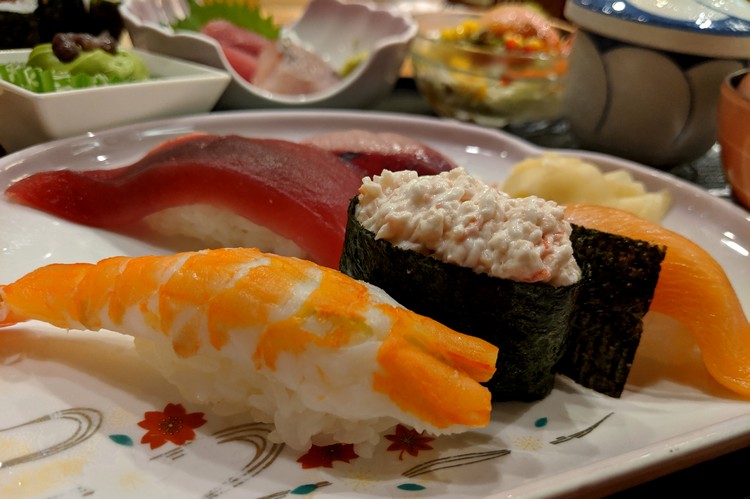
1. Sushi
Sushi is arguably the most famous food in japan. at least, it is for tourists. .
Without question, sushi is a big part of Japanese cuisine. You will find a variety of sushi shops in Japan, so you will have plenty of options.
If you’re not familiar with sushi, the thought of eating raw fish wrapped in thin sheets of seaweed might feel completely foreign and unsettling. You might even think that eating sushi is a big stretch for you. That’s okay, you’re not alone.
I think most people remember the first time they tried raw fish.
I know I do. It was a tuna sushi roll (tekka maki) at a small Japanese restaurant in North Vancouver. I had a mental block that prevented me from embracing the concept of raw fish. I wasn’t a fan of the texture or flavour, but it wasn’t as bad as I had built it up in my mind.
Now, years later, I can’t get enough sushi. I’m pretty sure we eat sushi at least once per week.
As one might expect, sushi tastes better in Japan. The fish is fresh and tasty and the sushi is prepared with a meticulous precision.
Travel tip – visit a Japanese restaurant in your hometown before you travel to Japan. Familiarize yourself with the menu and sample a few items. Let your curiousity run wild. This way, you have the advantage of reading the menu in English. Once you’ve seen and tried a few items, you’ll be much more comfortable with the food in Japan.
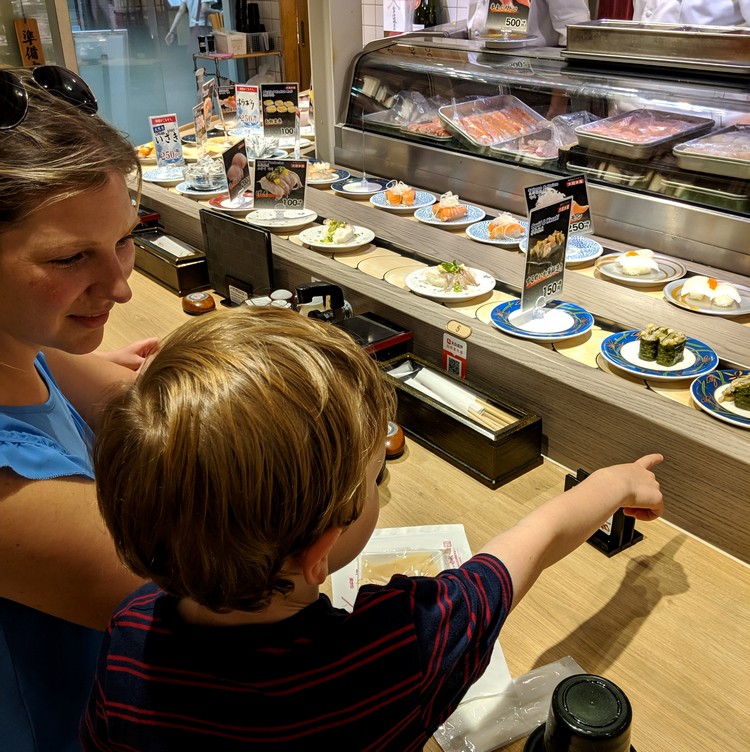
What sushi should you try first?
Sushi refers to any dish made with Japanese rice that’s seasoned with rice vinegar.
Sushi rolls are called maki or makizushi. Fresh fish and/or vegetables are wrapped with Japanese rice and a dried seaweed sheet (nori). The most common sushi rolls in Japan are salmon rolls, tuna rolls (tekka maki), unagi (freshwater eel), cucumber (kappa maki), f ermented soybean (Natto Maki) and f utomaki sushi rolls.
Here is list of useful sushi terms you should know before your visit to Japan.
Nigiri sushi are bite-sized mounds of sushi rice topped with slices of raw fish. The most popular nigiri sushi are sliced tuna, salmon, freshwater eel, squid and prawn. However, there are endless types of nigiri sushi available at Japanese sushi restaurants.
If you’re unsure about sushi and you want to ease in slowly, we recommend trying a non-fish sushi roll first, like cucumber, avocado, mushroom or egg (tamagoyaki).
Fun fact – California rolls and Dynamite Rolls are popular in North America, but not in Japan. Some Japanese restaurants in touristy areas will have these Westernized rolls on the menu, but most will not. These “safer” rolls are a good introduction to sushi because they do not have raw fish, but don’t expect to find these sushi rolls in Japan.
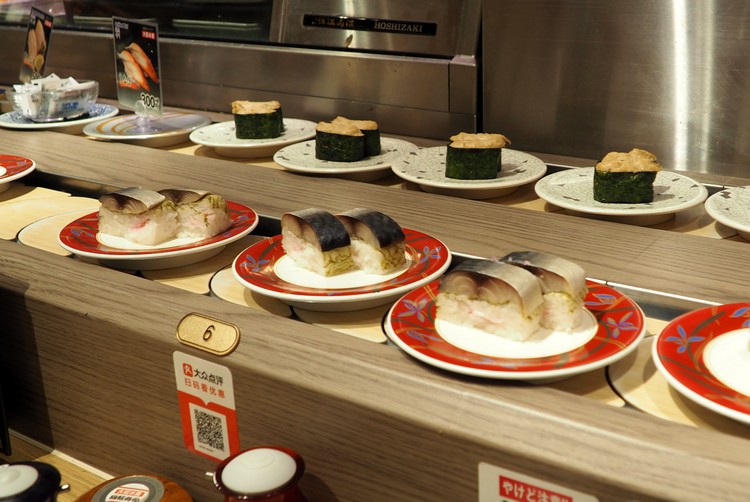
Conveyor belt sushi in Japan – Kaiten Sushi
A fun way to sample a variety of sushi is visiting a conveyor belt sushi restaurant, also called rotation sushi, sushi train and kaiten sushi . You may have seen or read about these innovative sushi restaurants during your research about Japanese food.
Basically, a conveyor belt transports small plates of various sushi around the restaurant. Typically, the conveyor belt passes beside tables or booths, or in front of a sushi bar, like the one pictured above.
Each item has a different price, which is identified by the colour or pattern on the plate. For example, the red plates might be 200 Yen each. If you see something you like, pick it up from the conveyor belt and enjoy. At the end of your meal, you add up the plates and pay for what you took from the conveyor belt.
We visited a few kaiten-zushi restaurants in Tokyo and Kyoto. They’re great. Not only does the sushi come out quickly, you can actually see the items as they pass your table. This is ideal for first timers who are nervous about trying raw fish for the first time.
And, you don’t need to worry about over-ordering, or under-ordering. The small bites allow you to pace yourself and try some items you might not have it you were to order from a menu.
Here’s an updated list of Conveyor Belt Sushi Restaurants in Tokyo.
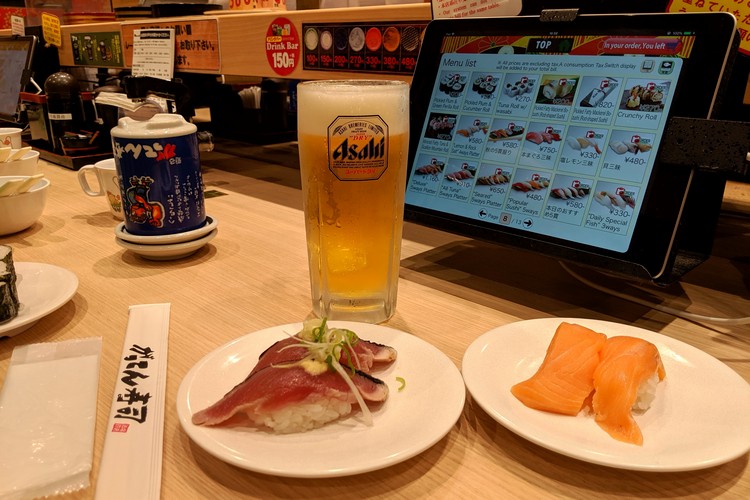
Most conveyor belt sushi restaurants in Japan have tablets at the table (see above photo). If you don’t see items you like on the conveyor belt, or you would like to order hot food items, you simply click the photos and place your order on the tablet.
Most tablet menus have an English option. This is helpful if you have specific items in mind.
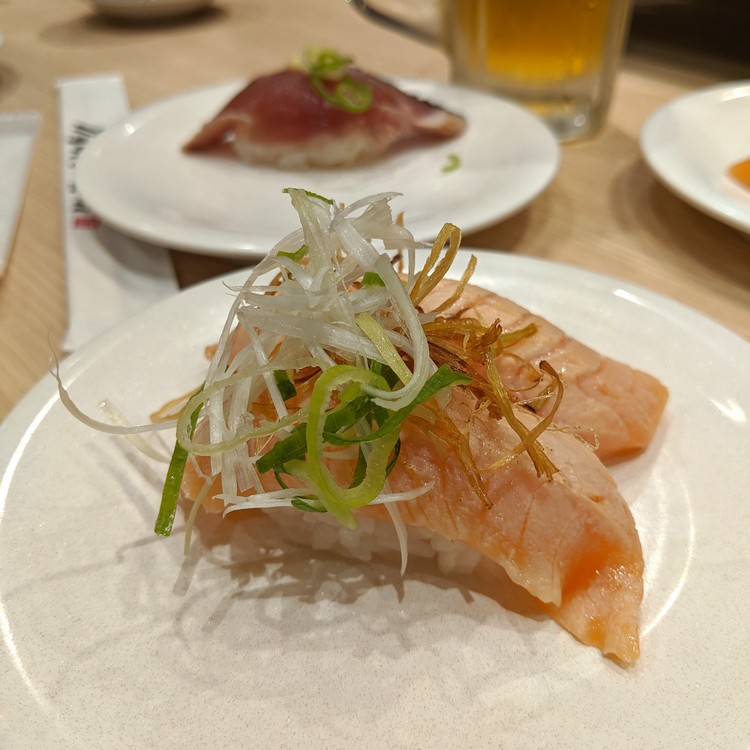
Above – a small plate of nigiri sushi at a kaiten sushi restaurant in Tokyo Japan.
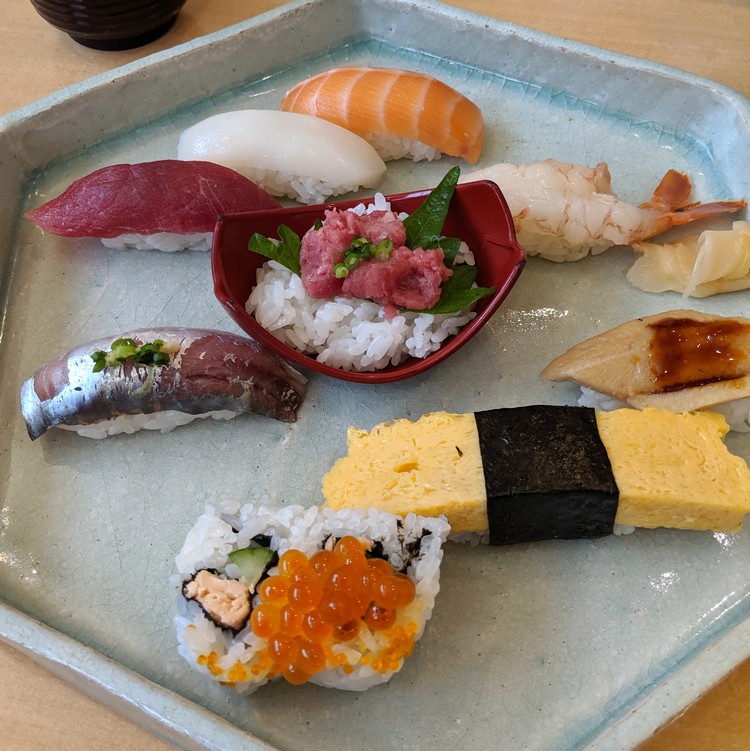
The above photo is a platter of various nigiri sushi.
Each piece of nigiri sushi a work of edible art. In the middle of the platter is chopped raw tuna belly served on rice. The big yellow sushi is tamago nigiri, which is a sweet folded omelet wrapped with seaweed.
Related post – Japan travel tips for first time visitors.
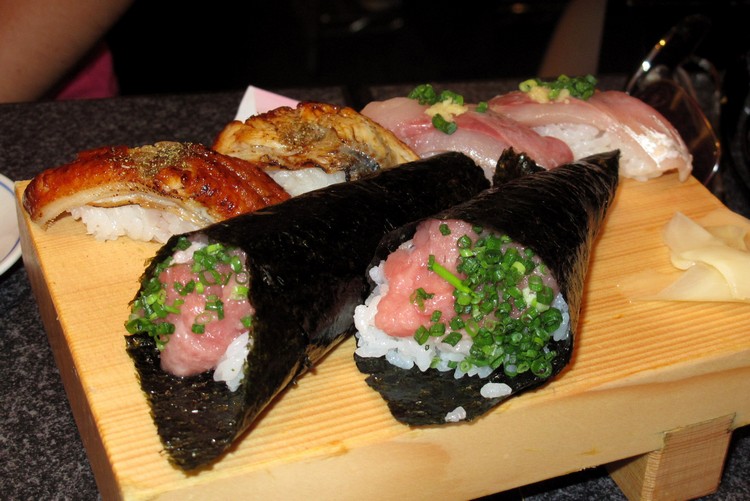
You can also order sushi cones, like in the above photo. These can get messy if you’re not careful. However, it’s one of our favourite food in Japan.
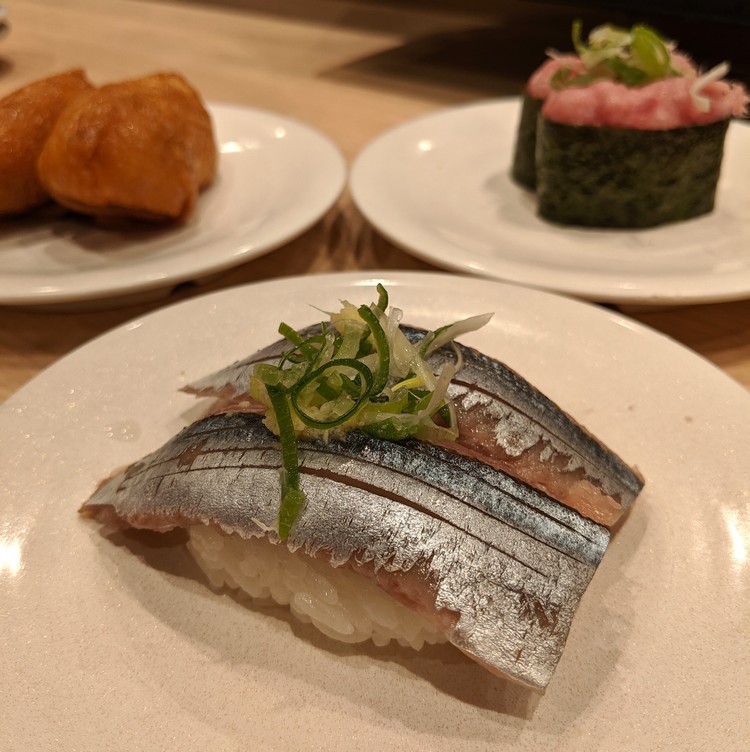
How to eat Sushi in Japan
We eat sushi often in Vancouver . At least once per week. We thought we knew the correct way to eat sushi, but we were wrong. How did we not know this before travelling to Japan?
Here’s an etiquette guide for how to eat sushi the correct way .
Apparently, the golden rules of eating sushi in Japan are:
- do not stick your chopsticks upright in the rice
- do not cut a piece of sushi in half with your chopsticks
- don’t mix wasabi in your soy sauce
There are a lot of things to know when it comes to Japanese culture. Most people will forgive foreigners for not knowing or understanding proper Japanese etiquette and customs, provided you’re respectful, quiet and polite. So, if you want to mix up your wasabi and soy sauce, do it subtly and don’t be surprised if the sushi chef rolls his eyes at you.
Related – Japan travel tips you should know before you go
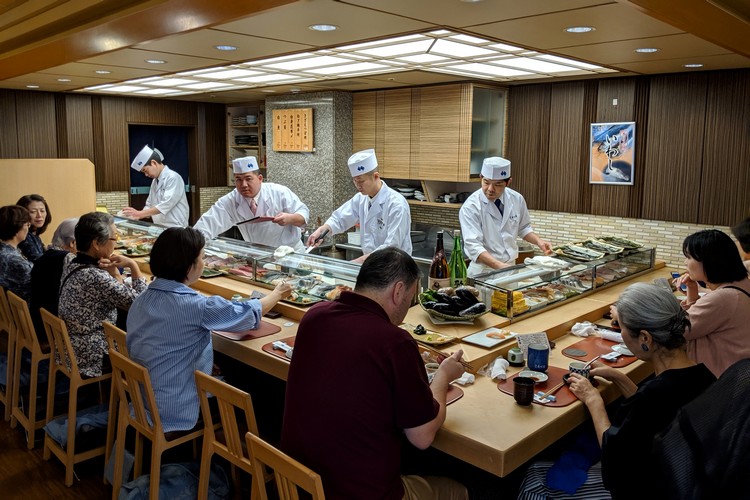
What is your favourite Japanese cuisine? Leave a comment below.
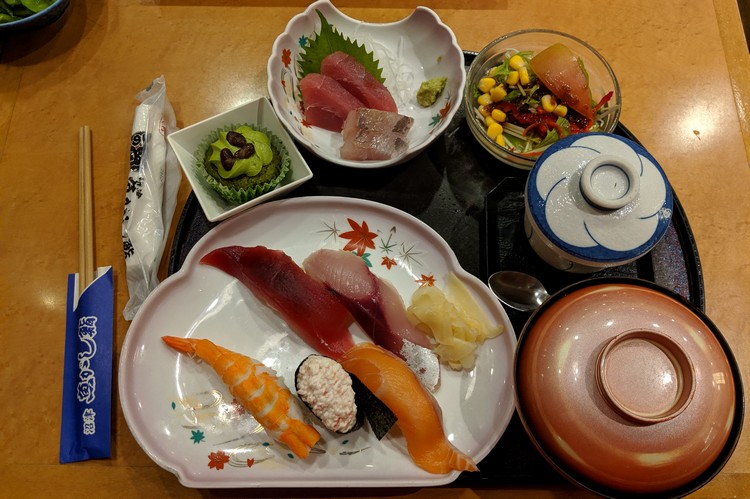
Sashimi is a Japanese delicacy that consists of thinly sliced raw fish, typically salmon, fatty tuna, yellowtail, mackerel, scallop and squid. You will also find sashimi-style meat, like chicken and beef.
Typically, sashimi is served plain and you dip the raw fish slices in soy sauce. However, some types of sashimi are served with a spicy sauce on top (example = spicy tuna sashimi).
What is the difference between sushi and sashimi?
There are a lot of similarities between sushi and sashimi. Some nigiri sushi, like the ones pictured above, have a strip of raw fish resting on a mound of Japanese rice. Same goes for some sushi rolls, like tekka maki (tuna), where the sushi roll is filled with slices of raw fish, which is basically sashimi.
In the above photo, the sashimi is located in the top dish. You can see the similarities between sashimi and nigiri sushi – the slices of fish on the nigiri sushi are so big that you actually can’t see the rice underneath.
Kaisendon traditional set menu
Kaisendon is a Japanese dish that consists of white rice and raw sashimi, such as prawns, octopus, squid, salmon, white fish, crab meat, egg, and sea urchin roes. It is often served with a traditional set menu (above photo).
In the covered brown bowl is miso soup, which is commonly served at Japanese restaurants.
The white bowl on the top right of the plate is chawanmushi , a steamed egg custard filled with meats and vegetables (including chicken, mushrooms, gingko nuts, kamaboko fish cakes, and carrots).
Other items typically found in a Japanese set menu are steamed vegetables, pickled vegetables, tempura (see below), salad, sushi rolls and/or a sweet desert like matcha cupcakes.
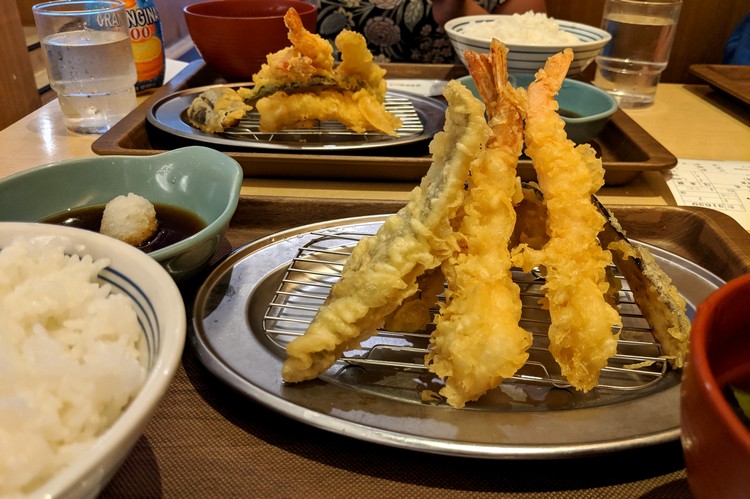
3. Tempura
Tempura is one of the most popular Japanese dishes in Japan. It’s a simple dish that consists of battered and deep fried seafood, meat and/or vegetables, served with a special dipping sauce called Tentsuyu.
Tempura is an easy introduction to Japanese food for tourists.
If you like crispy fish and chips, you’ll love tempura. Tempura batter is lighter than the batter that’s commonly used for fried fish and chicken.
Tempura can be served as an appetizer, side dish or as a stand-alone entrée. It’s typically made with prawns and/or vegetables, like yams, sweet potato, butternut squash, eggplant and green beans.
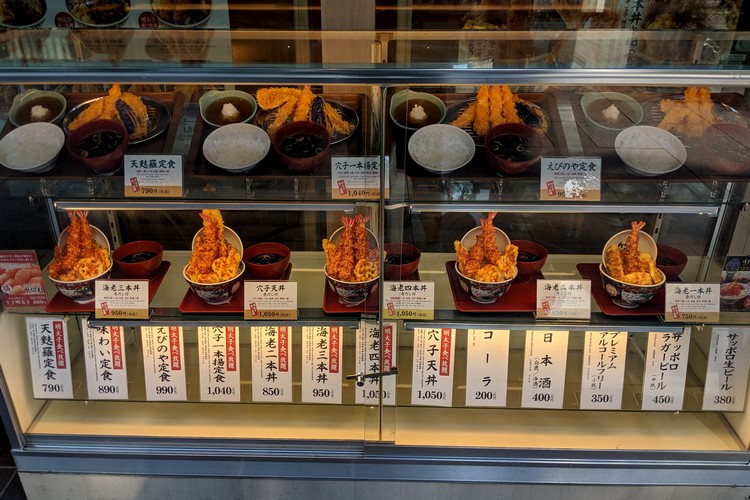
Many Japanese restaurants have plastic replicas of the dishes on display at the front or entrance to the restaurant. This makes it easy to visualize the menu and decide what you want to order before sitting down at a table. It’s very convenient when traveling with kids.
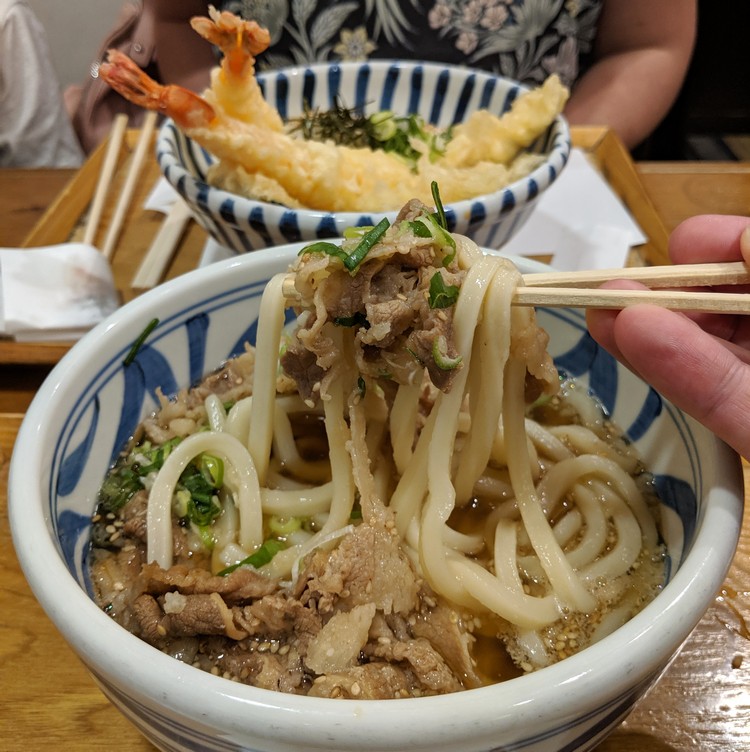
Udon is a popular Japanese dish that’s an easy introduction to Japanese food for tourists. It can be served a number of different ways, with a variety of ingredients, but it is most commonly served in noodle soups.
Pictured above is a delicious beef udon noodle soup that we enjoyed in Kyoto, Japan .
I like the simplicity of udon noodle soup. The flavourful savoury bowls are loaded with soft thick noodles, sliced chicken or beef, fresh vegetables and a variety of garnishes like green onion, sesame seeds, roasted seaweed slices, nora and dried garlic.
The most common udon noodle soups are Kitsune Udon, Tempura Udon (pictured above, in the backdrop) and Chikara Udon (topped with grilled mochi rice cakes).
You will also find udon noodles served in a stir fry dish, called Yaki Udon , mixed with meat, vegetables and a soy based sauce. It’s similar to yakisoba, but the noodles are different.
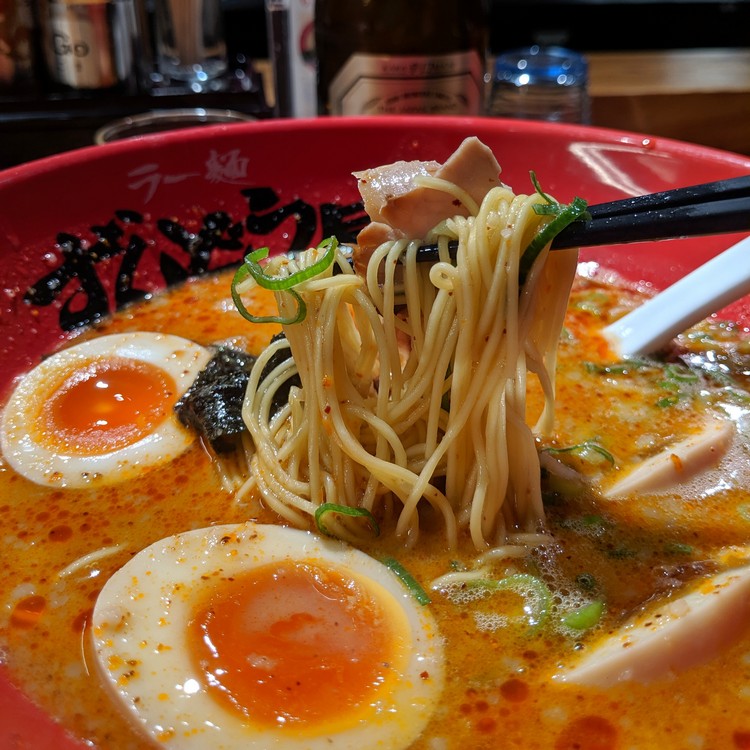
Ramen is probably the most popular Japanese cuisine for tourists.
Similar to udon, ramen is a noodle dish consisting of thinly sliced wheat noodles, protein, vegetables and is typically served in a rich savory broth. Ramen is the perfect Japanese food for beginners.
There are many types of broths, ingredients and garnishes that will completely change the flavour and texture of the ramen noodle soup. The four main ramen broth bases are soy, miso, salt and tonkotsu.
My favourite is miso ramen, but tonkotsu is a close second. Who and I kidding, I love them all!
You can also add items to your ramen. Typical ramen garnishes include chashu pork, menma (bamboo shoots), narutomaki (fish cake), scallion, shiraga negi (Japanese long green onion) and a marinated soft boiled egg ( Ajitsuke Tamago ). I love adding an extra soft boiled egg – they are heavenly when prepared properly.
Ramen is an inexpensive and popular dish that can be found almost anywhere in Japan. You won’t have a problem finding ramen restaurants in Tokyo or Kyoto.
That said, like most restaurants, some are better than others. If you’re only in Tokyo for a few days, research online reviews to find the best ramen restaurants in Japan. Make it count!
Related post – How to spend 3 days in Tokyo
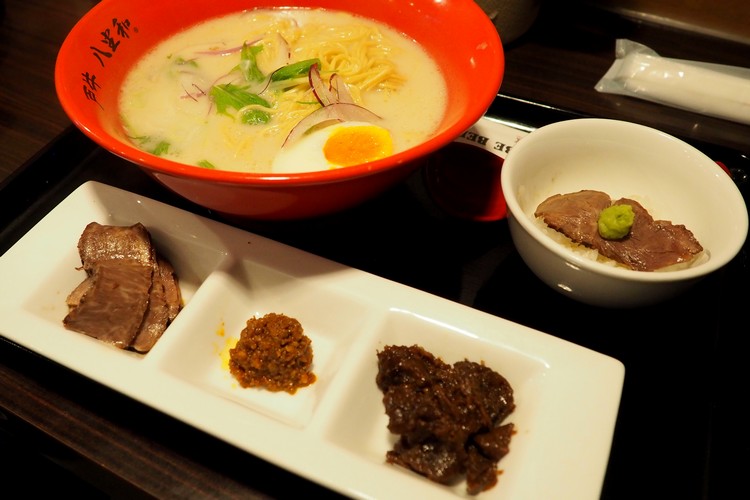
The above photo was captured at a small ramen restaurant in Kobe that was recommended to us. This particular miso ramen dish is served with a variety of Kobe beef.
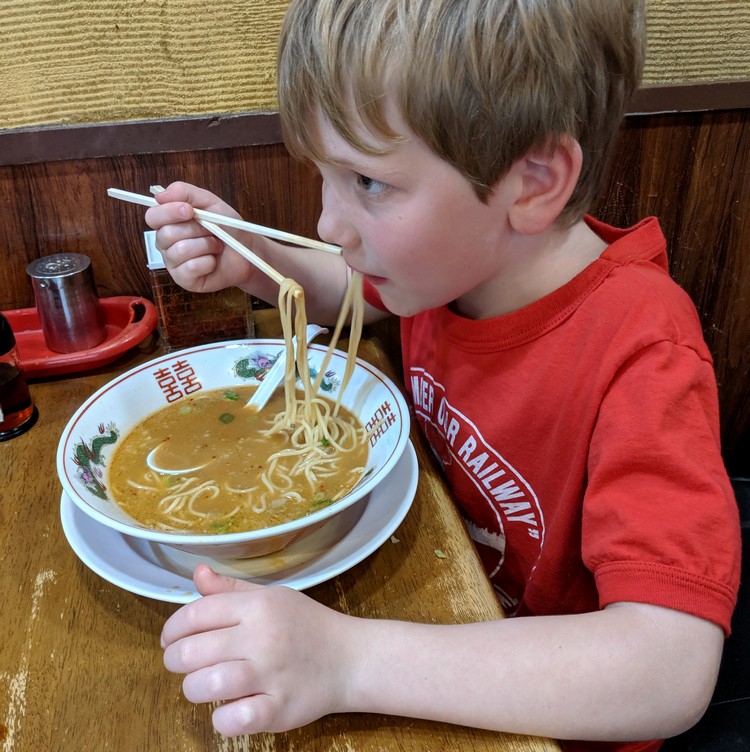
Ramen is an easy introduction to Japanese food for kids. Our 8 year old son loves miso ramen.
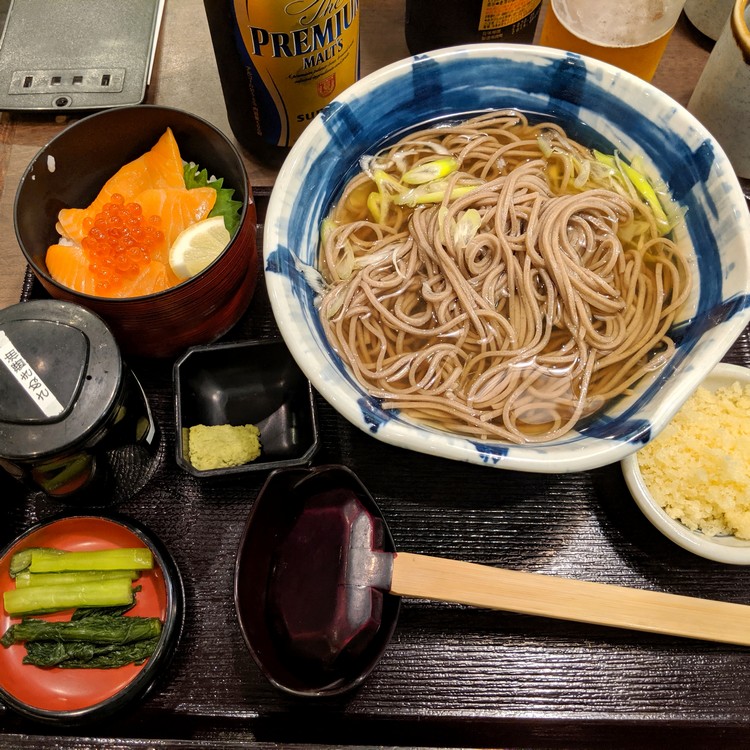
Soba is the Japanese name for thin noodles made from buckwheat flour, or a combination of buckwheat and wheat flours. Similar to udon and ramen, soba noodles are often found in savory soup broth. However, soba noodles are also served cold with a dipping sauce or as a hot stir fry dish.
There are many soba noodle recipes and dishes to taste, from spicy peanut soba noodle salad (served cold) to beef and vegetable stir fry soba noodles (yakisoba).
Many restaurants in Japan offer a set menu with soba noodle soup as the main dish, accompanied by a variety of side dishes, like tuna sushi, salmon sashimi, grilled vegetables, steamed spinach with peanut sauce (Goma-ae), crispy tempura batter and chawanmushi (traditional savory egg custard).
Related – 50 Photos of Kyoto that will inspire you to visit
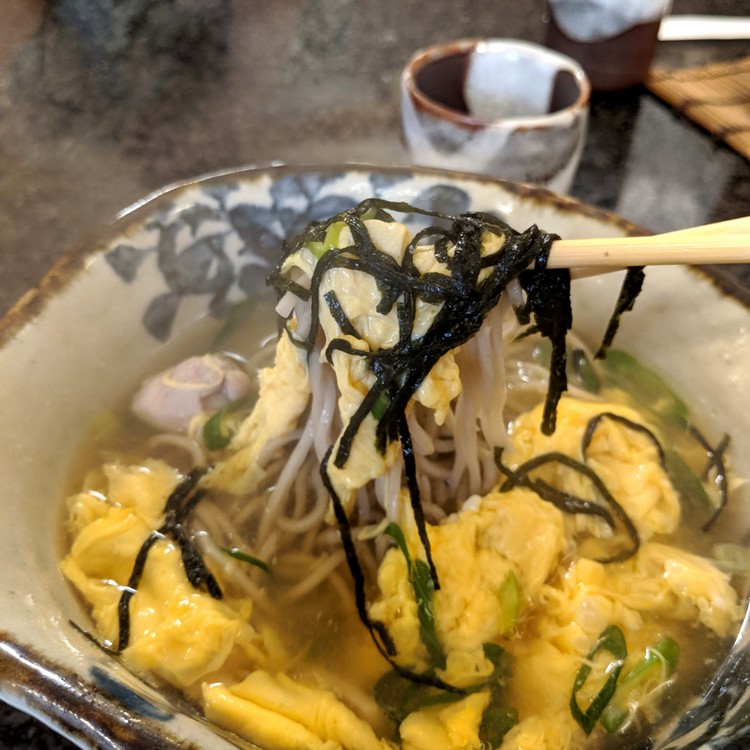
Above is a soba noodle soup with egg, chicken and sliced nori (dried seaweed).
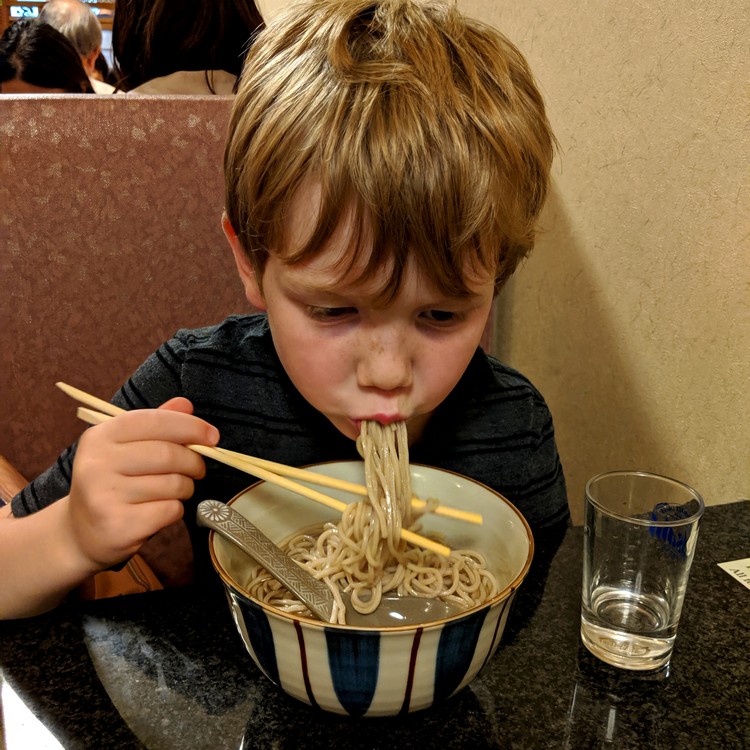
Another day, another bowl of noodles for this little guy.
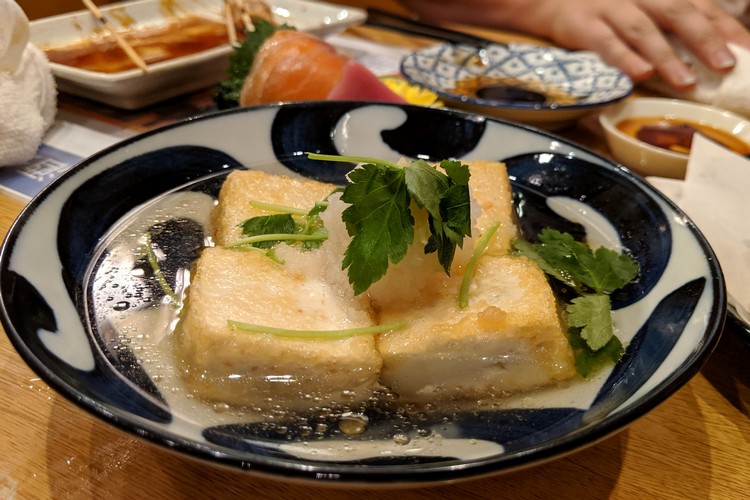
7. Agedashi Tofu
Agedashi tofu is cubes of soft or silken tofu coated with potato starch and deep fried so that the outer shell is crispy. It’s typically served as an appetizer or side dish, but can also be the main item in a bento box or served as an entrée.
If you’re vegetarian or don’t like to eat meat or fish, agedashi tofu is a great alternative.
Agedashi tofu is typically served with a flavourful tsuyu sauce for dipping. It is sometimes served with grated radish, green onion, and bonito flakes as garnishes.
Be careful. Agedashi tofu is deep fried and it comes out hot, hot, hot! We’ve burnt the roof of our mouths several times because we were too eager to dive in. The trick is to stab the middle of each piece of tofu with your chopstick so the steam releases and the tofu cools down. Consider yourself warned.
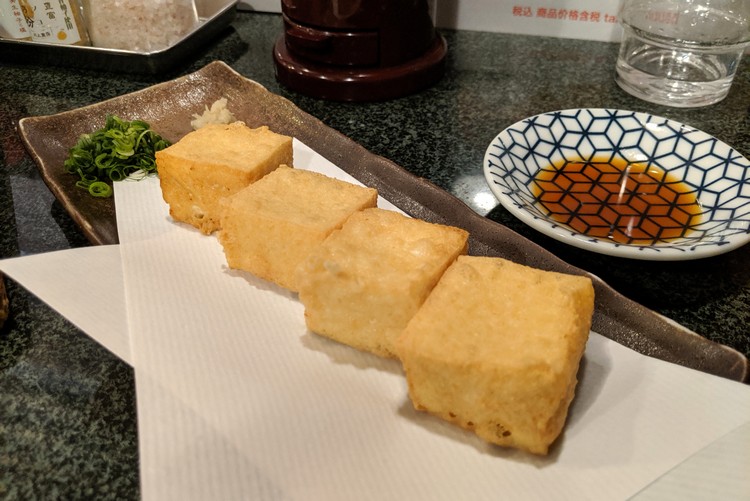
Above is a plate of large cubed agedashi tofu at a restaurant in Arima Onsen , an ancient hot spring town located near the city of Kobe.
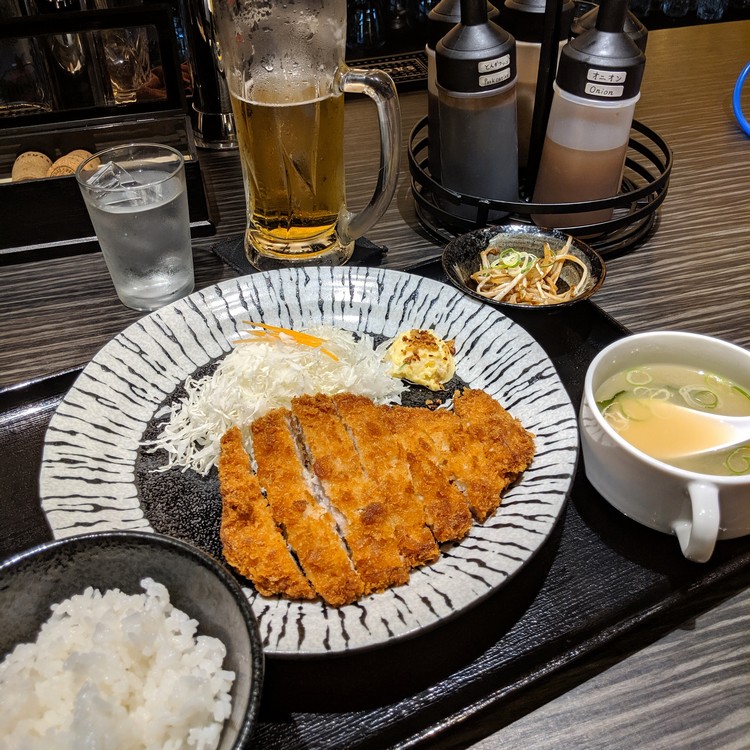
8. Tonkatsu (deep fried pork cutlet)
Tonkatsu is a breaded, deep-fried/tempura pork cutlet that is traditionally served with rice and sliced cabbage. It is a popular Japanese food for beginners because, well, who doesn’t like deep fried <insert anything and everything>?
Tonkatsu is similar to German schnitzel. However, the bread crumbs used for tonkatsu is called panko, which is different from the breadcrumbs used in Western cuisine.
You will find variations of tonkatsu in Japan, including katsudon , which consists of tonkatsu served on a bowl of rice, and katsu sando , which is a sandwich with tonkatsu between two slices of plain white bread.
Katsukare is another Japanese cuisine that consists of sliced tonkatsu pork cutlet served with Japanese curry rice and curry.

9. Yakitori
Yakitori is the japanese version of chicken skewers..
There are many variations of yakitori , however, typically the skewers are made with bamboo skewers and seasoned with tare sauce and/or salt and spice.
Yakitori comes in many forms, including white chicken skewers, chicken and spring onion, chicken meatballs, chicken small intestines, gizzard and chicken heart, to name a few. Some restaurants and specialty shops also have deep fried options available.
Yakitori a popular Japanese street food that is commonly found at outdoor markets, food courts, sporting events and Yakitori-ya, which are small shops that specialize in yakitori. It’s widely available at izakayas, informal Japanese bars that serve alcoholic drinks and snacks. Here’s a list of best izakaya alleys in Tokyo.
Related – The best things to do in Tokyo for first time visitors
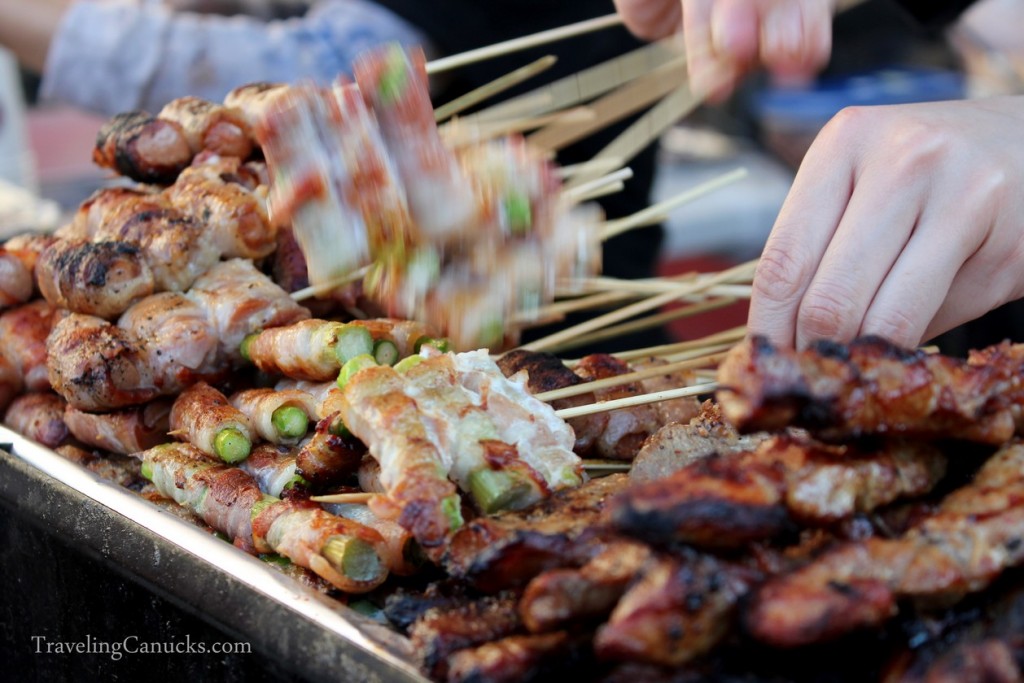
Freshly grilled yakitori at a market in Japan.
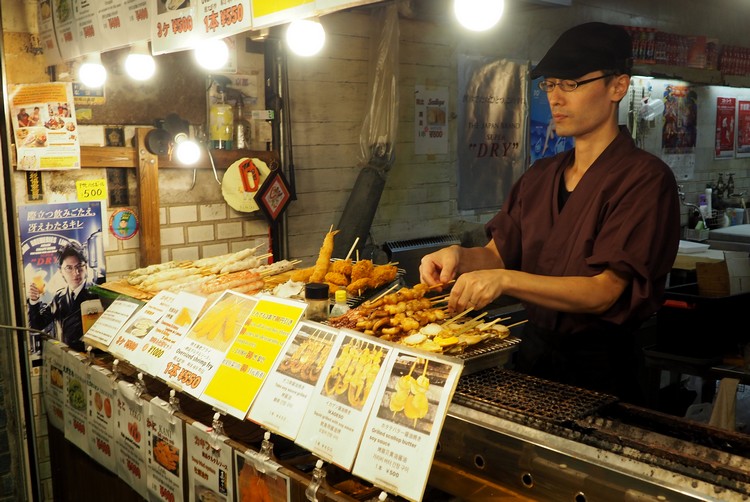
Yakitori and deep fried skewers at a stall in Nishiki Market in Kyoto.
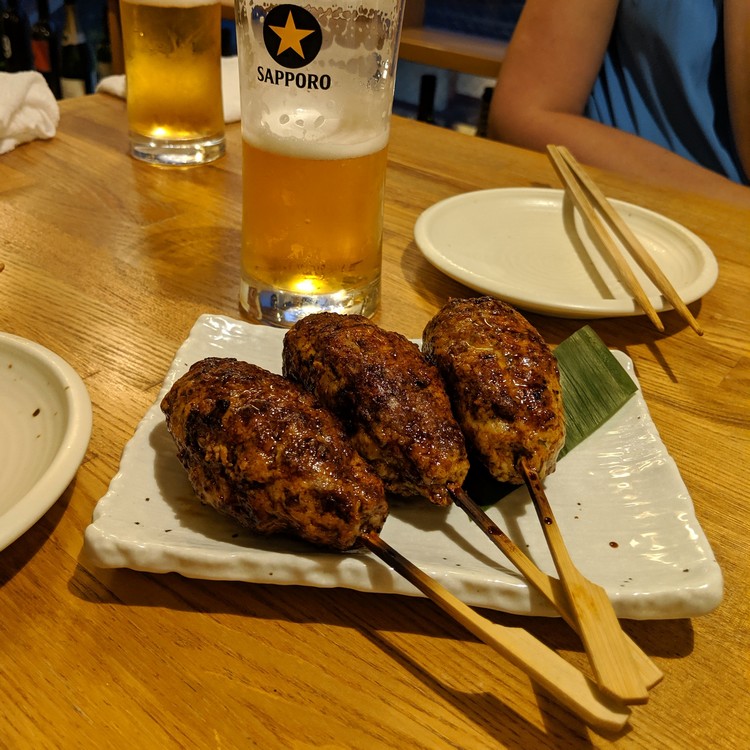
Chicken meatball yakitori served at a restaurant in Kyoto.
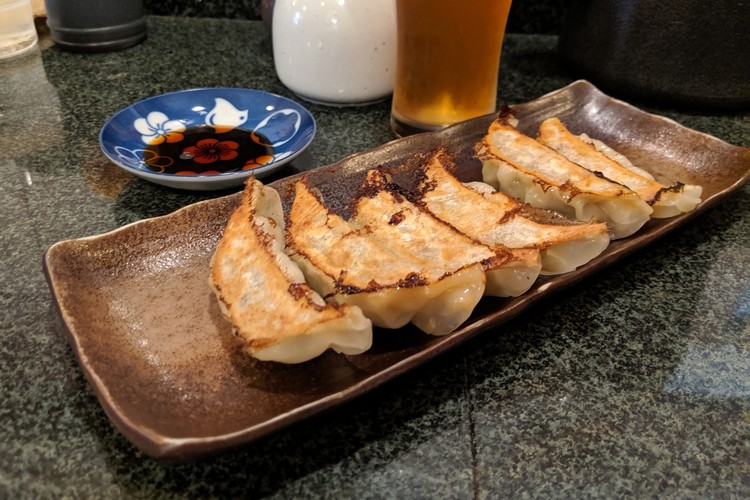
Gyoza is another popular Japanese dish that is a must try food in Japan. It’s commonly served as an appetizer or side dish at sushi restaurants.
Gyoza is Japan’s version of the dumpling. It’s most similar to Chinese potstickers or jiaozi dumplings. These tasty Japanese dumplings are typically filled with minced pork, cabbage, scallions, garlic, and ginger. Vegetarian options are typically available, too.
Gyozas are typically fried in sesame oil on one side, until they have a crispy bottom. The top of the gyoza is steamed, giving it a soft texture. They’re served with a dipping sauce of rice vinegar, soy sauce and chilli oil.
Gyozas are an easy introduction to Japanese food for unadventurous eaters.
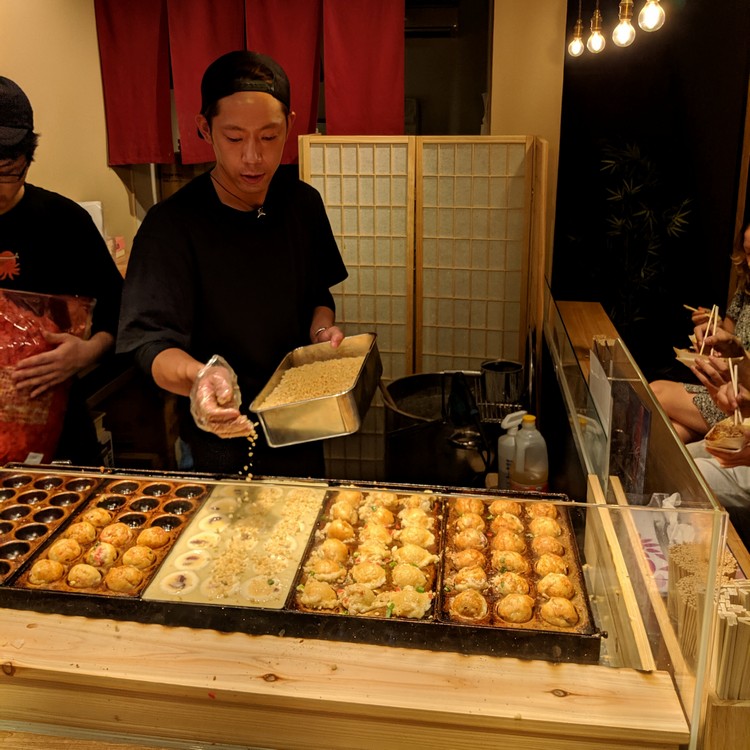
11. Takoyaki
Takoyaki, also known as octopus balls , is a delicious doughy ball filled with minced or diced octopus, tempura scraps, pickled ginger and green onion..
They are commonly eaten as a snack or appetizer and are served with takoyaki sauce (similar to Worcestershire sauce) and mayonnaise, and garnished with shavings of dried seaweed and fish flakes.
You will find small shops and street food vendors serving takoyaki throughout Japan.
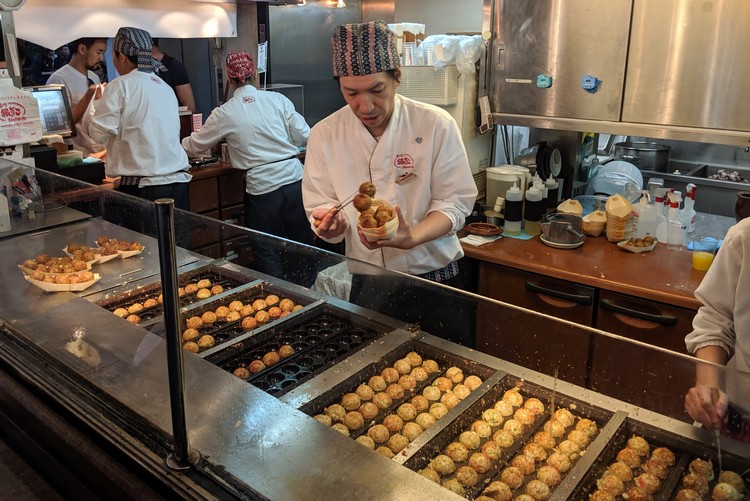
Gindaco Takoyaki is the famous takoyaki restaurant near Harajuku train station in Tokyo.
We highly recommend you visit this location. They serve the best takoyaki in Tokyo, in our opinion.
Be prepared to wait your turn, as this location is very popular. It’s worth wait. Do it.
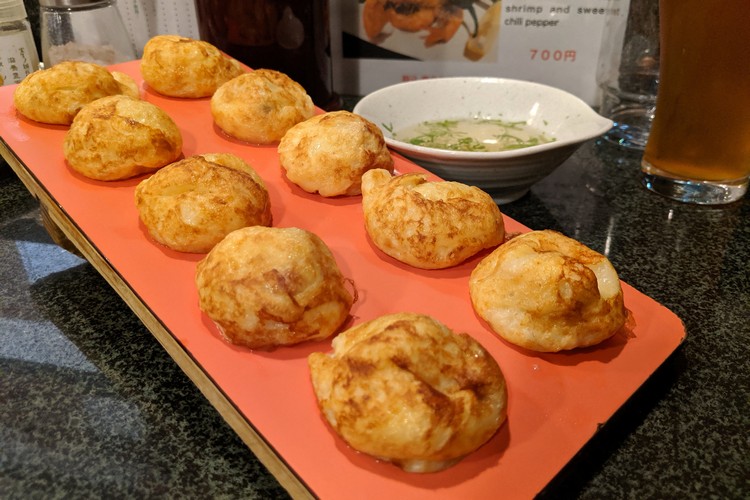
This takoyaki platter is served plain with a light vinegar dipping sauce on the side.
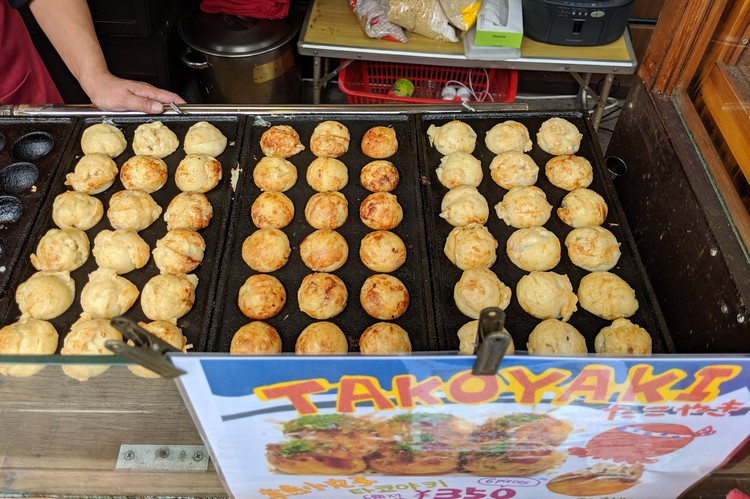
Takoyaki street food vendor near Fushimi Inari temple in Kyoto.
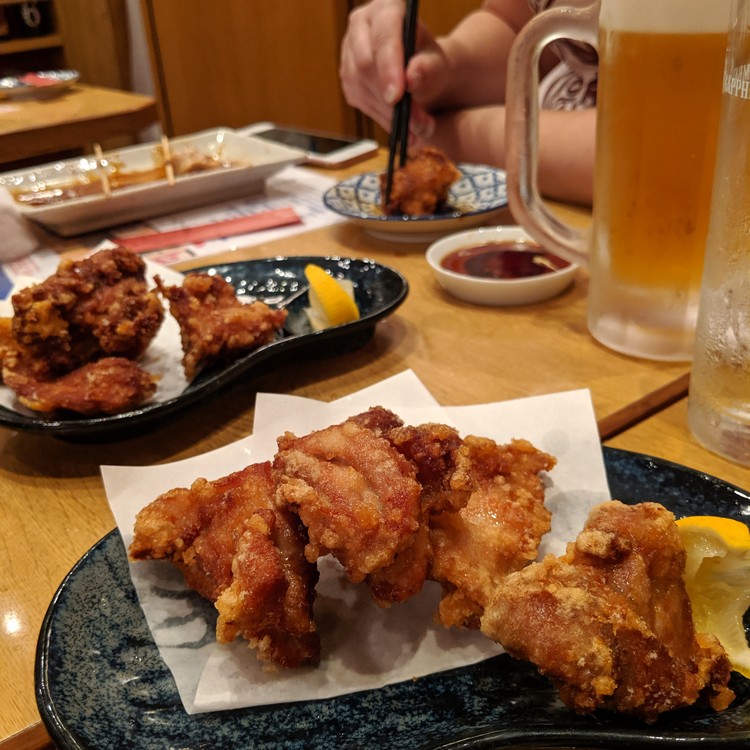
12. Chicken Karaage
Karaage is Japan’s version of fried chicken. The chicken is battered and deep fried until crispy on the outside. The chicken is often marinated prior to being coated with batter.
Karaage is served alone or with rice and shredded cabbage. It’s often served as an appetizer but it can also be a stand alone dish. You will find karaage served at most Japanese restaurants, as well as street food vendors at outdoor and indoor markets.
Our boys love chicken nuggets, so this tasty Japanese cuisine is one of their favourites.
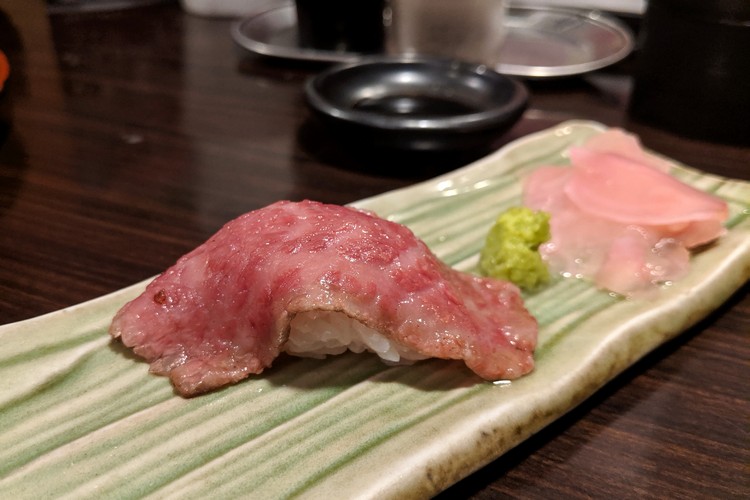
13. Kobe beef in Kobe Japan
For all you steak lovers out there, you must try kobe beef in kobe..
Kobe is famous for its Wagyu beef , arguably the finest cut of beef in the world, which comes from the Tajima strain of Japanese Black cattle.
Kobe beef is a Japanese delicacy , valued for its flavour, tenderness, and fatty, well-marbled texture. Foodies flock to Kobe to sample it’s famous namesake.
First time visitors to Kobe will have no trouble finding a restaurant serving Kobe beef. It’s heavily advertised from the moment you get off the train at the Kobe train station.
There are a number of ways to sample this popular Japanese style of beef, from Kobe beef teppanyaki to Kobe beef hamburgers to Kobe beef sushi (pictured above).
Kobe beef is an expensive cut of meat , so your budget may dictate the best way to experience this celebrated Japanese cuisine. High-end steakhouses offer multi-course meals that serve a variety of cuts and styles of wagyu beef.
Or, you can enjoy Kobe beef on the cheap by sampling kobe beef sushi from a variety of restaurants or street food vendors. That’s what we did, because only one of us likes beef (hint – it’s not Nicole or the boys).
Now, if Kobe City is not on your original Japan travel itinerary, you can easily add it by taking a day trip to Kobe from Kyoto, Tokyo or Osaka. Or, you can simply get off the train in Kobe and have lunch or dinner, then get back on the train and continue to your next destination.
You will find wagyu beef throughout Japan, so don’t worry if you aren’t able to make it to Kobe. There are dozens of restaurants in Tokyo that serve wagyu beef, including Kobe beef, Omi beef and Matsusaka beef.
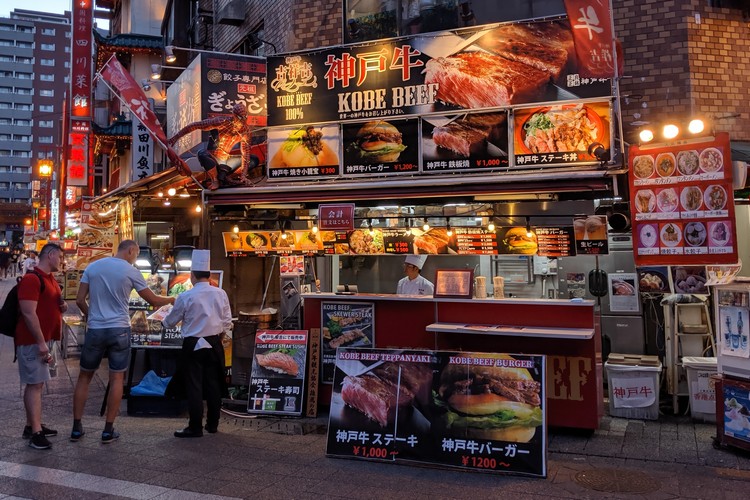
Street food vendors in Kobe Chinatown serve a variety of Kobe beef to hungry visitors.
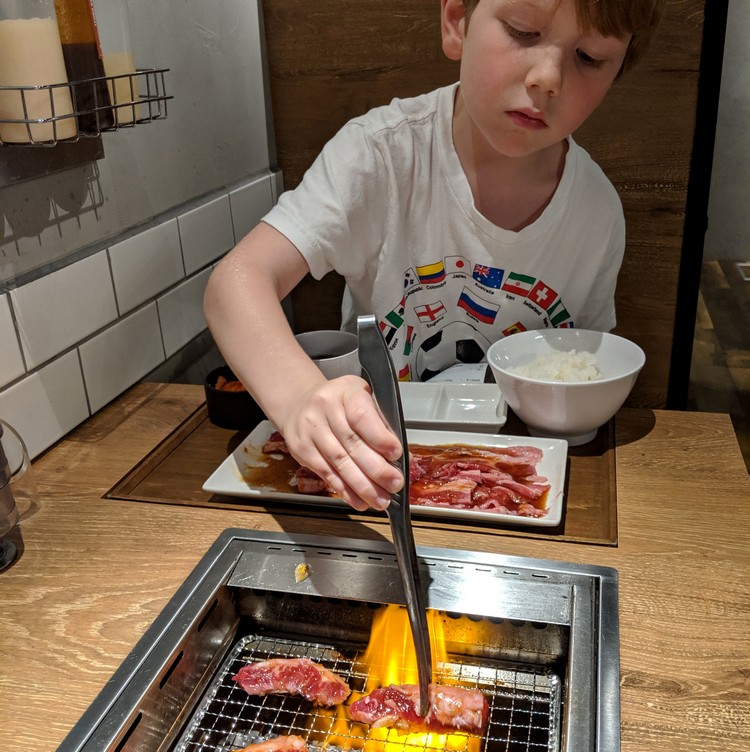
14. Yakiniku
Yakiniku is a Japanese term that refers to grilled meat. Basically, you grill your meat on an open flame at your table. It’s a fun Japanese dining experience that you should try on your Japan vacation.
We stumbled upon a great yakiniku restaurant, Yakiniku LIKE , while exploring the Akihabara district in Tokyo. There are tablets at each table with an English menu and photos of each dish, so it’s an easy process with limited ‘lost in translation’ moments.
We ordered a variety of pork and beef to grill at our table. The raw meat is marinated and sliced, so you just add to the flame and cook it as much, or as little, as you like. Meals are served with rice and there are several condiments at your table.
Our boys loved grilling meat on the table. This was there first time and it remains a highlight for them when we talk about our family trip to Japan.
Related – The top things to do in Tokyo for tourists
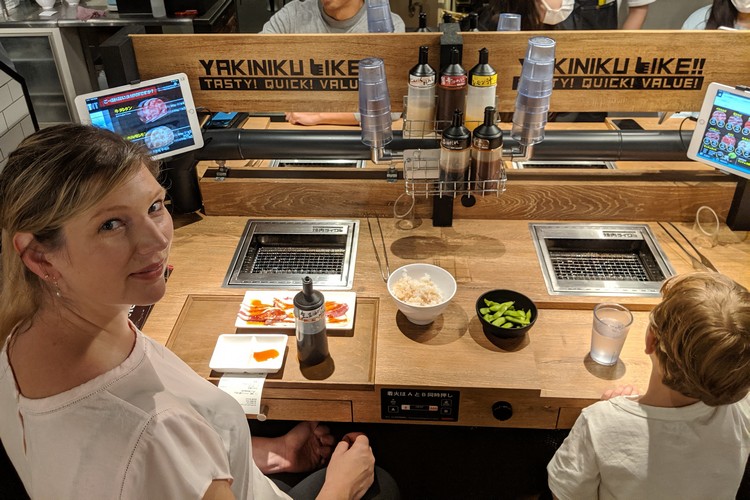
Follow us on Facebook for the latest travel updates.
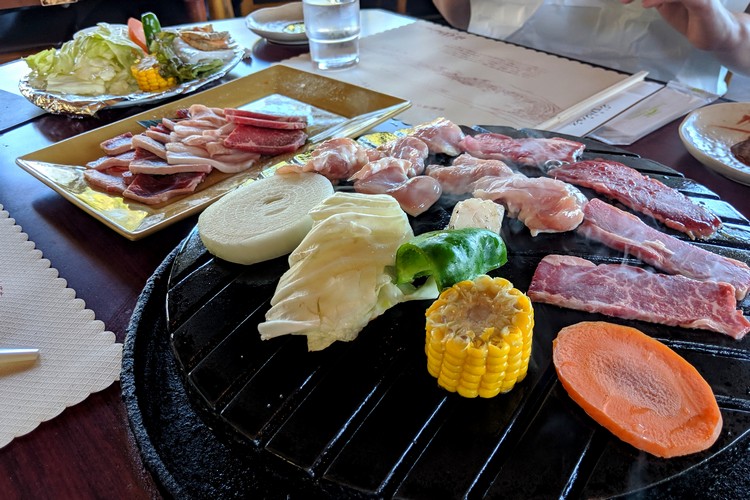
Japanese BBQ at your table
We enjoyed a fun lunch at Rokkosan Genghis Khan Palace on Mount Rokkō in Kobe City. Rather than being grilled on an open flame, like yakiniku, this Japanese barbecue grill is on a hot iron plate.
We ordered a variety of vegetables and meat, including Kobe beef, chicken and marinated pork, and grilled the food at our table. Our boys enjoyed using the tongs to flip the meat and listen to it sizzle on the iron plate. It’s a fun Japanese dining experience for tourists.
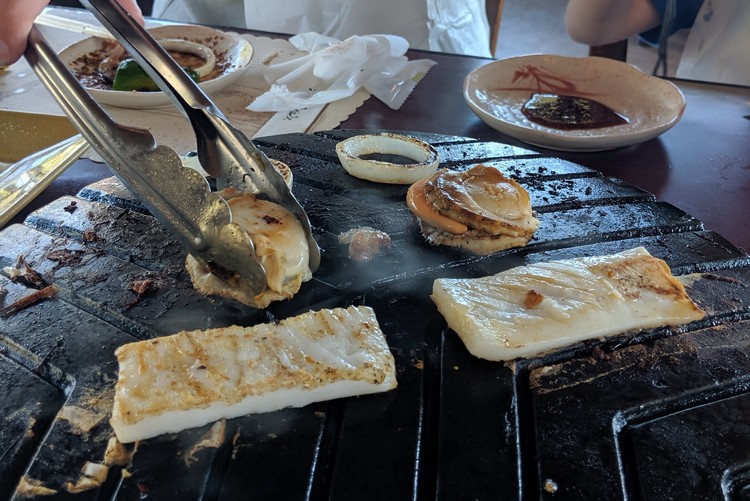
Grilling squid and giant mussels on an iron plate at our table .
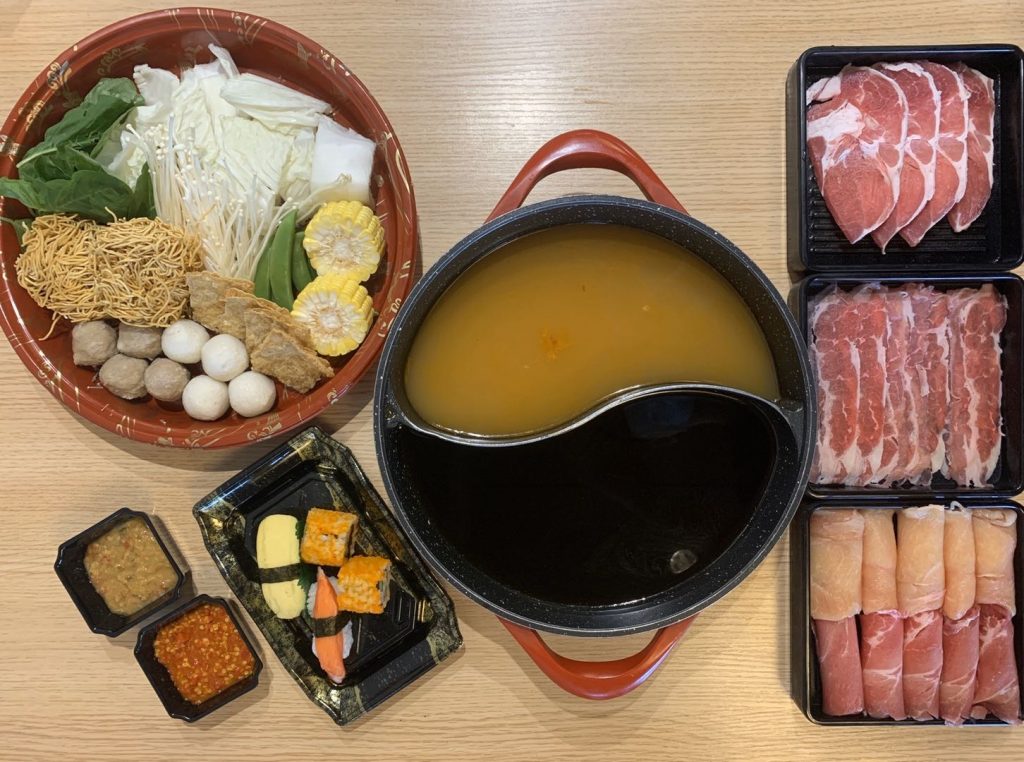
15. Shabu-shabu
Shabu-shabu is a hotpot dish that’s a big part of japanese food culture..
Basically, you cook your food at the table in a large heated pot with boiling water or broth. Some hotpots are split in half, like in the above photo, with each side having a different broth.
Most platters come with a variety of vegetables, seafood and thinly sliced meat, as well as dipping sauces, spices and garnishes so you can play with the flavours and heat.
Shabu-shabu is a fun Japanese dining experience to enjoy with friends and family. The idea is that you take your time and socialize around this bubbling hotpot. You dip your meat or vegetable as needed, rather than all at once. It’s a must try Japanese cultural experience for your Japan holiday.
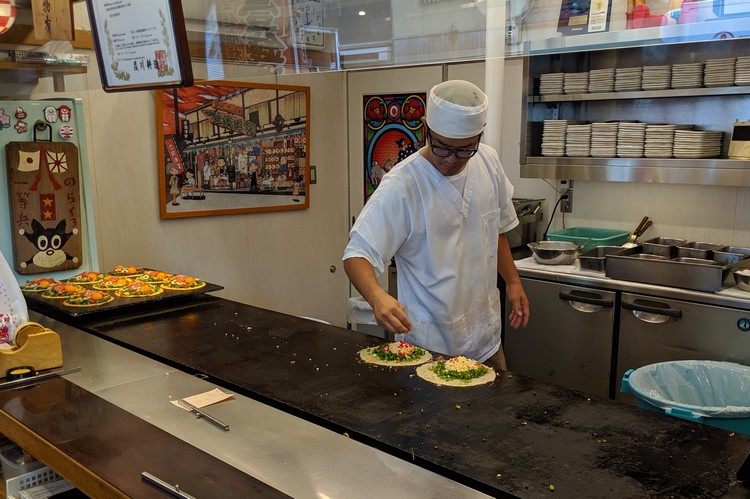
16. Okonomiyaki
Okonomiyaki is a japanese savory pancake with a variety of ingredients..
It’s a popular food in Japan for tourists because it’s a uniquely Japanese. There are different types of okonomiyaki throughout Japan, with toppings and batters varying depending on the region.
Okonomiyaki is mainly associated with the Kansai or Hiroshima areas of Japan, though it’s said to have originated in Osaka. It is sometimes compared to an omelette and may be referred to as a Japanese pizza or Osaka soul food .
The Kansai style okonomiyaki is the most common version found throughout Japan and typically contains meat (thinly cut pork belly or bacon), octopus, squid, shrimp, vegetables, green onion, and/or cheese. We prefer the Hiroshima style okonomiyaki because we like the ingredients to be layered, rather than mixed.
There’s also a semi-liquid okonomiyaki found in Tokyo called monjayaki. The ingredients in monjayaki are finely chopped and mixed into the batter before frying.
Here’s a list of the best Okonomiyaki in Kyoto.
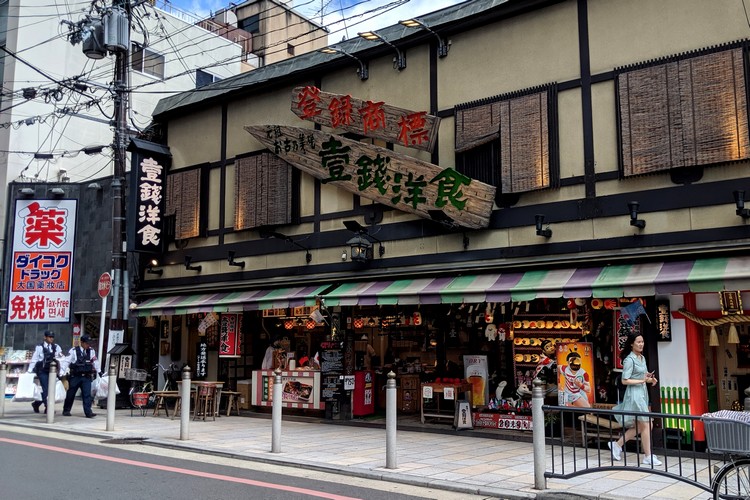
Issen Yoshoku is a famous okonomiyaki restaurant in Gion, Kyoto.
While the savoury pancakes are delicious, this okonomiyaki restaurant in Kyoto might be more famous for its statue at the front entrance. See photo below.
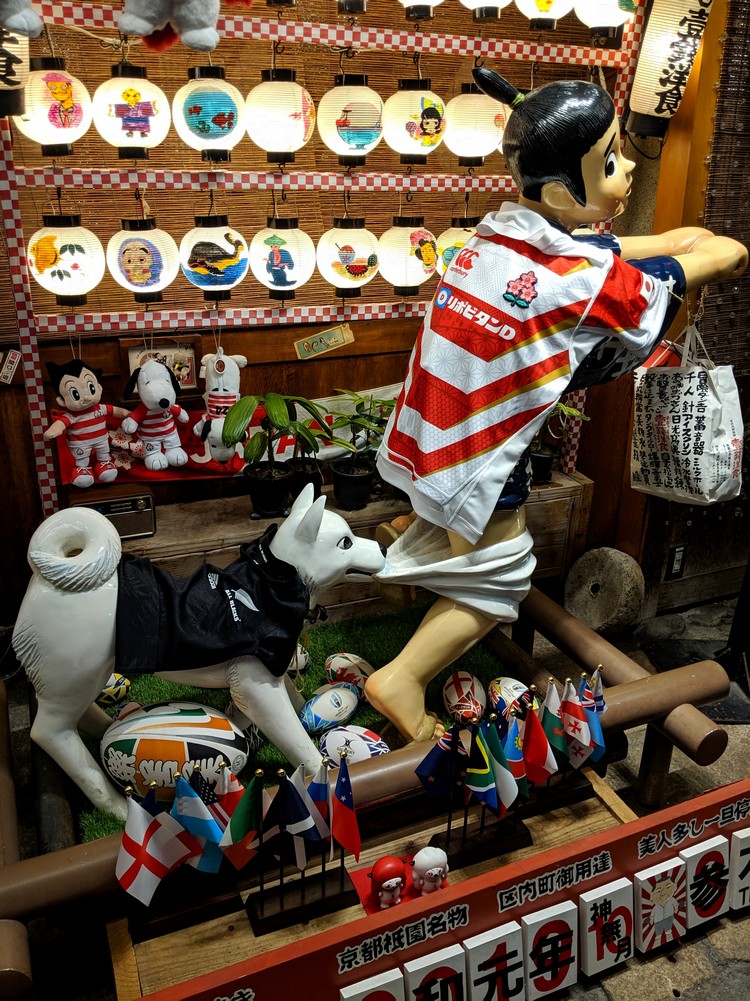
When we visited Kyoto a decade ago, we stumbled upon this funny statue of a boy getting bitten by a dog with his pants down in front of a restaurant. We thought it was an odd statue, so we took a photo.
When we returned last year, we stumbled upon it once again, by pure chance. Of course, we had to take another photo to capture the memory. This time, the boy is wearing a Japan rugby jersey because we visited for the Japan Rugby World Cup .
While thousands of people may have a photo of this strange statue, few will have a photo of it decorated for the Japan Rugby World Cup.
Related – Our experience at the Rugby World Cup in Japan
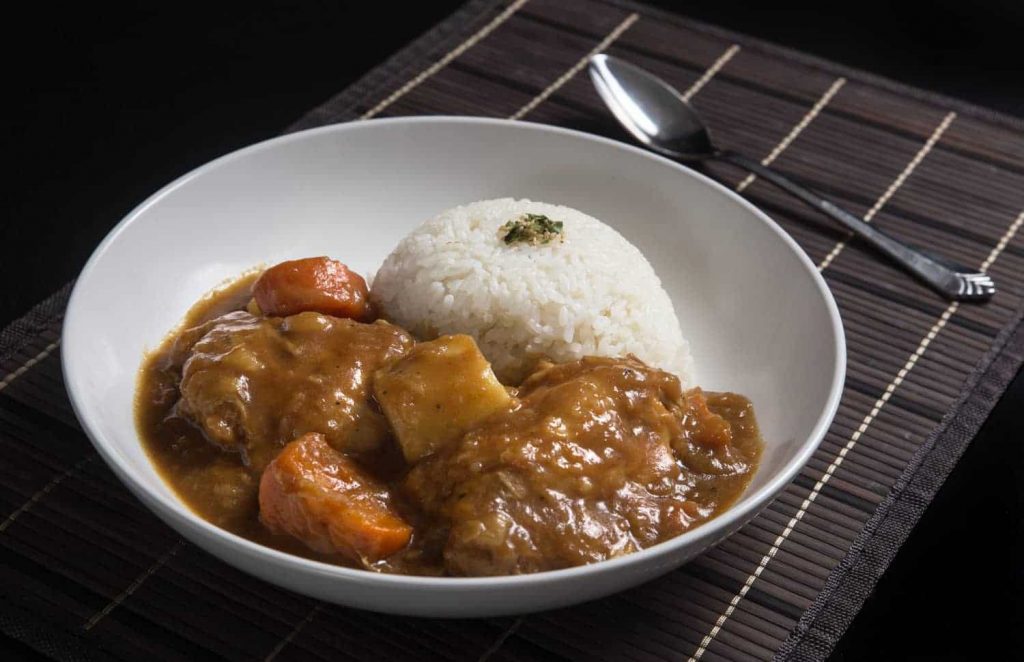
17. Kare Raisu (Japanese Curry Rice)
When we think of Japanese food, rarely does curry come to mind. That’s why we were surprised to see how popular kare raisu is throughout Japan.
Japanese curry rice tastes different from the curry you find in India or Southeast Asia. The main ingredients for Japanese curry are a variety of meats (chicken, pork or beef), vegetables (onions, carrots and sweet potatoes/yams) and spices. We found Japanese curry to taste more like a thick gravy with a curry flavour.
We’re told that kare raisu is a good example of yoshoku , which takes dishes from Western culture and adapts them to meet Japanese tastes and preferences (fusion cuisine). Japanese curry rice is an inexpensive Japanese dish that can easily be found throughout Japan.
We enjoyed Japanese curry rice for lunch when we visited Tokyo Disneyland .
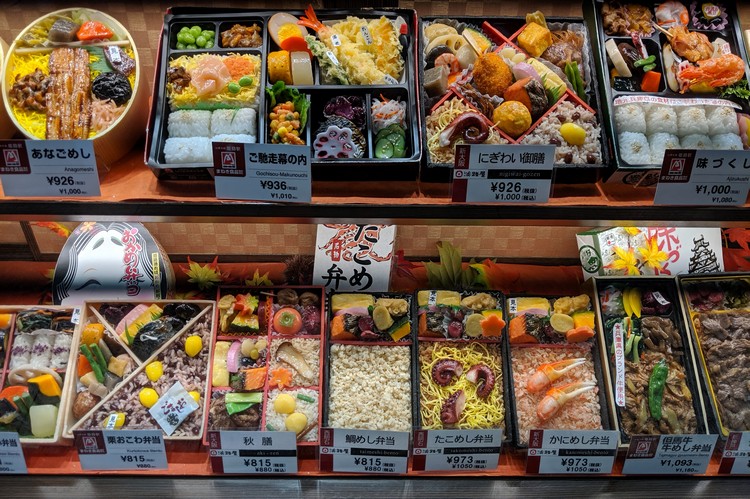
18. Bento Box
If you have not tried a japanese bento box, you are missing out. .
There are literally hundreds of varieties of bento boxes in Japan. A bento box is typically a single portion takeout or prepackaged meal, however you can also order bento boxes at restaurants. A typical bento box has a balance of dishes, most often including rice, meat or fish, and pickled vegetables.
We often order bento boxes for lunch at sushi restaurants because they offer a variety of items to sample.
During our travels in Japan, we would pick up bento boxes and bring them back to our hotel room or apartment rental. They are convenient, inexpensive and mostly healthy. Bento boxes are also a great way to sample a variety of side dishes that you might not have ordered otherwise.
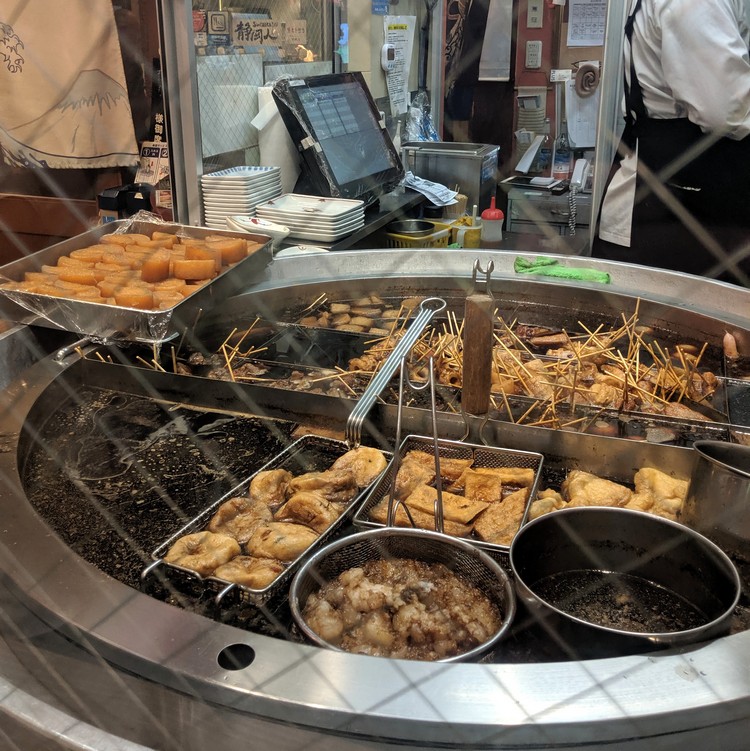
19. Oden (Japanese one-pot dishes)
Oden is an interesting part to Japanese food culture. It’s a common food in Japan that gets mixed reactions from tourists and first time visitors.
Basically, oden is a type of hotpot with an assortment of vegetables and proteins, including sausages, processed fish cakes, mochi rice cakes, daikon radish, konjac yam, tofu, and boiled eggs, to name a few. These items are stewed in a light broth and served to order. Ingredients vary according to region.
As a tourist, we had a hard time deciphering each item. In the photo above, this restaurant has a variety of items soaking in a hot broth. Guests walk up to the window and order items to take home.
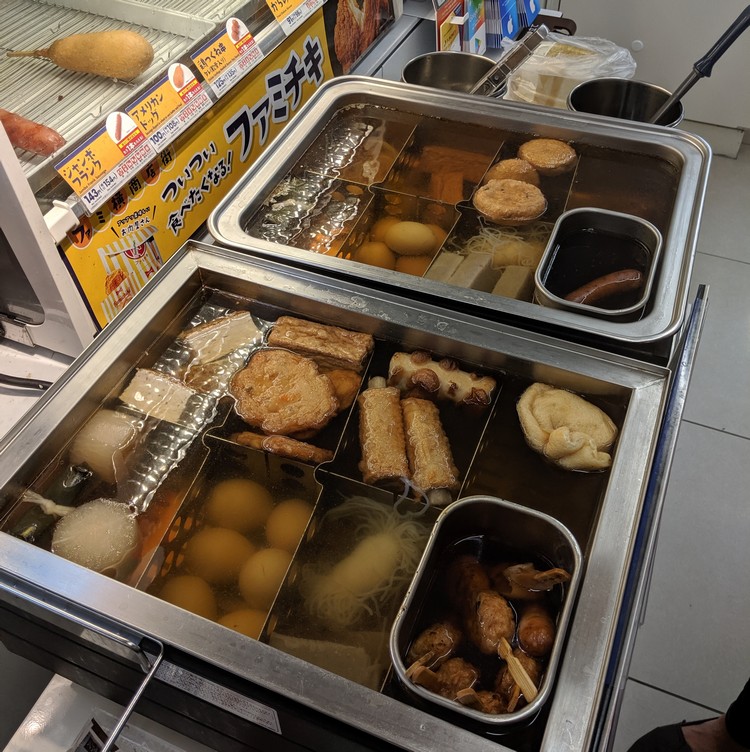
Oden at Convenience Stores in Japan
Most convenience stores in Japan will have oden during the winter months. You typically find this food at the front of the store, near the cashier. The most common convenience stores in Japan are Seven Eleven, Lawson and Family Mart.
You will find at least one of these convenience stores on virtually every block in the city. Purchasing premade food items at convenience stores is an easy way to travel cheap in Japan.
In some stores, an employee will serve you. In other stores, you help yourself. You simply take a bowl and add the specific items you would like. It’s common to add broth to the bowl to keep your items hot.
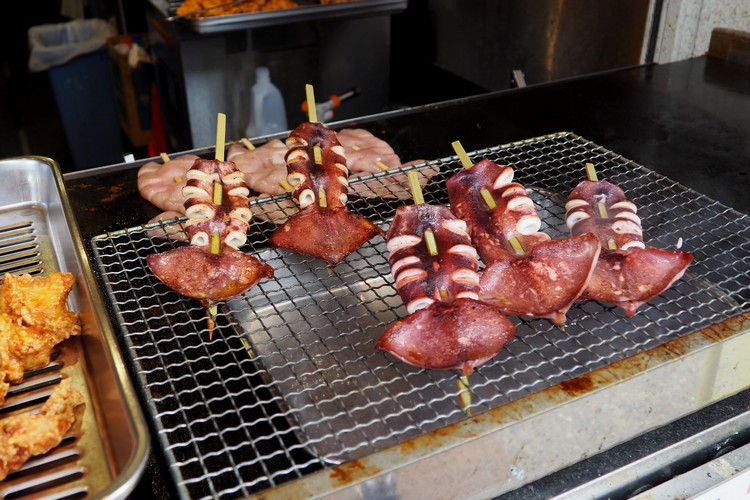
20. Street food at Japanese markets
There’s no shortage of interesting japanese cuisine at food markets in japan..
We like visiting markets when we travel because they provide insight into the food culture of a country. They typically have several vendors selling a wide variety of food items, so they’re a great place to let your curiousity run wild.
Some of the popular temples in Kyoto have rows of vendors selling grilled meats and traditional Japanese quick eats, like yakitori, grilled squid (above photo), takoyaki, hanami dango (sweet rice balls) and deep fried pastries.
If you’re looking for food to try in Tokyo, check out this list of the best food markets in Tokyo.
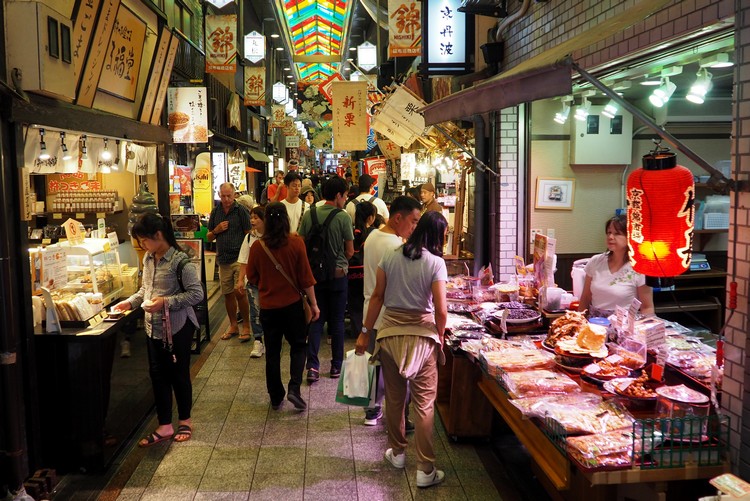
Nishiki Market in Kyoto
Known as Kyoto’s Kitchen , Nishiki Market is a great place to sample food in Japan. It’s a narrow, five block long shopping street that specializes food related items, like fresh seafood, grilled meats, produce, pickled food, dried foods and sushi.
If you’re unsure of what to try in Kyoto, Nishiki Market is a great place to start.
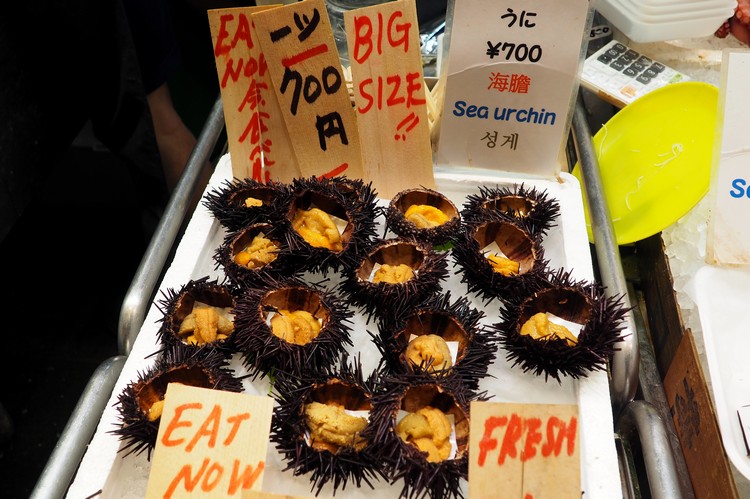
Ready to eat sea urchin at Nishiki Market.
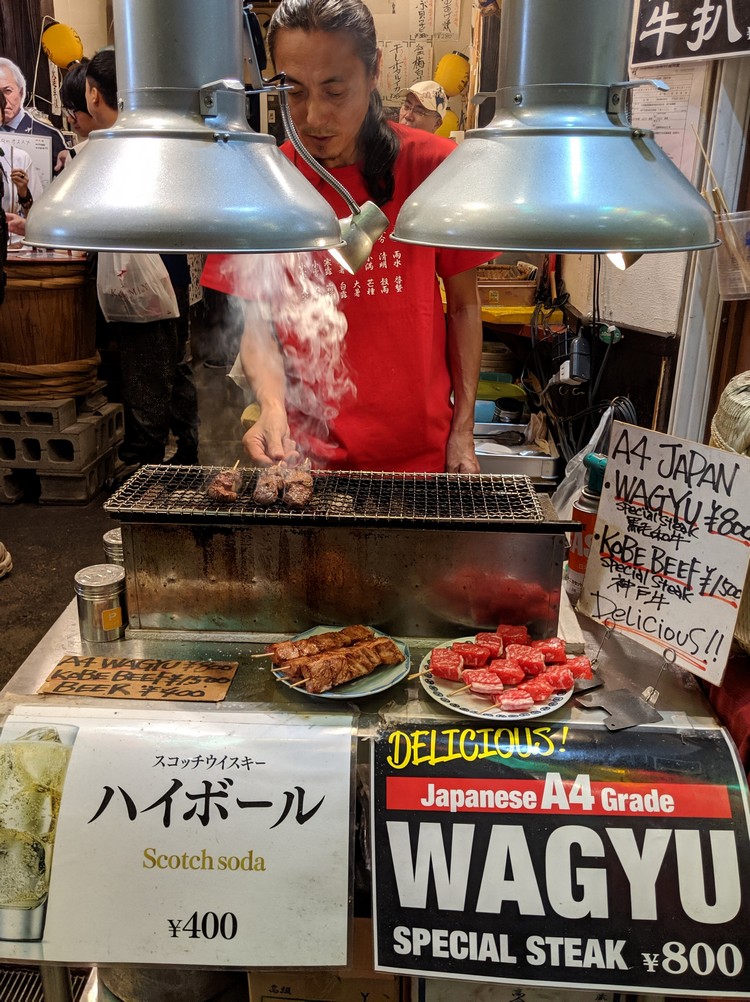
Grilled wagyu beef on a skewer at Nishiki Market in Kyoto.
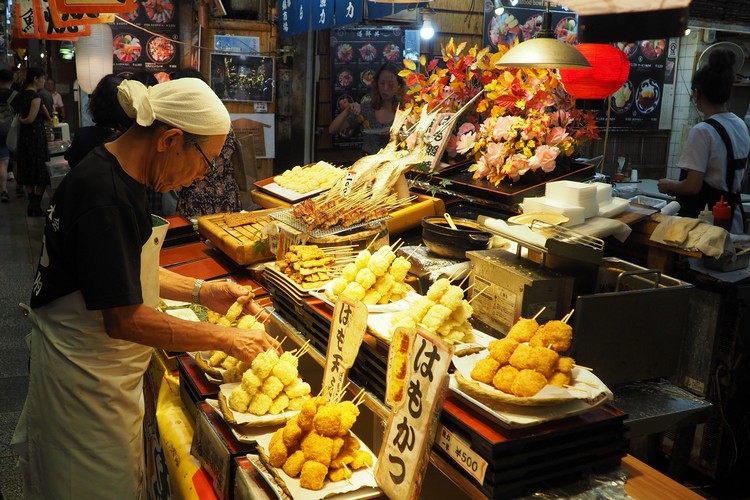
This vendor is selling a variety of steamed and fried food on a stick.
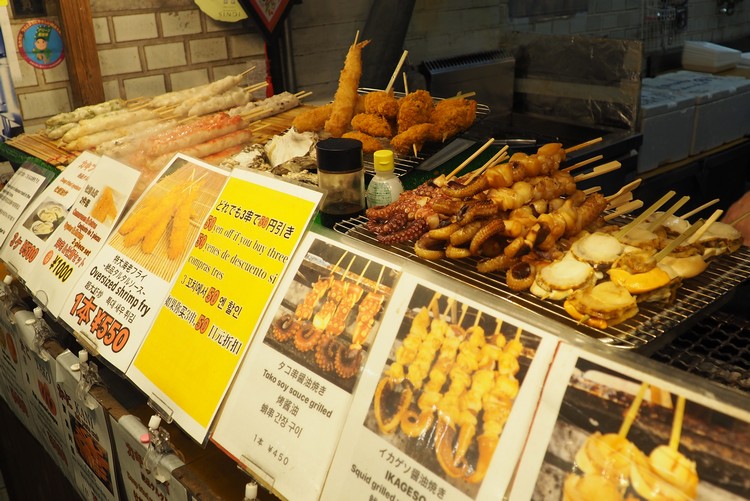
We like visiting small food vendors that sell a wide range of bite size items. It’s quick and easy way to try several different items.
Most vendors at Nishiki Market have English menus, which makes it easy for tourists to understand what they’re ordering. Each item costs between 400-800 yen, which is about $5.00 to $10.00 CAD.
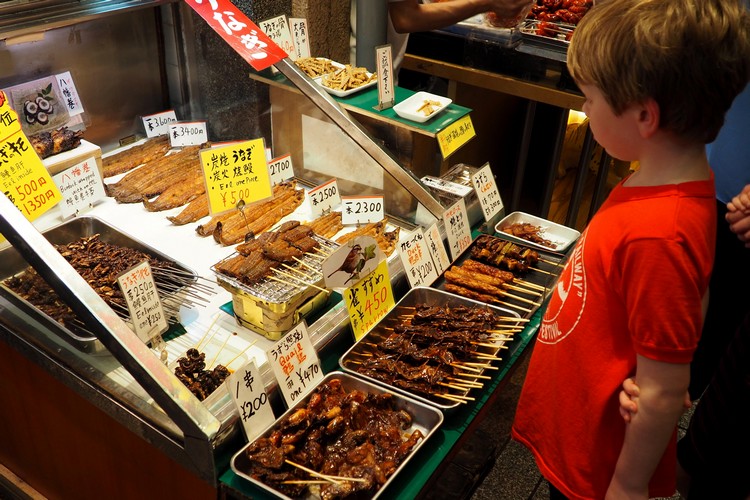
He’s not sure about these interesting food items on display at the market.
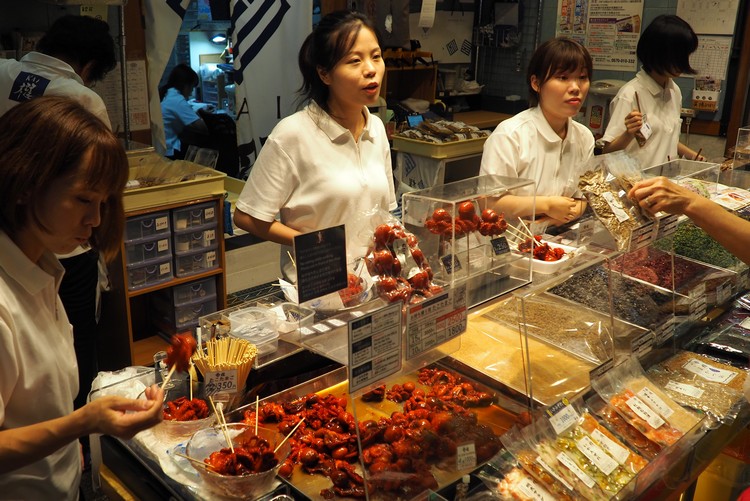
Sweet baby octopus with an egg brain?
One of the most popular and eccentric street food snacks found at Nishiki Market is Tako Tamago, which is a little red octopus on a stick.
The glazed baby octopus have a quail egg stuffed into the head, which makes for a unique flavour combo. The baby octopus has a sweet, candy-like flavour and the egg has a mushy, hard boiled egg texture. It’s quite rubbery and chewy. Not my favourite, but not too bad, either.
It’s certainly one of the more unique foods to eat in Japan, though I’m pretty sure most tourists purchase these little red octopus on a stick for the novelty. Because, let’s be honest, it’s not every day you get to eat an entire octopus on a stick, am I right?
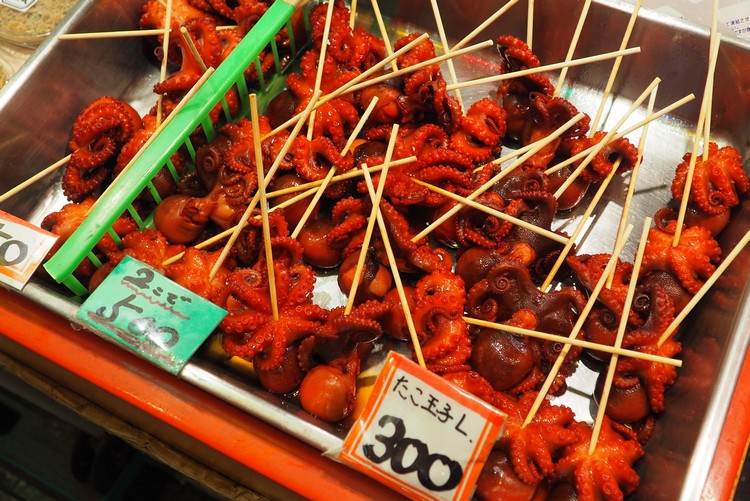
Dozens of vendors sell the popular red octopus on a stick at the popular Kyoto market.
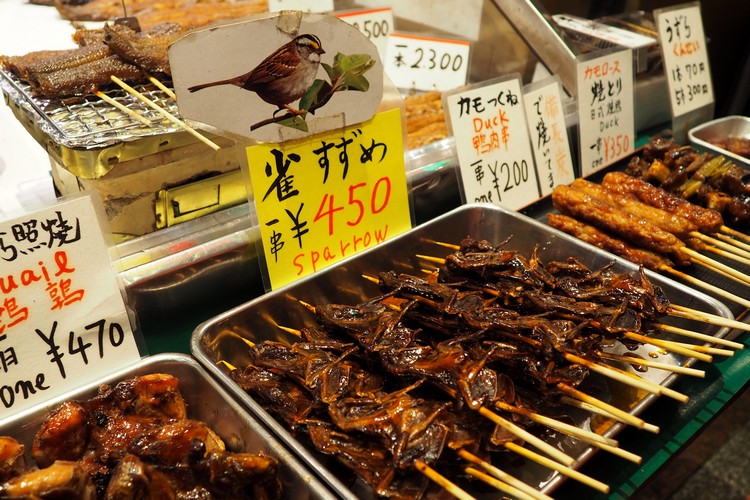
Another strange food in Kyoto is the grilled sparrow bird on a stick.
We’re told that grilled sparrow is a Japanese delicacy, but we couldn’t stomach eating this bat-like bird on a stick.
Have you tried grilled sparrow on a stick? Did you like it? Leave us a comment below.
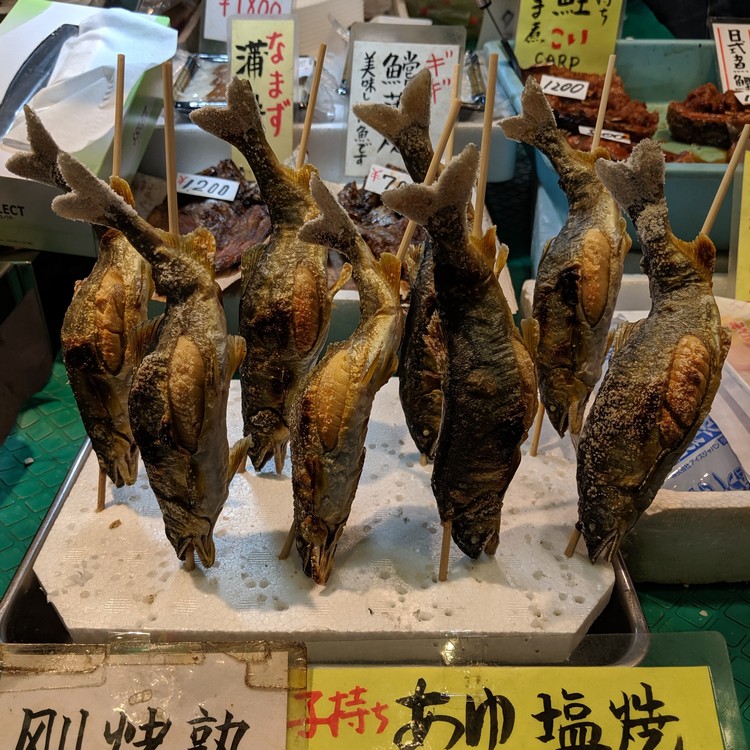
Salted fish on stick? This particular item stood out to us because we don’t often consider eating an entire fish, including the skin, tails, eyes, gills, bones, etc. I’m sure there’s a graceful way to tackle this fish without consuming everything, although I’m not sure this fish stick is for me.
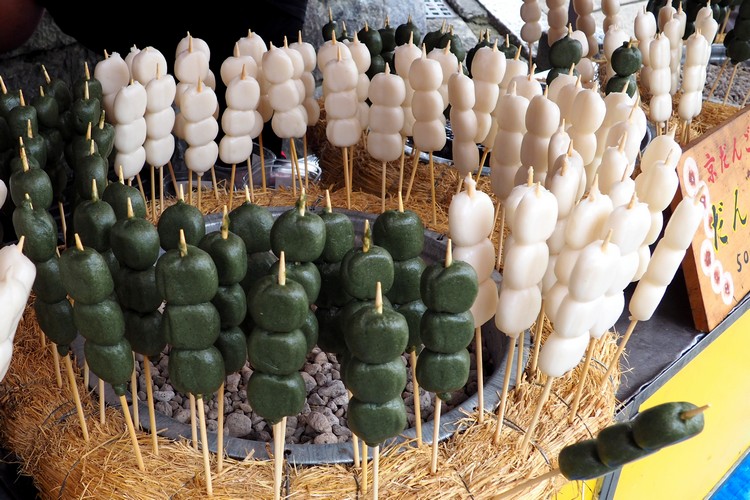
Dango is a popular Japanese sweet dumpling, similar to mochi. It’s typically served on a skewer with 3 balls per skewer. We sampled these green dango skewers near the entrance to Fushimi Inari Shrine in Kyoto.
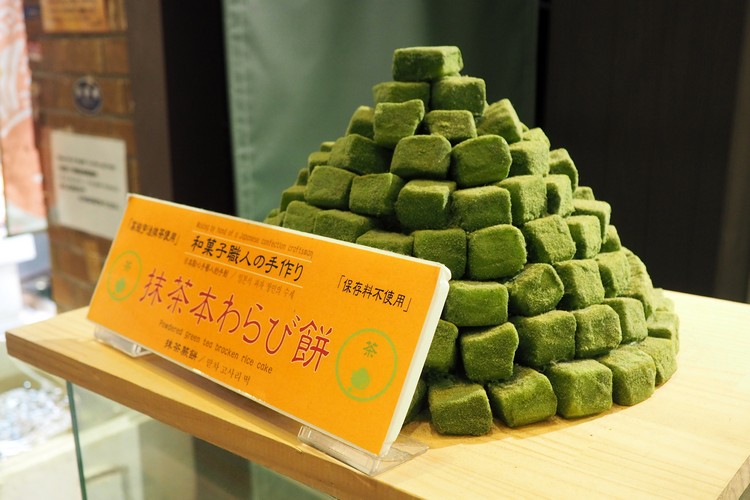
Matcha sweet rice cake on display at Nishiki Market. Matcha green tea is a big part of Japanese cuisine. You will find matcha flavoured everything in Japan, from chocolate bars to potato chips to ice cream.
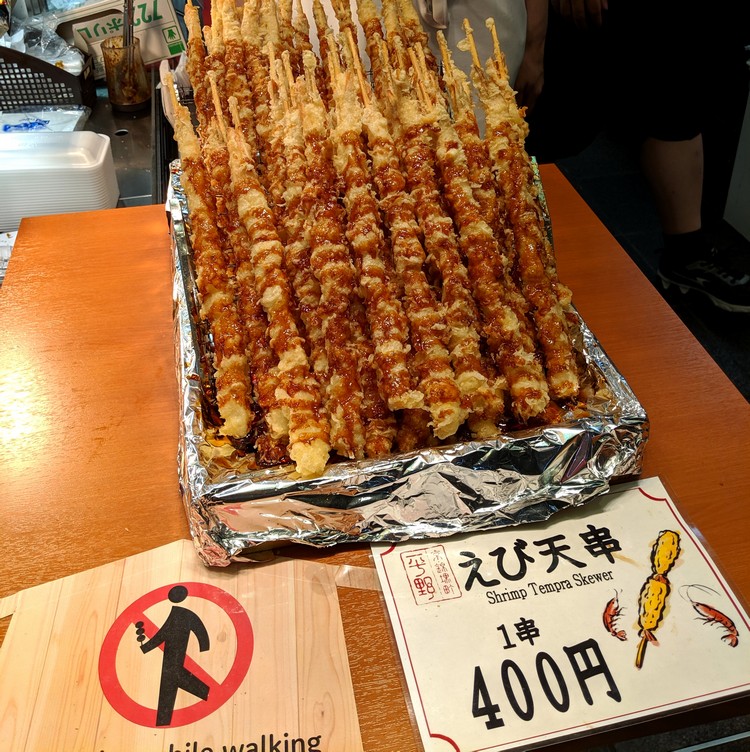
Is it okay to walk and eat in Japan?
Unlike north america, it is considered rude to walk and eat at the same time..
First time visitors to Japan will quickly learn that walking and eating in Japan is frowned upon. If you purchase food from a market or street vendor, the expectation is that you will NOT walk down the street or market while eating your food.
This applies to food purchased at convenient stores, like 7 Eleven and Family Mart. It is acceptable to eat at the place of purchase or close to the store. There’s usually a designated area for eating. If not, you will need to find an acceptable place to eat your food or bring it back to your hotel and eat it there.
Park benches in public spaces are generally okay, but avoid eating messy or strong smelling foods. It is also acceptable to drink while standing beside a vending machine.
Eating and drinking on local trains and public transportation is frowned upon. However, eating food on long distance express trains, like the Shinkansen, is acceptable.
Learn about the Do’s and Don’ts of Japan travel .
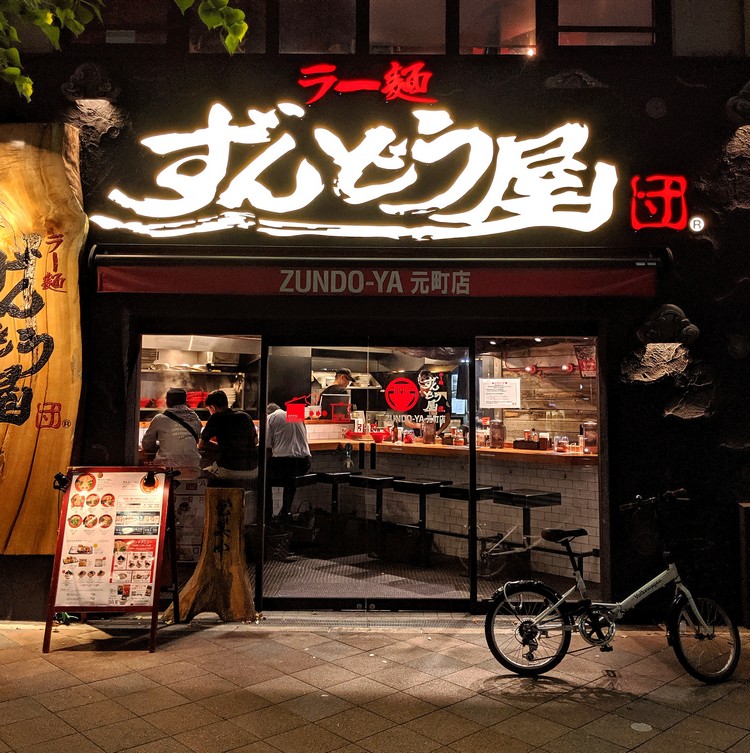
Do NOT tip at restaurants
One of the most common questions for first time visitors is – do you need to tip in Japan?
Tipping is not expected in Japan. In some cases, it’s actually considered to be rude.
This is one of the best Japan travel tips we can give – you do NOT tip in Japan.
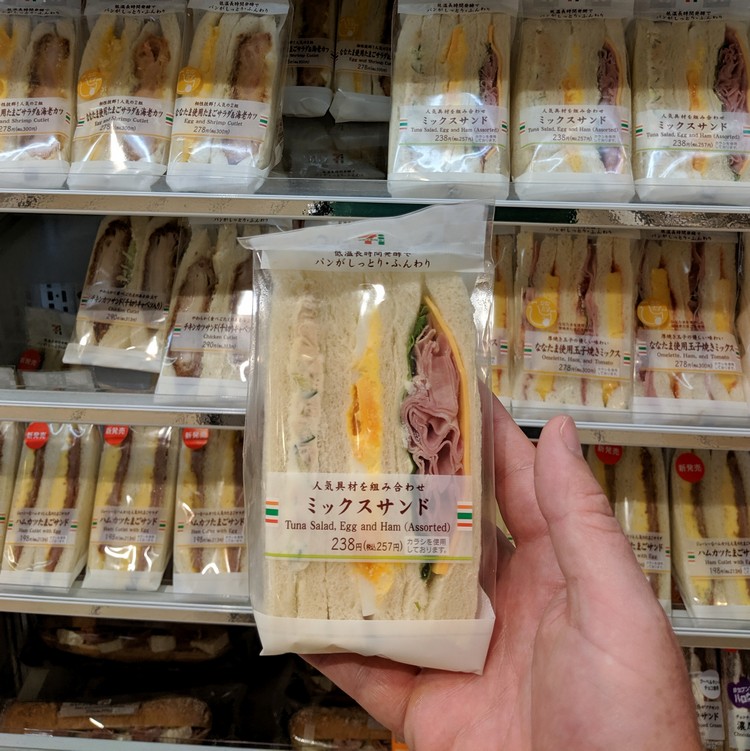
Food from convenience stores in Japan
We rarely eat at convenience stores in Canada, unless we’re on a road trip or there aren’t other food options available. In Japan, eating at convenience stores is quite common.
Japanese convenience stores have a good selection of prepared food, from sandwiches to bento boxes to baked goods. We often grabbed prepackaged sandwiches (picture above) and pastries for breakfast each morning.
One of the most popular snacks to eat in Japan is Onigiri . Onigiri are rice balls formed into triangular or round shapes and wrapped in seaweed (nori). Some are filled with fish (tuna, salmon, mackerel, shrimp, etc), chicken, pork, vegetables, egg and fried food, like tempura and tonkatsu. Onigiri is a cheap Japanese food that’s is easy and widely available at almost every convenience store in Japan.
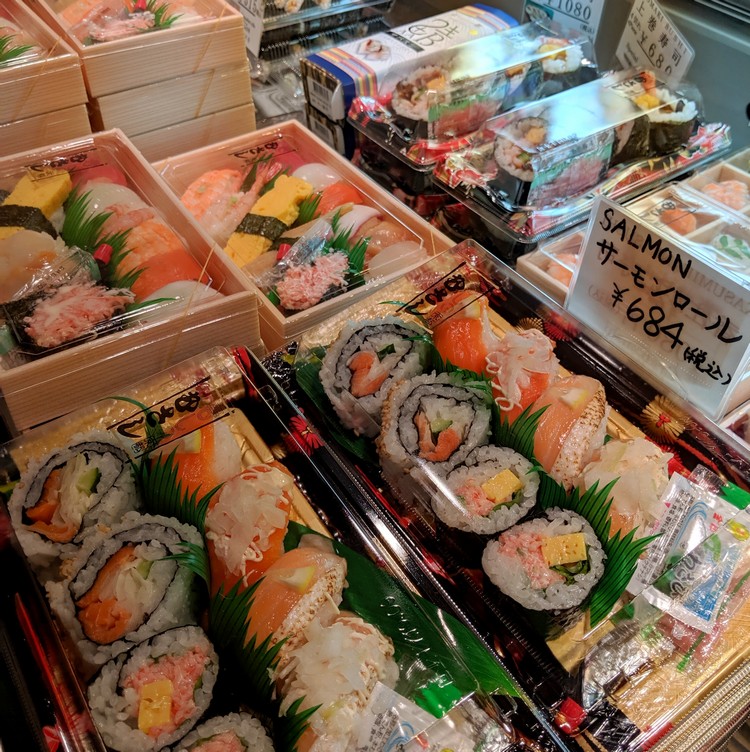
Variety of prepackaged sushi rolls and nigiri combos at the Kyoto train station.
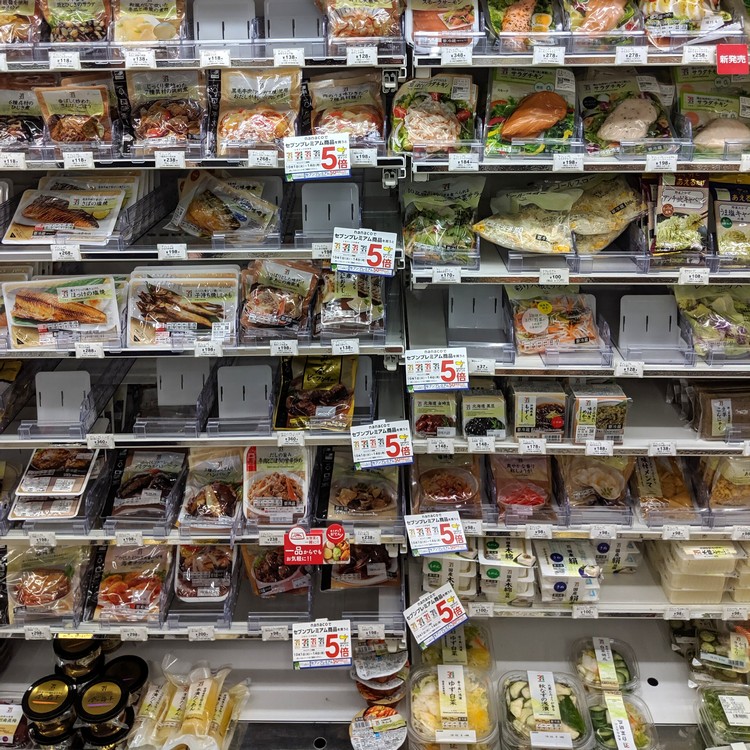
Convenience stores in Japan have plenty of prepackaged meals available for takeaway.
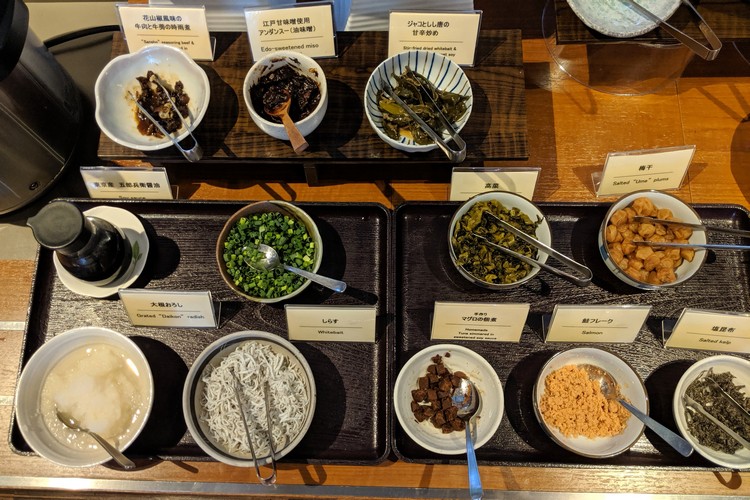
Japanese Breakfast at Hotels
I though it worth mentioning the hotel breakfast situation in Japan, given that many European travellers expect breakfast to be included with the hotel price.
Depending on your hotel, breakfast may be available. But don’t expect breakfast to be included in the hotel room price. Some budget hotels will not have breakfast available at all.
Japanese breakfast is quite different from North American and European breakfast.
Typically, a traditional Japanese breakfast consists of steamed rice, miso soup, grilled fish and a variety of side dishes. You will find a lot of pickled vegetables, garnishes, dried food and other items that you might not associate with breakfast.
This is a great way to sample new flavours and items you might not order at a restaurant. Ask questions and give the Japanese breakfast items a try. You never know, you might just like fermented soy beans (natto) and dried horse mackerel for breakfast?
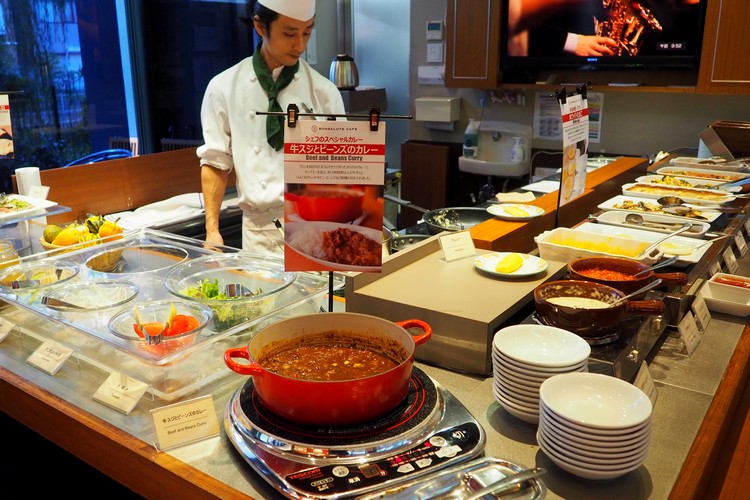
The breakfast buffet at the Hotel Gracery Tamachi in Tokyo.
Order your food from a Vending Machine
One of the things we love about Japan is that everything is efficient and convenient. A perfect example of this efficiency is the electronic vending machines located outside many Japanese restaurants.
The touch screen machines often have photos of each dish, which is convenient and avoids the potential language barrier that may arise if you had to order from a server who does not speak English.
The process is simple. You select the food you want from the touch screen machines, pay with cash or credit card, grab your receipt and head inside. The food is then delivered to your table or your number is called and you pick it up from the counter.
Once you are finished eating your meal, you simply get up and leave. No need to wait for a server to bring the bill or wait to pay. It’s a very efficient system that removes service breakdown.
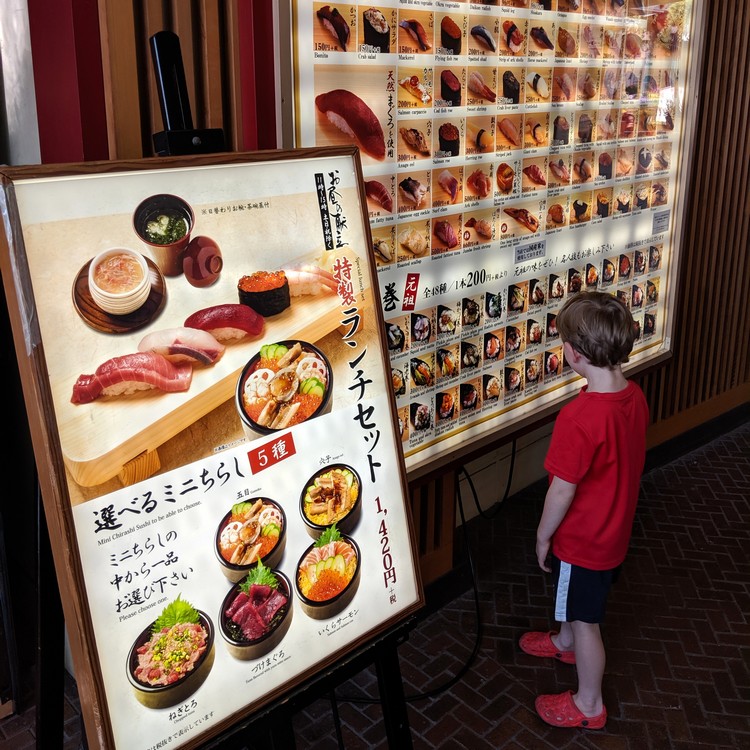
Food in Japan for kids
If you’re travelling to Japan with kids, you’re liking concerned about whether your kids will enjoy the food in Japan. There’s nothing worse than constantly battling your kids to eat.
Our boys like Japanese food, so we knew they would like eating at Japanese restaurants. However, our concern was that after a few days they would get bored and start complaining.
Fortunately, Japanese food is quite diverse and, as you’ve seen in this beginner’s guide to food in Japan, there are plenty of options to choose from.
Travel tips for eating in Japan with kids
- Shop at convenience stores. Pick up prepackaged food, snacks, pastries and drinks from convenience stores and bring them back to your hotel room. You don’t have to dine out for every meal. Give yourself a break if your kids are burnt out.
- Vending machines are everywhere in Japan. Keep some change in your pocket because you’ll find these vending machines do the trick when your kids are thirsty.
- Look at the plastic dishes in the window. Most Japanese restaurants have plastic replicas on display. Let your kids see the available options and pick a dish that interests them before you enter the restaurant. That way there’s no confusion over what to order when you sit down.
- Download Google translate. When you have a Lost in Translation moment, ask the Google for help.
- Eat breakfast in your hotel room. We purchased a bag of Frosted Flakes from a Family Mart and our boys had cereal for breakfast each morning. It saved us time and money.
- Bring snacks from home. Pack your luggage with your kid’s favourite snacks, treats and cereal. Sometimes a familiar treat is all it takes to get your kids feeling normal again.
- There are lots of fast food restaurants in Japan. Sometimes chicken nuggets from McDonald’s is the answer. We get it. Don’t worry, Japan has most of the big names in fast food. It’s okay to give yourself some comfort food from home when you’re travelling.
Read these helpful Japan travel tips for first timers .
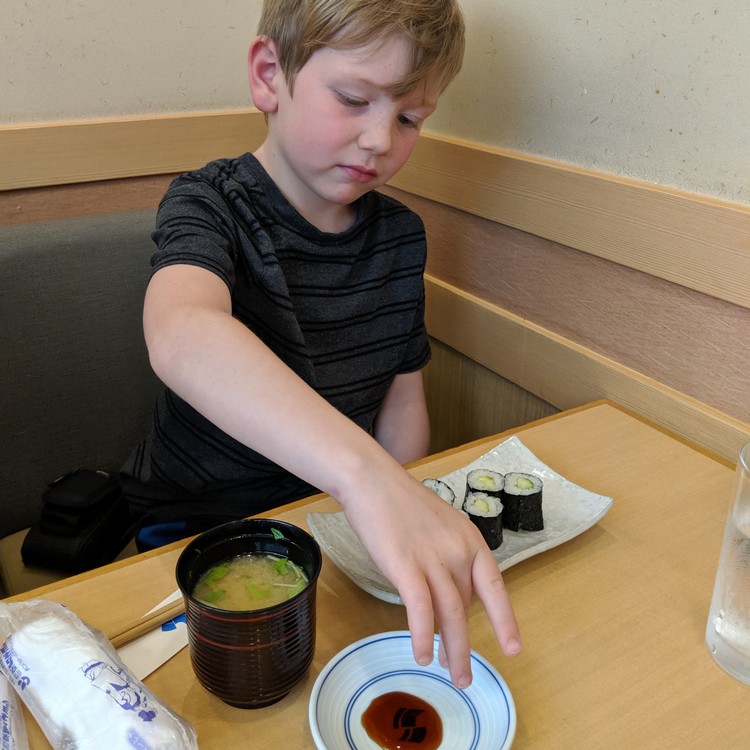
For an easy introduction to sushi, order your kids the cucumber roll (kappa maki) with a miso soup. Let them play with the chopsticks and experiment. If they don’t like the sushi roll, no big deal. These are typically the cheapest items on the menu.
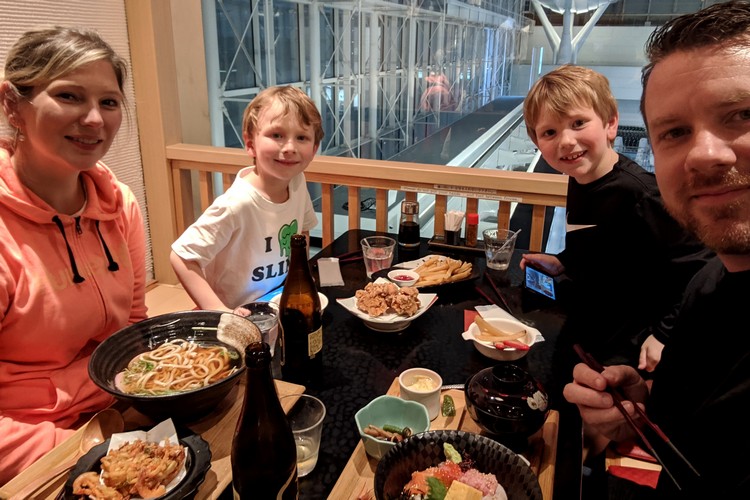
Most Japanese restaurants that serve chicken karaage will also have French fries on the menu. We told our boys that we ordered them chicken nuggets and fries. They rarely noticed the difference.
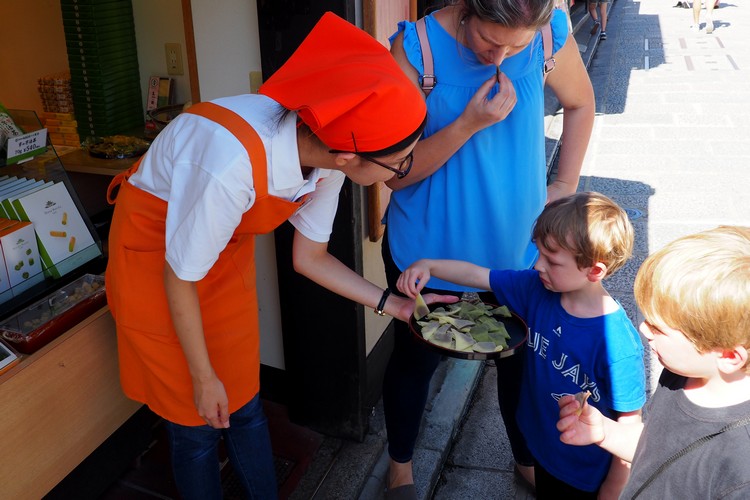
Our boys did pretty good at trying new food. Like most kids, their natural default is to resist food that is different or foreign. However, the more Japanese food they tried, the more comfortable they got.

Don’t worry, if your kids don’t like the food in Japan, there’s always donuts!
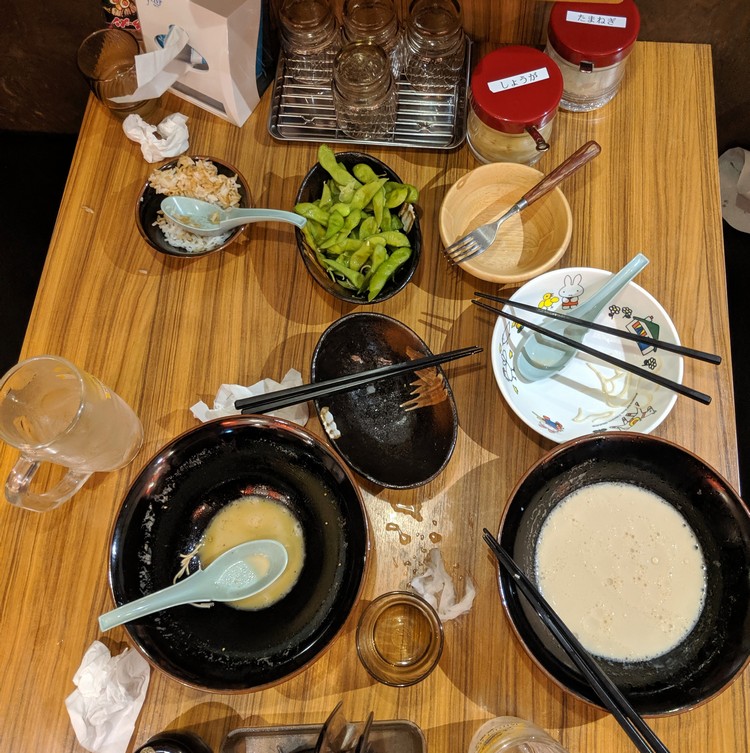
And that’s a wrap! We hope you enjoyed this tasty beginner’s guide to food in Japan.
More blog posts from our trip to Japan:
- How to spend 3 days in Tokyo: Travel guide for first time visitors
- Staying at Tokyo Disney Resort – what you need to know
Have you visited Japan? What is your favourite food in Japan?
Leave a comment below. Our readers thank you!
Related posts:
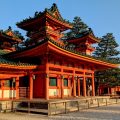
10/20/2020 at 3:33 pm
Very good presentation of food in Japan! Having family in Tokyo we have been traveling around Japan the last 8 years, so I find this post the best about your experience in Japan! It is a pleasure to follow you ,thank you for sharing your travel experiences! You inspired us to go to some places in BC! And it was worth it…We can’t wait to take our grandchildren living in Tokyo to some places where you have been traveled with yours! Wonderful travel blog!
12/21/2020 at 7:14 pm
This is a great intro to Japanese food! Japan is obviously one of the great places to try new things!! And it looks like you and your family tried a lot!! Thanks for sharing and happy #TravelBlogTuesday 🙂
02/19/2021 at 3:31 pm
What a great source and extensive knowledge of food from here. A great read and will certainly be using the post in the future
07/19/2021 at 5:53 am
What a fabulous post about food in Japan! Should be required reading for first-time travellers to Japan. Happy travels.
Leave a Reply Cancel reply
Your email address will not be published. Required fields are marked *
Yes - Subscribe me to your monthly newsletter!
This site uses Akismet to reduce spam. Learn how your comment data is processed .
Tokyo Food Guide
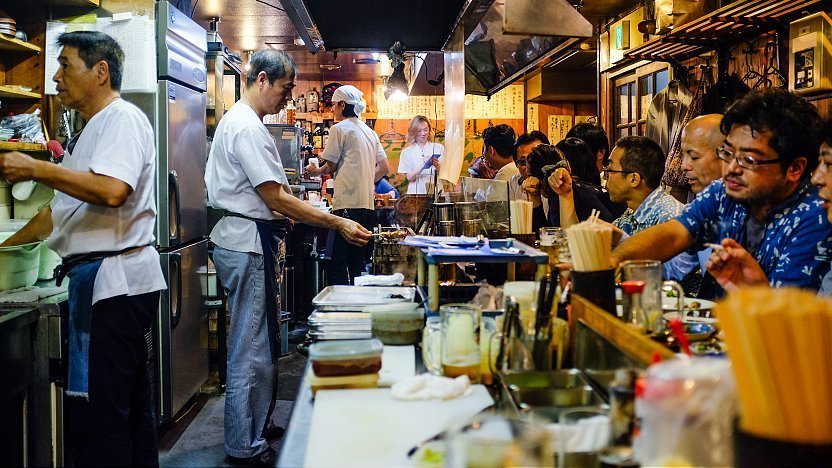
Tokyo is one of the world's most exciting dining destinations. The city features a wide range of both local and regional Japanese cuisine in addition to all types of international fare. Its top restaurants have accrued more Michelin stars than both Paris and New York combined. But good food can be found at every price range from cheap hole-in-the-wall joints to expensive high-class restaurants with every budget in between.
Tokyo specialties
As Japan's political center for over four centuries, Tokyo has naturally exerted great influence on Japanese cuisine . Consequently, some Tokyo specialties have become so popular that they are now known as the standard version of the dish rather than a local specialty. Local creations from Tokyo (formerly called Edo) are often referred to as "Edo-mae", literally meaning "in front of Edo", in reference to Edo Bay (now Tokyo Bay) which provided the city with its local seafood. The following are some popular Tokyo specialties:
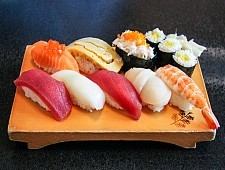
Regional specialties from across Japan
Tokyo is also a good place to enjoy regional Japanese foods from across the country, which have been available in Tokyo since the Edo Period when the regional lords (daimyo) from across Japan were forced to maintain large villas in the capital and spend alternate years there. A by-product of this policy to keep the regional lords under the shogun's control was the influx of various regional cooking styles into the capital.
These days, foods from across the country can be found at many restaurants specialized in regional cuisines. Some of the most popular regional foods that can be sampled around Tokyo come from Okinawa , Kagoshima , Fukuoka , Kyoto and Hokkaido . In addition, successful restaurants from across Japan often open outlets in Tokyo in an effort to branch out and make a name for themselves.

International dining
International food is enjoying great popularity in Tokyo, and many Japanese chefs have achieved recognition for their skills in foreign cooking, often acquired by practical training overseas. Furthermore, Tokyo is home to various international communities, which have brought a variety of different cuisines with them.
While popular foods such as Chinese, Indian, Italian, French and Korean can be found virtually anywhere in the city, there are also a few districts serving less prominent international cuisines especially around the embassies located in the Azabu, Hiroo and Roppongi districts. Below are a few of the more concentrated international districts:
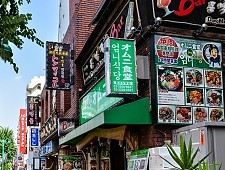
Casual dining
There are lots and lots of casual dining restaurants of all types found across Tokyo. While restaurants are easy to find just about anywhere in the city, good places to go for a large variety of them are around train stations, entertainment districts and the restaurant floors of most department stores , where there is usually a good selection of restaurants ranging from Japanese cuisine to international dining.
Izakaya are the most common type of casual dining establishments and are good places to try a variety of dishes. They can be found in droves around train stations and entertainment districts and serve popular food items such as yakitori , sashimi and of course beer . The following are a few casual dining areas around Tokyo that are well known for their atmosphere:
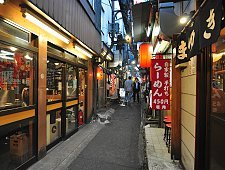
Fine dining
Tokyo is well known for its fine dining and has the highest number of Michelin-starred restaurants of any city in the world. Fine dining restaurants are often found on the top floors of skyscrapers and major hotels , and the cuisine served at these restaurants ranges from traditional Japanese to international and fusion fare. Of course, they tend to be priced accordingly, and some restaurants may require advance reservations. The following are a few districts that are known for their fine dining establishments.
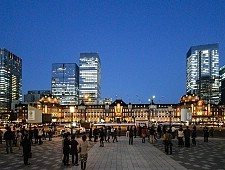
Themed dining
Themed cafes such as maid and butler cafes, as well as pet cafes are popular attractions where you can converse or play games with a maid or butler, or spend time with animals such as cats, rabbits or birds while eating light meals or enjoying a coffee or tea. Maid cafes can easily be found in Akihabara whereas butler cafes are more concentrated around Ikebukuro . Pet cafes can be found in small numbers around the city. All these types of cafes usually charge a small cover charge in addition to food and drinks.
Another type of themed dining are food theme parks which typically feature different variations of a specific food such as ramen or gyoza . Despite the name, food theme parks are usually indoors and work similarly to a food court except that all the vendors are selling variations and regional types of the same dish. Some food theme parks around Tokyo include the Namja Gyoza Stadium in Ikebukuro and a ramen theme park in Aquacity on Odaiba .
Those looking for a quirky and entertaining meal, themed restaurants like the Ninja Restaurant can be a fun and appealing attraction. Themed restaurants are decorated similarly to amusement parks, have themed menus and staff dressed in costume. The food usually follows the overall theme, and there may be some type of performance during the meal.
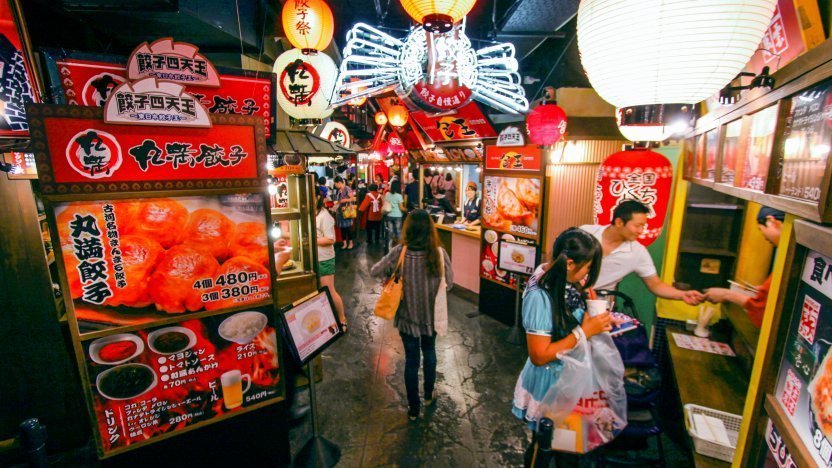
Japanese-style breakfast
The easiest place to try a Japanese-style breakfast are hotels , many of which offer Japanese breakfast set meals or buffets with both Japanese and Western dishes. Otherwise a Japanese-style breakfast is difficult to find as most restaurants and coffee shops tend to serve Western-style breakfasts or coffee and toast sets only. One option may be gyudon restaurants which often offer basic Japanese breakfast sets at cheap prices.
For the more adventurous, the sushi restaurants in the Tsukiji Outer Market and at Toyosu Market are open from early morning, offering fresh sushi for breakfast. Note that many of these restaurants close by mid-afternoon.
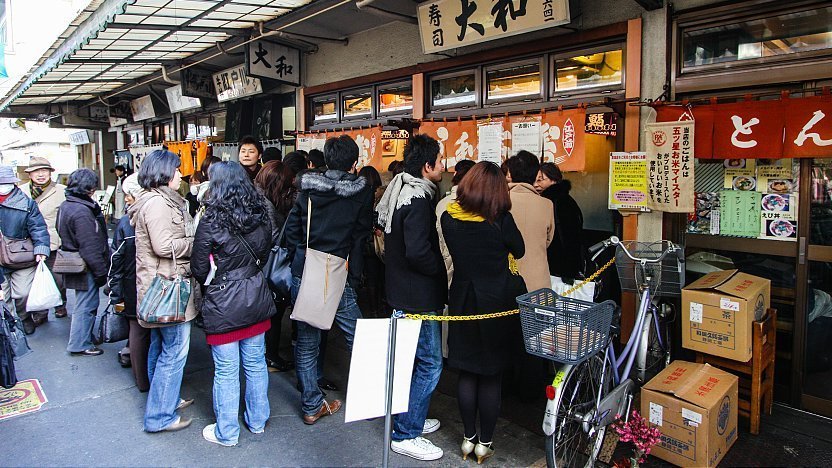
Questions? Ask in our forum .
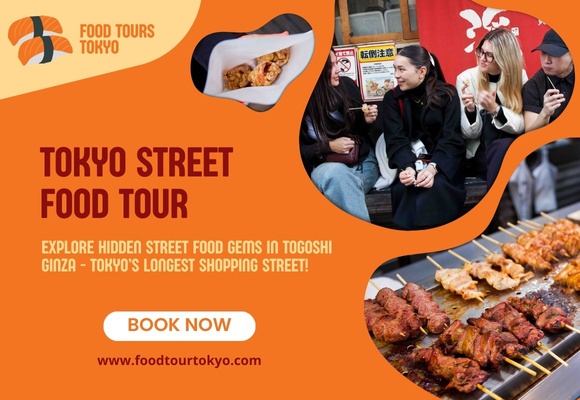
Hotels around Tokyo
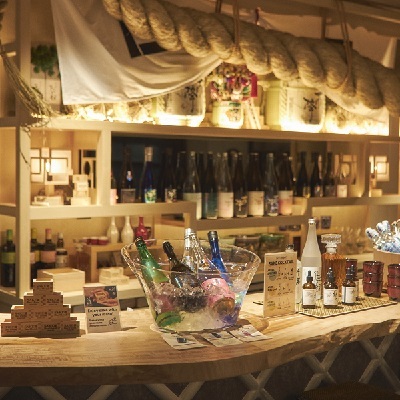
Experiences around Tokyo


- Destinations
- Travel Guides
- For The Home
- Privacy Policy
Japan , Travel Guides
Food focused two week japan itinerary – 14 days of eating well.
We’ve taken several trips to Japan over the last decade, each time staying a bit longer and exploring a bit more than the last. I know many travelers don’t have the same flexibility in their schedules as we do. If you have the opportunity to spend two weeks in Japan, though, we want to ensure you eat well and drink well. Because Japan is one of the top culinary travel destinations in the world. In this post, I share our tips on how to plan a trip to Japan with a 14 day itinerary.
*This post contains compensated links. Find more info in my DISCLAIMER . As an Amazon Associate, I earn from qualifying purchases.
A 14 Day Trip To Japan For People Who Travel For Food
Most itineraries focus on the top Japan destinations, including Tokyo and Kyoto. There is always a focus on the “top things to see” and always includes plenty of visits to museums and temples. We include some of those activities in this guide.
But our real focus in this Japan travel blog is to focus on unique food experiences, those experiences that make Japan unique. This includes food tours , sake tastings, and plenty of recommendations on where and what to eat in Japan.
Another way this itinerary is different from others is that it goes beyond Tokyo and Kansai, which includes Kyoto and Osaka. Sure we include those cities as well. But our suggestions go a little bit beyond for a more authentic experience in Japan.
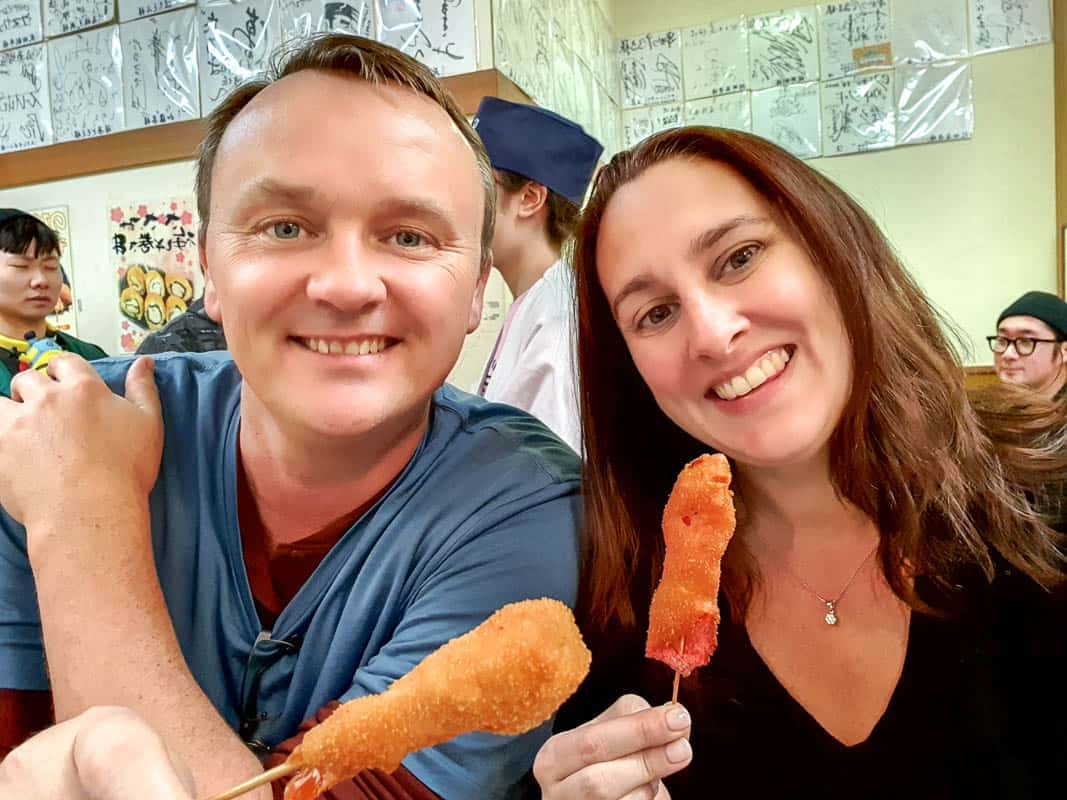
Only Have A Week In Japan? Check Out Our 7 Day Japan Itinerary
Help With Planning Your Japan Two Week Itinerary
Luggage : We used our Eagle Creek Load Warrior luggage for this trip. I always recommend packing light and if using the trains in Japan this is particularly important. Escalators and elevators are not readily available. And, most hotel rooms in Japan are pretty small. It can be hard to find space for large luggage! Even for a 2 week trip in Japan, it is possible to do laundry at least once or twice during your trip so it’s possible to pack light.
Rental cars : If you decide to rent a car in Japan, we recommend RentalCars.com . They compare prices at the top rental car companies to get you the best deal.
Rail Passes : Train travel is really efficient in Japan, particularly between our recommended cities. Check out the 14 Day Japan Rail Pass to help get you around. A rail pass must be purchased ahead of time before your arrival in Japan and is best purchased from Japan Rail Pass.
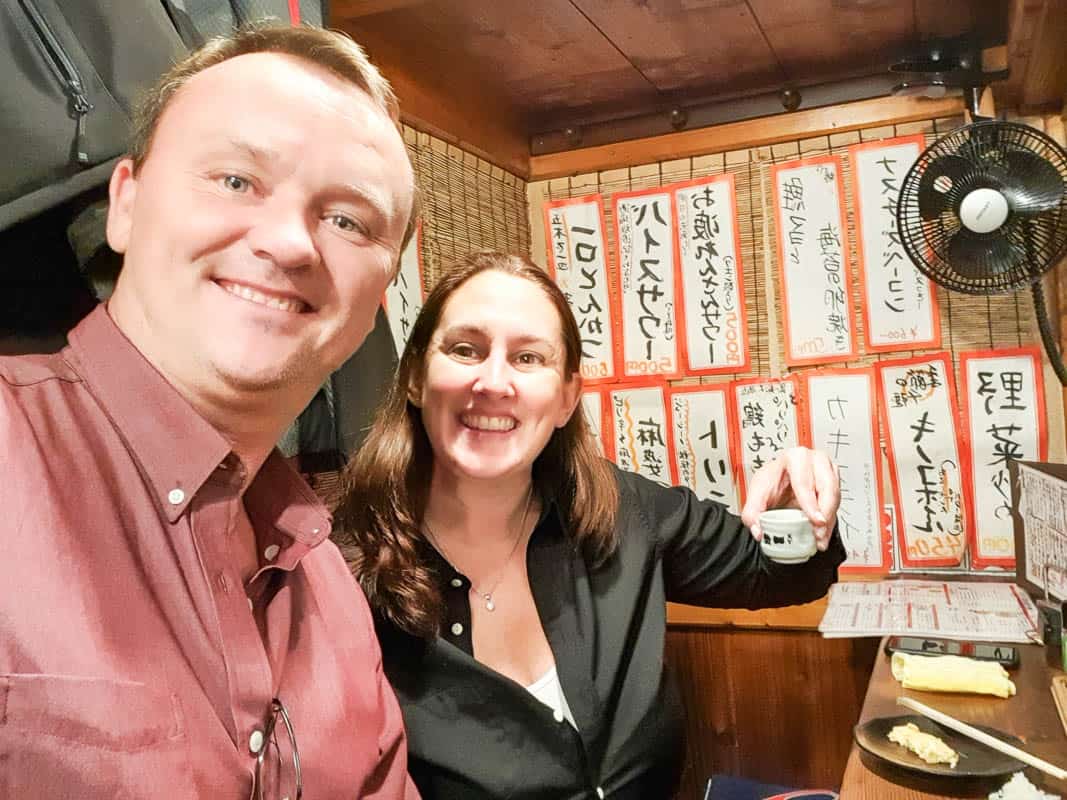
Eating at an izakaya in Kyoto
Best Japan Destinations For Food Travelers
Tokyo – Many travelers arrive or depart from Tokyo so it’s understandably on everyone’s itinerary. It’s a big city, with bright lights, and Japan to the extreme.
Osaka – The destination for food travelers in Japan. Known as Japan’s kitchen, Osaka is known for “kuidaore,” which essentially translates to eat until you drop or eat until you bankrupt yourself. This is why it’s one of our favorite cities.
Kyoto – The city of culture and temples, Kyoto is also one of the top sake producing regions in the country.
Wakayama – Just south of Osaka and Kyoto, Wakayama is often overlooked by travelers. It’s an easy addition to any Japan trip itinerary. It’s a destination with a focus on fresh fish and seafood, ramen, and Buddhist Monastery lodgings.
Kobe – The home of world-famous Kobe beef and easily visited as a day trip from Osaka or Kyoto.
Sapporo – The great white north of Japan and the city that is one of the snowiest in the world. It’s also home to its own unique cuisine unlike elsewhere in Japan.
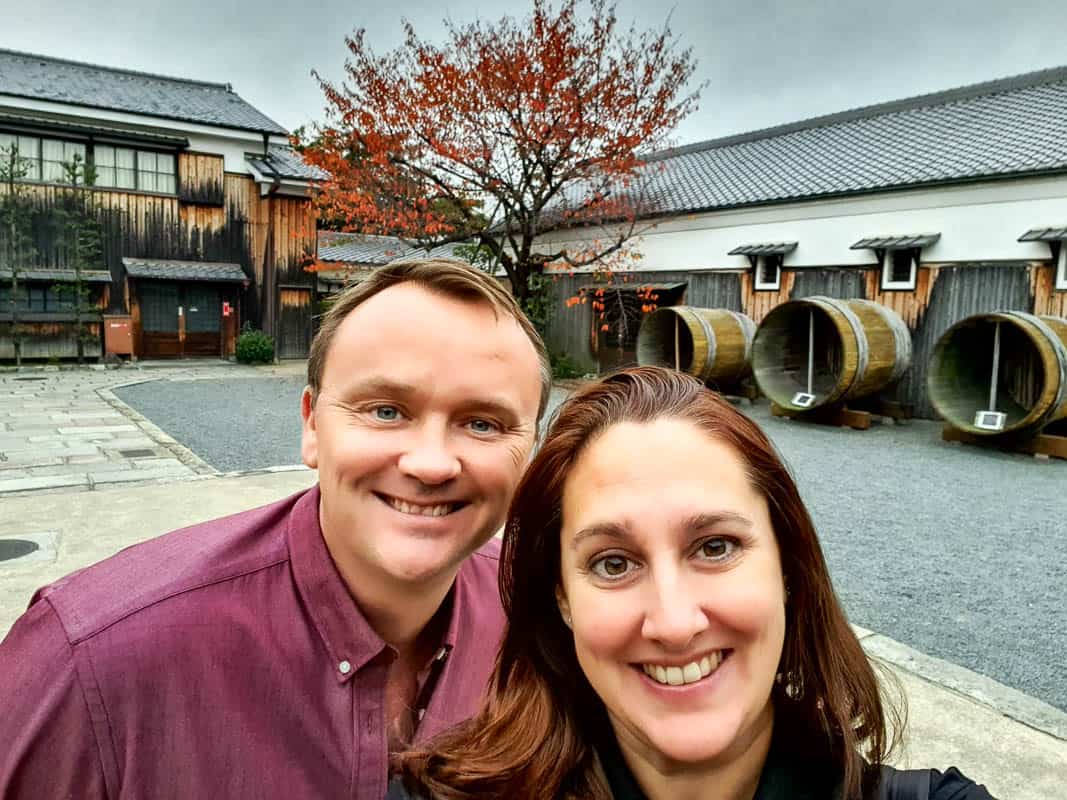
Visiting a sake brewery in Kyoto
Guided Tours Of Japan
We will provide tips on how to plan your own Japan 2 week itinerary, but I understand that Japan can be difficult to manage on your own. We have some recommendations for guided tours that included between 12 and 14 day itineraries.
Intrepid Travel offers a 12 day Real Food Adventure In Japan . It hits some of our favorite food cities in the Kansai region of Japan. That includes Osaka, Kyoto, and Kyosan in Wakayama. Along the way, travelers learn to make sushi , eat street food, and stay the night in a Buddhist monastery. These are all food experiences we’ve had in Japan and would totally recommend. We took an Intrepid Real Food Adventure in Morocco and learned a lot about the food culture. Learn more about Intrepid’s Japan tour .
As an alternative, G Adventures offers a small group tour for 14 days in Japan that departs from and returns to Tokyo. The Discover Japan Tour visits Tokyo, Kyoto, Hiroshima, and other interesting cities. There is more of a focus on culture and history than the Intrepid Tour but includes interesting food experiences. This includes visiting a sake brewery and dining in kaiseki cuisine in Kyoto. Learn more about the G Adventures Discover Japan Tour .

Eating ramen in Sapporo in Winter
Tips For Traveling to Japan For The First Time
Planning a trip to Japan for the first time can be entirely intimidating. That’s why booking a group tour can help. But, there are ways to plan an independent journey as well. We have a few key tips for first-timers to help make things easier.
Picture Menus Are Your Friend
When it comes to selecting restaurants in most touristy cities, we always recommend avoiding places with picture menus. This advice goes out the door in Japan. Many restaurants have picture menus, for both travelers and locals. The picture menus are your friend.
Almost every place we ate in Japan included picture menus with English descriptions. A few did not. Where they didn’t we relied on Google Translate to take pictures of the menu or to do an instant translation. But, this only works when you are online.
Japan Travel Guide Pro Tip
We use KeepGo for international data. It’s an international sim card that works in over 120 countries without setting up service in each country you visit. It doesn’t make a difference what kind of mobile service you have at home. You just register the sim before leaving home. It works on arrival in Japan. We had 4G access in Japan with KeepGo .
Japan Is A Cash-Based Society
Cash is still king in Japan. We were able to charge some meals, but most of the time we paid cash. This is particularly true in smaller places. We used ATMs to withdraw cash as we went. ATMs are not as easily found as in other cities. Look for them in the convenience stores like 7-11, Lawson, or Family Mart.
Don’t Try To Fit Too Much Into Your Itinerary
Imagine someone trying to see all of the US in a two week trip, impossible, right? Japan may be a smaller country, but there is so much to see and do. Even within a single city, there are loads of great activities, neighborhoods to explore, and food to eat. Don’t rush it and don’t try to cram everything into a short amount of time.
Our recommendations in this post make a great first time in Japan itinerary. In two weeks you can experience a lot of Japan, but I wouldn’t recommend visiting more than 4 cities. The movement in between, even with high speed trains, can be exhausting.
Also, consider basing yourself in a city like Osaka and taking day trips to Kyoto, Koyasan, Nara, and Kobe, to see a lot without the constant checking-in and checking-out of hotels and packing and repacking. You can access each of these cities in less than an hour from Osaka.

Visiting Temples In Wakayama
Food And Drink Experiences In Japan
There are loads of interesting and unique things to do in Japan. Some of these experiences relate to food and drink and others focus on culture and history. This is a great place to start your own Japan trip planner for how to spend 2 weeks in Japan.
- Visit a Robot Restaurant in Tokyo for one of the most unique dining experiences in the world
- Exploring traditional local markets including Kuromon in Osaka and Nishiki Market in Kyoto
- Tracking down the top street food in Dotonbori , Osaka’s food street
- Book a food tour in Osaka or a Kyoto cooking class to learn more about Japanese food culture on a half-day or full-day tour
- Eat some of the best Japanese sushi of your life, by visiting a conveyor belt sushi restaurant or a traditional sushi-ya
- Track down the best bowl of ramen in one of the official or unofficial ramen streets.
- Go Japanese craft beer bar hopping and learn about Japanese craft beer trends
- Enjoy a kaiseki meal at a traditional Japanese ryokan
- Spend the night at a Buddhist monastery and learn about shojin ryori, Buddhist vegetarian cuisine
- Eat some of the best beef in the world – Kobe beef
- Tour a Japanese sake brewery and learn how to order sake
- Spend the evening at an izakaya, a Japanese tavern, toasting over local beer and whiskey highballs
- Dine on Japanese giant crab and local seafood in the great white north of Japan
- Tour the famous Sapporo Brewery and dine on Genghis Khan

Eating sushi at a market in Osaka
How To Spend 14 Days In Japan When You Love Food
If planning your own self-guided tour of Japan, here are our recommended destinations. With a full two weeks in Japan, you can see a lot. There are two primary options here. We recommend about a half dozen cities to visit. It’s possible to visit each of them, spending approximately two nights in each.
Or, I would recommend staying in only about three cities and doing day trips. For example, you can stay in Tokyo, Osaka, and Sapporo and manage to have all of the experiences mentioned in this post over two weeks.
For each city, I recommend some of the top attractions or experiences, with a focus on food and drink. I also provide recommendations on what and where to eat and some recommended hotels. There are also links to some of our other posts for more information on some of these activities and travel tips.

Day 1-3 Tokyo
Most people start or end their trip to Japan in Tokyo. We prefer the smaller cities for more unique experiences and recommend spending more time there. At least give yourself enough time in Tokyo to beat the jet lag .
Top Attractions In Tokyo
Definitely check out the Shibuya district, one of the most iconic neighborhoods in Tokyo. If you’ve seen photos of Tokyo with loads of people crossing at a major intersection with neon lights and skyscrapers in the background – that’s Shibuya. It’s supposedly the busiest pedestrian crosswalk in the world. Stop for a katsu curry at Katsuya or hit one of the ramen or soba shops.
At night, head to the Shinjuku district, perhaps for a little karaoke and nightlife. Shinjuku is where the neon lights explode at night. There’s theater, food, bars, and plenty of people watching.
There are also two well-known bar and restaurant alleys in Shinjuku that are must-visits: Golden Gai and Memory Lane. It’s almost like stepping back in time considering much of Tokyo is covered in high-rises. Within this area is also Harajuku. This is where young people like to show off their fashion and old people like me are left to wonder why.
For a bit of culture, visit the Imperia l Palace or at least wander the gardens. Or, check out the art museums and galleries in the Roppongi neighborhood. This is also where the Tokyo Tower can provide you with a birds-eye view of the city.
Tours And Tickets For Tokyo
There are a few tours and attractions that we recommend booking ahead of time. Grab tickets for the Tokyo Robot Restaurant , one of the most popular and unique attractions in Tokyo. To make the most of your time in Tokyo, book a food tour. This Japanese Food And Drink Tour includes a tour of the world-famous Tsukiji Fish Market.
Where To Eat In Tokyo
In Golden Gai and Memory Lane sniff out late-night ramen and plenty of yakitori bars. In addition to Golden Gai and Memory Lane, there are a few other areas where you are guaranteed to eat well in Tokyo. Be sure to add a visit to Ginza for Michelin Star dining, including some of the most famous sushi restaurants in the world. Look for monjayaki in the Tsukishima district for Tokyo’s answer to okonomiyaki.
Where To Stay In Tokyo
We stayed at the Sheraton Miyako during our visit to Tokyo, but there are other options as well depending on your budget.
Park Hyatt Tokyo : One of the most luxurious hotels in the city and known for its role in the movie Lost in Translation. Check for rates here .
Pullman Tokyo Tamachi : A contemporary option in the center of Tokyo with a sun terrace. Check for rates here .
Nine Hours Shinjuku : On more of a budget, or looking for a uniquely Japanese experience, this capsule hotel is the perfect option. It’s also in the nightlife center of the city. Check for rates here .

Day 4-5 Osaka
I’m amazed to see how many sample Japan two week itineraries skip Osaka altogether. Sure, it doesn’t have the same concentration of temples and palaces as Tokyo or Kyoto, but you can only see so many temples on a trip before you get “templed out.”
Osaka is one of the best cities to visit if you love food and drink! From Tokyo, use the JR Rail Pass to hop the Shinkansen high-speed train to Osaka, Japan’s kitchen.
Top Attractions In Osaka
All of the top main attractions in Osaka are located within the city center and are accessible by train. Take a walk through the gardens of Osaka Castle or catch the view from a boat tour of the Dotonbori Canal. Explore Kuromon Market for street eats and hit Dotonbori, Osaka’s famous food street at night. At night, just wander through one of the many shopping and eating districts, including Namba, and Shinsaibashi.
Tours And Tickets For Osaka
If you want to make the most of your time in Osaka and want to experience all the main sights, pick up the Osaka Amazing Pass. It offers free admission to loads of different sites including Osaka Castle, plus offers unlimited train and bus rides as well.
Osaka is also the perfect place to take a food tour or cooking class. See our recommendations for the Best Food Tours In Osaka .
Or book tickets for Gotta. Gotta is pure Japanese-style entertainment. It’s a Japanese musical review show, which tells the story of the Dotonbori area through food and legend. Buy tickets ahead of time here . They offer three shows a day, with the last show being at 3:00 pm. The show is only 40 minutes, so it’s not a big time commitment. It’s just something quirky and unique to do in Dotonbori.
Where And What To Eat In Osaka
Between traditional Japanese dishes and Osakan specialties, there is no shortage of foods to eat in Osaka. From street food to craft beer, the city has it all. One of our favorite things to do in Osaka is to visit Daruma for kushikatsu, which is fried stuff on a stick.
Start any day eating in Dotonbori, near the canal. Then head north down the Shinsaibashi shopping street. At the top, in the Chuo Ward and near the Honmachi subway station, there are loads of great, non-touristy restaurants. On another night, head south from Dotonbori into the Namba area for plenty of standing bars and yakitori spots.
Check out these posts for more details and where and what to eat and drink in Osaka.
Osaka Food Guide – What To Eat In Osaka Japan
Dotonbori Food Guide – 15+ Must-Eat Dishes In Dotonbori Osaka
Osaka Craft Beer Guide – Drinking The Best Craft Beer In Osaka
Where To Stay In Osaka
When we visit Osaka we tend to stay a while and normally rent an Airbnb apartment. We’ve also stayed at the Sheraton Miyako . Here are some other recommended hotels in Osaka. If short on time, we recommend staying near Namba or in an adjacent neighborhood so that you are centrally located to all of the best foods.
Swissotel Nankai Osaka : Luxury, 5-star hotel, with views over the city. It’s located above the Namba station making it super convenient. Check current rates here .
Hotel Nikko Osaka : The Hotel Nikko is located in the Shinsaibashi shopping area and near the pedestrian shopping arcade that leads to Dotonbori. We’ve stayed near this neighborhood before and there are some great bars and restaurants nearby. Check current rates here .
Hotel Ichiei : For a more ryokan style experience, Hotel Ichiei is also near Namba Station and offers tatami style rooms. Check current rates here .
How Many Days In Osaka – Pro Tip
This is a question we often get. For any of our recommended Japan destinations, it’s up to you how much time you spend in each city. People often overlook Osaka, though, in favor of Kyoto. Kyoto is famous for its temples. Osaka is famous for its food and nightlife. We recommend spending more time in Osaka than in Kyoto if you love eating. Or, base yourself in Osaka for five or seven nights and visit Kyoto, Kobe, and even Nara from there. See the sites but enjoy the Osaka nightlife .
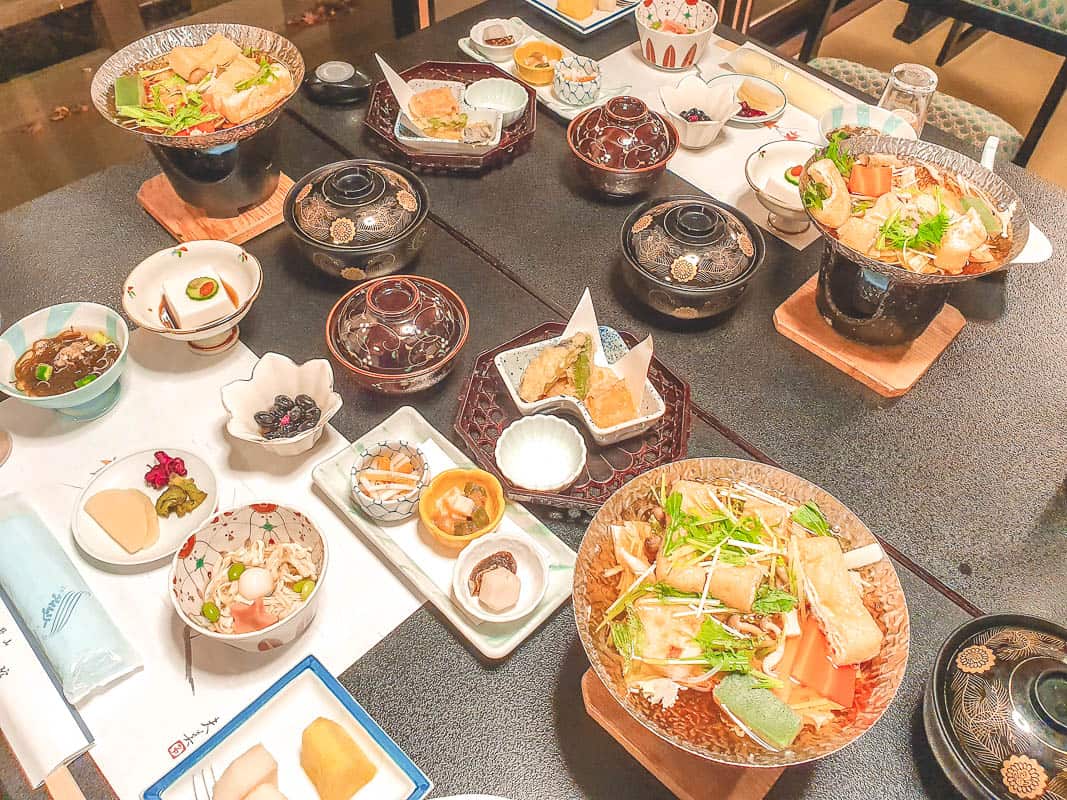
Day 6 Koyasan, Wakayama
If you can fit an overnight into your 14 day itinerary that will offer a totally unique experience, this is it. The Kii Peninsula in Kansai includes Kyoto, Osaka, and Wakayama.
Across the Peninsula are a series of Sacred Sites and Pilgrimage Routes, much like the Camino de Santiago in Spain. UNESCO recognized the region as a World Heritage Site. This makes Wakayama a perfect spot to spend the day hiking or exploring temples.
Wakayama is also a great destination for food travelers too. Koyosan is the center of Buddhism in Japan and is located within Wakayama. There are over 100 temples in Koyasan, about half of which provide temple lodging. One of the most interesting food experiences includes staying at a temple lodge in order to try their famous Buddhist Vegetarian Cuisine, known as Shojin Ryori.
Planning A Trip To Koyasan
You can train from either Osaka or Kyoto to Koyasan using the Japan Rail Pass. Once there, spend the afternoon exploring some of the famous temples. Also, take a walk through Okunoin, a famous Buddhis Cemetery. There are over 200,000 gravestones. It’s a beautiful and peaceful place to explore. (Please don’t take photos within the cemetery). There are a handful of restaurants that are known for vegetarian cuisine, which was even enough to fill Eric’s belly.
Spending The Night In Koyasan
Spending a night in the Mount Koya area is almost like an all-inclusive stay. Book at one of the temple lodgings. These are mostly simple places to stay for the night, normally with tatami-style rooms with futons on the ground. A shojin ryori vegetarian dinner is included. They do serve beer and sake, but we used it as a night to detox.
After dinner, head back to the temples to see them lit up at night. It’s quite peaceful. Then, it is time for bathing. Some of the temple lodges have private, western-style bathrooms. Others offer traditional Japanese bathing, which is sex separated, public, and nude. That alone is an experience.
It’s an early-to-bed experience. There is the option of observing a dawn ritual where the monks offer a service to practicing Buddhists. We stayed in a traditional lodge where we were the only foreigners. The entire proceeding was in a combination of Japanese and Sanskrit. As much as we didn’t understand a word, observing was fascinating.
Where To Stay In Koyasan
We recommend Jokiin , which offers all of the above experiences. They have a traditional Japanese public bath, but also offer some rooms with a private bath. All rooms are tatami-style, with futons on the floor. Book here .

Day 7-8 Kobe
Kobe City is located in the west end of central Japan. It’s a port town and hosts the 6th largest population in Japan. What most people know about Kobe is its namesake beef. It is also one of the top sake producers in the country as well. This makes it an interesting city to add to your two week itinerary.
Top Attractions In Kobe
Did you know that the Nada-Gogo, or the Five Regions of Nada, produces one-quarter of the sake in Japan. The Nada region includes Kobe, which makes Kobe the perfect place to learn about sake. They started producing sake in Nada over seven centuries ago. Try visiting the Kobe Shu-Shin-Kan Brewery, which is on the train line between Osaka and Kobe.
What To Eat In Kobe
Kobe beef is unique to Japan. The beef comes from a particular breed of cattle called Tajima-gyu. The cattle must be born and raised in the Hyogo Prefecture to be considered Kobe beef.
Eating Kobe beef in Japan is a bit of a ritual. Normally you sit at a counter and order the beef by weight and variety. The chef will often show it to you, sort of for approval, but really so that you can look and confirm the quality. The beef is cooked on a flat top grill, to rare or medium rare temperature. Organize your Kobe experience ahead of time, whether you stay in Kobe or visit as a day trip. Learn more here .
Where To Stay In Kobe
Check out the ANA Crown Plaza Kobe , which is part of the IHG hotel group. It’s close to the train station making it easy to explore the city and the surrounding area. Check rates here .

Eating Kitsune Udon In Kyoto
Day 8-10 Kyoto
One of the most popular cities for travelers to Japan, Kyoto is one of the best places to learn about Japanese culture. Kyoto means “capital city” because it once was the capital of Japan before it was moved to Tokyo. We tend to prefer the culinary scene in Osaka more, but there is still loads of good food in Kyoto.
Top Attractions In Kyoto
There are 17 UNESCO World Heritage Sites in Kyoto alone. There are hundreds of Shinto Shrines, loads of Buddhist temples, and Japanese gardens. Check out the Imperial Palace , which is free for travelers to wander through and take in all of the splendor of an ancient way of life in Japan.
Gion is one of the most popular neighborhoods to visit. It’s known for its Geiko, or geisha, culture. It’s one of the most well-preserved parts of the city with ancient houses and adorable alleyways. It is also one of the most touristy parts of the city, so be prepared.
Fushimi Inari-taisha S hrine is another popular destination and is just a short ride from Kyoto Station by train. After visiting the temples continue a little further south to the Fushimi Sake District, the sake producing area of Kyoto. There is a brewery tour and plenty of shops selling sake and offering tastings. It makes a great afternoon out of the center of Kyoto.
Tours And Tickets For Kyoto
Looking for the perfect Japanese Instagrammable moment? Book a Kimono rental for a day and then head to the temples or the narrow alleys of Gion for photos. Book a rental here .
If you love sake and want to learn more about it, check out this Sake Brewery Tour and Tasting .
Or, book an evening Food Tour in Gion and Pontchoco . See all of our recommended Kyoto Food Tours here.
What To Eat And Drink In Kyoto
Kyoto is known for its kaiseki and Buddhist vegetarian cuisine. There is also a great ramen scene. For food travelers, there’s Nishiki Market and the surrounding neighborhoods and alleyways near Shoji Jori, the main shopping street.
At night, head to Pontocho Alley, which runs along the river, west of Gion, for some of the best restaurants in the city. For someone on a budget, check out Kyoto Ramen Alley, which is actually on the 10th floor of the Kyoto train station.
Check out these related posts :
Kyoto Food Guide – What To Eat In Kyoto
How To Find The Best Ramen In Kyoto
Where To Stay In Kyoto
Like Osaka, Kyoto is also pretty easy to travel around. We stayed at the Westin Miyako Kyoto , which is lovely, with views over the mountains and the city. We’ve also stayed at a very simple guest house near the Imperial Palace. Here are some other recommended hotels in Kyoto.
Luxury Hotel Sowaka : Located at the southern edge of Gion, this is the epitome of Japanese luxury, with well-appointed rooms in a ryokan style. Check the best rates here .
Park Hyatt Kyoto : For luxury accommodations of a more western standard, Park Hyatt Kyoto is one of the top hotels in the city. Check the best rates here .
Mimaru Kyoto Horikawarokkaku : A four-star hotel in the center of some of the best eating in Kyoto and close to the Nishiki Market. Check the best rates here .
Help With Transit
If Kyoto is your last destination, then it is possible to fly out of Kansai Airport. Kansai is actually closer to Osaka, but still easy to access by train from Kyoto. Or, you can book a limousine bus from Kyoto here .
Also, consider picking up a transit pass for Kyoto. This pass can be purchased for one or two days and can be used in both Kyoto and Osaka. Learn more here .

Day Trips From Osaka (Or Kyoto)
We are not huge fans of checking in and out of hotels every couple of days. It gets exhausting. It also gets in the way of our eating. One way to be more efficient when planning a Japan travel itinerary for 14 days is to pick either Osaka or Kyoto as a home base and to see several sites and cities.
For food travelers, we definitely recommend Osaka as a home base. You can take a day trip to Kyoto to visit Gion, Fushimi Inari-taisha Shrine, and other spots all in one day. The fast train takes 14 minutes between the cities. The cheaper rapid train takes 24 minutes. Both are included in the Japan Rail Pass.
You can be back to Osaka in order to take advantage of the nightlife there. Accommodations in Osaka also tend to be less expensive.
Other Side Trips
Regardless of which city you base yourself in, you can spend four, five, or even six nights over a two week stay in Japan in either city and see a lot. Here are a few of the cities you can explore as a day trip from Osaka or Kyoto. If you don’t want to spend two nights in Kobe, it is also possible to do as a day trip from either Osaka or Kyoto.
Nara is located just between Osaka and Kyoto. There are a good number of ancient temples, but it is most known for the deer that roam the city. It’s also home to Tōdai-j, a Buddhist temple complex with one of the largest Buddha statues in Japan.
Another side trip is to Himeji Castle and then to Miyajima. Miyajima, or Itsukushima, is a famous temple located on an island in Hiroshima Bay. There is the famous Great Torii Gate, which is an orange gate surrounded by water.

Eating ramen in Sapporo in Hokkaido
Day 11-14 Sapporo
We just made our first trip to Sapporo and it was in the winter. Yes, it snowed. Even though we don’t like the cold, we loved our time in Sapporo and would definitely recommend adding to a 14 day Japan itinerary. Yes, you need to take a domestic flight there, but you can also book international flights from Sapporo to head home.
If heading to Sapporo in winter , be prepared for cold and snow. But that also means fun snow sports and skiing. The summers are warm, but not as hot as down south. The most important thing, the Hokkaido region is entirely unique within Japan and worth a visit.
Top Attractions In Sapporo
Many of the top things to do in Sapporo are located within the city center. This includes all of the best places to eat. It’s possible to walk to many of them. If heading a little further afield, the train is easily accessible. Just at the edge of the city is a town filled with onsen , the traditional Japanese hot springs. Learn more here .
Tours And Tickets For Sapporo
There are a couple of interesting activities for food travelers to Sapporo. First, check out the Sapporo Beer Factory and the Beer Garden. After a tour of the factory, enjoy a meal of the famous Genghis Khan in the garden. Learn more here . If looking to try Hokkaido’s world-famous crab, book a crab eating experience in Sapporo.
What To Eat And Drink In Sapporo
The main reason why we think Sapporo is worth a flight up north is that the food is so different and so great! Hokkaido is known for crab and other seafood. There are also a handful of dishes that are unique to the region. This includes ramen made with corn and butter, Genghis Khan, which is a lamb BBQ, and soup curry. Read more about all the great food in Sapporo here:
Sapporo Food Guide – What To Eat In Sapporo Japan
Finding The Best Ramen In Sapporo – Ramen Yokocho And More
Where To Stay In Sapporo
I recommend staying in the Susukino neighborhood of Sapporo. We stayed at the Mercure Sapporo in Susukino and couldn’t have been happier with our decision. The Mercure Sapporo is a 15-story contemporary high-rise hotel with French influences and is part of the Accor family of hotels.
The Mercure Sapporo is close to all of the best places to eat in Sapporo. It’s right in the heart of Susukino and only a few blocks away from ramen alley and Nijo Market. This was perfect for us, and really anyone who visits Sapporo. You can eat all of the best foods in Sapporo without traveling more than a few blocks from the hotel.

Hokkaido in winter
When Is The Best Time To Visit Japan
Japan is a year-round destination. Being a long country, there are a variety of climates. In the north, in Hokkaido, you have some of the top ski destinations in the winter. In the south, in Okinawa, there is a more tropical climate where it is warm in the winter.
This 14 day Japan itinerary focuses on Tokyo and the Kansai region, in the center of the country. But it also includes Hokkaido in the north. In the center of the country, expect warm summers and cold winters.
Top tourist sites in the summer can be crowded and hotels are more expensive. Winter is relatively mild, even when it snows. Tourist sites are less crowded and hotels are less expensive. The shoulder seasons of spring and fall are probably the best times to visit Japan, with one major exception. Cherry blossom season is in the spring, normally in April, and can be beautiful, but is considered the high season.
Winter In Japan
We’ve been to Japan twice when it was snowing and we don’t like the cold. But, it can be peaceful and beautiful visiting Japan in winter.
They do get some snow in the center of the country, but we’ve visited in Japan in both autumn and winter and found it warmer than expected for several days. The temperatures can change dramatically where it is warm one day and cold the next.
Hokkaido, in the north, has cooler summers but the snowiest winters in the world. If you love the cold and snow, definitely consider Hokkaido. If traveling to Japan in the winter, and you don’t like the snow, perhaps stay longer in the center of the country.
To better understand what it’s like to travel in Japan in the winter, check out these posts:
Top Things To Do In Sapporo In Winter
Getting To Japan
Many airlines fly directly to Japan. There are two airports in Tokyo. Narita is the largest but is farther from the city. Haneda is smaller, and closer to the city, but offers fewer international flights. Kansai Airport serves both Osaka and Kyoto. All of these airports are accessible by bus and train. Sapporo also has an international airport with plenty of flights.
There are two primary Japanese airlines that service these airports: ANA (All Nippon) and Japan Airlines (JAL). We’ve flown them both and they are reputable airlines. Other international airlines also service Japan.
Because train travel is so easy in Japan, it might help and it might save time, to fly into Tokyo and out of Kansai in Osaka or Sapporo in Hokkaido. This will help maximize your time on the ground, particularly if you are only limited to a two week trip.
Choosing An Airport In Japan Pro Tip
Sapporo only has one airport. Tokyo has two airports (NRT and HAN). The area around Osaka and Kyoto is also served by two airports (KIX and ITM). Just be sure to pay attention to which one you are booking. In each case, one is farther out from the city than the other. It’s most important when you are transferring back to the airport so you choose the right one. Trust us. We chose the wrong one in Osaka! Luckily we still made our flight in time.

How to Get Around in Japan
We’ve never rented a car in Japan. We’ve never found a reason to, particularly with this itinerary. There is so much to do, see, and eat within the cities or during day trips from the big cities.
Really, the best way to get around in Japan is by rail. Japan Rail offers a few different rail passes for either 7, 14, or 21 consecutive days. The rail pass is valid on all Japan Rail trains, including the high-speed trains (Shinkansen) between Tokyo, Kyoto, and Osaka.
The most important thing about the Japan Rail Pass is that you much be a resident of a country other than Japan. And you must purchase the rail pass before arriving in the country. They will actually mail you a rail pass so be sure to purchase it early.
If heading to Sapporo, it’s best to fly. Both ANA and JAL fly between Kansai near Osaka and Sapporo. It’s not all that expensive if you book ahead.
Learn more about Japanese food in our post about the Best Japanese Snacks To Try .
FAQs – PLANNING A JAPAN 14 DAY ITINERARY
This is a question we get about almost every destination. If you are American it is hard NOT to tip because it is so customary and even expected at restaurants and bars. Tipping is not customary in Japan. It can even actually be considered inconsiderate to leave a tip. It’s just better not to. In this case, it’s best to abide by the local culture and norms.
This is a hard question to answer because we understand a lot of people, particularly Americans, don’t have a lot of vacation time. Being able to spend a full two weeks in Japan gives you an opportunity to really experience the country. If you only have a week, see this post on how to make the most of your time.
It is no secret that Japan is an expensive country, but there are ways to spend money. It’s certainly possible to find accommodations is most cities for less than $100 a night. Meals can be expensive, but it is also possible to eat many meals for about $10-15 a person, even sushi! It is possible for two people to travel to Japan for between $100-150 a person and travel quite well.
Despite being a relatively small country, Japan is a highly diverse country. This makes it a year-round destination. In Winter, there’s skiing around Sapporo. Okinawa and the southern islands are great for a summer beach getaway. The Spring and Fall offer nature lovers stunning natural beauty.
Amber Hoffman
Amber Hoffman, food and travel writer behind With Husband In Tow, is a recovering attorney and professional eater, with a passion for finding new food and drink destinations. She lives with her husband, Eric, in Girona, Catalonia, Spain. Together over the last 20 years, they have traveled to over 70 countries. Amber is the author of the Food Traveler’s Guide to Emilia Romagna. She regularly lectures on social media marketing to travel professionals throughout Europe.
Leave a Reply Cancel reply
Your email address will not be published. Required fields are marked *
Save my name, email, and website in this browser for the next time I comment.
- Skip to main content

Food Tours Japan
Eat, Drink & Cook in Japan
Discover Japan’s best gourmet travel experiences
Get free updates no charge. no spam. only love., main content.

Tokyo Food Tours: 12 Best Gourmet Travel Experiences

Kyoto Food Tours: 9 Best Gourmet Travel Experiences

15 Best Osaka Food Tours [2024 Update]
Food Tours Japan helps you discover the best gourmet experiences in Japan, the world’s number one food destination. Pack your chopsticks, and dive into elegant and harmonious cuisines developed from centuries of artistry, to deliciously addictive soul foods.
Start your journey in Tokyo, the world’s premier city for food-lovers with the most Michelin-starred restaurants. Savour the best of Japan’s cuisine and local delicacies on a Tokyo food tour .
Stroll around Shinjuku’s narrow back streets and taste sizzling yakitori in Memory Lane, or discover where the locals go out at night. Fun-seekers will love the Robot Restaurant’s sensory overload of action and lights, which is more cabaret show, than a place for serious foodies. Or, combine sightseeing with a culinary experience during the day.
Tantalise your taste buds with fresh-off-the-boat sashimi at Tsukiji Market and witness the drama of Tokyo’s famous tuna auction at its new home, Toyosu Market . After all that delicious sushi, wash it down with a sake tasting or brewery tour .
For a more hands-on culinary experience, learn how to cook ramen and gyoza, wagyu beef and more at a Tokyo cooking class .
Ranked number two in the world for the most Michelin star restaurants, Kyoto is home to some of Japan’s most refined dishes. On a Kyoto food tour , experience the finest kaiseki multi-course meal and discover restaurants and bars in Kyoto’s geisha districts, Gion and Pontocho.
But don’t leave spotting a geisha to chance! For a once-in-a-lifetime experience, enjoy the company of Kyoto’s elegant and legendary entertainers at a geisha and maiko dinner show .
Or, take a break from shrines and temples with a sake brewery and tasting excursion in Kyoto’s quaint and pretty Fushimi district.
Osaka is a foodie paradise, and its people are famous throughout Japan for their love of food. They’re so passionate about cuisine, they have a saying kuidaore which means to ‘bankrupt oneself through extravagance with food.’
Osaka’s friendly and outgoing locals makes it a perfect place to experience delicious local soul foods like takoyaki and Japanese cuisine.
Take a food tour in Osaka and wander around Dotonbori’s neon-lit streets tasting food as you go at one of the many izakaya or standing bars. Or, why not visit Kuromon Market with its seafood-laden food stalls.
Taste the beauty of Japan on a culinary adventure and get a deeper insight into the nation’s culture. A Japan food tour is a must-do travel experience and one you’ll never forget!
Image: Sushi!!! / 鮨 by Toshihiro Gamo , used under CC BY-NC 2.0 DEED / Edited from original
Japan Travel Stories

Mar 31, 2024 • 7 min read
Be ready for a visit to Japan with these tips on health, safety and etiquette.

Mar 28, 2024 • 7 min read
Keep costs low when exploring Japan with these top money-saving tips.

Mar 28, 2024 • 6 min read
From buzzing cities to pristine island getaways, here's our guide to the best places to visit in Japan.

Mar 28, 2024 • 11 min read
You will fall passionately in love with trains in Japan. Find your way across the country with our ultimate guide.

Japan has excellent roads, dramatic landscapes and exciting regions to discover. Here are the best 10 road trips for getting to know the country better.

Mar 26, 2024 • 8 min read
Japan's seasons offer an incredible range of natural and cultural wonders that draw huge numbers of visitors. Here's how to pick the perfect time for you.

Mar 25, 2024 • 9 min read
With its myriad islands, towering mountains and megacities, Japan can be a daunting destination to get around. We've got everything you need to know.

Mar 23, 2024 • 17 min read
From classic Japanese food and sights to local favorites and under-the-radar trends, these are 24 of the most inspiring experiences in Japan.

Feb 11, 2024 • 11 min read
No matter where you go in Japan, you’ll find it’s an easy, fun and safe place to travel with kids.

Feb 9, 2024 • 9 min read
Make the most out of Japan by train. In six simple steps.

Dec 24, 2023 • 3 min read
From mystic mountains to mighty megacities, Japan is awash with iconic travel experiences. Here's what you need to know about visa requirements.

Dec 13, 2023 • 6 min read
With so many mountains, it’s no surprise that hiking is a popular pursuit in Japan. Here are 6 of the best hiking routes.

Apr 28, 2023 • 6 min read
If you had to make the tough decision to visit either Japan or South Korea, which would it be? Let two expert writers help you decide.

Mar 4, 2023 • 8 min read
John Walton winds his way through the mountainous Japanese countryside on the charming Hida train.

Feb 23, 2023 • 7 min read
Japan has reopened, so it's time to look again at the country's greatest hits for first-timers and repeat visitors

Jan 12, 2023 • 5 min read
Spring means cherry blossom season in Japan, but the romance is fleeting lasting only for a week or two. Here the five best places to join the festivities.

Oct 19, 2022 • 4 min read
Fans of Studio Ghibli films will be able to visit Ghibli Park next month in Nagoya, Japan.

Oct 5, 2022 • 5 min read
Japan is easing entry rules on October 11, but does that mean it will be as easy to visit as before the pandemic? Here’s what you need to know

Sep 2, 2022 • 6 min read
From beach resorts just an hour from Tokyo to tropical island idylls, Japan's beaches are its best-kept secret. Here's our pick of Japan's best sands.

May 30, 2022 • 6 min read
Whether you enjoy natural hot springs or colourful spring blooms, here's our pick of the best national parks in Japan.

Mar 2, 2022 • 6 min read
Trends come and go but karaoke has been a fixture of Japan's culture for decades. It doesn't matter if you're a good singer, as long as you've got heart.
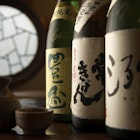
Feb 1, 2022 • 10 min read
Explore eight of the most renowned destinations for sake in Japan, three on a “Northern Route” and five on a “Southern Route”
Plan Your Trip to Japan: Best of Japan Tourism

Essential Japan

Trending in the forums
Japan Is Great For
Art & history.

The great outdoors

Historic sites

Security Alert May 17, 2024
Worldwide caution, update may 10, 2024, information for u.s. citizens in the middle east.
- Travel Advisories |
- Contact Us |
- MyTravelGov |
Find U.S. Embassies & Consulates
Travel.state.gov, congressional liaison, special issuance agency, u.s. passports, international travel, intercountry adoption, international parental child abduction, records and authentications, popular links, travel advisories, mytravelgov, stay connected, legal resources, legal information, info for u.s. law enforcement, replace or certify documents.
Share this page:
Japan Travel Advisory
Travel advisory january 8, 2024, japan - level 1: exercise normal precautions.
Japan – Level 1: Exercise Normal Precautions
Reissued after periodic review without changes.
Exercise normal precautions in Japan.
Read the country information page for additional information on travel to Japan.
If you decide to travel to Japan:
- Enroll in the Smart Traveler Enrollment Program (STEP) to receive Alerts and make it easier to locate you in an emergency.
- Follow the Department of State on Facebook and Twitter .
- Follow Embassy Tokyo’s American Citizen Services section on Facebook and Twitter .
- Review the Country Security Report for Japan.
- Visit the CDC page for the latest Travel Health Information related to your travel.
- Prepare a contingency plan for emergency situations. Review the Traveler’s Checklist .
Travel Advisory Levels
Assistance for u.s. citizens, search for travel advisories, external link.
You are about to leave travel.state.gov for an external website that is not maintained by the U.S. Department of State.
Links to external websites are provided as a convenience and should not be construed as an endorsement by the U.S. Department of State of the views or products contained therein. If you wish to remain on travel.state.gov, click the "cancel" message.
You are about to visit:
The Ministry of Foreign Affairs website uses JavaScript. Please turn on "JavaScript" and use it.

With regards to visa inquiries, you can contact “Foreign Residents Support Center (FRESC) MOFA Visa Information” or “the Japan Visa Information Hotline” listed on the website of the Embassy or Consulate General of Japan. Due to the complex nature of visa requirements, we are UNABLE to respond to visa-related inquiries made through this website at the moment. We advise you to contact the Consular Section of the Embassy or Consulate General of Japan nearest you for more information and advice.
If you are a foreign national, please click the links below for specific information related to respective subjects.
1. Visa Application Procedures
2. about visa.
- 3. Visa Application Documents
4. Frequently Asked Questions
5. announcements.
- 6. Inquiries Concerning Visas
- Be aware of fraudulent website, social media, emails in an attempt to extract payments from visa applicants (July 5, 2017)
Short-Term Stay
(A stay of up to 90 days for tourism, business, visiting friends or relatives, etc. that does not include remunerative activities)
Click on the nationality of the visa applicant traveling to Japan.

Visa exemption arrangements have been resumed from 0:00 am (JST) on October 11, 2022.
It is highly recommended to purchase international travel medical insurance for your trip to Japan. Overseas travel medical insurance helps you in case of emergency.
Work or Long-Term Stay
(A stay during which the applicant performs remunerative work in Japan or a stay of over 90 days in Japan, etc.)
- Procedures chart for long-term stays
- The Working Holiday Programmes in Japan
- Japan’s Pre-Entry Tuberculosis Screening
Visa for Medical Stay
Visa exemptions for diplomatic and official passport holders.
- Points to Note and Application Procedures
- Visa Processing Time
- Validity of a Visa
- Criteria of Visa Issuance
- Visas and Landing Permission
3. Visa Application Documents (download)
- (Note1) Refer to [1. Visa Application Procedures] for details of documents required.
- (Note3) Company/personal seal on Letter of Guarantee and Letter of Invitation is no longer required.
- Visa application form
- Tell me why you rejected my visa application.
- I want to go to Japan. Do I need a visa?
- I want to invite a foreign national to Japan. What procedures are necessary?
- What should I do to get a Certificate of Eligibility?
- The Certificate of Eligibility will not arrive by the time I apply for a visa. Can I still apply for a visa with its copy?
- As a “guarantor”, to what extent do I need to be responsible?
Newly introduced visas
- Special highly skilled professional (J-Skip)
- Designated activities (Future creation individual, Spouse or Child of future creation individual) (J-Find)
- Designated activities (Digital Nomad, Spouse or Child of Digital Nomad)
Review on restrictions on new entry of foreign nationals into Japan
- Application for Visa for foreign nationals eligible for Phased Measures toward Resuming Cross-Border Travel
- Border measures to prevent the spread of novel coronavirus (COVID-19)
Statistics for the Number of Visas
- Number of Visas Issued in 2021(May 31,2022)
Relaxation of Visa Requirements
- Visa Waiver Measure for Nationals of the Federative Republic of Brazil in Possession of Ordinary Passports(September 30, 2023)
- Signing of the Japan-Israel Working Holiday Agreement (April 28, 2023)
- Visa Waiver Measure for Nationals of the State of Qatar based on Ordinary Passport Registration System (April 2, 2023)
- Visa Waiver Measure for Nationals of the United Arab Emirates in Possession of Ordinary Passports (November 1, 2022)
- Japan’s Pre-Entry Tuberculosis Screening (April 3, 2020)
- Japan's Visa Policy in Accordance with Measures to Combat Trafficking in Persons (February 2009)
6. Inquiries about Visas Application
Foreign Residents Support Center (FRESC) MOFA Visa Information
Yotsuya Tower 13F, 1-6-1 Yotsuya, Shinjuku-ku, Tokyo, 160-0004 Navi-Dial: 0570-011000 (For some IP phones and calls from overseas, please call +81-3-5369-6577) Monday to Friday, 09:00-17:00
Related Links
- Websites of Japanese Embassies, Consulates and Permanent Missions

Why Disney fans will travel all the way to Japan for Tokyo Disneyland, DisneySea

- Tokyo Disneyland feels familiar with notable differences.
- Tokyo DisneySea feels foreign in the best way.
- There is no Disney Genie+ at Tokyo Disney Resort.
If you ever want to experience pure joy, go to Tokyo Disney Resort.
More specifically, The Happy Ride with Baymax at Tokyo Disneyland.
It may operate like Mater’s Junkyard Jamboree at Disney California Adventure or Alien Swirling Saucers at Disney’s Hollywood Studios , but the vibe is truly one-of-a-kind.
Cast members sing and dance in sync with the infectiously bubbly music. Fellow guests of all ages bop along while waiting patiently in line and wave their arms as the ride spins them around like kids who’ve had too much candy. You can’t help but feel happy.
“I want our guests to feel transported and to kind of escape from the daily grind. And I think that's what really Tokyo Disney Resort, the entire resort, does best,” Daniel Jue with Walt Disney Imagineering said ahead of Thursday’s opening of Fantasy Springs, the resort’s largest expansion since the opening of Tokyo DisneySea.
Disneyland may be the happiest place on Earth, but Tokyo Disney Resort is right up there. That’s just one of the reasons why Disney fans will fly across the world to visit its two parks: Tokyo Disneyland and Tokyo DisneySea. Here’s what travelers should know before they go.
A new Fantasyland? See inside Tokyo DisneySea’s new Fantasy Springs
Tokyo Disneyland feels familiar
Tokyo Disneyland feels very much like the original Disneyland in California and Magic Kingdom in Florida, with some notable differences.
There are numerous rides unique to the location, like The Happy Ride with Baymax and the wildly popular Enchanted Tale of Beauty and the Beast , which swirls and sways like Mickey and Minnie’s Runaway Railway through beloved scenes from “Beauty and the Beast” on trackless oversized dishes. The park is getting a totally new Space Mountain , expected to open in 2027. And it still has Splash Mountain , as Tokyo Disney Resort is owned by Oriental Land Company, which licenses from and partners with Disney.
Instead of Main Street U.S.A., guests enter the park through the glass-canopied World Bazaar. Instead of Frontierland, there's Westernland. The park’s Cinderella Castle may look like the one at Disney World, but guests can walk right through its upper chambers into Cinderella’s Fairy Tale Hall and throne room. The park also has a Toontown like Disneyland, whereas Disney World’s Mickey’s Toontown Fair closed years ago for New Fantasyland . Guests may also notice the Japan section of “ it’s a small world ” is larger than at other parks.
Tokyo DisneySea feels foreign in the best way
As Jasmine and Aladdin sang, Tokyo DisneySea is like “a whole new world.” Instead of lands, the park is organized into ports like American Waterfront, which looks like a coastal New England town, and Mermaid Lagoon, an indoor port, which makes fans of “The Little Mermaid” feel like they’re under the sea.
The park’s newest port, Fantasy Springs, opened Thursday. It features four new, location-exclusive attractions including the world’s only “Tangled”-theme ride, as well as Captain Hook’s ship, multiple restaurants, and stunning Disney-inspired rockwork fans will want to take time to explore. There’s also an adjacent Fantasy Springs Hotel overlooking the port with its own park entrance, like Disney’s Grand Californian with Disney California Adventure.
In the middle of Tokyo DisneySea, there’s a towering mountain, Mount Prometheus, and a large lagoon. One of the park's most popular and unique rides, Journey to the Center of the Earth , takes guests deep into the mountain, where unusual creatures await in the darkness. Nearby, guests can still ride 20000 Leagues Under the Sea , which closed at both Disney World and Disneyland years ago. At night, guests gather around the lagoon for the Believe! Sea of Dreams spectacular show.
There is no Genie+
There's no Disney Genie+ at Tokyo Disney Resort, but there are ways to cut waits for fees and for free.
Guests staying at the resort’s hotels can get a head start with Happy Entry . Instead of 30 minutes of early entry like at Disney World and Disneyland, Tokyo Disney Resort hotel guests get into the parks 15 minutes early through dedicated entrance lanes. That may not sound like much, but when you see the massive lines that form outside park gates early each morning, you’ll see what a difference 15 minutes make.
Instead of Individual Lightning Lanes, guests can purchase Premier Access for the parks’ most popular attractions. That lets them into shorter lines at designated times. Each one has a separate à la carte fee. Guests can also purchase Premier Access for reserved seating for parades and nighttime spectaculars.
Currently, Tokyo Disney Resort is also offering 40th Anniversary Priority Passes that work like Disney World and Disneyland’s old Fast Passes, granting access to shorter lines at select attractions and other experiences for free. Guests can request one pass at a time, pending availability on the resort’s free app.
The park app is also needed for free Entry Requests to Tokyo Disney Resort’s stage shows. These shows offer seating on a lottery basis rather than first-come, first-served.
During certain times of the year, a free Standby Pass may also be required to enter certain shops with high-demand, limited-edition merchandise.
Nearly everything is in Japanese
Guests who don’t understand Japanese will want to download a free app like Google Translate to read menu ingredients and ask for directions. Some cast members speak English, but unlike at Disney World and Disneyland, there are no paper park maps. There are only digital maps on the app.
Most rides are also in Japanese, but you can get the gist of what’s going on from other audio and visual cues, even on attractions like Sinbad’s Storybook Voyage , which has no equivalent in the U.S.
The food is almost too cute to eat
From custard-filled mochi that looks like the aliens from “Toy Story” to sandwiches made with fluffy white buns shaped like Mickey Mouse’s gloves to rice molded into Baymax sitting in a plate of curry, the food is almost too cute to eat at Tokyo Disney Resort. Don’t miss the many flavors of popcorn, like Matcha White Chocolate and the new Roast Beef, as well as the elaborately themed popcorn buckets and themed vending machines with both hot and cold drinks, depending on the season.
Guests with food allergies may want to bring a notecard indicating the allergy in Japanese to show at park eateries. Vegetarians may find fewer options than at Disney World and Disneyland. Picky eaters should note substitutions or modifications may not be allowed, particularly with set menu items.
Everything is cheaper
Flying to Japan is expensive, but nearly everything else is cheaper at Tokyo Disney Resort, including park tickets, food, and souvenirs like Mouse ear headbands, which are about half the price of those at Disney World and Disneyland. The favorable dollar-to-yen exchange rate also helps.
Disney fans will want to arrive with extra space in their luggage or a spare bag for the haul they’ll bring back home.
There’s no shame in Disney adulting
“I have this hypothesis that what so connects our guests here is that it is a place where they can be who they want to be,” Imagineering’s Jue said. “It’s OK to dance to the parades here. It's OK to walk around with a teddy bear here.”
And they do. Duffy the Disney Bear and his friends are a big deal. Not only do they have a whole show at Tokyo DisneySea, Duffy and Friends’ Wonderful Friendship , but there are numerous pint-sized photo opps for Duffy and friends plushies and tons of themed merchandise.
“I do think that we provide something very emotional that is necessary for our guests ... in a very safe place where you are not judged,” Jue said. “That's why they like their Duffys. Duffy does not judge them. Duffy accepts them for who they are.”
C ast members are magical
Cast members are the magic at any Disney destination, but they're especially effusive at Tokyo Disneyland. With exuberant smiles, they'll often enthusiastically wave with both hands.
Make sure to wave back.
The reporter on this story received access to the resort from Disney. USA TODAY maintains editorial control of reviews.
The Key Points at the top of this article were created with the assistance of Artificial Intelligence (AI) and reviewed by a journalist before publication. No other parts of the article were generated using AI. Learn more .
- Media & Industry
- Meetings & Events
- Select Language 简体中文 繁體中文(香港) 繁體中文(臺灣) India (English) Bahasa Indonesia 한국어 ภาษาไทย Tiếng Việt Singapore (English) Philippines (English) Malaysia (English) Australia/New Zealand (English) Français Deutsch Italiano Español United Kingdom (English) Nordic countries(English) Canada (English) Canada (Français) United States (English) Mexico (español) Português العربية Japan(日本語) Global (English)
- India (English)
- Bahasa Indonesia
- Singapore (English)
- Philippines (English)
- Malaysia (English)
- Australia/New Zealand (English)
- United Kingdom (English)
- Nordic countries(English)
- Canada (English)
- Canada (Français)
- United States (English)
- Mexico (español)
- Global (English)
- Fujiyoshida
- Shimonoseki
- Ishigaki Island
- Miyako Island
- Kerama Island
- Tokyo Island
- Koka & Shigaraki
- Hida Takayama
- Ginza, Nihonbashi
- Beppu & Yufuin (Onsen)
- Ginzan Onsen
- Nagasaki Islands

- Kumano Kodo
- Shikoku Karst
- Amami Oshima
- Hachimantai
- Omihachiman
- Aizuwakamatsu

- Diving in Japan
- Skiing in Japan
- Seasonal Flowers in Japan
- Sustainable Outdoors
- Off the Beaten Track in Japan
- Scenic Spots
- World Heritage
- Home Stays & Farm Stays

- Japanese Gardens
- Japanese Crafts
- Temple Stays
- Heritage Stays
- Festivals and Events
- Theater in Japan
- Japanese Tea Ceremony
- Cultural Experiences in Japan
- Culture in Japan

- Local Cuisine Eastern Japan
- Local Cuisine Western Japan
- Local Street Food
- Japan's Local Ekiben
- Japanese Whisky
- Vegetarian and Vegan Guide
- Sushi in Japan Guide
- Japanese Sake Breweries

- Art Museums
- Architecture
- Performing Arts
- Art Festivals
- Japanese Anime and Comics
- Japanese Ceramics
- Local Crafts

- Scenic Night Views
- Natural Wonders
- Theme Parks
- Samurai & Ninja
- Iconic Architecture

- Wellness Travel in Japan
- Japanese Ryokan Guide
- A Guide to Stargazing in Japan
- Relaxation in Japan
- Forest Bathing (Shinrin-yoku)

- Experiences in Japan
- Enjoy my Japan
- National Parks
- Japan's Local Treasures
- Japan Heritage
- Snow Like No Other
- Wonder Around Japan

- Visa Information
- Getting to Japan
- Airport Access
- COVID-19: Practical Information for Traveling to Japan
- Anime Tourism
- Countryside Stays
- Accessible Tourism
- Hokkaido Great Outdoors
- Scenic World Heritage in Tohoku
- Shikoku’s Nature and Traditions
- Southern Kyushu by Rail

- Traveling by Rail
- How to Travel by Train and Bus
- JR Rail Passes
- Scenic Railways
- Renting a Car
- Sustainable Travel in Japan
- Travel Brochures
- Useful Apps
- Online Reservation Sites
- Eco-friendly Accommodation
- Luxury Accommodations
- Traveling With a Disability
- Hands-free Travel
- How to Book a Certified Tour Guide
- Volunteer Guides
- Tourist Information Center

- Japanese Manners
- Spring in Japan
- Summer in Japan
- Autumn in Japan
- Winter in Japan
- Cherry Blossom Forecast
- Autumn Leaves Forecast

- Japan Visitor Hotline
- Travel Insurance in Japan
- Japan Safe Travel Information
- Accessibility in Japan
- Vegetarian Guide
- Muslim Travelers
- Safety Tips

- JAPAN Monthly Web Magazine
- Arts & Cultures
- Nature & Outdoor
- Festivals & Events
- Insider Blog
- Things to do
- Local Guides
- Food & drink
- Traditional
- Hokuriku Shinetsu

My Favorites
${v.desc | trunc(25)}
Planning a Trip to Japan?
Share your travel photos with us by hashtagging your images with #visitjapanjp
An epic eating adventure
From kaiseki to branded beef: sushi, sashimi and starred restaurants. unbeatable and unique taste adventures await..
Japanese cuisine offers an exceptionally rich and rewarding eating experience. While sushi, wagyu beef and kaiseki cuisine need little introduction, no self-respecting foodie should miss out on street food like yakitori and ramen either. Perhaps the epitome of Japanese cuisine is the kaiseki food served at ryotei (traditional Japanese restaurants). But the scope also includes numerous vegetarian varieties, river fish dishes, sushi, eel, tempura, soba, udon, takoyaki, okonomiyaki, yakiniku and more. Each region also has its own local specialties and culinary traditions in dishes unique to each area. Wherever you go and whatever you enjoy, why not accompany your meal with sake from a local brewery?
Vegans and vegetarians can also expect a feast of fine food choices.
Abundant Japanese Food
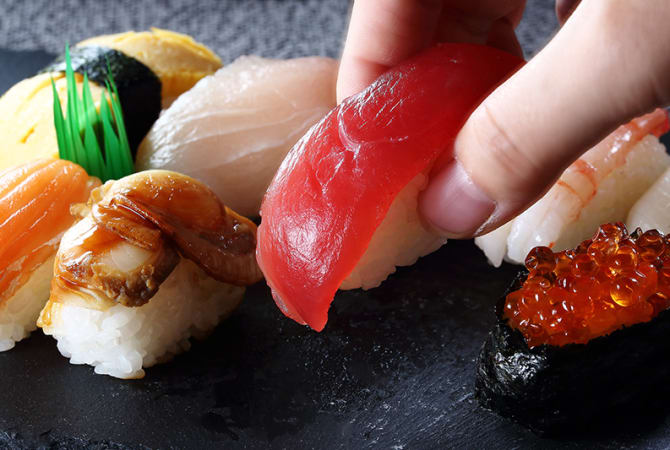
A city where you can enjoy food
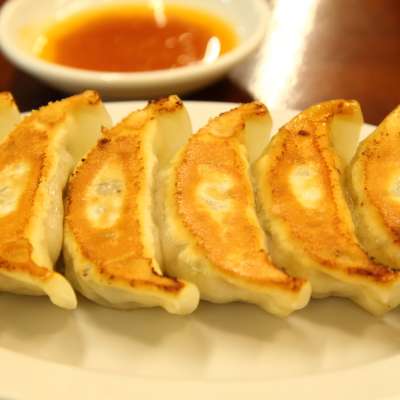
Distinctive Markets
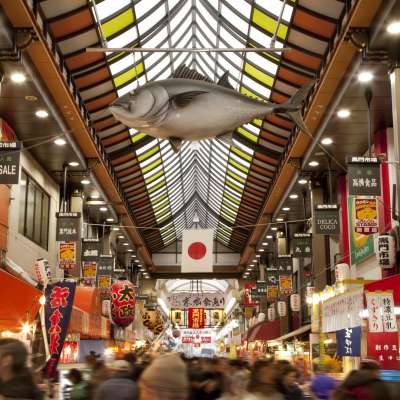
Food features
A gastronomic journey in nara.
Please Choose Your Language
Browse the JNTO site in one of multiple languages
Everything You Need to Know About Japandi Style, According to Design Pros
Learn why this tranquil aesthetic is re-emerging in interior design.

With strong historical roots, Japandi style's global attraction begins to trend as minimal decor and homes filled with natural elements grow popular. Jennifer Verruto, Founder & CEO, Blythe Interiors , says, "We are seeing more and more people gravitate towards the elegant simplicity and calming atmosphere of Japandi.”
Timeless and simplistic, Japandi style sets the pace of your living space. Earthy and organic, craftmanship in your decor can shine through due to the pared-back ethos of not overcrowding your space with objects or tons of color. Ahead, learn why interior designers will continue to sing their praises of the over a century-old style.
What Is Japandi Style?
Japandi style harmoniously blends the most distinct and favored features in Japanese and Scandinavian cultures. Peak Petersen, senior interior designer at Hoedemaker Pfeiffer , says, "The focus of these combined aesthetics is tranquility and functionality and is often defined by natural materiality, a neutral palette with dark, earthy tones, uncluttered space that is not overly minimal, natural light and greenery , bringing nature into the home."

But the re-emerging interest around Japandi goes beyond the surface. Carrying the spirit of feng shui and Scandinavian hygge principles, the design sets the environment and mood in your home. The crisp but laid-back look lends a relaxing and warm feel to your space. Unwinding will look better and not cluttered!
Peter Spalding co-founder and CCO, Daniel House Club says, “Both cultures have a less-is-more mentality and both continue to foreground handmade objects. More than their aesthetics, it is their ethos that unites them.”
Why Japandi Design Is Effective

Petersen loves how Japandi style adds depth to the bright, clean Scandinavian “hygge”-influenced canvas (next-level coziness that causes you to feel contentment). You can enjoy the warmth without feeling closed in, thanks to the freeing nature of Japanese aesthetics it's all about balance! "The inclusion of darker tones, meaningful artwork and found pieces create a lifetime ethos that will continue to be interesting," Petersen explains.
The overall soothing ambiance it provides is welcoming and can create a sense of calm even after a hectic day. Inviting guests over in a tranquil setting that promotes their well-being can also make entertaining feel zen. Simply, pop the open the dishwasher and enjoy an evening of relaxation when the party is over.
Finally, you can indulge in your favorites without settling or feeling overwhelmed. “Japandi fuses the comfy rusticity of Scandinavian design with the Japanese celebration of imperfection as beauty," says Spalding. "It is crisp and clean, but not sterile. Its palette is subtle, but never cold. It celebrates the handmade over the mass-produced."
How to Use Japandi Style in Your Home
Japandi style can fit in just about anywhere in your home from the bathroom (your spa days have never looked so good) to the kitchen, but it's done best in places enjoyed by friends and family.

In the primary bathroom (pictured above), Verruto carefully blended warm and cool tones to create an environment of balance and serenity. "The design team revitalized the existing archway through thoughtful finishes, incorporating porcelain tile that mimics the look of thin wood slats—embodying the minimal, natural aesthetic of the style,” she explains.
If you're hoping to achieve this aesthetic, begin to draw back the curtain and let the light in. Paint with limewash for an organic, textured feel. Shop for high-quality vintage furniture made of wood or clay for a stylish moment that won't get lost in a crowd of accessories.
This trend allows you to start afresh in your home, boosting your sense of peace no matter the season. Spalding says, "I like that Japandi style presents its origins so completely. It gives us the opportunity to delve deep and explore work we are not that familiar with and make it our own.” Cheers to the start of something new that feels right at home!
Medgina Saint-Elien is a lifestyle and design editor, whose journey has been marked by her interest in popular culture and technology. Saint-Elien uses her editorial eye to find the "on the pulse" moments in media through trend forecasting, exciting new product launches, hands-on reviews, and covering the "lightbulb" moments in every maker's story. She is a creative strategist who conceptualizes digital franchises and partnerships that draw readers to take a second look. In addition to House Beautiful, her work has been published in Cosmopolitan, Byrdie, Snapchat, and more.

@media(max-width: 64rem){.css-o9j0dn:before{margin-bottom:0.5rem;margin-right:0.625rem;color:#ffffff;width:1.25rem;bottom:-0.2rem;height:1.25rem;content:'_';display:inline-block;position:relative;line-height:1;background-repeat:no-repeat;}.loaded .css-o9j0dn:before{background-image:url(/_assets/design-tokens/goodhousekeeping/static/images/Clover.5c7a1a0.svg);}}@media(min-width: 48rem){.loaded .css-o9j0dn:before{background-image:url(/_assets/design-tokens/goodhousekeeping/static/images/Clover.5c7a1a0.svg);}} Around the Living Room
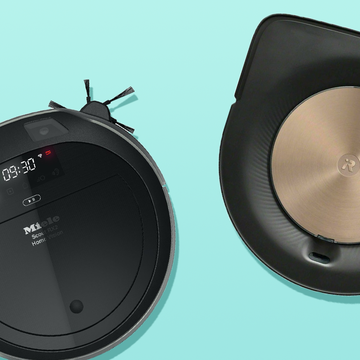
The Best Budget Projectors

The Best Carpet Stain Removers

The Best Recliners for Small Spaces

The Best Carpet Cleaners

Vacuums for Pet Hair

50 Best Living Room Paint Colors

The Best Portable Carpet Cleaners
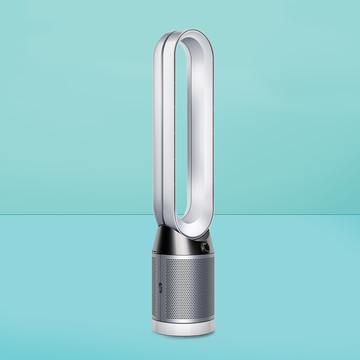
The Best Air Purifiers

The Best Humidifiers
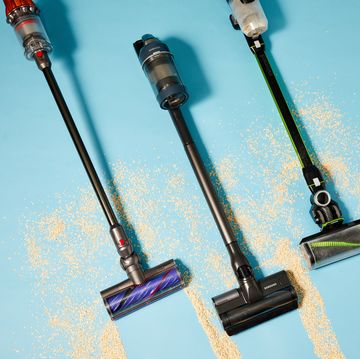
The Best Stick Vacuums

The Best Window Air Conditioners
STARS AND STRIPES
- Middle East
- Asia-Pacific
- Map Of Memorials
- Entertainment
- - Video Games
- Europe Travel
- - Quick Trips
- - After Hours
- Pacific Travel
- The Meat and Potatoes of Life
- U.S. Travel
- Storm Tracker
- Rewards for readers
- Get Stripes
- Stripes Lite
- Archives/Library
- Special Publications
- Mobile Apps
- Email Newsletters
- Digital Access
- Home Delivery
- Marine Corps
- Coast Guard
- Space Force
- Archive Photo Of The Day
- - Military Matters
- - Force For Hire
- Out of Uniform
- Communities
- Stripes Europe
- Stripes Guam
- Stripes Japan
- Stripes Korea
- Stripes Okinawa
- Our Other Websites
- In Memoriam
- Month of the Military Child
- Best of Germany
- Best of the Pacific
- Letters to Santa
Food & Drink
Get a taste of french summer at the grand hyatt tokyo.
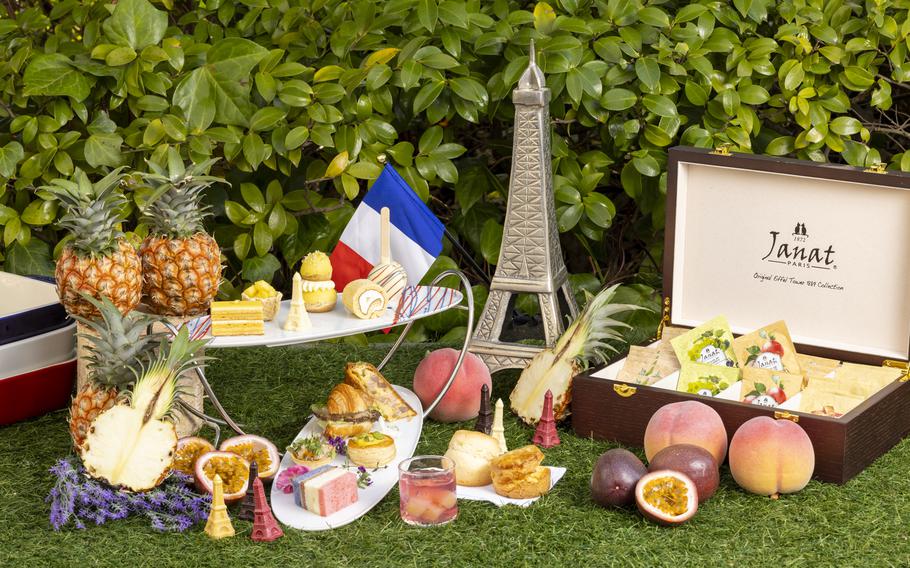
(Grand Hyatt Tokyo)
This summer’s events at the Grand Hyatt Tokyo turn to one of the world’s most iconic cities, Paris. The French Kitchen at the Grand Hyatt Tokyo is serving an elegant afternoon tea crafted from carefully picked seasonal ingredients. Let yourself be transported to the phenomenal gardens of the French capital.
This themed menu will come in three consecutive offering “seasons”, serving an ideal afternoon treat for the different moods throughout the Tokyo summer. The first season begins with a selection of mango, melon and American cherry sweets, including rich mango pastries and fruit snacks. The second season follows with passionfruit, pineapple and peach dishes, rose-scented peach jelly and homemade ice cream macaron lollipops. The summer festivities conclude with a third season featuring peach, Shine Muscat and fig creations, including fig and Bourbon vanilla waffle baskets. All three plans include a selection of savories such as tricolore sandwiches, fine cheese and tartines with a seasonal fruit twist. Come and find your perfect match in a collaboration of Parisian and Tokyo summer.
Offer Details
“First Season” May 28 – June 30
“Second Season” July 1 – July 31
“Third Season” August 1 – September 16
Time: 3 – 5 p.m.
Summer Fruits Afternoon Tea Menu ¥5,940 (weekdays only)
With a glass of Champagne ¥7,590 (weekends and holidays)
grand.hyatt.jp/afternoontea/
If you like Pokémon, you should check out this themed sleeping experience: Live Your Pokémon Dreams at Grand Hyatt Tokyo
metropolisjapan.com
related stories
- Live your Pokémon dreams at Grand Hyatt Tokyo this summer
- Tokyo Summer 2024: Snooze with Snorlax in a Pokémon Sleep Suite!
The best stories from the Pacific, in your inbox
Sign up for our weekly newsletter of articles from Japan, Korea, Guam, and Okinawa with travel tips, restaurant reviews, recipes, community and event news, and more.
Sign Up Now

IMAGES
VIDEO
COMMENTS
6. Tonkatsu. Tonkatsu is a popular Japanese dish based on western pork cutlets, where a thick slice of pork is dipped in a flour and beaten egg batter, coated in breadcrumbs and fried in oil. There are both sirloin and fillet tonkatsu, with the fillet tonlatsu being more expensive.
Sit at a sushi counter, dine at a traditional ryotei, eat vegetarian shojin ryori in a monastery or enjoy casual food at an izakaya or yatai food stall. Complement traditional and modern takes on Japanese cuisine with sake from a local brewery in Niigata, sip on sweet potato shochu in Kagoshima , or try one of Japan's highly-acclaimed whiskies ...
To assist you in making a decision, we have assembled a list of 32 delectable Japanese dishes that everyone should experience. 1. Buta-No-Shogayaki (豚の生姜焼き): The 'B-Grade Gourmet' Ginger Pork Classic. Buta-No-Shogayaki: A sizzling ginger-infused pork dish that's a household favorite.
2. Donburi. Donburi is the overarching word in Japanese for "rice bowl." You can order a range of donburi rice bowls with different toppings, depending on your preference. "Katsu donburi" or simply "katsudon" is one of my favorite donburi bowls in Japan, featuring rice covered with a slab of panko-crumbed and deep-fried pork cutlet surrounded by a soft, soy sauce-flavored omelet ...
mirin = slightly sweet rice wine, which is similar to sake but has a lower alcohol content and higher sugar content, making it great for cooking. It is used in making many sauces, including teriyaki. yakimeshi = Japanese fried rice. wasabi = Japanese horseradish, light green in color and very strong flavor.
1. Sushi (すし) Sushi is definitely the most famous Japanese meal outside of Japan. It was once referred to as pickled fish preserved in vinegar, but nowadays, it can be defined as any dish containing vinegared rice and raw fish. Sushi is often served with soy sauce, wasabi and pickled ginger.
Explore the best of Japan's food - from its popular classics like sushi, ramen, Wagyu, tonkatsu, teppanyaki and soba, through to its regional favourites like Kobe beef, Hiroshima okonomiyaki and Okinawan soul food. ... Japan Travel is the leading resource for Japan travel information and the primary destination for visitors planning and ...
Japanese cuisine (和食, washoku) offers an abundance of gastronomical delights with a boundless variety of regional and seasonal dishes.Restaurants in Japan range from mobile food stands to centuries old ryotei, atmospheric drinking places, seasonally erected terraces over rivers, cheap chain shops and unique theme restaurants about ninja and robots.
Temaki. Temaki is a type of sushi consisting of a cone-shaped roll of nori (seaweed) which is filled with sushi rice, seafood, vegetables, and topped with condiments such as wasabi and pickled ginger. Typical fillings for Temaki include salmon, yellowtail , tuna, scallops, avocado, cucumber and pickles.
28. Kiritanpo. A traditional Japanese food that hails from Akita prefecture, kiritanpo is made of pounded rice that is shaped around wooden cylinders and toasted over a hearth. It can be slathered in a sweet miso sauce and eaten right off the skewer; or removed from the cylinder, chopped, and placed into soups.
1. Sushi. Sushi is now one of the most iconic Japanese dishes, but it actually originated in China in the 1st or second century BC and was known as narezushi. Contrary to popular belief, Sushi does not mean raw fish, it actually means sour rice. Sushi refers to any dish made with sushi rice (sour rice) accompanied with egg, vegetables, or fish.
Japanese Food: Culinary Travel in Japan. If you're planning a trip to Japan, chances are that Japanese food is one of the things you're most excited about (whether or not you refer to yourself as a "foodie"). Japan is a wonderful destination for so many reasons, including its history, tradition, culture, and arts. But for most of our ...
3. Ramen. Like sushi, ramen is a Japanese food favorite and one of the best dishes you can eat in Japan. It refers to a noodle soup made with four basic components - the broth, tare (seasoning), wheat noodles, and toppings. Tare (or kaeshi) is the salty concentrated essence placed at the bottom of every ramen bowl.
Torikizoku (Shinjuku, Shibuya, Tokyo, etc) Torishiki (Shinagawa) Kushiwakamaru (Nakameguro) 5. Japanese Curry. Brought to Japan in the late 1800 by the British, Japanese curry (カレー) is considered one of the nation's most popular convenience and comfort foods.
4. Udon. Udon is a popular Japanese dish that's an easy introduction to Japanese food for tourists. It can be served a number of different ways, with a variety of ingredients, but it is most commonly served in noodle soups. Pictured above is a delicious beef udon noodle soup that we enjoyed in Kyoto, Japan.
The following are some popular Tokyo specialties: Nigiri- zushi. The most popular type of sushi today, nigiri-zushi originated as a fast-food dish in Tokyo. Consisting of a piece of seafood put onto a small ball of rice, it takes much less time and effort to prepare than more traditional sushi dishes.
Beautiful, refined and reverent best describe Japan's approach to food Washoku, traditional Japanese cuisine, was added to the UNESCO Intangible Cultural Heritage List in December 2013. This well-deserved recognition honors the respect and appreciation of the season, and the beauty of the ingredients, with which Japanese dishes are prepared.
Guided Tours Of Japan. We will provide tips on how to plan your own Japan 2 week itinerary, but I understand that Japan can be difficult to manage on your own. We have some recommendations for guided tours that included between 12 and 14 day itineraries. Intrepid Travel offers a 12 day Real Food Adventure In Japan.
🤫 OUR ULTIMATE JAPANESE FOOD GUIDE: https://chadandclaire.com/shop/p/japan-food-guide 🤭 OUR ULTIMATE JAPAN TRAVEL GUIDE: https://chadandclaire.com/sh...
Food Tours Japan helps you discover the best gourmet experiences in Japan, the world's number one food destination. Pack your chopsticks, and dive into elegant and harmonious cuisines developed from centuries of artistry, to deliciously addictive soul foods. ... A Japan food tour is a must-do travel experience and one you'll never forget!
Kosher Japan is a kosher certification organization in Japan that offers mail order and delivery services of kosher certified foods and operates kosher hotel chains. Kosher Japan (Japanese only) The focus toward Muslim-friendly initiatives (halal food promotion), pursued by national and local governments, has an expansion of halal-certified ...
Discover amazing travel experiences in Japan with Lonely Planet's insider tips, inspirational traveler stories and expert guidance from around the world. ... From classic Japanese food and sights to local favorites and under-the-radar trends, these are 24 of the most inspiring experiences in Japan. family travel. 12 of the best things to do in ...
2,250. Explore Japan. A land where natural splendours and timeless traditions meet neon sci-fi cities and a frenetic buzz, Japan invites discovery at every turn. Be inspired by authentic experiences, invigorating nature breaks and offbeat adventures doubling as refreshing escapes. Once you're tapped out exploring, relive the day's ...
Japan - Level 1: Exercise Normal Precautions. Reissued after periodic review without changes. Exercise normal precautions in Japan. Read the country information page for additional information on travel to Japan. If you decide to travel to Japan:
Japan's Food Culture. The Japanese archipelago is fertile, rich and diverse, and this precious combination supports many fruits, vegetables, spices and other unique ingredients. Against this outstanding culinary backdrop, many local cuisines using regional ingredients have existed for generations, fostering a food culture that you'll find ...
Inquiries about Visas Application. Foreign Residents Support Center (FRESC) MOFA Visa Information. Yotsuya Tower 13F, 1-6-1 Yotsuya, Shinjuku-ku, Tokyo, 160-0004 Navi-Dial: 0570-011000. (For some IP phones and calls from overseas, please call +81-3-5369-6577) Monday to Friday, 09:00-17:00.
Flying to Japan is expensive, but nearly everything else is cheaper at Tokyo Disney Resort, including park tickets, food, and souvenirs like Mouse ear headbands, which are about half the price of ...
Perhaps the epitome of Japanese cuisine is the kaiseki food served at ryotei (traditional Japanese restaurants). But the scope also includes numerous vegetarian varieties, river fish dishes, sushi, eel, tempura, soba, udon, takoyaki, okonomiyaki, yakiniku and more. Each region also has its own local specialties and culinary traditions in dishes ...
Haris Kenjar. Japandi style encompasses the beauty and minimalistic nature of Scandinavian and Japanese design styles. Its known features center around nature, functionality, minimalism and ...
Come and find your perfect match in a collaboration of Parisian and Tokyo summer. "First Season" May 28 - June 30. "Second Season" July 1 - July 31. "Third Season" August 1 - September 16. Time: 3 - 5 p.m. Summer Fruits Afternoon Tea Menu ¥5,940 (weekdays only) With a glass of Champagne ¥7,590 (weekends and holidays) grand ...